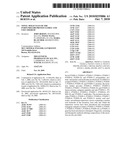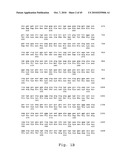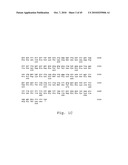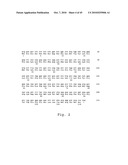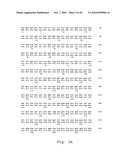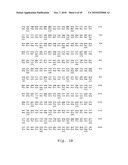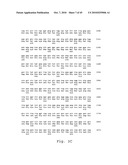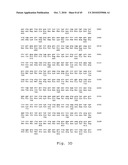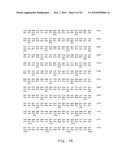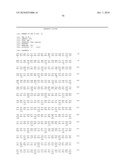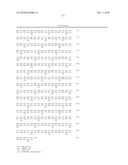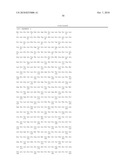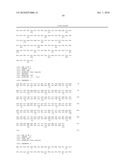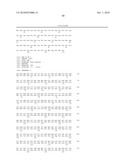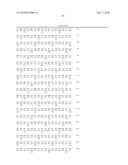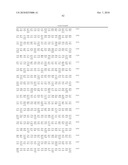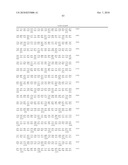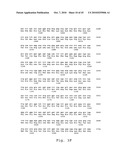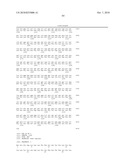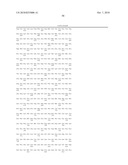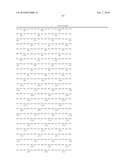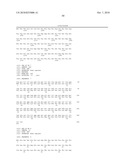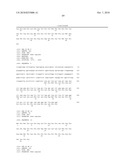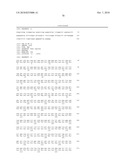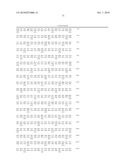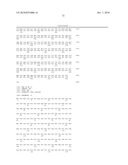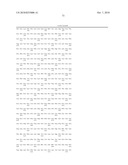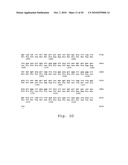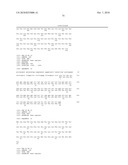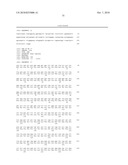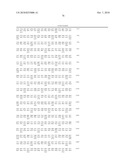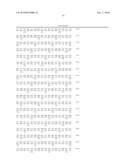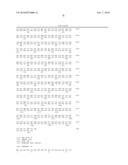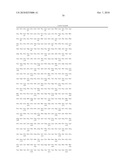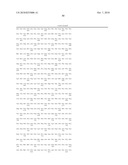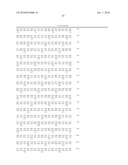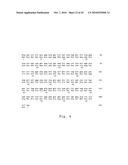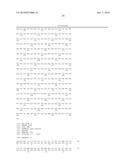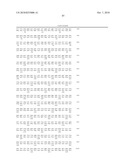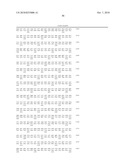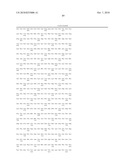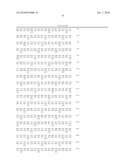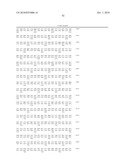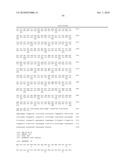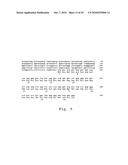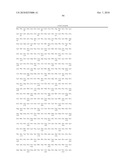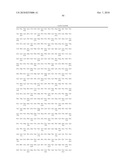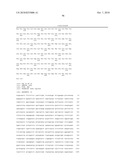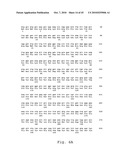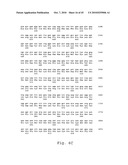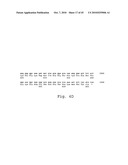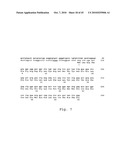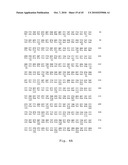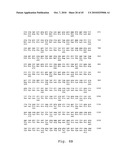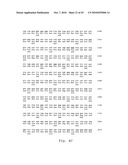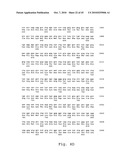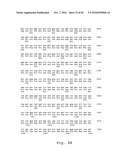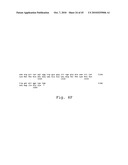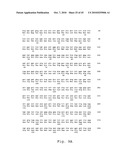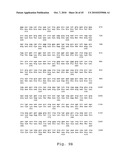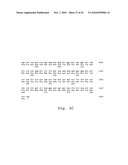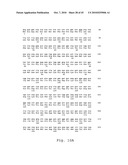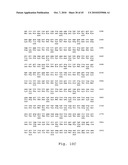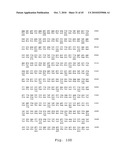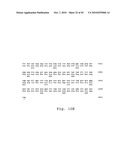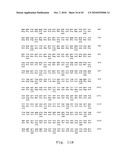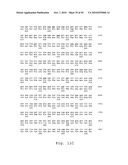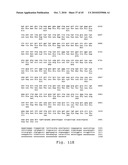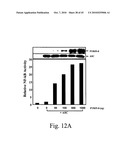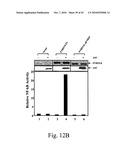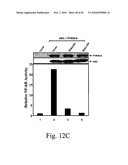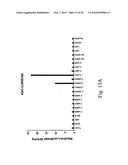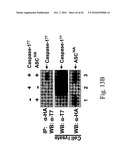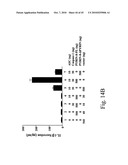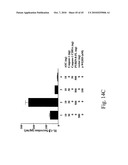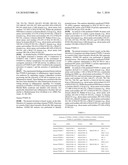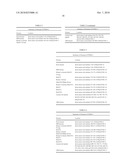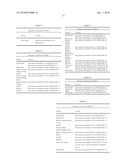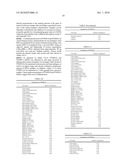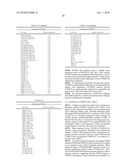Patent application title: NOVEL MOLECULES OF THE PYRIN/NBS/LRR PROTEIN FAMILY AND USES THEREOF
Inventors:
John Bertin (Watertown, MA, US)
Weiye Wang (Plainsboro, NJ, US)
Maria Blatcher (Moorestown, NJ, US)
Assignees:
Millennium Pharmaceuticals, Inc.
Wyeth
IPC8 Class: AA61K39395FI
USPC Class:
4241721
Class name: Drug, bio-affecting and body treating compositions immunoglobulin, antiserum, antibody, or antibody fragment, except conjugate or complex of the same with nonimmunoglobulin material binds eukaryotic cell or component thereof or substance produced by said eukaryotic cell (e.g., honey, etc.)
Publication date: 2010-10-07
Patent application number: 20100255006
Claims:
1. An isolated nucleic acid molecule selected from the group consisting
of:a) a nucleic acid molecule comprising a nucleic acid sequence that is
at least 90% identical to SEQ ID NO:1, SEQ ID NO:3, SEQ ID NO:7, SEQ ID
NO:9, SEQ ID NO:11, SEQ ID NO:12, SEQ ID NO:14, SEQ ID NO:16, SEQ ID
NO:17, SEQ ID NO:19, SEQ ID NO:21, SEQ ID NO:23, SEQ ID NO:25, or a
complement thereof;b) a nucleic acid molecule comprising a nucleic acid
sequence encoding a polypeptide comprising at least 50 contiguous amino
acids of the amino acid sequence of SEQ ID NO:2, SEQ ID NO:4, SEQ ID
NO:8, SEQ ID NO:10, SEQ ID NO:13, SEQ ID NO:15, SEQ ID NO:18, SEQ ID
NO:20, SEQ ID NO:22, or SEQ ID NO:24;c) a nucleic acid molecule
comprising a nucleotide sequence encoding a polypeptide with an amino
acid sequence which is at least 90% identical to the amino acid sequence
of SEQ ID NO:2, SEQ ID NO:4, SEQ ID NO:8, SEQ ID NO:10, SEQ ID NO:13, SEQ
ID NO:15, SEQ ID NO:18, SEQ ID NO:20, SEQ ID NO:22, or SEQ ID NO:24;d) a
nucleic acid molecule comprising at least 100 contiguous nucleotides of
the nucleotide sequence of SEQ ID NO:1, SEQ ID NO:3, SEQ ID NO:7, SEQ ID
NO:9, SEQ ID NO:11, SEQ ID NO:12, SEQ ID NO:14, SEQ ID NO:16, SEQ ID
NO:17, SEQ ID NO:19, SEQ ID NO:21, SEQ ID NO:23, SEQ ID NO:25, or a
complement thereof; ande) a nucleic acid molecule that hybridizes to a
nucleic acid molecule consisting of the nucleotide sequence of SEQ ID
NO:1, SEQ ID NO:3, SEQ ID NO:7, SEQ ID NO:11, SEQ ID NO:12, SEQ ID NO:16,
SEQ ID NO:17, SEQ ID NO:19, SEQ ID NO:21, or SEQ ID NO:25 under
conditions of incubation at 45.degree. C. in 6.0X SSC followed by washing
in 0.2.times.SSC/0.1% SDS at 65.degree. C., or a complement thereof.
2. The isolated nucleic acid molecule of claim 1, which is selected from the group consisting of:a) a nucleic acid comprising the nucleotide sequence of SEQ ID NO:1, SEQ ID NO:3, SEQ ID NO:7, SEQ ID NO:9, SEQ ID NO:11, SEQ ID NO:12, SEQ ID NO:14, SEQ ID NO:16, SEQ ID NO:17, SEQ ID NO:19, SEQ ID NO:21, SEQ ID NO:23, SEQ ID NO:25, or a complement thereof; andb) a nucleic acid molecule that encodes a polypeptide comprising the amino acid sequence of SEQ ID NO:2, SEQ ID NO:4, SEQ ID NO:8, SEQ ID NO:10, SEQ ID NO:13, SEQ ID NO:15, SEQ ID NO:18, SEQ ID NO:20, SEQ ID NO:22, or SEQ ID NO:24.
3. The isolated nucleic acid molecule of claim 1, further comprising vector nucleic acid sequences.
4. A host cell in culture comprising the nucleic acid molecule of claim 1.
5. The nucleic acid molecule of claim 1, further comprising nucleic acid sequences encoding a heterologous polypeptide.
6. An isolated polypeptide selected from the group consisting of:a) a polypeptide encoded by a nucleic acid molecule comprising a nucleic acid sequence that is at least 90% identical to SEQ ID NO:1, SEQ ID NO:3, SEQ ID NO:7, SEQ ID NO:9, SEQ ID NO:11, SEQ ID NO:12, SEQ ID NO:14, SEQ ID NO:16, SEQ ID NO:17, SEQ ID NO:19, SEQ ID NO:21, SEQ ID NO:23, or SEQ ID NO:25;b) a polypeptide comprising a fragment of SEQ ID NO:2, SEQ ID NO:4, SEQ ID NO:8, SEQ ID NO:10, SEQ ID NO:13, SEQ ID NO:15, SEQ ID NO:18, SEQ ID NO:20, SEQ ID NO:22, or SEQ ID NO:24, wherein the fragment comprises at least 50 contiguous amino acids of SEQ ID NO:2, SEQ ID NO:4, SEQ ID NO:8, SEQ ID NO:10, SEQ ID NO:13, SEQ ID NO:15, SEQ ID NO:18, SEQ ID NO:20, SEQ ID NO:22, or SEQ ID NO:24;c) a polypeptide comprising a naturally occurring allelic variant of the amino acid sequence of SEQ ID NO:2, SEQ ID NO:4, SEQ ID NO:8, SEQ ID NO:10, SEQ ID NO:13, SEQ ID NO:15, SEQ ID NO:18, SEQ ID NO:20, SEQ ID NO:22, or SEQ ID NO:24, wherein the polypeptide is encoded by a nucleic acid molecule that hybridizes to a nucleic acid molecule consisting of SEQ ID NO:1, SEQ ID NO:3, SEQ ID NO:7, SEQ ID NO:11, SEQ ID NO:12, SEQ ID NO:16, SEQ ID NO:17, SEQ ID NO:19, SEQ ID NO:21, or SEQ ID NO:25 under conditions of incubation at 45.degree. C. in 6.0X SSC followed by washing in 0.2.times.SSC/0.1% SDS at 65.degree. C.;d) a polypeptide that is encoded by a nucleic acid molecule comprising at least 100 contiguous nucleotides of the nucleotide sequence of SEQ ID NO:1, SEQ ID NO:3, SEQ ID NO:7, SEQ ID NO:9, SEQ ID NO:11, SEQ ID NO:12, SEQ ID NO:14, SEQ ID NO:16, SEQ ID NO:17, SEQ ID NO:19, SEQ ID NO:21, SEQ ID NO:23, or SEQ ID NO:25; ande) a polypeptide comprising an amino acid sequence that is at least 90% identical to the amino acid sequence of SEQ ID NO:2, SEQ ID NO:4, SEQ ID NO:8, SEQ ID NO:10, SEQ ID NO:13, SEQ ID NO:15, SEQ ID NO:18, SEQ ID NO:20, SEQ ID NO:22, or SEQ ID NO:24.
7. The isolated polypeptide of claim 6, comprising the amino acid sequence of SEQ ID NO:2, SEQ ID NO:4, SEQ ID NO:8, SEQ ID NO:10, SEQ ID NO:13, SEQ ID NO:15, SEQ ID NO:18, SEQ ID NO:20, SEQ ID NO:22, or SEQ ID NO:24.
8. The polypeptide of claim 6, further comprising heterologous amino acid sequences.
9. An antibody that selectively binds to a polypeptide of claim 6.
10. A method for producing a polypeptide selected from the group consisting of:a) a polypeptide encoded by a nucleic acid molecule comprising a nucleic acid sequence that is at least 90% identical to SEQ ID NO:1, SEQ ID NO:3, SEQ ID NO:7, SEQ ID NO:9, SEQ ID NO:11, SEQ ID NO:12, SEQ ID NO:14, SEQ ID NO:16, SEQ ID NO:17, SEQ ID NO:19, SEQ ID NO:21, SEQ ID NO:23, or SEQ ID NO:25;b) a polypeptide comprising a fragment of SEQ ID NO:2, SEQ ID NO:4, SEQ ID NO:8, SEQ ID NO:10, SEQ ID NO:13, SEQ ID NO:15, SEQ ID NO:18, SEQ ID NO:20, SEQ ID NO:22, or SEQ ID NO:24, wherein the fragment comprises at least 50 contiguous amino acids of SEQ ID NO:2, SEQ ID NO:4, SEQ ID NO:8, SEQ ID NO:10, SEQ ID NO:13, SEQ ID NO:15, SEQ ID NO:18, SEQ ID NO:20, SEQ ID NO:22, or SEQ ID NO:24;c) a polypeptide comprising a naturally occurring allelic variant of the amino acid sequence of SEQ ID NO:2, SEQ ID NO:4, SEQ ID NO:8, SEQ ID NO:10, SEQ ID NO:13, SEQ ID NO:15, SEQ ID NO:18, SEQ ID NO:20, SEQ ID NO:22, or SEQ ID NO:24, wherein the polypeptide is encoded by a nucleic acid molecule that hybridizes to a nucleic acid molecule consisting of SEQ ID NO:1, SEQ ID NO:3, SEQ ID NO:7, SEQ ID NO:11, SEQ ID NO:12, SEQ ID NO:16, SEQ ID NO:17, SEQ ID NO:19, SEQ ID NO:21, or SEQ ID NO:25 under conditions of incubation at 45.degree. C. in 6.0X SSC followed by washing in 0.2.times.SSC/0.1% SDS at 65.degree. C.;d) a polypeptide that is encoded by a nucleic acid molecule comprising at least 100 contiguous nucleotides of the nucleotide sequence of SEQ ID NO:1, SEQ ID NO:3, SEQ ID NO:7, SEQ ID NO:9, SEQ ID NO:11, SEQ ID NO:12, SEQ ID NO:14, SEQ ID NO:16, SEQ ID NO:17, SEQ ID NO:19, SEQ ID NO:21, SEQ ID NO:23, or SEQ ID NO:25; ande) a polypeptide comprising an amino acid sequence that is at least 90% identical to the amino acid sequence of SEQ ID NO:2, SEQ ID NO:4, SEQ ID NO:8, SEQ ID NO:10, SEQ ID NO:13, SEQ ID NO:15, SEQ ID NO:18, SEQ ID NO:20, SEQ ID NO:22, or SEQ ED NO:24,the method comprising culturing the host cell of claim 4 under conditions in which the polypeptide is expressed.
11. A method for detecting the presence of a polypeptide in a sample, the method comprising:(a) contacting the sample with a compound that selectively binds to the polypeptide of claim 6; and(b) determining whether the compound binds to a polypeptide in the sample.
12. The method of claim 11, wherein the compound which binds to the polypeptide is an antibody.
13. A kit comprising a compound which selectively binds to a polypeptide of claim 6 and instructions for use.
14. A method for detecting the presence of a nucleic acid molecule of claim 1 in a sample, the method comprising:a) contacting the sample with a nucleic acid probe or primer which selectively hybridizes to the nucleic acid molecule of claim 1; andb) determining whether the nucleic acid probe or primer binds to a nucleic acid molecule in the sample.
15. The method of claim 14, wherein the sample comprises mRNA molecules and is contacted with a nucleic acid probe.
16. A kit comprising a compound that selectively hybridizes to a nucleic acid molecule of claim 1 and instructions for use.
17. A method for identifying a compound that binds to a polypeptide, the method comprising:(a) contacting a cell or a sample comprising the polypeptide of claim 6 with a test compound; and(b) determining whether the polypeptide binds to the test compound.
18. A method for identifying a compound which modulates the activity of a polypeptide of claim 6, the method comprising:(a) contacting a polypeptide of claim 6 with a test compound; and(b) determining the effect of the test compound on the activity of the polypeptide to thereby identify a compound which modulates the activity of the polypeptide.
19. A method for modulating the activity of a polypeptide, the method comprising contacting the polypeptide of claim 6 or a cell expressing the polypeptide with a compound that binds to the polypeptide in a sufficient concentration to modulate the activity of the polypeptide.
20. A method of treating a disorder associated with inappropriate apoptosis or an inflammatory disorder, the method comprising:(a) selecting an individual that has a disorder associated with inappropriate apoptosis or an inflammatory disorder; and(b) modulating the expression or activity of the polypeptide of claim 6.
Description:
RELATED APPLICATIONS
[0001]This application is a divisional of U.S. application Ser. No. 10/124,498, filed Apr. 17, 2002, which is a continuation-in-part of U.S. application Ser. No. 10/066,521, filed Jan. 31, 2002, which claims priority to U.S. provisional application No. 60/265,231, filed Jan. 31, 2001, and U.S. provisional application No. 60/318,645, filed Sep. 10, 2001, the contents of which are incorporated herein by reference.
BACKGROUND OF THE INVENTION
[0002]Many cytoplasmic plant proteins involved in plant resistance to pathogens, generally referred to as "R" proteins, possess both a nucleotide binding site (NBS) and a leucine rich repeat (LRR). R proteins are involved in both a rapid defense response (hypersensitive response) and more long-term nonspecific resistance (systemic acquired resistance). The hypersensitive response involves a form of programmed death localized to the site of infection and changes in gene expression that are thought to prevent further infection. The LRR of the R proteins is believed to recognize and bind to pathogen-derived proteins, triggering the defensive responses and resulting in a rapid and localized host cell death. Many R proteins have an amino terminal effector domain (e.g., a TIR domain or a leucine zipper domain) that is thought to play a role in downstream signaling of events triggered by infection and, possibly, other stresses.
[0003]The R proteins are structurally similar to APAF-1, which mediates the activation of caspases, the proteases directly responsible for the degradation of cellular proteins that leads to the morphological changes seen in cells undergoing apoptosis. A domain, designated the NB-ARC domain ("nucleotide-binding adaptor shared by APAF-1, certain R gene products and CED-4"), contains a series of motifs and residues that are conserved among plant resistance proteins (e.g., R proteins) and regulators of cell death (e.g., APAF-1 and CED-4) (van der Bizen and Jones (1999) Current Biology 8:226-228). In addition to the NBS, APAF-1 has a CARD domain, functionally analogous to the effector domain of R proteins, and a WD-40 domain, functionally analogous to the LRR domain of R proteins.
[0004]The mechanisms that mediate apoptosis have been intensively studied. These mechanisms involve the activation of endogenous proteases, loss of mitochondrial function, and structural changes such as disruption of the cytoskeleton, cell shrinkage, membrane blebbing, and nuclear condensation due to degradation of DNA.
[0005]The various signals that trigger apoptosis are thought to bring about these events by converging on a common cell death pathway, the core components of which are highly conserved from worms, such as C. elegans, to humans. In fact, invertebrate model systems have been invaluable tools in identifying and characterizing the genes that control apoptosis. Despite this conservation of certain core components, apoptotic signaling in mammals is much more complex than in invertebrates. For example, in mammals there are multiple homologues of the core components in the cell death signaling pathway.
[0006]Caspases, a class of proteins central to the apoptotic program, are responsible for the degradation of cellular proteins that leads to the morphological changes seen in cells undergoing apoptosis. Caspases (cysteinyl aspartate-specific proteinases) are cysteine proteases having specificity for aspartate at the substrate cleavage site. Generally, caspases are classified as either initiator caspases or effector caspases, both of which are zymogens that are activated by proteolysis that generates an active species. An effector caspase is activated by an initiator caspase which cleaves the effector caspase. Initiator caspases are activated by an autoproteolytic mechanism that is often dependent upon oligomerization directed by association of the caspase with an adapter molecule.
[0007]Nuclear factor-κB (NF-κB) is a transcription factor expressed in many cell types and which activates homologous or heterologous genes that have κB sites in their promoters. Molecules that regulate NF-κB activation play a critical role in both apoptosis and inflammation. Quiescent NF-κB resides in the cytoplasm as a heterodimer of proteins referred to as p50 and p65 and is complexed with the regulatory protein IκB. NF-κB binding to IκB causes NF-κB to remain in the cytoplasm. At least two dozen stimuli that activate NF-κB are known (New England Journal of Medicine 336:1066, 1997) and they include cytokines, protein kinase C activators, oxidants, viruses, and immune system stimuli. NF-κB activating stimuli activate specific IκB kinases that phosphorylate IκB leading to its degradation. Once liberated from IκB, NF-κB translocates to the nucleus and activates genes with κB sites in their promoters. The proinflammatory cytokines TNF-a and IL-1 induce NF-κB activation by binding their cell-surface receptors and activating the NF-κB-inducing kinase, NIK, and NF-κB. NIK phosphorylates the IκB kinases α and β which phosphorylate IκB, leading to its degradation.
[0008]NF-κB and the NF-κB pathway has been implicated in mediating chronic inflammation in-inflammatory diseases such as asthma, ulcerative colitis, rheumatoid arthritis (Epstein, New England Journal of Medicine 336:1066, 1997) and inhibiting NF-κB or NF-κB pathways may be an effective way of treating these diseases. NF-κB and the NF-κB pathway has also been implicated in atherosclerosis (Navab et al., American Journal of Cardiology 76:18C, 1995), especially in mediating fatty streak formation, and inhibiting NF-κB or NF-κB pathways may be an effective therapy for atherosclerosis. Among the genes activated by NF-κB are cIAP-1, cIAP-2, TRAF1, and TRAF2, all of which have been shown to protect cells from TNF-α induced cell death (Wang et al., Science 281:1680-83, 1998). CLAP, a protein which includes a CARD, activates the Apaf-1-caspase-9 pathway and activates NF-κB by acting upstream of MK and IκB kinase (Srinivasula et al., supra).
[0009]CARD-4 is a member of the CED-4/Apaf-1 family that interacts with RICK, a serine threonine kinase, and induces NF-κB via the signaling protein TRAF-6 and NIK (Bertin et al. (1999) J. Biol. Chem. 274:12955). CARD-4 includes domains that are similar to the nucleotide binding site domain (NBS) and leucine rich repeat (LRR) domains found in plant R proteins that mediate resistance to pathogens.
SUMMARY OF THE INVENTION
[0010]The invention features nucleic acid molecules encoding human PYRIN-2, human PYRIN-3, human PYRIN-5, human PYRIN-6, human PYRIN-7, human PYRIN-8, human PYRIN-10, and human PYRIN-11.
[0011]Each of PYRIN-2, PYRIN-3, PYRIN-5, PYRIN-6, PYRIN-7, PYRIN-8, PYRIN-10, and PYRIN-11 has a pyrin domain, so-named for its homology to a portion of pyrin (marenostrin). Mutations in the pyrin gene are associated with familial Mediterranean fever (FMF), an inherited inflammatory disease.
[0012]Each of PYRIN-2, PYRIN-3, PYRIN-5, PYRIN-7, PYRIN-8, and PYRIN-11 has a nucleotide binding site (NBS) domain, which is present in a number of proteins that transmit signals which activate apoptotic and inflammatory pathways in response to stress and other stimuli.
[0013]Each of PYRIN-2, PYRIN-3, PYRIN-5, PYRIN-8, PYRIN-10, and PYRIN-11 has a leucine rich repeat domain (LRR) domain, another domain present in a number of proteins involved in apoptotic and inflammatory pathways.
[0014]The predicted cDNA described herein encoding PYRIN-6 is truncated in the homologous regions of PYRIN-2, PYRIN-3, PYRIN-5, PYRIN-7, PYRIN-8, PYRIN-10, and PYRIN-11 that encode a NBS domain and an LRR domain. The full length PYRIN-6 cDNA may encode NBS domains and LRR domains. The predicted cDNA described herein encoding PYRIN-10 is truncated in the homologous regions of PYRIN-2, PYRIN-3, PYRIN-5, PYRIN-7, PYRIN-8, and PYRIN-11 that encode a NBS domain. The full length PYRIN-10 cDNA is predicted to encode a NBS domain. The predicted cDNA described herein encoding PYRIN-7 is truncated in the homologous regions of PYRIN-2, PYRIN-3, PYRIN-5, PYRIN-8, PYRIN-10, and PYRIN-11 that encode a LRR domain. The full length PYRIN-7 cDNA is predicted to encode a LRR domain.
[0015]PYRIN-2, PYRIN-3, PYRIN-5, PYRIN-6, PYRIN-7, PYRIN-8, PYRIN-10, and PYRIN-11 nucleic acids and polypeptides, as well as modulators of PYRIN-2, PYRIN-3, PYRIN-5, PYRIN-6, PYRIN-7, PYRIN-8, PYRIN-10, or PYRIN-11 activity or expression, are expected to be useful in the modulation of stress-related, apoptotic and inflammatory responses, e.g., for the treatment of apoptotic and inflammatory disorders. In addition, PYRIN-2, PYRIN-3, PYRIN-5, PYRIN-6, PYRIN-7, PYRIN-8, PYRIN-10, and PYRIN-11 nucleic acids and polypeptides are expected to be useful in the diagnosis of apoptotic and inflammatory disorders as well as in screening assays which can be used to identify compounds which can be used to modulate stress-related, apoptotic and inflammatory responses.
[0016]NBS-1, NBS-2, NBS-3, PYRIN-12/NBS-4, NBS-5, and Pyrin-1 have a pyrin domain, a NBS domain, and a LRR domain. As described herein, the pyrin domain is an effector domain thought to be involved in homophilic protein-protein interactions. Detailed information concerning NBS-1, NBS-2, NBS-3, PYRIN-12/NBS-4, NBS-5, and Pyrin-1 can be found in U.S. application Ser. No. 09/506,067, filed Feb. 17, 2000, U.S. application Ser. No. 09/506,067, filed Sep. 1, 2000, and U.S. application Ser. No. 09/848,035, filed May 3, 2001, all of which are incorporated herein by reference.
[0017]CARD-4, CARD-7, and CARD-12 have both an NBS domain and an LRR domain as well as a CARD domain (detailed information concerning CARD-4, CARD-7, and CARD-12 can be found in U.S. application Ser. No. 09/245,281, filed Feb. 5, 1999, U.S. Application Ser. No. 09/207,359, filed Dec. 8, 1998, U.S. application Ser. No. 09/099,041, filed Jun. 17, 1998, U.S. application Ser. No. 09/019,942, filed Feb. 6, 1998, U.S. application Ser. No. 09/428,252, filed Oct. 27, 1999, U.S. application Ser. No. 60/161,822, filed Oct. 27, 1999, and U.S. application Ser. No. 09/841,739, filed Apr. 24, 2001, all of which are incorporated herein by reference). The CARD domain, which is present in a number of apoptotic signaling molecules, is an effector domain that is thought to be involved in homophilic protein-protein interactions, e.g., with downstream CARD-containing signaling molecules. For example, the CARD domain of CARD-4 interacts with the CARD domain of RICK (RIP2, CARDIAK), a serine-threonine kinase that activates NF-κB signaling pathways.
[0018]In general, an NBS domain includes a kinase 1a domain (P-loop), a kinase 2 domain (Walker B box) and a kinase 3a domain. PYRIN-2, PYRIN-3, PYRIN-5, PYRIN-6, PYRIN-7, PYRIN-8, PYRIN-10, and PYRIN-11 are believed to belong to the NACHT (NAIP, CILA, HET-E and TP1) subfamily of NBS-domain containing proteins. Members of the NACHT subfamily contain additional motifs common among subfamily members (see, e.g., Koonin et al. (2000) Trends Biochem. Sci. 25:223). NACHT NTPase subfamily members have been implicated in apoptosis and MHC transcription activation. Other members of the NACHT NTPase subfamily include CARD-4, CARD-7, NAIP, NBS-1, NBS-2, NBS-3, PYRIN-12/NBS-4, NBS-5, and Pyrin-1.
[0019]An LRR domain usually is composed of several leucine rich repeats.
[0020]Without being bound by a particular theory, it is possible that the LRR domain of PYRIN-2, PYRIN-3, PYRIN-5, PYRIN-6, PYRIN-7, PYRIN-8, PYRIN-10, or PYRIN-11 interacts with an upstream signaling molecule that is associated with stress, infection, and/or inflammation. This interaction triggers a conformational change in PYRIN-2, PYRIN-3, PYRIN-5, PYRIN-6, PYRIN-7, PYRIN-8, PYRIN-10, or PYRIN-11 that exposes an effector domain, e.g., the pyrin domain of PYRIN-2, PYRIN-3, PYRIN-5, PYRIN-6, PYRIN-7, PYRIN-8, PYRIN-10, or PYRIN-11. The exposed effector domain then mediates interaction with a downstream signaling molecule or molecules to transmit a stress-related, apoptotic or inflammatory signal. In this model, the conformational change is dependent upon hydrolysis of a nucleotide triphosphate (ATP or GTP) bound to the NBS domain. Based on this model, full-length PYRIN-6, PYRIN-7, and PYRIN-10 are expected to include NBS domains and LRR domains.
[0021]PYRIN-2, PYRIN-3, PYRIN-5, PYRIN-6, PYRIN-7, PYRIN-8, PYRIN-10, and PYRIN-11 molecules are useful as modulating agents in regulating a variety of cellular processes including cell growth and cell death. In one aspect, this invention provides isolated nucleic acid molecules encoding PYRIN-2, PYRIN-3, PYRIN-5, PYRIN-6, PYRIN-7, PYRIN-8, PYRIN-10, or PYRIN-11 proteins or biologically active portions thereof, as well as nucleic acid fragments suitable as primers or hybridization probes for the detection of PYRIN-2, PYRIN-3, PYRIN-5, PYRIN-6, PYRIN-7, PYRIN-8, PYRIN-10, or PYRIN-11 encoding nucleic acids.
[0022]PYRIN-2, PYRIN-3, PYRIN-5, PYRIN-6, PYRIN-7, PYRIN-8, PYRIN-10, or PYRIN-11 polypeptides, nucleic acids and modulators of PYRIN-2, PYRIN-3, PYRIN-5, PYRIN-6, PYRIN-7, PYRIN-8, PYRIN-10, or PYRIN-11 expression or activity can be useful for modulating an inflammatory response, modulating NF-kB activation, modulating an apoptotic response, treating inflammatory disorders, e.g., auto-inflammatory disorders and disorders associated with an inappropriate level of apoptosis, and treating immune system disorders. The inflammatory and immune disorders include, but are not limited to, chronic inflammatory diseases and disorders and/or inflammatory bowel disorders, such as Crohn's disease, ulcerative colitis, reactive arthritis, rheumatoid arthritis, including Lyme disease, insulin-dependent diabetes, organ-specific autoimmunity, including multiple sclerosis, Hashimoto's thyroiditis and Grave's disease, contact dermatitis, psoriasis, graft rejection, graft versus host disease, sarcoidosis, atopic conditions, such as asthma and allergy, including allergic rhinitis, respiratory inflammatory diseases and disorders, such as asthma and chronic obstructive pulmonary disease, gastrointestinal allergies, including food allergies, eosinophilia, conjunctivitis, glomerular nephritis, certain pathogen susceptibilities such as helminthic (e.g., leishmaniasis), certain viral infections, including HIV, and bacterial infections, including tuberculosis and lepromatous leprosy.
[0023]Ischemia is often accompanied by inflammation that causes cell death. Because PYRIN-2, PYRIN-3, PYRIN-5, PYRIN-6, PYRIN-7, PYRIN-8, PYRIN-10, and PYRIN-11 are expected to play a role in stress-related response, inflammation and apoptosis, PYRIN-2, PYRIN-3, PYRIN-5, PYRIN-6, PYRIN-7, PYRIN-8, PYRIN-10, or PYRIN-11 polypeptides, nucleic acids, and modulators of PYRIN-2, PYRIN-3, PYRIN-5, PYRIN-6, PYRIN-7, PYRIN-8, PYRIN-10, or PYRIN-11 expression or activity can be used to treat cells death accompanying inflammatory responses triggered by ischemia.
[0024]Invasive infection with Gram-negative bacteria and Gram-positive bacteria often results in septic shock. PYRIN-2, PYRIN-3, PYRIN-5, PYRIN-6, PYRIN-7, PYRIN-8, PYRIN-10, and PYRIN-11 may recognize and bind components of Gram-negative bacteria and Gram-positive bacteria or other infectious agents (e.g., intracellular parasites), triggering an inflammatory response. Thus, PYRIN-2, PYRIN-3, PYRIN-5, PYRIN-6, PYRIN-7, PYRIN-8, PYRIN-10, and PYRIN-11 may play a role in innate immune system responses that is similar to that of Toll-like receptor 2 (TLR2), a receptor which has some structural similarity to plant R proteins and IL-1R. TLR2 is a signaling receptor that, in association with CD14, is activated by LPS in a response that requires LPS-binding protein. The interaction of TLR2 with LPS leads to TLR2 oligomerization and recruitment of IRAK (Yang et al. (1998) Nature 395:284-88; Yang et al (1999) J. Immunol. 163:639-43; and Yoshimura et al. (1999) J. Immunol. 163:105). Thus, TLR2 is thought to be a direct mediator of signaling by LPS. TLR2 is also thought to mediate cell activation induced by peptidoglycan and lipoteichoic acid, the main stimulatory components of Gram-positive bacteria (Schwandner et al. (1999) J. Biol. Chem. 274:17406-09).
[0025]In addition to the aforementioned disorders, PYRIN-2, PYRIN-3, PYRIN-5, PYRIN-6, PYRIN-7, PYRIN-8, PYRIN-10, or PYRIN-11 polypeptides, nucleic acids, and modulators of PYRIN-2, PYRIN-3, PYRIN-5, PYRIN-6, PYRIN-7, PYRIN-8, PYRIN-10, or PYRIN-11 expression or activity can be used to treat septic shock and other disorders associated with an innate immune response. For example, PYRIN-2, PYRIN-3, PYRIN-5, PYRIN-6, PYRIN-7, PYRIN-8, PYRIN-10, or PYRIN-11 may bind to a component of an intracellular infectious agent or a component of an infectious agent that is brought into a cell expressing PYRIN-2, PYRIN-3, PYRIN-5, PYRIN-6, PYRIN-7, PYRIN-8, PYRIN-10, or PYRIN-11, e.g., a component that enters a cell through a receptor or is expressed by a viral gene.
[0026]The invention encompasses methods of diagnosing and treating patients who are suffering from a disorder associated with an abnormal level or rate (undesirably high or undesirably low) of apoptotic cell death, abnormal activity of stress-related pathways of the endoplasmic reticulum (ER), abnormal activity of the Fas/APO-1 receptor complex, abnormal activity of the TNF receptor complex, or abnormal activity of a caspase by administering a compound that modulates the expression of PYRIN-2, PYRIN-3, PYRIN-5, PYRIN-6, PYRIN-7, PYRIN-8, PYRIN-10, or PYRIN-11 (at the DNA, mRNA or protein level, e.g., by altering mRNA splicing) or by altering the activity of PYRIN-2, PYRIN-3, PYRIN-5, PYRIN-6, PYRIN-7, PYRIN-8, PYRIN-10, or PYRIN-11. Examples of such compounds include small molecules, antisense nucleic acid molecules, ribozymes, and polypeptides.
[0027]Certain disorders are associated with an increased number of surviving cells, which are produced and continue to survive or proliferate when apoptosis is inhibited or occurs at an undesirably low rate. PYRIN-2, PYRIN-3, PYRIN-5, PYRIN-6, PYRIN-7, PYRIN-8, PYRIN-10, or PYRIN-11 and compounds that modulate the expression or activity of PYRIN-2, PYRIN-3, PYRIN-5, PYRIN-6, PYRIN-7, PYRIN-8, PYRIN-10, or PYRIN-11 can be used to treat or diagnose such disorders. These disorders include cancer (particularly follicular lymphomas, chronic myelogenous leukemia, melanoma, colon cancer, lung carcinoma, carcinomas associated with mutations in p53, and hormone-dependent tumors such as breast cancer, prostate cancer, and ovarian cancer). Such compounds can also be used to treat infections such as infections by bacteria, fungus, parasites, or viruses (such as those caused by herpesviruses, poxviruses, and adenoviruses). Failure to remove autoimmune cells that arise during development or that develop as a result of somatic mutation during an immune response can result in autoimmune disease. Thus, an autoimmune disorder can be caused by an undesirably low level of apoptosis. Accordingly, PYRIN-2, PYRIN-3, PYRIN-5, PYRIN-6, PYRIN-7, PYRIN-8, PYRIN-10, or PYRIN-11 and modulators of PYRIN-2, PYRIN-3, PYRIN-5, PYRIN-6, PYRIN-7, PYRIN-8, PYRIN-10, or PYRIN-11 activity or expression can be used to treat autoimmune disorders (e.g., systemic lupus erythematosis, immune-mediated glomerulonephritis, and arthritis).
[0028]Many diseases are associated with an undesirably high rate of apoptosis. PYRIN-2, PYRIN-3, PYRIN-5, PYRIN-6, PYRIN-7, PYRIN-8, PYRIN-10, or PYRIN-11 and modulators of PYRIN-2, PYRIN-3, PYRIN-5, PYRIN-6, PYRIN-7, PYRIN-8, PYRIN-10, or PYRIN-11 expression or activity can be used to treat or diagnose such disorders. A wide variety of neurological diseases are characterized by the gradual loss of specific sets of neurons. Such disorders include Alzheimer's disease, Parkinson's disease, amyotrophic lateral sclerosis (ALS), retinitis pigmentosa, spinal muscular atrophy, Huntington's disease, and various forms of cerebellar degeneration. The cell loss in these diseases does not induce an inflammatory response, and apoptosis appears to be the mechanism of cell death. In addition, a number of hematologic diseases are associated with a decreased production of blood cells. These disorders include anemia associated with chronic disease, aplastic anemia, chronic neutropenia, and the myelodysplastic syndromes. Disorders of blood cell production, such as myelodysplastic syndrome and some forms of aplastic anemia, are associated with increased apoptotic cell death within the bone marrow. These disorders could result from the activation of genes that promote apoptosis, acquired deficiencies in stromal cells or hematopoietic survival factors, or the direct effects of toxins and mediators of immune responses. Two common disorders associated with cell death are myocardial infarction and stroke. In both disorders, cells within the central area of ischemia, which is produced in the event of acute loss of blood flow, appear to die rapidly as a result of necrosis. However, outside the central ischemic zone, cells die over a more protracted time period and morphologically appear to die by apoptosis. Additional diseases associated with an undesirably high rate of apoptosis include: ischemic and hypoxic brain injury, traumatic and excitotoxic brain damage, neuronal transplantation, acute bacterial meningitis, kidney ischemia/reperfusion injury, and liver disease. PYRIN-2, PYRIN-3, PYRIN-5, PYRIN-6, PYRIN-7, PYRIN-8, PYRIN-10, or PYRIN-11 and modulators of PYRIN-2, PYRIN-3, PYRIN-5, PYRIN-6, PYRIN-7, PYRIN-8, PYRIN-10, or PYRIN-11 may therefore be useful in treating and diagnosing these conditions.
[0029]Populations of cells are often depleted in the event of viral infection, with perhaps the most dramatic example being the cell depletion caused by the human immunodeficiency virus (HIV). Surprisingly, most T cells that die during HIV infections do not appear to be infected with HIV. Although a number of explanations have been proposed, recent evidence suggests that stimulation of the CD4 receptor results in the enhanced susceptibility of uninfected T cells to undergo apoptosis.
[0030]In addition to the aforementioned disorders, PYRIN-2, PYRIN-3, PYRIN-5, PYRIN-6, PYRIN-7, PYRIN-8, PYRIN-10, or PYRIN-11 polypeptides, nucleic acids, and modulators of PYRIN-2, PYRIN-3, PYRIN-5, PYRIN-6, PYRIN-7, PYRIN-8, PYRIN-10, or PYRIN-11 expression or activity can be used to treat disorders of cell signaling and disorders of tissues in which PYRIN-2, PYRIN-3, PYRIN-5, PYRIN-6, PYRIN-7, PYRIN-8, PYRIN-10, or PYRIN-11 is expressed.
[0031]The invention features a nucleic acid molecule which is at least 45% (or 55%, 65%, 75%, 85%, 95%, or 98%) identical to the nucleotide sequence shown in SEQ ID NO:1, SEQ ID NO:3, SEQ ID NO:5, SEQ ID NO:7, SEQ ID NO:9, SEQ ID NO:11, SEQ ID NO:12, SEQ ID NO:14, SEQ ID NO:16, SEQ ID NO:17, SEQ ID NO:19, SEQ ID NO:21, SEQ ID NO:23, SEQ ID NO:25, the nucleotide sequence of the cDNA insert of the plasmid deposited with the ATCC as Accession Number ______ (the "cDNA of ATCC ______"), the nucleotide sequence of the cDNA insert of the plasmid deposited with the ATCC as Accession Number ______ (the "cDNA of ATCC ______"), the nucleotide sequence of the cDNA insert of the plasmid deposited with the ATCC as Accession Number ______ (the "cDNA of ATCC ______"), the nucleotide sequence of the cDNA insert of the plasmid deposited with the ATCC as Accession Number ______ (the "cDNA of ATCC ______"), the nucleotide sequence of the cDNA insert of the plasmid deposited with the ATCC as Accession Number ______ (the "cDNA of ATCC ______"), the nucleotide sequence of the cDNA insert of the plasmid deposited with the ATCC as Accession Number ______ (the "cDNA of ATCC ______"), the nucleotide sequence of the cDNA insert of the plasmid deposited with the ATCC as Accession Number ______ (the "cDNA of ATCC ______"), the nucleotide sequence of the cDNA insert of the plasmid deposited with the ATCC as Accession Number ______ (the "cDNA of ATCC ______"), or a complement thereof.
[0032]The invention features a nucleic acid molecule which includes a fragment of at least 150 (300, 325, 350, 375, 400, 425, 450, 500, 550, 600, 650, 700, 800, 900, 1000, 1100, 1200, 1300, 1400, 1500, 1600, 1800, 2000, 2250, 2500, 2750, 3000, 3250, 3500, 3750, or 4000) nucleotides of the nucleotide sequence shown in SEQ ID NO:1, SEQ ID NO:3, SEQ ID NO:5, SEQ ID NO:7, SEQ ID NO:9, SEQ ID NO:11, SEQ ID NO:12, SEQ ID NO:14, SEQ ID NO:16, SEQ ID NO:17, SEQ ID NO:19, SEQ ID NO:21, SEQ ID NO:23, SEQ ID NO:25, the nucleotide sequence of the cDNA of ATCC ______, the nucleotide sequence of the cDNA of ATCC ______, the nucleotide sequence of the cDNA of ATCC ______, the nucleotide sequence of the cDNA of ATCC ______, the nucleotide sequence of the cDNA of ATCC ______, the nucleotide sequence of the cDNA of ATCC ______, the nucleotide sequence of the cDNA of ATCC ______, the nucleotide sequence of the cDNA of ATCC ______, or a complement thereof.
[0033]The invention also features a nucleic acid molecule that hybridizes to a nucleic acid molecule consisting of the nucleotide sequence of SEQ ID NO:1, SEQ ID NO:3, SEQ ID NO:5, SEQ ID NO:7, SEQ ID NO:11, SEQ ID NO:12, SEQ ID NO:16, SEQ ID NO:17, SEQ ID NO:19, SEQ ID NO:21, SEQ ID NO:25, the nucleotide sequence of the cDNA of ATCC ______, the nucleotide sequence of the cDNA of ATCC ______, the nucleotide sequence of the cDNA of ATCC ______, the nucleotide sequence of the cDNA of ATCC ______, the nucleotide sequence of the cDNA of ATCC ______, the nucleotide sequence of the cDNA of ATCC ______, the nucleotide sequence of the cDNA of ATCC ______, the nucleotide sequence of the cDNA of ATCC ______, or a complement thereof, under conditions of incubation at 45° C. in 6.0×SSC followed by washing in 0.2×SSC/0.1% SDS at 65° C.
[0034]In an embodiment, a PYRIN-2 nucleic acid molecule has the nucleotide sequence shown in SEQ ID NO:1 or the nucleotide sequence of the cDNA of ATCC ______.
[0035]Also within the invention is a nucleic acid molecule which encodes a fragment of a polypeptide having the amino acid sequence of SEQ ID NO:2 or the polypeptide encoded by the cDNA of ATCC ______.
[0036]The invention includes a nucleic acid molecule which encodes a naturally occurring allelic variant of a polypeptide comprising the amino acid sequence of SEQ ID NO:2, wherein the nucleic acid molecule hybridizes to a nucleic acid molecule consisting of SEQ ID NO:1 or the nucleotide sequence of the cDNA of ATCC ______ under stringent conditions.
[0037]In general, an allelic variant of a gene will be readily identifiable as mapping to the same chromosomal location as the gene.
[0038]The invention also includes a nucleic acid molecule encoding a naturally occurring polypeptide, wherein the nucleic acid hybridizes to a nucleic acid molecule consisting of SEQ ID NO:1 under stringent conditions (e.g., hybridization in 6× sodium chloride/sodium citrate (SSC) at about 60° C., followed by one or more washes in 0.2×SSC, 0.1% SDS at 65° C.). Thus, the invention encompasses a nucleic acid molecule which includes the sequence of the protein coding region of a naturally occurring mRNA (or the corresponding cDNA sequence) that is expressed in a human cell.
[0039]Also within the invention are: an isolated PYRIN-2 protein having an amino acid sequence that is at least about 65%, preferably 75%, 85%, 95%, or 98% identical to the amino acid sequence of SEQ ID NO:2 or the amino acid sequence encoded by the cDNA of ATCC ______; an isolated PYRIN-2 protein having an amino acid sequence that is at least about 65%, preferably 75%, 85%, 95%, or 98% identical to the pyrin domain of SEQ ID NO:2 (e.g., about amino acid residues 1-93 of SEQ ID NO:2); an isolated PYRIN-2 protein having an amino acid sequence that is at least about 65%, preferably 75%, 85%, 95%, or 98% identical to the NBS domain of SEQ ID NO:2 (e.g., about amino acids 146-169 of SEQ ID NO:2); an isolated PYRIN-2 protein having an amino acid sequence that is at least about 65%, preferably 75%, 85%, 95%, or 98% identical to the kinase 1a domain of SEQ ID NO:2 (e.g., about amino acids 146-169 of SEQ ID NO:2); an isolated PYRIN-2 protein having an amino acid sequence that is at least about 65%, preferably 75%, 85%, 95%, or 98% identical to the LRR domain of SEQ ID NO:2 (e.g., about amino acids 196-449 of SEQ ID NO:2); and an isolated PYRIN-2 protein having an amino acid sequence that is at least about 65%, preferably 75%, 85%, 95%, or 98% identical to one or more of the leucine rich repeats of SEQ ID NO:2 (e.g., about amino acids residues 196-223, 250-278, 280-307, 308-335, 337-364, 365-392, 394-421, and 422-449 of SEQ ID NO:2).
[0040]In an embodiment, a PYRIN-3 nucleic acid molecule has the nucleotide sequence shown in SEQ ID NO:3, SEQ ID NO:23, SEQ ID NO:25, or the nucleotide sequence of the cDNA of ATCC ______.
[0041]Also within the invention is a nucleic acid molecule which encodes a fragment of a polypeptide having the amino acid sequence of SEQ ID NO:4, SEQ ID NO:24, or the polypeptide encoded by the cDNA of ATCC ______.
[0042]The invention includes a nucleic acid molecule which encodes a naturally occurring allelic variant of a polypeptide comprising the amino acid sequence of SEQ ID NO:4 or SEQ ID NO:24, wherein the nucleic acid molecule hybridizes to a nucleic acid molecule consisting of SEQ ID NO:3, SEQ ID NO:25, or the nucleotide sequence of the cDNA of ATCC ______ under stringent conditions.
[0043]In general, an allelic variant of a gene will be readily identifiable as mapping to the same chromosomal location as the gene.
[0044]The invention also includes a nucleic acid molecule encoding a naturally occurring polypeptide, wherein the nucleic acid hybridizes to a nucleic acid molecule consisting of SEQ ID NO:3 or SEQ ID NO:25 under stringent conditions (e.g., hybridization in 6× sodium chloride/sodium citrate (SSC) at about 60° C., followed by one or more washes in 0.2×SSC, 0.1% SDS at 65° C.). Thus, the invention encompasses a nucleic acid molecule which includes the sequence of the protein coding region of a naturally occurring mRNA (or the corresponding cDNA sequence) that is expressed in a human cell.
[0045]Also within the invention are: an isolated PYRIN-3 protein having an amino acid sequence that is at least about 65%, preferably 75%, 85%, 95%, or 98% identical to the amino acid sequence of SEQ ID NO:4, SEQ ID NO:24, or the amino acid sequence encoded by the cDNA of ATCC ______; and an isolated PYRIN-3 protein having an amino acid sequence that is at least about 65%, preferably 75%, 85%, 95%, or 98% identical to the pyrin domain of SEQ ID NO:4 or SEQ ID NO:24 (e.g., about amino acid residues 1-83 of SEQ ID NO:4 or SEQ ID NO:24); an isolated PYRIN-3 protein having an amino acid sequence that is at least about 65%, preferably 75%, 85%, 95%, or 98% identical to the NBS domain of SEQ ID NO:24 (e.g., about amino acids 150-466 of SEQ ID NO:24); an isolated PYRIN-3 protein having an amino acid sequence that is at least about 65%, preferably 75%, 85%, 95%, or 98% identical to the kinase 1a domain of SEQ ID NO:24 (e.g., about amino acids 150-172 of SEQ ID NO:24); an isolated PYRIN-3 protein having an amino acid sequence that is at least about 65%, preferably 75%, 85%, 95%, or 98% identical to the Motif II domain of SEQ ID NO:24 (e.g., about amino acids 179-209 of SEQ ID NO:24); an isolated PYRIN-3 protein having an amino acid sequence that is at least about 65%, preferably 75%, 85%, 95%, or 98% identical to the kinase 2 domain of SEQ ID NO:24 (e.g., about amino acids 213-236 of SEQ ID NO:24); an isolated PYRIN-3 protein having an amino acid sequence that is at least about 65%, preferably 75%, 85%, 95%, or 98% identical to the kinase 3a domain of SEQ ID NO:24 (e.g., about amino acids 257-282 of SEQ ID NO:24); an isolated PYRIN-3 protein having an amino acid sequence that is at least about 65%, preferably 75%, 85%, 95%, or 98% identical to the Motif V domain of SEQ ID NO:24 (e.g., about amino acids 333-353 of SEQ ID NO:24); an isolated PYRIN-3 protein having an amino acid sequence that is at least about 65%, preferably 75%, 85%, 95%, or 98% identical to the Motif VI domain of SEQ ID NO:24 (e.g., about amino acids 421-436 of SEQ ID NO:24); an isolated PYRIN-3 protein having an amino acid sequence that is at least about 65%, preferably 75%, 85%, 95%, or 98% identical to the Motif VII domain of SEQ ID NO:24 (e.g., about amino acids 447-466 of SEQ ID NO:24); an isolated PYRIN-3 protein having an amino acid sequence that is at least about 65%, preferably 75%, 85%, 95%, or 98% identical to the LRR domain of SEQ ID NO:24 (e.g., about amino acids 637-947 of SEQ ID NO:24); and an isolated PYRIN-3 protein having an amino acid sequence that is at least about 65%, preferably 75%, 85%, 95%, or 98% identical to one or more of the leucine rich repeats of SEQ ID NO:24 (e.g., about amino acids residues 637-664, 722-749, 750-776, 806-833, 835-862, 863-890, 892-919, and 920-947 of SEQ ID NO:24).
[0046]In an embodiment, a PYRIN-5 nucleic acid molecule has the nucleotide sequence shown in SEQ ID NO:5 or the nucleotide sequence of the cDNA of ATCC ______.
[0047]Also within the invention is a nucleic acid molecule which encodes a fragment of a polypeptide having the amino acid sequence of SEQ ID NO:6 or the polypeptide encoded by the cDNA of ATCC ______.
[0048]The invention includes a nucleic acid molecule which encodes a naturally occurring allelic variant of a polypeptide comprising the amino acid sequence of SEQ ID NO:6, wherein the nucleic acid molecule hybridizes to a nucleic acid molecule consisting of SEQ ID NO:5 or the nucleotide sequence of the cDNA of ATCC ______ under stringent conditions.
[0049]In general, an allelic variant of a gene will be readily identifiable as mapping to the same chromosomal location as the gene.
[0050]The invention also includes a nucleic acid molecule encoding a naturally occurring polypeptide, wherein the nucleic acid hybridizes to a nucleic acid molecule consisting of SEQ ID NO:5 under stringent conditions (e.g., hybridization in 6× sodium chloride/sodium citrate (SSC) at about 60° C., followed by one or more washes in 0.2×SSC, 0.1% SDS at 65° C.). Thus, the invention encompasses a nucleic acid molecule which includes the sequence of the protein coding region of a naturally occurring mRNA (or the corresponding cDNA sequence) that is expressed in a human cell.
[0051]Also within the invention are: an isolated PYRIN-5 protein having an amino acid sequence that is at least about 65%, preferably 75%, 85%, 95%, or 98% identical to the amino acid sequence of SEQ ID NO:6 or the amino acid sequence encoded by the cDNA of ATCC ______; an isolated PYRIN-5 protein having an amino acid sequence that is at least about 65%, preferably 75%, 85%, 95%, or 98% identical to the pyrin domain of SEQ ID NO:6 (e.g., about amino acid residues 1-91 of SEQ ID NO:6); an isolated PYRIN-5 protein having an amino acid sequence that is at least about 65%, preferably 75%, 85%, 95%, or 98% identical to the NBS domain of SEQ ID NO:6 (e.g., about amino acids 188-506 of SEQ ID NO:6); an isolated PYRIN-5 protein having an amino acid sequence that is at least about 65%, preferably 75%, 85%, 95%, or 98% identical to the kinase 1a domain of SEQ ID NO:6 (e.g., about amino acids 188-211 of SEQ ID NO:6); an isolated PYRIN-5 protein having an amino acid sequence that is at least about 65%, preferably 75%, 85%, 95%, or 98% identical to the Motif II domain of SEQ ID NO:6 (e.g., about amino acids 218-248 of SEQ ID NO:6); an isolated PYRIN-5 protein having an amino acid sequence that is at least about 65%, preferably 75%, 85%, 95%, or 98% identical to the kinase 2 domain of SEQ ID NO:6 (e.g., about amino acids 252-275 of SEQ ID NO:6); an isolated PYRIN-5 protein having an amino acid sequence that is at least about 65%, preferably 75%, 85%, 95%, or 98% identical to the kinase 3a domain of SEQ ID NO:6 (e.g., about amino acids 295-320 of SEQ ID NO:6); an isolated PYRIN-5 protein having an amino acid sequence that is at least about 65%, preferably 75%, 85%, 95%, or 98% identical to the Motif V domain of SEQ ID NO:6 (e.g., about amino acids 371-391 of SEQ ID NO:6); an isolated PYRIN-5 protein having an amino acid sequence that is at least about 65%, preferably 75%, 85%, 95%, or 98% identical to the Motif VI domain of SEQ ID NO:6 (e.g., about amino acids 461-476 of SEQ ID NO:6); an isolated PYRIN-5 protein having an amino acid sequence that is at least about 65%, preferably 75%, 85%, 95%, or 98% identical to the Motif VII domain of SEQ ID NO:6 (e.g., about amino acids 487-506 of SEQ ID NO:6); an isolated PYRIN-5 protein having an amino acid sequence that is at least about 65%, preferably 75%, 85%, 95%, or 98% identical to the LRR domain of SEQ ID NO:6 (e.g., about amino acids 688-1056 of SEQ ID NO:6); and an isolated PYRIN-5 protein having an amino acid sequence that is at least about 65%, preferably 75%, 85%, 95%, or 98% identical to one or more of the leucine rich repeats of SEQ ID NO:6 (e.g., about amino acids residues 688-715, 744-771, 773-800, 801-828, 830-857, 858-885, 887-914, 915-942, 944-971, 972-1000, 1001-1028, and 1029-1056 of SEQ ID NO:6).
[0052]In an embodiment, a PYRIN-6 nucleic acid molecule has the nucleotide sequence shown in SEQ ID NO:7 or the nucleotide sequence of the cDNA of ATCC ______.
[0053]Also within the invention is a nucleic acid molecule which encodes a fragment of a polypeptide having the amino acid sequence of SEQ ID NO:8 or the polypeptide encoded by the cDNA of ATCC ______.
[0054]The invention includes a nucleic acid molecule which encodes a naturally occurring allelic variant of a polypeptide comprising the amino acid sequence of SEQ ID NO:8, wherein the nucleic acid molecule hybridizes to a nucleic acid molecule consisting of SEQ ID NO:7 or the nucleotide sequence of the cDNA of ATCC ______ under stringent conditions.
[0055]In general, an allelic variant of a gene will be readily identifiable as mapping to the same chromosomal location as the gene.
[0056]The invention also includes a nucleic acid molecule encoding a naturally occurring polypeptide, wherein the nucleic acid hybridizes to a nucleic acid molecule consisting of SEQ ID NO:7 under stringent conditions (e.g., hybridization in 6× sodium chloride/sodium citrate (SSC) at about 60° C., followed by one or more washes in 0.2×SSC, 0.1% SDS at 65° C.). Thus, the invention encompasses a nucleic acid molecule which includes the sequence of the protein coding region of a naturally occurring mRNA (or the corresponding cDNA sequence) that is expressed in a human cell.
[0057]Also within the invention are: an isolated PYRIN-6 protein having an amino acid sequence that is at least about 65%, preferably 75%, 85%, 95%, or 98% identical to the amino acid sequence of SEQ ID NO:8 or the amino acid sequence encoded by the cDNA of ATCC ______; and an isolated PYRIN-6 protein having an amino acid sequence that is at least about 65%, preferably 75%, 85%, 95%, or 98% identical to the pyrin domain of SEQ ID NO:8 (e.g., about amino acid residues 1-91 of SEQ ID NO:8).
[0058]In an embodiment, a PYRIN-7 nucleic acid molecule has the nucleotide sequence shown in SEQ ED NO:9, SEQ ID NO:11, SEQ ID NO:12, or the nucleotide sequence of the cDNA of ATCC ______.
[0059]Also within the invention is a nucleic acid molecule which encodes a fragment of a polypeptide having the amino acid sequence of SEQ ID NO:10, SEQ ID NO:13, or the polypeptide encoded by the cDNA of ATCC ______.
[0060]The invention includes a nucleic acid molecule which encodes a naturally occurring allelic variant of a polypeptide comprising the amino acid sequence of SEQ ID NO:10 or SEQ ID NO:13, wherein the nucleic acid molecule hybridizes to a nucleic acid molecule consisting of SEQ ID NO:9, SEQ ID NO:11, SEQ ID NO:12, or the nucleotide sequence of the cDNA of ATCC ______ under stringent conditions.
[0061]In general, an allelic variant of a gene will be readily identifiable as mapping to the same chromosomal location as the gene.
[0062]The invention also includes a nucleic acid molecule encoding a naturally occurring polypeptide, wherein the nucleic acid hybridizes to a nucleic acid molecule consisting of SEQ ID NO:9, SEQ ID NO:11, or SEQ ID NO:12 under stringent conditions (e.g., hybridization in 6× sodium chloride/sodium citrate (SSC) at about 60° C., followed by one or more washes in 0.2×SSC, 0.1% SDS at 65° C.). Thus, the invention encompasses a nucleic acid molecule which includes the sequence of the protein coding region of a naturally occurring mRNA (or the corresponding cDNA sequence) that is expressed in a human cell.
[0063]Also within the invention are: an isolated PYRIN-7 protein having an amino acid sequence that is at least about 65%, preferably 75%, 85%, 95%, or 98% identical to the amino acid sequence of SEQ ID NO:10, SEQ ID NO:13, or the amino acid sequence encoded by the cDNA of ATCC ______; an isolated PYRIN-7 protein having an amino acid sequence that is at least about 65%, preferably 75%, 85%, 95%, or 98% identical to the pyrin domain of SEQ ID NO:10 or SEQ ID NO:13 (e.g., about amino acid residues 1-52 of SEQ ID NO:10 or 1-98 of SEQ ID NO:13); an isolated PYRIN-7 protein having an amino acid sequence that is at least about 65%, preferably 75%, 85%, 95%, or 98% identical to the NBS domain of SEQ ID NO:10 or SEQ ID NO:13 (e.g., about amino acids 167-480 of SEQ ID NO:13); an isolated PYRIN-7 protein having an amino acid sequence that is at least about 65%, preferably 75%, 85%, 95%, or 98% identical to the kinase 1a domain of SEQ ID NO:10 or SEQ ID NO:13 (e.g., about amino acids 167-190 of SEQ ID NO:13); an isolated PYRIN-7 protein having an amino acid sequence that is at least about 65%, preferably 75%, 85%, 95%, or 98% identical to the Motif II domain of SEQ ID NO:10 or SEQ ID NO:13 (e.g., about amino acids 197-227 of SEQ ID NO:13); an isolated PYRIN-7 protein having an amino acid sequence that is at least about 65%, preferably 75%, 85%, 95%, or 98% identical to the kinase 2 domain of SEQ ID NO:10 or SEQ ID NO:13 (e.g., about amino acids 231-254 of SEQ ID NO:13); an isolated PYRIN-7 protein having an amino acid sequence that is at least about 65%, preferably 75%, 85%, 95%, or 98% identical to the kinase 3a domain of SEQ ID NO:10 or SEQ ID NO:13 (e.g., about amino acids 270-295 of SEQ ID NO:13); an isolated PYRIN-7 protein having an amino acid sequence that is at least about 65%, preferably 75%, 85%, 95%, or 98% identical to the Motif V domain of SEQ ID NO:10 or SEQ ID NO:13 (e.g., about amino acids 346-366 of SEQ ID NO:13); an isolated PYRIN-7 protein having an amino acid sequence that is at least about 65%, preferably 75%, 85%, 95%, or 98% identical to the Motif VI domain of SEQ ID NO:10 or SEQ ID NO:13 (e.g., about amino acids 435-450 of SEQ ID NO:13); and an isolated PYRIN-7 protein having an amino acid sequence that is at least about 65%, preferably 75%, 85%, 95%, or 98% identical to the Motif VII domain of SEQ ID NO:10 or SEQ ID NO:13 (e.g., about amino acids 461-480 of SEQ ID NO:13).
[0064]In an embodiment, a PYRIN-8 nucleic acid molecule has the nucleotide sequence shown in SEQ ID NO:14, SEQ ID NO:16, SEQ ID NO:17, or the nucleotide sequence of the cDNA of ATCC ______.
[0065]Also within the invention is a nucleic acid molecule which encodes a fragment of a polypeptide having the amino acid sequence of SEQ ID NO:15, SEQ ID NO:18, or the polypeptide encoded by the cDNA of ATCC ______.
[0066]The invention includes a nucleic acid molecule which encodes a naturally occurring allelic variant of a polypeptide comprising the amino acid sequence of SEQ ID NO:15 or SEQ ID NO:18, wherein the nucleic acid molecule hybridizes to a nucleic acid molecule consisting of SEQ ID NO:14, SEQ ID NO:16, SEQ ID NO:17, or the nucleotide sequence of the cDNA of ATCC ______ under stringent conditions.
[0067]In general, an allelic variant of a gene will be readily identifiable as mapping to the same chromosomal location as the gene.
[0068]The invention also includes a nucleic acid molecule encoding a naturally occurring polypeptide, wherein the nucleic acid hybridizes to a nucleic acid molecule consisting of SEQ ID NO:14, SEQ ID NO:16, or SEQ ID NO:17 under stringent conditions (e.g., hybridization in 6× sodium chloride/sodium citrate (SSC) at about 60° C., followed by one or more washes in 0.2×SSC, 0.1% SDS at 65° C.). Thus, the invention encompasses a nucleic acid molecule which includes the sequence of the protein coding region of a naturally occurring mRNA (or the corresponding cDNA sequence) that is expressed in a human cell.
[0069]Also within the invention are: an isolated PYRIN-8 protein having an amino acid sequence that is at least about 65%, preferably 75%, 85%, 95%, or 98% identical to the amino acid sequence of SEQ ID NO:15, SEQ ID NO:18, or the amino acid sequence encoded by the cDNA of ATCC ______; an isolated PYRIN-8 protein having an amino acid sequence that is at least about 65%, preferably 75%, 85%, 95%, or 98% identical to the pyrin domain of SEQ ID NO:15 or SEQ ID NO:18 (e.g., about amino acid residues 1-65 of SEQ ID NO:15 or 1-107 of SEQ ID NO:18); an isolated PYRIN-8 protein having an amino acid sequence that is at least about 65%, preferably 75%, 85%, 95%, or 98% identical to the NBS domain of SEQ ID NO:15 or SEQ ID NO:18 (e.g., about amino acids 212-528 of SEQ ID NO:18); an isolated PYRIN-8 protein having an amino acid sequence that is at least about 65%, preferably 75%, 85%, 95%, or 98% identical to the kinase 1a domain of SEQ ID NO:15 or SEQ ID NO:18 (e.g., about amino acids 212-234 of SEQ ID NO:18); an isolated PYRIN-8 protein having an amino acid sequence that is at least about 65%, preferably 75%, 85%, 95%, or 98% identical to the Motif II domain of SEQ ID NO:15 or SEQ ID NO:18 (e.g., about amino acids 241-272 of SEQ ID NO:18); an isolated PYRIN-8 protein having an amino acid sequence that is at least about 65%, preferably 75%, 85%, 95%, or 98% identical to the kinase 2 domain of SEQ ID NO:15 or SEQ ID NO:18 (e.g., about amino acids 276-299 of SEQ ID NO:18); an isolated PYRIN-8 protein having an amino acid sequence that is at least about 65%, preferably 75%, 85%, 95%, or 98% identical to the kinase 3a domain of SEQ ID NO:15 or SEQ ID NO:18 (e.g., about amino acids 320-345 of SEQ ID NO:18); an isolated PYRIN-8 protein having an amino acid sequence that is at least about 65%, preferably 75%, 85%, 95%, or 98% identical to the Motif V domain of SEQ ID NO:15 or SEQ ID NO:18 (e.g., about amino acids 396-416 of SEQ ID NO:18); an isolated PYRIN-8 protein having an amino acid sequence that is at least about 65%, preferably 75%, 85%, 95%, or 98% identical to the Motif VI domain of SEQ ID NO:15 or SEQ ID NO:18 (e.g., about amino acids 483-498 of SEQ ID NO:18); an isolated PYRIN-8 protein having an amino acid sequence that is at least about 65%, preferably 75%, 85%, 95%, or 98% identical to the Motif VII domain of SEQ ID NO:15 or SEQ ID NO:18 (e.g., about amino acids 509-528 of SEQ ID NO:18); an isolated PYRIN-8 protein having an amino acid sequence that is at least about 65%, preferably 75%, 85%, 95%, or 98% identical to the LRR domain of SEQ ID NO:15 or SEQ ID NO:18 (e.g., about amino acids 712-1052 of SEQ ID NO:18); and an isolated PYRIN-8 protein having an amino acid sequence that is at least about 65%, preferably 75%, 85%, 95%, or 98% identical to one or more of the leucine rich repeats of SEQ ID NO:15 or SEQ ID NO:18 (e.g., about amino acids residues 712-739, 741-768, 769-796, 798-825, 826-853, 855-882, 883-910, 912-939, 940-967, 969-996, 997-1024, and 1026-1052 of SEQ ID NO:18).
[0070]In an embodiment, a PYRIN-10 nucleic acid molecule has the nucleotide sequence shown in SEQ ID NO:19 or the nucleotide sequence of the cDNA of ATCC ______.
[0071]Also within the invention is a nucleic acid molecule which encodes a fragment of a polypeptide having the amino acid sequence of SEQ ID NO:20 or the polypeptide encoded by the cDNA of ATCC ______.
[0072]The invention includes a nucleic acid molecule which encodes a naturally occurring allelic variant of a polypeptide comprising the amino acid sequence of SEQ ID NO:20, wherein the nucleic acid molecule hybridizes to a nucleic acid molecule consisting of SEQ ID NO:19 or the nucleotide sequence of the cDNA of ATCC ______ under stringent conditions.
[0073]In general, an allelic variant of a gene will be readily identifiable as mapping to the same chromosomal location as the gene.
[0074]The invention also includes a nucleic acid molecule encoding a naturally occurring polypeptide, wherein the nucleic acid hybridizes to a nucleic acid molecule consisting of SEQ ID NO:19 under stringent conditions (e.g., hybridization in 6× sodium chloride/sodium citrate (SSC) at about 60° C., followed by one or more washes in 0.2×SSC, 0.1% SDS at 65° C.). Thus, the invention encompasses a nucleic acid molecule which includes the sequence of the protein coding region of a naturally occurring mRNA (or the corresponding cDNA sequence) that is expressed in a human cell.
[0075]Also within the invention are: an isolated PYRIN-10 protein having an amino acid sequence that is at least about 65%, preferably 75%, 85%, 95%, or 98% identical to the amino acid sequence of SEQ ID NO:20 or the amino acid sequence encoded by the cDNA of ATCC ______; an isolated PYRIN-10 protein having an amino acid sequence that is at least about 65%, preferably 75%, 85%, 95%, or 98% identical to the pyrin domain of SEQ ID
[0076]NO:20 (e.g., about amino acid residues 41-112 of SEQ ID NO:20); an isolated PYRIN-10 protein having an amino acid sequence that is at least about 65%, preferably 75%, 85%, 95%, or 98% identical to the LRR domain of SEQ ID NO:20 (e.g., about amino acids 210-440 of SEQ ID NO:20); and an isolated PYRIN-10 protein having an amino acid sequence that is at least about 65%, preferably 75%, 85%, 95%, or 98% identical to one or more of the leucine rich repeats of SEQ ID NO:20 (e.g., about amino acids residues 210-237, 267-294, 299-326, 356-383, 385-412, and 413-440 of SEQ ID NO:20).
[0077]In an embodiment, a PYRIN-11 nucleic acid molecule has the nucleotide sequence shown in SEQ ID NO:21 or the nucleotide sequence of the cDNA of ATCC ______.
[0078]Also within the invention is a nucleic acid molecule which encodes a fragment of a polypeptide having the amino acid sequence of SEQ ID NO:22 or the polypeptide encoded by the cDNA of ATCC ______.
[0079]The invention includes a nucleic acid molecule which encodes a naturally occurring allelic variant of a polypeptide comprising the amino acid sequence of SEQ ID NO:22, wherein the nucleic acid molecule hybridizes to a nucleic acid molecule consisting of SEQ ID NO:21 or the nucleotide sequence of the cDNA of ATCC ______ under stringent conditions.
[0080]In general, an allelic variant of a gene will be readily identifiable as mapping to the same chromosomal location as the gene.
[0081]The invention also includes a nucleic acid molecule encoding a naturally occurring polypeptide, wherein the nucleic acid hybridizes to a nucleic acid molecule consisting of SEQ ID NO:21 under stringent conditions (e.g., hybridization in 6× sodium chloride/sodium citrate (SSC) at about 60° C., followed by one or more washes in 0.2×SSC, 0.1% SDS at 65° C.). Thus, the invention encompasses a nucleic acid molecule which includes the sequence of the protein coding region of a naturally occurring mRNA (or the corresponding cDNA sequence) that is expressed in a human cell.
[0082]Also within the invention are: an isolated PYRIN-11 protein having an amino acid sequence that is at least about 65%, preferably 75%, 85%, 95%, or 98% identical to the amino acid sequence of SEQ ID NO:22 or the amino acid sequence encoded by the cDNA of ATCC ______; an isolated PYRIN-11 protein having an amino acid sequence that is at least about 65%, preferably 75%, 85%, 95%, or 98% identical to the pyrin domain of SEQ ID NO:22 (e.g., about amino acid residues 1-102 of SEQ ID NO:22); an isolated PYRIN-11 protein having an amino acid sequence that is at least about 65%, preferably 75%, 85%, 95%, or 98% identical to the NBS domain of SEQ ID NO:22 (e.g., about amino acids 177-494 of SEQ ID NO:22); an isolated PYRIN-11 protein having an amino acid sequence that is at least about 65%, preferably 75%, 85%, 95%, or 98% identical to the kinase 1 a domain of SEQ ID NO:22 (e.g., about amino acids 177-200 of SEQ ID NO:22); an isolated PYRIN-11 protein having an amino acid sequence that is at least about 65%, preferably 75%, 85%, 95%, or 98% identical to the Motif II domain of SEQ ID NO:22 (e.g., about amino acids 207-237 of SEQ ID NO:22); an isolated PYRIN-11 protein having an amino acid sequence that is at least about 65%, preferably 75%, 85%, 95%, or 98% identical to the kinase 2 domain of SEQ ID NO:22 (e.g., about amino acids 241-264 of SEQ ID NO:22); an isolated PYRIN-11 protein having an amino acid sequence that is at least about 65%, preferably 75%, 85%, 95%, or 98% identical to the kinase 3a domain of SEQ ID NO:22 (e.g., about amino acids 285-310 of SEQ ID NO:22); an isolated PYRIN-11 protein having an amino acid sequence that is at least about 65%, preferably 75%, 85%, 95%, or 98% identical to the Motif V domain of SEQ ID NO:22 (e.g., about amino acids 361-381 of SEQ ID NO:22); an isolated PYRIN-11 protein having an amino acid sequence that is at least about 65%, preferably 75%, 85%, 95%, or 98% identical to the Motif VI domain of SEQ ID NO:22 (e.g., about amino acids 449-464 of SEQ ID NO:22); an isolated PYRIN-11 protein having an amino acid sequence that is at least about 65%, preferably 75%, 85%, 95%, or 98% identical to the Motif VII domain of SEQ ID NO:22 (e.g., about amino acids 475-494 of SEQ ID NO:22); an isolated PYRIN-11 protein having an amino acid sequence that is at least about 65%, preferably 75%, 85%, 95%, or 98% identical to the LRR domain of SEQ ID NO:22 (e.g., about amino acids 615-813 of SEQ ID NO:22); and an isolated PYRIN-11 protein having an amino acid sequence that is at least about 65%, preferably 75%, 85%, 95%, or 98% identical to one or more of the leucine rich repeats of SEQ ID NO:22 (e.g., about amino acids residues 615-642, 644-671, 672-699, 701-728, 729-756, 758-785, and 786-813 of SEQ ID NO:22).
[0083]Also within the invention are: an isolated PYRIN-2 protein which is encoded by a nucleic acid molecule having a nucleotide sequence that is at least about 65%, preferably 75%, 85%, or 95% identical to SEQ ID NO:1 or the cDNA of ATCC ______; an isolated PYRIN-2 protein which is encoded by a nucleic acid molecule having a nucleotide sequence at least about 65% preferably 75%, 85%, or 95% identical to the pyrin domain encoding portion of SEQ ID NO:1; an isolated PYRIN-2 protein which is encoded by a nucleic acid molecule having a nucleotide sequence at least about 65% preferably 75%, 85%, or 95% identical to the NBS domain encoding portion of SEQ ID NO:1; an isolated PYRIN-2 protein which is encoded by a nucleic acid molecule having a nucleotide sequence at least about 65% preferably 75%, 85%, or 95% identical to the kinase 1a encoding portion of SEQ ID NO:1; an isolated PYRIN-2 protein which is encoded by a nucleic acid molecule having a nucleotide sequence at least about 65% preferably 75%, 85%, or 95% identical to the LRR domain encoding portion of SEQ ID NO:1 or one or more leucine rich repeat encoding portions of SEQ ID NO:1; and an isolated PYRIN-2 protein which is encoded by a nucleic acid molecule having a nucleotide sequence which hybridizes under stringent hybridization conditions to a nucleic acid molecule having the nucleotide sequence of SEQ ID NO:1 or the non-coding strand of the cDNA of ATCC ______.
[0084]Also within the invention are: an isolated PYRIN-3 protein which is encoded by a nucleic acid molecule having a nucleotide sequence that is at least about 65%, preferably 75%, 85%, or 95% identical to SEQ ID NO:3, SEQ ID NO:23, SEQ ID NO:25, or the cDNA of ATCC ______; an isolated PYRIN-3 protein which is encoded by a nucleic acid molecule having a nucleotide sequence at least about 65% preferably 75%, 85%, or 95% identical to the pyrin domain encoding portion of SEQ ID NO:3, SEQ ID NO:23, or SEQ ID NO:25; an isolated PYRIN-3 protein which is encoded by a nucleic acid molecule having a nucleotide sequence at least about 65% preferably 75%, 85%, or 95% identical to the NBS domain encoding portion of SEQ ID NO:23 or SEQ ID NO:25; an isolated PYRIN-3 protein which is encoded by a nucleic acid molecule having a nucleotide sequence at least about 65% preferably 75%, 85%, or 95% identical to the kinase 1a, Motif II, kinase 2, kinase 3a region, Motif V, Motif VI, or Motif VII encoding portion of SEQ ID NO:23 or SEQ ID NO:25; an isolated PYRIN-3 protein which is encoded by a nucleic acid molecule having a nucleotide sequence at least about 65% preferably 75%, 85%, or 95% identical to the LRR domain encoding portion of SEQ ID NO:23 or SEQ ID NO:25 or one or more leucine rich repeat encoding portions of SEQ ID NO:23 or SEQ ID NO:25; and an isolated PYRIN-3 protein which is encoded by a nucleic acid molecule having a nucleotide sequence which hybridizes under stringent hybridization conditions to a nucleic acid molecule having the nucleotide sequence of SEQ ID NO:3, SEQ ID NO:23, SEQ ID NO:25, or the non-coding strand of the cDNA of ATCC ______.
[0085]Also within the invention are: an isolated PYRIN-5 protein which is encoded by a nucleic acid molecule having a nucleotide sequence that is at least about 65%, preferably 75%, 85%, or 95% identical to SEQ ID NO:5 or the cDNA of ATCC ______; an isolated PYRIN-5 protein which is encoded by a nucleic acid molecule having a nucleotide sequence at least about 65% preferably 75%, 85%, or 95% identical to the pyrin domain encoding portion of SEQ ID NO:5; an isolated PYRIN-5 protein which is encoded by a nucleic acid molecule having a nucleotide sequence at least about 65% preferably 75%, 85%, or 95% identical to the NBS domain encoding portion of SEQ ID NO:5; an isolated PYRIN-5 protein which is encoded by a nucleic acid molecule having a nucleotide sequence at least about 65% preferably 75%, 85%, or 95% identical to the kinase 1a, Motif II, kinase 2, kinase 3a region, Motif V, Motif VI, or Motif VII encoding portion of SEQ ID NO:5; an isolated PYRIN-5 protein which is encoded by a nucleic acid molecule having a nucleotide sequence at least about 65% preferably 75%, 85%, or 95% identical to the LRR domain encoding portion of SEQ ID NO:5 or one or more leucine rich repeat encoding portions of SEQ ID NO:5; and an isolated PYRIN-5 protein which is encoded by a nucleic acid molecule having a nucleotide sequence which hybridizes under stringent hybridization conditions to a nucleic acid molecule having the nucleotide sequence of SEQ ID NO:5 or the non-coding strand of the cDNA of ATCC ______.
[0086]Also within the invention are: an isolated PYRIN-6 protein which is encoded by a nucleic acid molecule having a nucleotide sequence that is at least about 65%, preferably 75%, 85%, or 95% identical to SEQ ID NO:7 or the cDNA of ATCC ______; an isolated PYRIN-6 protein which is encoded by a nucleic acid molecule having a nucleotide sequence at least about 65% preferably 75%, 85%, or 95% identical to the pyrin domain encoding portion of SEQ ID NO:7; and an isolated PYRIN-6 protein which is encoded by a nucleic acid molecule having a nucleotide sequence which hybridizes under stringent hybridization conditions to a nucleic acid molecule having the nucleotide sequence of SEQ ID NO:7 or the non-coding strand of the cDNA of ATCC ______.
[0087]Also within the invention are: an isolated PYRIN-7 protein which is encoded by a nucleic acid molecule having a nucleotide sequence that is at least about 65%, preferably 75%, 85%, or 95% identical to SEQ ID NO:9, SEQ ID NO:11, SEQ ID NO:12, or the cDNA of ATCC ______; an isolated PYRIN-7 protein which is encoded by a nucleic acid molecule having a nucleotide sequence at least about 65% preferably 75%, 85%, or 95% identical to the pyrin domain encoding portion of SEQ ID NO:9, SEQ ID NO:11, or SEQ ID NO:12; an isolated PYRIN-7 protein which is encoded by a nucleic acid molecule having a nucleotide sequence at least about 65% preferably 75%, 85%, or 95% identical to the NBS domain encoding portion of SEQ ID NO:9, SEQ ID NO:11, or SEQ ID NO:12; an isolated PYRIN-7 protein which is encoded by a nucleic acid molecule having a nucleotide sequence at least about 65% preferably 75%, 85%, or 95% identical to the kinase 1a, Motif II, kinase 2, kinase 3a region, Motif V, Motif VI, or Motif VII encoding portion of SEQ ID NO:9, SEQ ID NO:11, or SEQ ID NO:12; and an isolated PYRIN-7 protein which is encoded by a nucleic acid molecule having a nucleotide sequence which hybridizes under stringent hybridization conditions to a nucleic acid molecule having the nucleotide sequence of SEQ ID NO:9, SEQ ID NO:11, SEQ ID NO:12 or the non-coding strand of the cDNA of ATCC ______.
[0088]Also within the invention are: an isolated PYRIN-8 protein which is encoded by a nucleic acid molecule having a nucleotide sequence that is at least about 65%, preferably 75%, 85%, or 95% identical to SEQ ID NO:14, SEQ ID NO:16, SEQ ID NO:17, or the cDNA of ATCC ______; an isolated PYRIN-8 protein which is encoded by a nucleic acid molecule having a nucleotide sequence at least about 65% preferably 75%, 85%, or 95% identical to the pyrin domain encoding portion of SEQ ID NO:14, SEQ ID NO:16, or SEQ ID NO:17; an isolated PYRIN-8 protein which is encoded by a nucleic acid molecule having a nucleotide sequence at least about 65% preferably 75%, 85%, or 95% identical to the NBS domain encoding portion of SEQ ID NO:14, SEQ ID NO:16, or SEQ ID NO:17; an isolated PYRIN-8 protein which is encoded by a nucleic acid molecule having a nucleotide sequence at least about 65% preferably 75%, 85%, or 95% identical to the kinase 1a, Motif H, kinase 2, kinase 3a region, Motif V, Motif VI, or Motif VII encoding portion of SEQ ID NO:14, SEQ ID NO:16, or SEQ ID NO:17; an isolated PYRIN-8 protein which is encoded by a nucleic acid molecule having a nucleotide sequence at least about 65% preferably 75%, 85%, or 95% identical to the LRR domain encoding portion of SEQ ID NO:14, SEQ ID NO:16, or SEQ ID NO:17 or one or more leucine rich repeat encoding portions of SEQ ID NO:14, SEQ ID NO:16, or SEQ ID NO:17; and an isolated PYRIN-8 protein which is encoded by a nucleic acid molecule having a nucleotide sequence which hybridizes under stringent hybridization conditions to a nucleic acid molecule having the nucleotide sequence of SEQ ID NO:14, SEQ ID NO:16, or SEQ ID NO:17 or the non-coding strand of the cDNA of ATCC ______.
[0089]Also within the invention are: an isolated PYRIN-10 protein which is encoded by a nucleic acid molecule having a nucleotide sequence that is at least about 65%, preferably 75%, 85%, or 95% identical to SEQ ID NO:19 or the cDNA of ATCC ______; an isolated PYRIN-10 protein which is encoded by a nucleic acid molecule having a nucleotide sequence at least about 65% preferably 75%, 85%, or 95% identical to the pyrin domain encoding portion of SEQ ID NO:19; an isolated PYRIN-10 protein which is encoded by a nucleic acid molecule having a nucleotide sequence at least about 65% preferably 75%, 85%, or 95% identical to the LRR domain encoding portion of SEQ ID NO:19 or one or more leucine rich repeat encoding portions of SEQ ID NO:19; and an isolated PYRIN-10 protein which is encoded by a nucleic acid molecule having a nucleotide sequence which hybridizes under stringent hybridization conditions to a nucleic acid molecule having the nucleotide sequence of SEQ ID NO:19 or the non-coding strand of the cDNA of ATCC ______.
[0090]Also within the invention are: an isolated PYRIN-11 protein which is encoded by a nucleic acid molecule having a nucleotide sequence that is at least about 65%, preferably 75%, 85%, or 95% identical to SEQ ID NO:21 or the cDNA of ATCC ______; an isolated PYRIN-11 protein which is encoded by a nucleic acid molecule having a nucleotide sequence at least about 65% preferably 75%, 85%, or 95% identical to the pyrin domain encoding portion of SEQ ID NO:21; an isolated PYRIN-11 protein which is encoded by a nucleic acid molecule having a nucleotide sequence at least about 65% preferably 75%, 85%, or 95% identical to the NBS domain encoding portion of SEQ ID NO:21; an isolated PYRIN-11 protein which is encoded by a nucleic acid molecule having a nucleotide sequence at least about 65% preferably 75%, 85%, or 95% identical to the kinase 1a, Motif II, kinase 2, kinase 3a region, Motif V, Motif VI, or Motif VII encoding portion of SEQ ID NO:21; an isolated PYRIN-11 protein which is encoded by a nucleic acid molecule having a nucleotide sequence at least about 65% preferably 75%, 85%, or 95% identical to the LRR domain encoding portion of SEQ ID NO:21 or one or more leucine rich repeat encoding portions of SEQ ID NO:21; and an isolated PYRIN-11 protein which is encoded by a nucleic acid molecule having a nucleotide sequence which hybridizes under stringent hybridization conditions to a nucleic acid molecule having the nucleotide sequence of SEQ ID NO:21 or the non-coding strand of the cDNA of ATCC ______.
[0091]The PYRIN-2, PYRIN-3, PYRIN-5, PYRIN-6, PYRIN-7, PYRIN-8, PYRIN-10, or PYRIN-11 nucleic acids, polypeptides, and antibodies of the invention may be useful for mapping the location of either the PYRIN-2, PYRIN-3, PYRIN-5, PYRIN-6, PYRIN-7, PYRIN-8, PYRIN-10, or PYRIN-11 genes.
[0092]Another embodiment of the invention features PYRIN-2, PYRIN-3, PYRIN-5, PYRIN-6, PYRIN-7, PYRIN-8, PYRIN-10, or PYRIN-11 nucleic acid molecules which specifically detect PYRIN-2, PYRIN-3, PYRIN-5, PYRIN-6, PYRIN-7, PYRIN-8, PYRIN-10, or PYRIN-11 nucleic acid molecules, relative to nucleic acid molecules encoding other members of the PYRIN/NBS/LRR superfamily. For example, in one embodiment, a PYRIN-2, PYRIN-3, PYRIN-5, PYRIN-6, PYRIN-7, PYRIN-8, PYRIN-10, or PYRIN-11 nucleic acid molecule hybridizes under stringent conditions to a nucleic acid molecule comprising the nucleotide sequence of SEQ ID NO:1, SEQ ID NO:3, SEQ ID NO:5, SEQ ID NO:7, SEQ ID NO:9, SEQ ID NO:11, SEQ ID NO:12, SEQ ID NO:14, SEQ ID NO:16, SEQ ID NO:17, SEQ ID NO:19, SEQ ID NO:21, SEQ ID NO:23, SEQ ID NO:25, the cDNA of ATCC ______, the cDNA of ATCC ______, the cDNA of ATCC ______, the cDNA of ATCC ______, the cDNA of ATCC ______, the cDNA of ATCC ______, the cDNA of ATCC ______, the cDNA of ATCC ______, or a complement thereof. In another embodiment, the PYRIN-2, PYRIN-3, PYRIN-5, PYRIN-6, PYRIN-7, PYRIN-8, PYRIN-10, or PYRIN-11 nucleic acid molecule is at least 300 (350, 400, 450, 500, 550, 600, 650, 700, 800, 900, 1000, 1100, 1200, 1300, 1400, 1500, 1600, 1800, 2000, 2250, 2500, 2750, 3000, 3250, 3500, 3750, or 4000) nucleotides in length and hybridizes under stringent conditions to a nucleic acid molecule comprising the nucleotide sequence shown in SEQ ID NO:1, SEQ ID NO:3, SEQ ID NO:5, SEQ ID NO:7, SEQ ID NO:9, SEQ ID NO:11, SEQ ID NO:12, SEQ ID NO:14, SEQ ID NO:16, SEQ ID NO:17, SEQ ID NO:19, SEQ ID NO:21, SEQ ID NO:23, SEQ ID NO:25, the cDNA of ATCC ______, the cDNA of ATCC ______, the cDNA of ATCC ______, the cDNA of ATCC ______, the cDNA of ATCC ______, the cDNA of ATCC ______, the cDNA of ATCC ______, the cDNA of ATCC ______, or a complement thereof. In another embodiment, an isolated PYRIN-2, PYRIN-3, PYRIN-5, PYRIN-6, PYRIN-7, PYRIN-8, PYRIN-10, or PYRIN-11 nucleic acid molecule comprises the pyrin domain encoding portion of SEQ ID NO:1, SEQ ID NO:3, SEQ ID NO:5, SEQ ID NO:7, SEQ ID NO:9, SEQ ID NO:11, SEQ ID NO:12, SEQ ID NO:14, SEQ ID NO:16, SEQ ID NO:17, SEQ ID NO:19, SEQ ID NO:21, SEQ ID NO:23, SEQ ID NO:25, or a complement thereof. In another embodiment, an isolated PYRIN-2, PYRIN-3, PYRIN-5, PYRIN-6, PYRIN-7, PYRIN-8, PYRIN-10, or PYRIN-11 nucleic acid molecule comprises the NBS domain encoding portion of SEQ ID NO:1, SEQ ID NO:3, SEQ ID NO:5, SEQ ID NO:7, SEQ ID NO:9, SEQ ID NO:11, SEQ ID NO:12, SEQ ID NO:14, SEQ ID NO:16, SEQ ID NO:17, SEQ ID NO:19, SEQ ID NO:21, SEQ ID NO:23, SEQ ID NO:25, or a complement thereof. In another embodiment, an isolated PYRIN-2, PYRIN-3, PYRIN-5, PYRIN-6, PYRIN-7, PYRIN-8, PYRIN-10, or PYRIN-11 nucleic acid molecule comprises the LRR domain encoding portion of SEQ ID NO:1, SEQ ID NO:3, SEQ ID NO:5, SEQ ID NO:7, SEQ ID NO:9, SEQ ID NO:11, SEQ ID NO:12, SEQ ID NO:14, SEQ ID NO:16, SEQ ID NO:17, SEQ ID NO:19, SEQ ID NO:21, SEQ ID NO:23, SEQ ID NO:25, or a complement thereof. In yet another embodiment, the invention provides an isolated nucleic acid molecule which is antisense to the coding strand of a PYRIN-2, PYRIN-3, PYRIN-5, PYRIN-6, PYRIN-7, PYRIN-8, PYRIN-10, or PYRIN-11 nucleic acid.
[0093]Another aspect of the invention provides a vector, e.g., a recombinant expression vector, comprising a PYRIN-2, PYRIN-3, PYRIN-5, PYRIN-6, PYRIN-7, PYRIN-8, PYRIN-10, or PYRIN-11 nucleic acid molecule of the invention. In another embodiment the invention provides a host cell containing such a vector. The invention also provides a method for producing PYRIN-2, PYRIN-3, PYRIN-5, PYRIN-6, PYRIN-7, PYRIN-8, PYRIN-10, or PYRIN-11 protein by culturing, in a suitable medium, a host cell of the invention containing a recombinant expression vector such that a PYRIN-2, PYRIN-3, PYRIN-5, PYRIN-6, PYRIN-7, PYRIN-8, PYRIN-10, or PYRIN-11 protein is produced.
[0094]Another aspect of this invention features isolated or recombinant PYRIN-2, PYRIN-3, PYRIN-5, PYRIN-6, PYRIN-7, PYRIN-8, PYRIN-10, or PYRIN-11 proteins and polypeptides. Preferred PYRIN-2, PYRIN-3, PYRIN-5, PYRIN-6, PYRIN-7, PYRIN-8, PYRIN-10, or PYRIN-11 proteins and polypeptides possess at least one biological activity possessed by naturally occurring human PYRIN-2, PYRIN-3, PYRIN-5, PYRIN-6, PYRIN-7, PYRIN-8, PYRIN-10, or PYRIN-11, e.g., (1) the ability to form protein:protein interactions with proteins in an apoptotic and/or inflammatory signaling pathway; (2) the ability to form pyrin domain-pyrin domain interactions with proteins in an apoptotic and/or inflammatory signaling pathway; (3) the ability to bind to and/or hydrolyze a nucleotide, e.g., ATP or GTP; (4) the ability to bind a PYRIN-2, PYRIN-3, PYRIN-5, PYRIN-6, PYRIN-7, PYRIN-8, PYRIN-10, or PYRIN-11 ligand; and (5) the ability to bind to an intracellular target. Other activities include: (1) modulation of cellular proliferation; (2) modulation of cellular differentiation; (3) modulation of cellular death; (4) modulation of ER-specific apoptosis pathways; (5) modulation of amyloid-β-mediated neurotoxicity; (6) modulation of the NF-kB pathway; and (7) modulation of stress-responsive signaling pathways.
[0095]The PYRIN-2, PYRIN-3, PYRIN-5, PYRIN-6, PYRIN-7, PYRIN-8, PYRIN-10, or PYRIN-11 proteins of the present invention, or biologically active portions thereof, can be operatively linked to a non-PYRIN-2, PYRIN-3, PYRIN-5, PYRIN-6, PYRIN-7, PYRIN-8, PYRIN-10, or PYRIN-11 polypeptide (e.g., heterologous amino acid sequences) to form PYRIN-2, PYRIN-3, PYRIN-5, PYRIN-6, PYRIN-7, PYRIN-8, PYRIN-10, or PYRIN-11 fusion proteins, respectively. The invention further features antibodies that specifically bind PYRIN-2, PYRIN-3, PYRIN-5, PYRIN-6, PYRIN-7, PYRIN-8, PYRIN-10, or PYRIN-11 proteins, such as monoclonal or polyclonal antibodies. In addition, the PYRIN-2, PYRIN-3, PYRIN-5, PYRIN-6, PYRIN-7, PYRIN-8, PYRIN-10, or PYRIN-11 proteins or biologically active portions thereof can be incorporated into pharmaceutical compositions, which optionally include pharmaceutically acceptable carriers.
[0096]In another aspect, the present invention provides a method for detecting the presence of PYRIN-2, PYRIN-3, PYRIN-5, PYRIN-6, PYRIN-7, PYRIN-8, PYRIN-10, or PYRIN-11 activity or expression in a biological sample by contacting the biological sample with an agent capable of detecting an indicator of PYRIN-2, PYRIN-3, PYRIN-5, PYRIN-6, PYRIN-7, PYRIN-8, PYRIN-10, or PYRIN-11 activity such that the presence of PYRIN-2, PYRIN-3, PYRIN-5, PYRIN-6, PYRIN-7, PYRIN-8, PYRIN-10, or PYRIN-11 activity is detected in the biological sample.
[0097]In another aspect, the invention provides a method for modulating PYRIN-2, PYRIN-3, PYRIN-5, PYRIN-6, PYRIN-7, PYRIN-8, PYRIN-10, or PYRIN-11 activity comprising contacting a cell with an agent that modulates (inhibits or stimulates) PYRIN-2, PYRIN-3, PYRIN-5, PYRIN-6, PYRIN-7, PYRIN-8, PYRIN-10, or PYRIN-11 activity or expression such that PYRIN-2, PYRIN-3, PYRIN-5, PYRIN-6, PYRIN-7, PYRIN-8, PYRIN-10, or PYRIN-11 activity or expression in the cell is modulated. In one embodiment, the agent is an antibody that specifically binds to PYRIN-2, PYRIN-3, PYRIN-5, PYRIN-6, PYRIN-7, PYRIN-8, PYRIN-10, or PYRIN-11 protein. In another embodiment, the agent modulates expression of PYRIN-2, PYRIN-3, PYRIN-5, PYRIN-6, PYRIN-7, PYRIN-8, PYRIN-10, or PYRIN-11 by modulating transcription of a PYRIN-2, PYRIN-3, PYRIN-5, PYRIN-6, PYRIN-7, PYRIN-8, PYRIN-10, or PYRIN-11 gene, splicing of a PYRIN-2, PYRIN-3, PYRIN-5, PYRIN-6, PYRIN-7, PYRIN-8, PYRIN-10, or PYRIN-11 mRNA, or translation of a PYRIN-2, PYRIN-3, PYRIN-5, PYRIN-6, PYRIN-7, PYRIN-8, PYRIN-10, or PYRIN-11 mRNA. In yet another embodiment, the agent is a nucleic acid molecule having a nucleotide sequence that is antisense to the coding strand of the PYRIN-2, PYRIN-3, PYRIN-5, PYRIN-6, PYRIN-7, PYRIN-8, PYRIN-10, or PYRIN-11 mRNA or the PYRIN-2, PYRIN-3, PYRIN-5, PYRIN-6, PYRIN-7, PYRIN-8, PYRIN-10, or PYRIN-11 gene.
[0098]In one embodiment, the methods of the present invention are used to treat a subject having a disorder characterized by aberrant PYRIN-2, PYRIN-3, PYRIN-5, PYRIN-6, PYRIN-7, PYRIN-8, PYRIN-10, or PYRIN-11 protein or nucleic acid expression or activity or related to PYRIN-2, PYRIN-3, PYRIN-5, PYRIN-6, PYRIN-7, PYRIN-8, PYRIN-10, or PYRIN-11 expression or activity by administering an agent which is a PYRIN-2, PYRIN-3, PYRIN-5, PYRIN-6, PYRIN-7, PYRIN-8, PYRIN-10, or PYRIN-11 modulator to the subject. In one embodiment, the PYRIN-2, PYRIN-3, PYRIN-5, PYRIN-6, PYRIN-7, PYRIN-8, PYRIN-10, or PYRIN-11 modulator is a PYRIN-2, PYRIN-3, PYRIN-5, PYRIN-6, PYRIN-7, PYRIN-8, PYRIN-10, or PYRIN-11 protein. In another embodiment the PYRIN-2, PYRIN-3, PYRIN-5, PYRIN-6, PYRIN-7, PYRIN-8, PYRIN-10, or PYRIN-11 modulator is a PYRIN-2, PYRIN-3, PYRIN-5, PYRIN-6, PYRIN-7, PYRIN-8, PYRIN-10, or PYRIN-11 nucleic acid molecule. In other embodiments, the PYRIN-2, PYRIN-3, PYRIN-5, PYRIN-6, PYRIN-7, PYRIN-8, PYRIN-10, or PYRIN-11 modulator is a peptide, peptidomimetic, or other small molecule.
[0099]The present invention also provides a diagnostic assay for identifying the presence or absence of a genetic lesion or mutation characterized by at least one of: (i) aberrant modification or mutation of a gene encoding a PYRIN-2, PYRIN-3, PYRIN-5, PYRIN-6, PYRIN-7, PYRIN-8, PYRIN-10, or PYRIN-11 protein; (ii) mis-regulation of a gene encoding a PYRIN-2, PYRIN-3, PYRIN-5, PYRIN-6, PYRIN-7, PYRIN-8, PYRIN-10, or PYRIN-11 protein; (iii) aberrant RNA splicing; and (iv) aberrant post-translational modification of a PYRIN-2, PYRIN-3, PYRIN-5, PYRIN-6, PYRIN-7, PYRIN-8, PYRIN-10, or PYRIN-11 protein, wherein a wild-type form of the gene encodes a protein with a PYRIN-2, PYRIN-3, PYRIN-5, PYRIN-6, PYRIN-7, PYRIN-8, PYRIN-10, or PYRIN-11 activity.
[0100]In another aspect, the invention provides a method for identifying a compound that binds to or modulates the activity of a PYRIN-2, PYRIN-3, PYRIN-5, PYRIN-6, PYRIN-7, PYRIN-8, PYRIN-10, or PYRIN-11 protein. In general, such methods entail measuring a biological activity of a PYRIN-2, PYRIN-3, PYRIN-5, PYRIN-6, PYRIN-7, PYRIN-8, PYRIN-10, or PYRIN-11 protein in the presence and absence of a test compound and identifying those compounds that alter the activity of the PYRIN-2, PYRIN-3, PYRIN-5, PYRIN-6, PYRIN-7, PYRIN-8, PYRIN-10, or PYRIN-11 protein.
[0101]The invention also features methods for identifying a compound that modulates the expression of PYRIN-2, PYRIN-3, PYRIN-5, PYRIN-6, PYRIN-7, PYRIN-8, PYRIN-10, or PYRIN-11 by measuring the expression of PYRIN-2, PYRIN-3, PYRIN-5, PYRIN-6, PYRIN-7, PYRIN-8, PYRIN-10, or PYRIN-11 in the presence and absence of a compound.
[0102]The invention also features methods for identifying a compound that alters (increases or decreases) the binding of PYRIN-2, PYRIN-3, PYRIN-5, PYRIN-6, PYRIN-7, PYRIN-8, PYRIN-10, or PYRIN-11 (or a pyrin, NBS, or LRR domain containing portion thereof) to another protein (e.g., a PYRIN-2, PYRIN-3, PYRIN-5, PYRIN-6, PYRIN-7, PYRIN-8, PYRIN-10, or PYRIN-11 protein) or molecule. For example, the method includes measuring the binding of the protein (or polypeptides) to each other in the presence and absence of a test compound and identifying the test compound as a compound that alters binding if the binding in the presence of test compound differs from the binding in the absence of the test compound.
[0103]The invention also features a method for identifying a compound that binds to the NBS domain of PYRIN-2, PYRIN-3, PYRIN-5, PYRIN-6, PYRIN-7, PYRIN-8, PYRIN-10, or PYRIN-11 by measuring the binding of a test compound to a polypeptide comprising the NBS domain of PYRIN-2, PYRIN-3, PYRIN-5, PYRIN-6, PYRIN-7, PYRIN-8, PYRIN-10, or PYRIN-11. The binding can be measured in the presence of a nucleotide (e.g., an NTP such as ATP) for a competitive binding assay. Alternatively, the binding can be measured in the absence of a nucleotide that binds to the NBS site.
[0104]The invention also features a method for identifying a candidate compound for modulating (increasing or decreasing) the binding of PYRIN-8 to CARD-5, the method including: (a) measuring the binding of a first polypeptide comprising the pyrin domain of CARD-5 to a second polypeptide comprising the pyrin domain of PYRIN-8 in the presence of a test compound; and (b) comparing the binding of the first polypeptide to the second polypeptide measured in step (a) to the binding of the first polypeptide to the second polypeptide in the absence of the test compound, wherein altered binding of the first polypeptide to the second polypeptide in the presence of the test compound compared the binding in the absence of the test compound indicates that the test compound modulates the binding of PYRIN-8 to CARD-5. The binding of PYRIN-8 to CARD-5 can be detected directly or indirectly (e.g., by detecting a biological response that results from the interaction of PYRIN-8 and CARD-5, such as NF-kB activation and/or caspase-1 activation).
[0105]In another embodiment the method includes a method for identifying a candidate compound for modulating the CARD-5-mediated activation of NF-kB, the method comprising: a) measuring the binding of a first polypeptide comprising the pyrin domain of CARD-5 to a second polypeptide comprising the pyrin domain of PYRIN-8 in the presence of a test compound; and b) comparing the binding of the first polypeptide to the second polypeptide measured in step (a) to the binding of the first polypeptide to the second polypeptide in the absence of the test compound, wherein altered binding of the first polypeptide to the second polypeptide in the presence of the test compound compared the binding in the absence of the test compound indicates that the test compound is candidate compound for modulating the CARD-5-mediated activation of NF-kB.
[0106]In another embodiment the invention features a method for identifying a modulator of NF-kB activity, the method comprising: a) providing a cell expressing recombinant CARD-5 and recombinant PYRIN-8; b) exposing the cell to a test compound; and c) measuring the NK-kB activity of the cell in the presence of the test compound, wherein altered activation in the presence of the test compound compared to the absence of the test compound indicates that the compound is a modulator of NF-kB activity.
[0107]In another embodiment the invention features a method for identifying a candidate compound for modulating the CARD-5-mediated activation of NF-kB, the method comprising: a) measuring the binding of a test compound to the LRR domain of PYRIN-8; and b) determining that the test compound is a candidate compound for modulating the CARD-5-mediated activation of NF-kB when the test compound binds to the LRR domain of PYRIN-8.
[0108]In another embodiment the invention features a method for identifying a candidate modulator of PYRIN-8, the method comprising: a) contacting a purified polypeptide comprising the NBS domain of PYRIN-8 with a test compound in the presence of a nucleotide that binds to the NBS domain in the absence of the test compound; b) measuring the binding of the nucleotide to the NBS domain in the presence of the test compound; and c) identifying the test compound as a candidate modulator of PYRIN-8 if the test compound reduces the binding of the nucleotide to the NBS domain. In various embodiments: the nucleotide is bound to the NBS domain before the polypeptide is exposed to the test compound, the test compound is exposed to the polypeptide before the polypeptide is exposed to the nucleotide, the nucleotide is selected from the group consisting of an adenine nucleotide, a guanidine nucleotide, a thymidine nucleotide, a cytosine nucleotide, and a uridine nucleotide, the nucleotide is selected from the group consisting of a ribonucleotide and a dideoxribonucleotide, and the nucleotide is selected from the group consisting of: ATP, ADP, TTP, TDP, UTP, UDP, CTP, CDP, GTP, and GTP.
[0109]In another embodiment the invention features a method for identifying a candidate modulator of PYRIN-8, the method comprising: a) contacting a purified polypeptide comprising the NBS domain of PYRIN-8 with a test compound in the presence of a nucleotide triphosphate that binds to the NBS domain in the absence of the test compound; b) measuring the hydrolysis of the nucleotide triphosphate in the presence of the test compound; and c) identifying the test compound is a candidate modulator of PYRIN-8 if the test compound reduces the hydrolysis of the nucleotide triphosphate.
[0110]The invention also features a method for identifying an inhibitor of caspase activity, the method including: (a) providing a cell expressing recombinant CARD-5 and recombinant PYRIN-8; (b) exposing the cell to a test compound; and (c) measuring the caspase activity, e.g., caspase-1 activity, of the cell in the presence of the test compound.
[0111]The invention also features a method for identifying a compound that modulates the ability of PYRIN-8 to activate caspase-1, the method including: (a) contacting a polypeptide comprising SEQ ID NO:18 or a fragment thereof (e.g., a fragment including a domain described herein) with a test compound; and (b) determining the effect of the test compound on the ability of the polypeptide to activate caspase-1.
[0112]The invention also features methods for treating disorders associated with inappropriate apoptosis (e.g., Alzheimer's diseases or other neurological disorders associated with neuronal apoptosis) or inflammation by modulating the expression or activity of PYRIN-2, PYRIN-3, PYRIN-5, PYRIN-6, PYRIN-7, PYRIN-8, PYRIN-10, or PYRIN-11.
[0113]In one example, the invention features a method of treating a disorder associated with inappropriate apoptosis, including the steps of: selecting an individual that has a disorder associated with inappropriate apoptosis; and modulating the expression or activity of a polypeptide containing the amino acid sequence of SEQ ID NO:2, SEQ ID NO:4, SEQ ID NO:6, SEQ ID NO:8, SEQ ID NO:10, SEQ ID NO:13, SEQ ID NO:15, SEQ ID NO:18, SEQ ID NO:20, SEQ ID NO:22, or SEQ ID NO:24.
[0114]In another example, the invention features a method of treating an inflammatory disorder, including the steps of: selecting an individual that has an inflammatory disorder; and modulating the expression or activity of a polypeptide containing the amino acid sequence of SEQ ID NO:2, SEQ ID NO:4, SEQ ID NO:6, SEQ ID NO:8, SEQ ID NO:10, SEQ ID NO:13, SEQ ID NO:15, SEQ ID NO:18, SEQ ID NO:20, SEQ ID NO:22, or SEQ ID NO:24.
[0115]Other features and advantages of the invention will be apparent from the following detailed description and claims.
BRIEF DESCRIPTION OF THE DRAWINGS
[0116]FIGS. 1A-1C depict a predicted cDNA sequence (SEQ ID NO:1) and a predicted amino acid sequence (SEQ ID NO:2) of human PYRIN-2.
[0117]FIG. 2 depicts a predicted cDNA sequence (SEQ ID NO:3) and a predicted amino acid sequence (SEQ ID NO:4) of human PYRIN-3.
[0118]FIGS. 3A-3G depict a predicted cDNA sequence (SEQ ID NO:5) and a predicted amino acid sequence (SEQ ID NO:6) of human PYRIN-5.
[0119]FIG. 4 depicts a predicted cDNA sequence (SEQ ID NO:7) and a predicted amino acid sequence (SEQ ID NO:8) of human PYRIN-6.
[0120]FIG. 5 depicts a predicted cDNA sequence (SEQ ID NO:9) and a predicted amino acid sequence (SEQ ID NO:10) of human PYRIN-7. The open reading frame of PYRIN-7 extends from nucleotide 270 to nucleotide 425 of SEQ ID NO:9 (SEQ ID NO:11).
[0121]FIGS. 6A-6D depict a predicted cDNA sequence (SEQ ID NO:12) and a predicted amino acid sequence (SEQ ID NO:13) of human PYRIN-7.
[0122]FIG. 7 depicts a predicted cDNA sequence (SEQ ID NO:14) and a predicted amino acid sequence (SEQ ID NO:15) of human PYRIN-8. The open reading frame of PYRIN-8 extends from nucleotide 105 to nucleotide 299 of SEQ ID NO:14 (SEQ ID NO:16).
[0123]FIGS. 8A-8F depict a predicted cDNA sequence (SEQ ID NO:17) and a predicted amino acid sequence (SEQ ID NO:18) of human PYRIN-8.
[0124]FIGS. 9A-9C depict a predicted cDNA sequence (SEQ ID NO:19) and a predicted amino acid sequence (SEQ ID NO:20) of human PYRIN-10.
[0125]FIGS. 10A-10E depict a predicted cDNA sequence (SEQ ID NO:21) and a predicted amino acid sequence (SEQ ID NO:22) of human PYRIN-11.
[0126]FIGS. 11A-11E depict a predicted cDNA sequence (SEQ ID NO:23) and a predicted amino acid sequence (SEQ ID NO:24) of human PYRIN-3. The open reading frame of PYRIN-3 extends from nucleotide 70 to nucleotide 3051 of SEQ ID NO:23 (SEQ ID NO:25).
[0127]FIGS. 12A-12C are graphs depicting: (A) PYRIN-8 synergizing with CARD-5 (ASC) to induce NF-kB activation; (B) the importance of the N-terminal PYRIN domain of PYRIN-8 in synergizing with CARD-5 (ASC) to induce NF-kB activation; and (C) the activation of NF-kB activity by PYRIN-8 and CARD-5 through the IKK complex.
[0128]FIGS. 13A-13B are graphs depicting: (A) the CARD of CARD-5 (ASC) interacting with the CARD of caspase-1; and (B) CARD-5 (ASC) interacting with caspase-1. Cell extracts were immunoprecipitated (IP) with anti-HA antibodies and immunoblotted (WB) with an anti-caspase-1 antibody (upper panel). CARD-5 (ASC) and caspase-1 protein levels in cell lysates were confirmed by immunoblot analysis (WB, bottom panels).
[0129]FIGS. 14A-14C are graphs depicting: (A) the activation of caspase-1 by CARD-5 (ASC); (B) the activation of caspase-1 by PYRIN-8; and (c) the dependence of PYRIN-8/CARD-5 (ASC) induction of IL-1β secretion on active caspase-1.
DETAILED DESCRIPTION OF THE INVENTION
Human PYRIN-2
[0130]The present invention is based, in part, on the identification of a sequence encoding a human PYRIN-2 protein in a search of the Celera Genomics (Rockville, Md.) genomic database. GENSCAN analysis was performed to identify potential exons. This analysis identified a predicted PYRIN-2 cDNA sequence represented in SEQ ID NO:1 and a predicted 501 amino acid PYRIN-2 protein represented in SEQ ID NO:2 (see FIGS. 1A-1C).
[0131]An analysis of the predicted PYRIN-2 protein showed it to contain a pyrin domain (e.g., about amino acid residues 1-93 of SEQ ID NO:2), a nucleotide binding site (NBS; e.g., about amino acid residues 146-169 of SEQ ID NO:2), and several leucine rich repeats (e.g., about amino acid residues 196-223, 250-278, 280-307, 308-335, 337-364, 365-392, 394-421, and 422-449 of SEQ ID NO:2) which form a LRR domain (e.g., about amino acid residues 196-449 of SEQ ID NO:2). Within the predicted NBS there is a kinase 1a domain (Motif I; P-loop) (e.g., about amino acid residues 146-169 of SEQ ID NO:2).
Human PYRIN-3
[0132]The present invention is based, in part, on the identification of a sequence encoding a human PYRIN-3 protein in a search of the HTG genomic database. A predicted PYRIN-3 cDNA sequence is represented in SEQ ID NO:3 and a predicted 110 amino acid PYRIN-3 protein is represented in SEQ ID NO:4 (see FIG. 2).
[0133]A full length PYRIN-3 cDNA sequence was identified by a search of publicly available databases using the sequence of SEQ ID NO:3. This search identified GenBank® Accession No. BE278926 as containing a 5' portion of a predicted PYRIN-3 cDNA. GenBank® Accession No. BE278926 was obtained and sequenced in its entirety. This sequencing and subsequent analysis identified a predicted PYRIN-3 cDNA sequence represented in SEQ ID NO:23 and a predicted 994 amino acid PYRIN-3 protein represented in SEQ ID NO:24 (see FIGS. 11A-11E). The open reading frame of PYRIN-3 extends from nucleotide 70 to nucleotide 3051 of SEQ ID NO:23 (SEQ ID NO:25).
[0134]An analysis of the predicted PYRIN-3 amino acid sequence showed it to contain a pyrin domain (e.g., about amino acid residues 1-83 of SEQ ID NO:4 and SEQ ID NO:24), a nucleotide binding site (NBS; e.g., about amino acid residues 150-466 of SEQ ID NO:24), and several leucine rich repeats (e.g., about amino acid residues 637-664, 722-749, 750-776, 806-833, 835-862, 863-890, 892-919, and 920-947 of SEQ ID NO:24) which form a LRR domain (e.g., about amino acid residues 637-947 of SEQ ID NO:24). Within the predicted NBS there is a kinase 1a domain (Motif I; P-loop) (e.g., about amino acid residues 150-172 of SEQ ID NO:24), a Motif II domain (e.g., about amino acid residues 179-209 of SEQ ID NO:24), a kinase 2 domain (Motif III; Walker B box) (e.g., about amino acid residues 213-236 of SEQ ID NO:24), a kinase 3a domain (Motif IV) (e.g., about amino acid residues 257-282 of SEQ ID NO:24), a Motif V domain (e.g., about amino acid residues 333-353 of SEQ ID NO:24), a Motif VI domain (e.g., about amino acid residues 421-436 of SEQ ID NO:24), and a Motif VII domain (e.g., about amino acid residues 447-466 of SEQ ID NO:24).
Human PYRIN-5
[0135]The present invention is based, in part, on the identification of a sequence encoding a human PYRIN-5 protein in a search of the Celera Genomics (Rockville, Md.) genomic database. GENSCAN analysis was performed to identify potential exons. This analysis identified a predicted PYRIN-5 cDNA sequence represented in SEQ ID NO:5 and a predicted 1344 amino acid PYRIN-5 protein represented in SEQ ID NO:6 (see FIGS. 3A-3G).
[0136]An analysis of the predicted PYRIN-5 amino acid sequence showed it to contain a pyrin domain (e.g., about amino acid residues 1-91 of SEQ ID NO:6), a nucleotide binding site (NBS; e.g., about amino acid residues 188-506 of SEQ ID NO:6), and several leucine rich repeats (e.g., about amino acid residues 688-715, 744-771, 773-800, 801-828, 830-857, 858-885, 887-914, 915-942, 944-971, 972-1000, 1001-1028, and 1029-1056 of SEQ ID NO:6) which form a LRR domain (e.g., about amino acid residues 688-1056 of SEQ ID NO:6). Within the predicted NBS there is a kinase 1a domain (Motif I; P-loop) (e.g., about amino acid residues 188-211 of SEQ ID NO:6), a Motif II domain (e.g., about amino acid residues 218-248 of SEQ ID NO:6), a kinase 2 domain (Motif III; Walker B box) (e.g., about amino acid residues 252-275 of SEQ ID NO:6), a kinase 3a domain (Motif IV) (e.g., about amino acid residues 295-320 of SEQ ID NO:6), a Motif V domain (e.g., about amino acid residues 371-391 of SEQ ID NO:6), a Motif VI domain (e.g., about amino acid residues 461-476 of SEQ ID NO:6), and a Motif VII domain (e.g., about amino acid residues 487-506 of SEQ ID NO:6).
Human PYRIN-6
[0137]The present invention is based, in part, on the identification of a sequence encoding a human PYRIN-6 protein in a search of the HTG genomic database. A predicted PYRIN-6 cDNA sequence is represented in SEQ ID NO:7 and a predicted 97 amino acid PYRIN-6 protein is represented in SEQ ID NO:8 (see FIG. 4).
[0138]An analysis of the predicted PYRIN-6 amino acid sequence showed it to contain a pyrin domain (e.g., about amino acid residues 1-91 of SEQ ID NO:8).
Human PYRIN-7
[0139]The present invention is based, in part, on the identification of a sequence encoding a human PYRIN-7 protein. FIG. 5 depicts the sequence of a 425 nucleotide partial cDNA (SEQ ID NO:9) which includes a predicted open reading frame (SEQ ID NO:11; nucleotides 270-425 of SEQ ID NO:9) encoding 52 amino acids of a human PYRIN-7 protein (SEQ ID NO:10).
[0140]A search of the Celera Genomics (Rockville, Md.) genomic database was performed to identify additional PYRIN-7 sequences. GENSCAN analysis was performed to identify potential exons. This analysis identified a predicted PYRIN-7 cDNA sequence represented in SEQ ID NO:12 and a predicted 655 amino acid PYRIN-7 protein represented in SEQ ID NO:13 (see FIGS. 6A-6D).
[0141]An analysis of the predicted PYRIN-7 amino acid sequence showed it to contain a pyrin domain (e.g., about amino acid residues 1-52 of SEQ ID NO:10 or 1-98 of SEQ ID NO:13) and a nucleotide binding site (NBS; e.g., about amino acid residues 167-480 of SEQ ID NO:13). Within the predicted NBS there is a kinase 1a domain (Motif I; P-loop) (e.g., about amino acid residues 167-190 of SEQ ID NO:13), a Motif II domain (e.g., about amino acid residues 197-227 of SEQ ID NO:13), a kinase 2 domain (Motif III; Walker B box) (e.g., about amino acid residues 231-254 of SEQ ID NO:13), a kinase 3a domain (Motif IV) (e.g., about amino acid residues 270-295 of SEQ ID NO:13), a Motif V domain (e.g., about amino acid residues 346-366 of SEQ ID NO:13), a Motif VI domain (e.g., about amino acid residues 435-450 of SEQ ID NO:13), and a Motif VII domain (e.g., about amino acid residues 461-480 of SEQ ID NO:13).
Human PYRIN-8
[0142]The present invention is based, in part, on the identification of a sequence encoding a human PYRIN-8 protein. FIG. 7 depicts the sequence of a 299 nucleotide partial cDNA (SEQ ID NO:14) which includes a predicted open reading frame (SEQ ID NO:16; nucleotides 105-299 of SEQ ID NO:14) encoding 65 amino acids of a human PYRIN-8 protein (SEQ ID NO:15).
[0143]A search of the Incyte (Palo Alto, Calif.) Life Gold Templates cDNA database was performed using a pyrin domain. This search identified a PYRIN-8 cDNA (clone number 2490690). Clone number 2490690 was obtained and sequenced in its entirety. This analysis identified a predicted PYRIN-8 cDNA sequence represented in SEQ ID NO:17 and a predicted 1061 amino acid PYRIN-8 protein represented in SEQ ID NO:18 (see FIGS. 8A-8F). The predicted molecular mass of the PYRIN-8 polypeptide of SEQ ID NO:18 is about 120 kDa.
[0144]The gene encoding PYRIN-8 maps to chromosome 19q13.4, a locus that contains a cluster of genes encoding related PYRIN-containing Apaf1-like (PYPAF) proteins.
[0145]An analysis of the predicted PYRIN-8 amino acid sequence showed it to contain a pyrin domain (e.g., about amino acid residues 1-65 of SEQ ID NO:15 or 1-107 of SEQ ID NO:18), a nucleotide binding site (NBS; e.g., about amino acid residues 212-528 of SEQ ID NO:18), and several leucine rich repeats (e.g., about amino acid residues 712-739, 741-768, 769-796, 798-825, 826-853, 855-882, 883-910, 912-939, 940-967, 969-996, 997-1024, and 1026-1052 of SEQ ID NO:18) which form a LRR domain (e.g., about amino acid residues 712-1052 of SEQ ID NO:18). Within the predicted NBS there is a kinase 1a domain (Motif I; P-loop) (e.g., about amino acid residues 212-234 of SEQ ID NO:18), a Motif II domain (e.g., about amino acid residues 241-272 of SEQ ID NO:18), a kinase 2 domain (Motif III; Walker B box) (e.g., about amino acid residues 276-299 of SEQ ID NO:18), a kinase 3a domain (Motif IV) (e.g., about amino acid residues 320-345 of SEQ ID NO:18), a Motif V domain (e.g., about amino acid residues 396-416 of SEQ ID NO:18), a Motif VI domain (e.g., about amino acid residues 483-498 of SEQ ID NO:18), and a Motif VII domain (e.g., about amino acid residues 509-528 of SEQ ID NO:18).
[0146]As detailed herein, PYRIN-8 expression was found to be largely restricted to immune cells. Co-expression of PYRIN-8 with CARD-5 resulted in the recruitment of PYRIN-8 to distinct cytoplasmic loci and induced a potent synergistic activation of NF-kB activity. In addition, co-expression of PYRIN-8 and CARD-5 resulted in the synergistic activation of caspase-1 and the secretion of interleukin-1β (IL-1β).
[0147]The experimental findings presented herein indicate that PYRIN-8 participates in inflammatory signal transduction pathways by regulating caspase-1-dependent cytokine processing and the activation of NF-kB in response to pro-inflammatory stimuli. These findings are consistent with roles that have been identified for other related pyrin-domain containing proteins in inflammatory signaling. For example, mutations in PYRIN-1 (PYPAF1) have been associated with Muckle-Wells syndrome and familial cold urticaria, two genetically determined auto-inflammatory disorders that are similar to Mediterranean fever (Hoffman et al. (2002) Nat. Genet. 29, 301-305).
Human PYRIN-10
[0148]The present invention is based, in part, on the identification of a sequence encoding a human PYRIN-10 protein in a search of the Celera Genomics (Rockville, Md.) genomic database. GENSCAN analysis was performed to identify potential exons. This analysis identified a predicted PYRIN-10 cDNA sequence represented in SEQ ID NO:19 and a predicted 481 amino acid PYRIN-10 protein represented in SEQ ID NO:20 (see FIGS. 9A-9C).
[0149]An analysis of the predicted PYRIN-10 amino acid sequence showed it to contain a pyrin domain (e.g., about amino acid residues 41-112 of SEQ ID NO:20) and several leucine rich repeats (e.g., about amino acid residues 210-237, 267-294, 299-326, 356-383, 385-412, and 413-440 of SEQ ID NO:20) which form a LRR domain (e.g., about amino acid residues 210-440 of SEQ ID NO:20).
Human PYRIN-11
[0150]The present invention is based, in part, on the identification of a sequence encoding a human PYRIN-11 protein in a search of the Celera Genomics (Rockville, Md.) genomic database. GENSCAN analysis was performed to identify potential exons. This analysis identified a predicted PYRIN-11 cDNA sequence represented in SEQ ID NO:21 and a predicted 896 amino acid PYRIN-11 protein represented in SEQ ID NO:22 (see FIGS. 10A-10E).
[0151]An analysis of the predicted PYRIN-11 amino acid sequence showed it to contain a pyrin domain (e.g., about amino acid residues 1-102 of SEQ ID NO:22), a nucleotide binding site (NBS; e.g., about amino acid residues 177-494 of SEQ ID NO:22), and several leucine rich repeats (e.g., about amino acid residues 615-642, 644-671, 672-699, 701-728, 729-756, 758-785, and 786-813 of SEQ ID NO:22) which form a LRR domain (e.g., about amino acid residues 615-813 of SEQ ID NO:22). Within the predicted NBS there is a kinase 1a domain (Motif I; P-loop) (e.g., about amino acid residues 177-200 of SEQ ID NO:22), a Motif II domain (e.g., about amino acid residues 207-237 of SEQ ID NO:22), a kinase 2 domain (Motif III; Walker B box) (e.g., about amino acid residues 241-264 of SEQ ID NO:22), a kinase 3a domain (Motif IV) (e.g., about amino acid residues 285-310 of SEQ ID NO:22), a Motif V domain (e.g., about amino acid residues 361-381 of SEQ ID NO:22), a Motif VI domain (e.g., about amino acid residues 449-464 of SEQ ID NO:22), and a Motif VII domain (e.g., about amino acid residues 475-494 of SEQ ID NO:22).
TABLE-US-00001 TABLE 1 Summary of PYRIN-2, PYRIN-3, PYRIN-5, PYRIN-6, PYRIN-7, PYRIN-8, PYRIN-10, and PYRIN-11 Sequence Information Gene cDNA Protein ORF FIG. Human PYRIN-2 SEQ ID NO: 1 SEQ ID NO: 2 FIGS. 1A-C Human PYRIN-3 SEQ ID NO: 3; SEQ ID NO: 4; SEQ ID NO: 25 FIG. 2; SEQ ID NO: 23 SEQ ID NO: 24 FIGS. 11A-E Human PYRIN-5 SEQ ID NO: 5 SEQ ID NO: 6 FIGS. 3A-G Human PYRIN-6 SEQ ID NO: 7 SEQ ID NO: 8 FIG. 4 Human PYRIN-7 SEQ ID NO: 9; SEQ ID NO: 10; SEQ ID NO: 11 FIG. 5; SEQ ID NO: 12 SEQ ID NO: 13 FIGS. 6A-D Human PYRIN-8 SEQ ID NO: 14; SEQ ID NO: 15; SEQ ID NO: 16 FIG. 7; SEQ ID NO: 17 SEQ ID NO: 18 FIGS. 8A-F Human PYRIN-10 SEQ ID NO: 19 SEQ ID NO: 20 FIGS. 9A-C Human PYRIN-11 SEQ ID NO: 21 SEQ ID NO: 22 FIGS. 10A-E
TABLE-US-00002 TABLE 2 Summary of Domains of PYRIN-2 Domain Location Pyrin domain about amino acid residues 1-93 of SEQ ID NO: 2 NBS domain about amino acid residues 146-169 of SEQ ID NO: 2 Kinase 1a domain about amino acid residues 146-169 of SEQ ID NO: 2 (Motif I; P-loop) Leucine rich about amino acids residues 196-223, 250-278, repeats 280-307, 308-335, 337-364, 365-392, 394-421, and 422-449 of SEQ ID NO: 2 LRR domain about amino acid residues 196-449 of SEQ ID NO: 2
TABLE-US-00003 TABLE 3 Summary of Domains of PYRIN-3 Domain Location Pyrin domain about amino acid residues 1-83 of SEQ ID NO: 4; about amino acid residues 1-83 of SEQ ID NO: 24 NBS domain about amino acid residues 150-466 of SEQ ID NO: 24 Kinase 1a domain (Motif I; about amino acid residues 150-172 of SEQ ID NO: 24 P-loop) Motif II about amino acid residues 179-209 of SEQ ID NO: 24 Kinase 2 domain about amino acid residues 213-236 of SEQ ID NO: 24 (Motif III; Walker B box) Kinase 3a domain (Motif IV) about amino acid residues 257-282 of SEQ ID NO: 24 Motif V about amino acid residues 333-353 of SEQ ID NO: 24 Motif VI about amino acid residues 421-436 of SEQ ID NO: 24 Motif VII about amino acid residues 447-466 of SEQ ID NO: 24 Leucine rich repeats about amino acids residues 637-664, 722-749, 750-776, 806-833, 835-862, 863-890, 892-919, and 920-947 of SEQ ID NO: 24 LRR domain about amino acid residues 637-947 of SEQ ID NO: 24
TABLE-US-00004 TABLE 4 Summary of Domains of PYRIN-5 Domain Location Pyrin domain about amino acid residues 1-91 of SEQ ID NO: 6 NBS domain about amino acid residues 188-506 of SEQ ID NO: 6 Kinase 1a domain (Motif I; about amino acid residues 188-211 of SEQ ID NO: 6 P-loop) Motif II about amino acid residues 218-248 of SEQ ID NO: 6 Kinase 2 domain about amino acid residues 252-275 of SEQ ID NO: 6 (Motif III; Walker B box) Kinase 3a domain (Motif IV) about amino acid residues 295-320 of SEQ ID NO: 6 Motif V about amino acid residues 371-391 of SEQ ID NO: 6 Motif VI about amino acid residues 461-476 of SEQ ID NO: 6 Motif VII about amino acid residues 487-506 of SEQ ID NO: 6 Leucine rich repeats about amino acids residues 688-715, 744-771, 773-800, 801-828, 830-857, 858-885, 887-914, 915-942, 944-971, 972-1000, 1001-1028, and 1029-1056 of SEQ ID NO: 6 LRR domain about amino acid residues 688-1056 of SEQ ID NO: 6
TABLE-US-00005 TABLE 5 Summary of Domains of PYRIN-6 Domain Location Pyrin domain about amino acid residues 1-91 of SEQ ID NO: 8
TABLE-US-00006 TABLE 6 Summary of Domains of PYRIN-7 Domain Location Pyrin domain about amino acid residues 1-52 of SEQ ID NO: 10; about amino acid residues 1-98 of SEQ ID NO: 13 NBS domain about amino acid residues 167-480 of SEQ ID NO: 13 Kinase 1a domain about amino acid residues 167-190 of SEQ ID NO: 13 (Motif I; P-loop) Motif II about amino acid residues 197-227 of SEQ ID NO: 13 Kinase 2 domain about amino acid residues 231-254 of SEQ ID NO: 13 (Motif III; Walker B box) Kinase 3a domain about amino acid residues 270-295 of SEQ ID NO: 13 (Motif IV) Motif V about amino acid residues 346-366 of SEQ ID NO: 13 Motif VI about amino acid residues 435-450 of SEQ ID NO: 13 Motif VII about amino acid residues 461-480 of SEQ ID NO: 13
TABLE-US-00007 TABLE 7 Summary of Domains of PYRIN-8 Domain Location Pyrin domain about amino acid residues 1-65 of SEQ ID NO: 15; about amino acid residues 1-107 of SEQ ID NO: 18 NBS domain about amino acid residues 212-528 of SEQ ID NO: 18 Kinase 1a about amino acid residues 212-234 of SEQ ID NO: 18 domain (Motif I; P-loop) Motif II about amino acid residues 241-272 of SEQ ID NO: 18 Kinase 2 about amino acid residues 276-299 of SEQ ID NO: 18 domain (Motif III; Walker B box) Kinase 3a about amino acid residues 320-345 of SEQ ID NO: 18 domain (Motif IV) Motif V about amino acid residues 396-416 of SEQ ID NO: 18 Motif VI about amino acid residues 483-498 of SEQ ID NO: 18 Motif VII about amino acid residues 509-528 of SEQ ID NO: 18 Leucine rich about amino acids residues 712-739, 741-768, 769-796, repeats 798-825, 826-853, 855-882, 883-910, 912-939, 940-967, 969-996, 997-1024, and 1026-1052 of SEQ ID NO: 18 LRR domain about amino acid residues 712-1052 of SEQ ID NO: 18
TABLE-US-00008 TABLE 8 Summary of Domains of PYRIN-10 Domain Location Pyrin domain about amino acid residues 41-112 of SEQ ID NO: 20 Leucine rich about amino acids residues 210-237, 267-294, 299-326, repeats 356-383, 385-412, and 413-440 of SEQ ID NO: 20 LRR domain about amino acid residues 210-440 of SEQ ID NO: 20
TABLE-US-00009 TABLE 9 Summary of Domains of PYRIN-11 Domain Location Pyrin domain about amino acid residues 1-102 of SEQ ID NO: 22 NBS domain about amino acid residues 177-494 of SEQ ID NO: 22 Kinase 1a domain (Motif I; about amino acid residues 177-200 of SEQ ID NO: 22 P-loop) Motif II about amino acid residues 207-237 of SEQ ID NO: 22 Kinase 2 domain about amino acid residues 241-264 of SEQ ID NO: 22 (Motif III; Walker B box) Kinase 3a domain (Motif IV) about amino acid residues 285-310 of SEQ ID NO: 22 Motif V about amino acid residues 361-381 of SEQ ID NO: 22 Motif VI about amino acid residues 449-464 of SEQ ID NO: 22 Motif VII about amino acid residues 475-494 of SEQ ID NO: 22 Leucine rich repeats about amino acids residues 615-642, 644-671, 672-699, 701-728, 729-756, 758-785, and 786-813 of SEQ ID NO: 22 LRR domain about amino acid residues 615-813 of SEQ ID NO: 22
[0152]A plasmid containing a ______ encoding human PYRIN-2 (p______) was deposited with the American Type Culture Collection (ATCC), 10801 University Boulevard Manassas, Va. 20110, on ______, 20______, and assigned Accession Number ______. This deposit will be maintained under the terms of the Budapest Treaty on the International Recognition of the Deposit of Microorganisms for the Purposes of Patent Procedure. This deposit was made merely as a convenience for those of skill in the art and is not an admission that a deposit is required under 35 U.S.C. §112.
[0153]A plasmid containing a ______ encoding human PYRIN-3 (p______) was deposited with the American Type Culture Collection (ATCC), 10801 University Boulevard Manassas, Va. 20110, on ______, 20______, and assigned Accession Number ______. This deposit will be maintained under the terms of the Budapest Treaty on the International Recognition of the Deposit of Microorganisms for the Purposes of Patent Procedure. This deposit was made merely as a convenience for those of skill in the art and is not an admission that a deposit is required under 35 U.S.C. §112.
[0154]A plasmid containing a ______ encoding human PYRIN-5 (p______) was deposited with the American Type Culture Collection (ATCC), 10801 University Boulevard Manassas, Va. 20110, on ______, 20______, and assigned Accession Number ______. This deposit will be maintained under the terms of the Budapest Treaty on the International Recognition of the Deposit of Microorganisms for the Purposes of Patent Procedure. This deposit was made merely as a convenience for those of skill in the art and is not an admission that a deposit is required under 35 U.S.C. §112.
[0155]A plasmid containing a ______ encoding human PYRIN-6 (p______) was deposited with the American Type Culture Collection (ATCC), 10801 University Boulevard Manassas, Va. 20110, on ______, 20______, and assigned Accession Number ______. This deposit will be maintained under the terms of the Budapest Treaty on the International Recognition of the Deposit of Microorganisms for the Purposes of Patent Procedure. This deposit was made merely as a convenience for those of skill in the art and is not an admission that a deposit is required under 35 U.S.C. §112.
[0156]A plasmid containing a ______encoding human PYRIN-7 (p______) was deposited with the American Type Culture Collection (ATCC), 10801 University Boulevard Manassas, Va. 20110, on ______, 20______, and assigned Accession Number . This deposit will be maintained under the terms of the Budapest Treaty on the International Recognition of the Deposit of Microorganisms for the Purposes of Patent Procedure. This deposit was made merely as a convenience for those of skill in the art and is not an admission that a deposit is required under 35 U.S.C. §112.
[0157]A plasmid containing a ______ encoding human PYRIN-8 (p______) was deposited with the American Type Culture Collection (ATCC), 10801 University Boulevard Manassas, Va. 20110, on ______, 20______, and assigned Accession Number ______. This deposit will be maintained under the terms of the Budapest Treaty on the International Recognition of the Deposit of Microorganisms for the Purposes of Patent Procedure. This deposit was made merely as a convenience for those of skill in the art and is not an admission that a deposit is required under 35 U.S.C. §112.
[0158]A plasmid containing a ______ encoding human PYRIN-10 (p______) was deposited with the American Type Culture Collection (ATCC), 10801 University Boulevard Manassas, Va. 20110, on ______, 20______, and assigned Accession Number ______. This deposit will be maintained under the terms of the Budapest Treaty on the International Recognition of the Deposit of Microorganisms for the Purposes of Patent Procedure. This deposit was made merely as a convenience for those of skill in the art and is not an admission that a deposit is required under 35 U.S.C. §112.
[0159]A plasmid containing a ______ encoding human PYRIN-11 (p______) was deposited with the American Type Culture Collection (ATCC), 10801 University Boulevard Manassas, Va. 20110, on ______, 20______, and assigned Accession Number ______. This deposit will be maintained under the terms of the Budapest Treaty on the International Recognition of the Deposit of Microorganisms for the Purposes of Patent Procedure. This deposit was made merely as a convenience for those of skill in the art and is not an admission that a deposit is required under 35 U.S.C. §112.
Stimulation of NF-kB Activity by PYRIN-8
[0160]The ability of PYRIN-8 to modulate NF-kB activation was investigated. PYRIN-8 regulation of the NF-kB pathway is of interest because the NF-kB pathway is involved in many diseases (see, e.g., New England Journal of Medicine 336:1066 (1997) and American Journal of Cardiology 76:18C (1995)). Participation of PYRIN-8 in the NF-kB pathway makes PYRIN-8 an attractive target for drugs that modulate the NF-kB pathway for treatment of NF-kB pathway-dependent diseases, conditions, and biological processes.
[0161]293T cell were co-transfected the pNF-kB-Luc firefly luciferase reporter (Stratagene, Inc; La Jolla, Calif.), pRL-TK renilla reporter (Promega), and with plasmids expressing PYRIN-8-FL (1000 ng) and/or CARD-5 (ASC) (32 ng). The amount of DNA in each transfection was kept constant by the addition of empty vector. Twenty hours after transfection, cells were harvested and relative luciferase activity was determined as a measure of NF-kB activity.
[0162]PYRIN-8 (1000 ng) or CARD-5 (32ng) when expressed alone induced little or no
[0163]NF-kB activity. However, co-expression of PYRIN-8 and CARD-5 resulted in a 150 fold increase in NF-kB activity. Thus, PYRIN-8 and CARD-5 were found to cooperate to stimulate NF-kB activity.
[0164]CARD-5 has previously been shown to interact with caspase-1 and induce apoptosis (see, e.g., U.S. application Ser. No. 09/841,879, filed Apr. 24, 2001, and U.S. application Ser. No. 09/728,721, filed Dec. 1, 2000, the contents of which are incorporated by reference). Thus, based upon the findings presented herein, PYRIN-8 is also expected to participate in apoptotic and/or inflammatory signaling pathways.
Expression of PYRIN-8 and PYRIN-9
[0165]PYRIN-8 and PYRIN-9 gene expression was determined using the Perkin-Elmer/ABI 7700 Sequence Detection System which employs TaqMan technology. TaqMan technology relies on standard RT-PCR with the addition of a third gene-specific oligonucleotide (referred to as a probe) which has a fluorescent dye coupled to its 5' end (typically 6-FAM) and a quenching dye at the 3' end (typically TAMRA). When the fluorescently tagged oligonucleotide is intact, the fluorescent signal from the 5' dye is quenched. As PCR proceeds, the 5' to 3' nucleolytic activity of Taq polymerase digests the labeled primer, producing a free nucleotide labeled with 6-FAM, which is now detected as a fluorescent signal. The PCR cycle where fluorescence is first released and detected is directly proportional to the starting amount of the gene of interest in the test sample, thus providing a quantitative measure of the initial template concentration. Samples can be internally controlled by the addition of a second set of primers/probe specific for a housekeeping gene such as GAPDH which has been labeled with a different fluorophore on the 5' end (typically VIC).
[0166]To determine the level of PYRIN-8 and PYRIN-9 in various human tissues a primer/probe set was designed. Total RNA was prepared from a series of human tissues using. First strand cDNA was prepared from 1 μg total RNA using an oligo-dT primer and Superscript II reverse transcriptase (Gibco/BRL). cDNA obtained from approximately 50 ng total RNA was used per TaqMan reaction. Tissues tested include the human tissues and several cell lines shown in Tables 10-13.
[0167]As depicted in Tables 10-13, PYRIN-8 and PYRIN-9 mRNA was detected in cell types involved in inflammation and/or immunity. For example, Table 10 shows PYRIN-8 to be expressed in monocytes and macrophages, as well as in spleen, lung, and chronic obstructive pulmonary disease (COPD) samples. In addition, Tables 11-13 show PYRIN-9 to be expressed in T cells, granulocytes, and eosinophils. These expression patterns of PYRIN-8 and PYRIN-9 further suggest their role in inflammation.
TABLE-US-00010 TABLE 10 Expression of PYRIN-8 Cell Type Relative Expression CD4-resting 0.04 CD4-aCD3/CD28 4/24 h 0.01 CD8-resting 0.01 CD8-aCD3/CD28 4/24 h 0.01 CD14-resting 4.04 CD14-LPS 4/24 h 2.06 CD19-resting 0.00 CD19-LPS 4/24 h 0.00 CD19-CD40L 4/24 h 0.17 Macrophage-resting 0.58 Macrophage-LPS 4/24 h 0.18 Macrophage-IFNg 4/24 h 0.32 Macrophage-CD40L 4/24 h 0.33 Th1-1/6/24 h (46) 0.00 Th2-1/6/24 h (46) 0.00 FLS-resting 0.00 FLS-TNF 4/24 h 0.00 FLS-IL1 4/24 h 0.00 NHBE-resting 0.00 NHBE-IL-4 4/24 h 0.00 NHBE-IL-13 4/24 h 0.05 BSMC-resting 0.01 BSMC-TNF 4/24 h 0.00 BSMC-IFNg 4/24 h 0.00 HMVEC-resting 0.64 HMVEC-IFNg 4/24 h 0.07 HMVEC-TNF 4/24 h 0.03 NSYN7/26/01 1.93 RASYN7/16/01 0.42 OA 7/16/01 0.74 Normal Colon pool 0.44 Colitis Colon pool 0.34 Crohns Colon pool 1.23 Normal Brain (NDR 169) 0.25 Normal Heart 1.82 Normal Liver 0.36 Normal Kidney 0.09 Normal Spleen 3.50 Normal Tonsil 0.07 Normal Lymph Node 0.08 Normal Lung pool 1.45 COPD-1 1.64 COPD-2 1.02
TABLE-US-00011 TABLE 11 Expression of PYRIN-9 Cell Type Relative Expression CD4-resting 2.36 CD4-aCD3/CD28 4/24 h 2.53 CD8-resting 1.66 CD8-aCD3/CD28 4/24 h 3.67 CD14-resting 0.15 CD14-LPS 4/24 h 0.14 CD19-resting 0.22 CD19-LPS 4/24 h 0.71 CD19-CD40L 4/24 h 0.35 Macrophage-resting 0.02 Macrophage-LPS 4/24 h 0.12 Macrophage-IFNg 4/24 h 0.09 Macrophage-CD40L 4/24 h 0.00 Th1-1/6/24 h (46) 10.25 Th2-1/6/24 h (46) 5.89 FLS-resting 0.01 FLS-TNF 4/24 h 0.00 FLS-IL1 4/24 h 0.01 NHBE-resting 0.04 NHBE-IL-4 4/24 h 0.04 NHBE-IL-13 4/24 h 0.35 BSMC-resting 0.43 BSMC-TNF 4/24 h 0.01 BSMC-IFNg 4/24 h 0.10 HMVEC-resting 0.01 HMVEC-IFNg 4/24 h 0.00 HMVEC-TNF 4/24 h 0.07 NSYN7/26/01 0.33 RASYN7/16/01 3.22 OA 7/16/01 0.05 Normal Colon pool 3.55 Colitis Colon pool 1.77 Crohns Colon pool 1.36 Normal Brain (pool) 0.18 Normal Heart 0.10 Normal Liver 3.05 Normal Kidney 24.72 Normal Spleen 3.99 Normal Tonsil 3.03 Normal Lymph Node 7.30 Normal Lung pool 1.12 COPD-1 6.62 COPD-2 2.39
TABLE-US-00012 TABLE 12 Expression of PYRIN-9 Cell Type Relative Expression CD4 resting 0.42 CD4 aCD3 4 hr 1.38 CD4 aCD3 24 hr 0.29 CD4 aCD3/CD28 4 hr 1.86 CD4 aCD3/CD28 24 hr 0.27 CD8 resting 0.85 CD8 aCD3 4 hr 0.79 CD8 aCD3 24 hr 1.01 CD8 aCD3/CD28 4 hr 1.41 CD8 aCD3/CD28 24 hr 0.58 Eos resting 0.33 Eos IL-4 4 hr 0.09 Eos IL-4 24 hr 0.87 Macrophage-resting 0.00 Macrophage-LPS 4 hr 0.00 Macrophage-LPS 24 hr 0.00 Macrophage-IFNg 4 hr 0.00 Macrophage-IFNg 24 hr 0.02 Granulocytes resting 1.39 Granulocytes INFg 4 hr 0.89 Granulocytes INFg 24 hr 0.26 Granulocytes TNFa 4 hr 1.49 Granulocytes TNFa 24 hr 0.67 THO(RL)-0 0.24 THO(RL)-1 1.16 THO(RL)-6 0.23 THO(RL)-24 0.11 TH1(RL)-0 0.71 TH1(RL)-1 1.89 TH1(RL)-6 0.63 TH1(RL)-24 0.17 TH2(RL)-0 0.05 TH2(RL)-1 1.74 TH2(RL)-6 0.10 TH2(RL)-24 0.06 NHBE resting 0.00 NHBE IL-4 4 hr 0.02 NHBE IL-4 24 hr 0.01 NHBE IL-13 4 hr 0.04 NHBE IL-13 24 hr 0.00 NHBE IL-4/IL-13 4 hr 0.00 NHBE IL-4/IL-13 24 hr 0.00
TABLE-US-00013 TABLE 13 Expression of PYRIN-9 Cell Type Relative Expression BSMC resting 0.03 BSMC IL-1 4 hr 0.00 BSMC IL-1 24 hr 0.01 BSMC IFNg 4 hr 0.00 BSMC IFNg 24 hr 0.00 BSMC TNFa 4 hr 0.00 BSMC TNFa 24 hr 0.00 NHLF resting 0.00 NHLF TGFb 4 hr 0.01 NHLF TGFb 24 hr 0.00 NHLF TNFa 4 hr 0.00 NHLF TNFa 24 hr 0.00 NHDF resting 0.07 NHDF TGFb 4 hr 0.00 NHDF TNFa 4 hr 0.01 NHDF TNFa 24 hr 0.00 Jag 3, 4, 9 Bronchitis 0.09 JAG 1, 2, 5, 7 Asthma 0.04 EUR 64 0.24 AMC 362 0.03 AMC 364 0.17 AMC 365 0.07 AMC 366 0.06 N. Lung PIT 242 0.29 N Lung CHT 427 0.05 N Lung CHT 810 0.00 N Lung CHT 894 0.06 N Lung CHT 1242 0.12 N Lung CHT 700 0.01 N Lung CHT 702 0.07 N Lung CHT 834 0.00 N Lung MDA 180 0.06 N Lung MDA 184 0.02 N Lung MDA 185 0.01 COPD MDA 177 0.15 COPD NDR 187 1.08 COPD NDR 188 0.06 COPD MDA 189 0.04 COPD CHT 743 1.01 IPF B 0.23 IPF C 1.11 IPF D3 0.15 IPF E4 4.78 Norm. Liver NDR200 0.14 NDR 141 0.29 NDR 191 0.64
[0168]Northern blot analysis using a multiple tissue expression array (CLONTECH, Palo Alto, Calif.) showed PYRIN-8 expression in peripheral blood leukocytes. Little or no expression was detected in approximately 75 other tissues and cancer cell lines tested, indicating a role for PYRIN-8 in inflammatory signaling.
[0169]To determine the particular cell types that express PYRIN-8, peripheral blood leukocytes were fractionated into distinct cell populations. RT-QPCR analysis showed PYRIN-8 was predominantly expressed in eosinophils and granulocytes, with some expression in monocytes.
[0170]The restricted expression of PYRIN-8 to immune cells further indicates a role for the protein and its binding-partners in inflammatory signaling.
Co-Localization of PYRIN-8 and CARD-5
[0171]Cellular co-localization studies were carried out to determine whether PYRIN-8 interacts with CARD-5 (also known as ASC) when the two proteins were overexpressed in 293T embryonic kidney cells. Plasmids expressing either full-length PYRIN-8 (PYRIN-8-FL, residues 1-1061 of SEQ ID NO:18) or a PYRIN-8 truncation mutant lacking the PYRIN domain (PYRIN-8ΔPYRIN, residues 89-1061 of SEQ ID NO:18) with a C-terminal FLAG epitope were constructed using pCI (Promega). FLAG-tagged PYRIN-8 and HA-tagged CARD-5 were expressed in cells and detected using a mixture of anti-HA and anti-FLAG antibodies.
[0172]When expressed alone, PYRIN-8 (PYRIN-8-FL) showed a broad cytoplasmic distribution that excluded the nucleus. CARD-5, when expressed alone, localized to cytoplasmic punctate structures. However, when PYRIN-8 and CARD-5 were co-expressed, PYRIN-8-FL was found to co-localize with CARD-5.
[0173]A PYRIN-8 mutant lacking the N-terminal PYRIN domain (PYRIN-8ΔPYRIN) was also examined for its ability to be recruited to the CARD-5 punctate structures. When expressed alone, PYRIN-8ΔPYRIN showed a broad cytoplasmic distribution similar to that of PYRIN-8-FL. However, PYRIN-8ΔPYRIN failed to associate with the CARD-5 punctate structures, suggesting that the PYRIN domain of PYRIN-8 participates in the recruitment and assembly in a CARD-5 complex. Taken together, these findings suggest that the N-terminal PYRIN domain of PYRIN-8 mediates recruitment and assembly of a cytoplasmic PYRIN-8/CARD-5 complex.
[0174]In immunostaining assays to detect cellular localization, 293T cells were transfected in poly-D-lysine-coated glass chamber slides (BioCoat, Becton-Dickinson Labware) with plasmids expressing HA-tagged CARD-5 and either FLAG-tagged PYRIN-8 or PYRIN-8ΔPYRIN using SuperFect transfection reagent (Qiagen). Cells were fixed 24 hours after transfection in 4% paraformaldehyde, permeabilized and blocked in a buffer containing 0.3% Triton X-100, and incubated with the following primary and secondary antibodies: rabbit anti-HA polyclonal Y-11 (Santa Cruz Biotechnology), mouse anti-FLAG monoclonal antibody M2 (Sigma), Alexa-350 goat anti-rabbit IgG (Molecular Probes), and Alexa-598 goat anti-mouse IgG (Molecular Probes). Images were acquired as described previously (Bertin et al. (2001) J. Biol. Chem. 276:11877-11882).
[0175]Immunoprecipitation of FLAG-tagged PYRIN-8 failed to co-precipitate HA-tagged CARD-5. This inability to detect an interaction by immunoprecipitation may be due to the relative insolubility of PYRIN-8/CARD-5 complexes that form in a cell when both proteins are overexpressed. A similar difficulty in co-immunoprecipitating CARD-5 with other PYRIN-containing proteins has been reported in other studies (see, e.g., Manji et al. (2002) J. Biol. Chem. 277(13):11570-75).
[0176]CARD-5 is described in U.S. patent application Ser. No. 09/841,879, filed Apr. 24, 2001, U.S. patent application Ser. No. 09/728,721, filed Dec. 1, 2000, U.S. patent application Ser. No. 09/340,620, filed Jun. 28, 1999, the entire contents of which are incorporated by reference.
PYRIN-8 Synergizes with CARD-5 to Induce NF-kB Activity
[0177]NF-kB is activated when high levels of CARD-5 are expressed in a cell. Experiments were carried out to determine whether PYRIN-8 synergizes with CARD-5 to activate NF-kB. When CARD-5 was expressed at low protein levels that did not activate NF-kB, co-expression with increasing amounts of PYRIN-8 resulted in a dose-dependent increase in NF-κB activity (FIG. 12A). The N-terminal PYRIN domain of PYRIN-8 participated in NF-kB signaling, since deletion of this domain (PYRIN-8ΔPYRIN) eliminated the synergistic induction of NF-kB activity (FIG. 12B, compare lanes 4 to 6). Immunoblot analysis revealed that CARD-5 protein levels were not increased when co-expressed with PYRIN-8, demonstrating that the activation of NF-kB was not due to increased levels of CARD-5 (FIG. 12B, upper panels in lanes 2 and 4).
[0178]NF-kB signaling occurred through the IKK complex, as demonstrated by dominant-negative versions of IKK-γ and IKK-2 blocking the ability of PYRIN-8 and CARD-5 to synergistically activate NF-kB (FIG. 12c, lanes 3 and 4). These data demonstrate that PYRIN-8 functions as an activator of CARD-5 activity and is an upstream regulator of NF-kB signaling.
[0179]NF-κB assays were carried out as described by Wang et al. (2001) J. Biol. Chem. 276:21405-21409. 293T cells were transfected with pNF-κB luciferase reporter (Stratagene), pRL-TK Renilla reporter (Promega), and indicated expression plasmids. Cells were harvested and firefly and Renilla luciferase activities were determined using the Dual-Luciferase reporter assay system (Promega).
PYRIN-8 Synergizes with CARD-5 to Activate Caspase-1
[0180]CARD-5 is a relatively small protein containing an N-terminal PYRIN domain and a C-terminal CARD domain (see, e.g., Masumoto et al. (1999) J. Biol. Chem. 274:33835-38). To identify whether the CARD domain of a CARD-containing protein interacted with the CARD of CARD-5, mammalian two-hybrid analysis was carried out using the CARD domains of 22 CARD-containing proteins (FIG. 13A). Mammalian two-hybrid assays were performed as described by Wang et al. (2001) J. Biol. Chem. 276:21405-21409. 293T cells were transfected with pCMV/AD and pCMVIBD plasmids, pFR-Luc firefly reporter (Stratagene), and pRL-TK Renilla reporter (Promega).
[0181]The CARD of CARD-5 was found to interact selectively with the CARD of caspase-1, resulting in a 24-fold activation of luciferase activity (FIG. 13A). The CARD of CARD-12 also interacted with the CARD domain of CARD-5. In addition to two hybrid analyses, immunoprecipitation of HA-tagged CARD-5 quantitatively co-precipitated T7-tagged caspase-1 (FIG. 13B). Taken together, these findings suggest that CARD-5 binds to caspase-1 through its C-terminal CARD.
[0182]Experiments were next carried out using an IL-113 secretion assay to determine whether CARD-5 and PYRIN-8 induce activation of caspase-1. Active caspase-1 cleaves pro-IL-1β resulting in the secretion of bioactive IL-1β from cells. In the IL-1β secretion assays, COS-7L cells (GIBCO) were co-transfected in 12-well (22-mm) plates using LipofectAMINE 200 reagent (Invitrogen) with plasmids encoding mouse pro-IL-1β and indicated expression plasmids (total DNA=1.04 μg). Supernatants were collected 24 hours after transfection and subjected to ELISA for mouse IL-1β according to the manufacturer's protocol (R&D Systems).
[0183]When caspase-1 was expressed at low protein levels that result in minimal levels of IL-1β secretion, co-expression with CARD-5 resulted in a dose-dependent increase in the levels of secreted IL-1β ranging from 150 to 400 pg/ml (FIG. 14A). The increase in IL-1β production was dependent on functional caspase-1, because substitution with a caspase-1 active site C285A mutant failed to show activity when co-expressed with CARD-5 (FIG. 14A, lane 8).
[0184]When caspase-1 and CARD-5 were expressed at low protein levels that result in minimal levels of IL-1β secretion, co-expression with PYRIN-8 resulted in the activation of caspase-1 and a corresponding increase in IL-1β production (FIG. 14B, compare lanes 5 and 6). The N-terminal PYRIN domain of PYRIN-8 was required for caspase-1 activation, since deletion of this domain (PYRIN-8ΔPYRIN) eliminated the synergistic production of IL-1β (FIG. 14B, compare lanes 6 and 7). Immunoblot analysis revealed that PYRIN-8ΔPYRIN was expressed at levels similar to that of PYRIN-8, indicating that loss of function was not due to reduced protein levels. The increase in IL-1β production was dependent on functional caspase-1, because a caspase-1 active site C285A mutant failed to show activity when co-expressed with CARD-5 and PYRIN-8 (FIG. 14c, compare lanes 2 and 4). Moreover, addition of a specific inhibitor of caspase-1 (Z-WEHD; R&D Systems) blocked the ability of PYRIN-8 and CARD-5 to induce the secretion of IL-1β (FIG. 14c, lane 4). The caspase-1 inhibitor Z-WEHD-FMK was added to cells following transfection at a final concentration of 100 μM. Taken together, these data demonstrate that PYRIN-8, when co-expressed with CARD-5, synergistically activates caspase-1-dependent cytokine processing.
[0185]Each of PYRIN-2, PYRIN-3, PYRIN-5, PYRIN-6, PYRIN-7, PYRIN-8, PYRIN-10, and PYRIN-11 are members of a family of molecules (PYRIN-2, PYRIN-3, PYRIN-5, PYRIN-6, PYRIN-7, PYRIN-8, PYRIN-10, and PYRIN-11 families, respectively) having certain conserved structural and functional features. The term "family" when referring to the protein and nucleic acid molecules of the invention is intended to mean two or more proteins or nucleic acid molecules having a common structural domain and having sufficient amino acid or nucleotide sequence identity as defined herein. Such family members can be naturally occurring and can be from either the same or different species. For example, a family can contain a first protein of human origin and a homologue of that protein of murine origin, as well as a second, distinct protein of human origin and a murine homologue of that protein. Members of a family may also have common functional characteristics.
[0186]Preferred PYRIN-2, PYRIN-3, PYRIN-5, PYRIN-6, PYRIN-7, PYRIN-8, PYRIN-10, or PYRIN-11 polypeptides of the present invention include an amino acid sequence sufficiently identical to one or more of the following domains: a pyrin domain, and NBS domain, and/or a LRR domain.
[0187]As used interchangeably herein a "PYRIN-2, PYRIN-3, PYRIN-5, PYRIN-6, PYRIN-7, PYRIN-8, PYRIN-10, or PYRIN-11 activity", "biological activity of PYRIN-2, PYRIN-3, PYRIN-5, PYRIN-6, PYRIN-7, PYRIN-8, PYRIN-10, or PYRIN-11" or "functional activity of PYRIN-2, PYRIN-3, PYRIN-5, PYRIN-6, PYRIN-7, PYRIN-8, PYRIN-10, or PYRIN-11", refers to an activity exerted by a PYRIN-2, PYRIN-3, PYRIN-5, PYRIN-6, PYRIN-7, PYRIN-8, PYRIN-10, or PYRIN-11 protein, polypeptide or nucleic acid molecule on a PYRIN-2, PYRIN-3, PYRIN-5, PYRIN-6, PYRIN-7, PYRIN-8, PYRIN-10, or PYRIN-11 responsive cell as determined in vivo, or in vitro, according to standard techniques. PYRIN-2, PYRIN-3, PYRIN-5, PYRIN-6, PYRIN-7, PYRIN-8, PYRIN-10, or PYRIN-11 may act as a pro-apoptotic protein or an anti-apoptotic protein (i.e., it might act to decrease or increase apoptosis). A PYRIN-2, PYRIN-3, PYRIN-5, PYRIN-6, PYRIN-7, PYRIN-8, PYRIN-10, or PYRIN-11 activity can be a direct activity, such as an association with or an enzymatic activity on a second protein or an indirect activity, such as a cellular signaling activity mediated by interaction of the PYRIN-2, PYRIN-3, PYRIN-5, PYRIN-6, PYRIN-7, PYRIN-8, PYRIN-10, or PYRIN-11 protein with a second protein.
[0188]In one embodiment, a PYRIN-2, PYRIN-3, PYRIN-5, PYRIN-6, PYRIN-7, PYRIN-8, PYRIN-10, or PYRIN-11 activity can include at least one or more of the following activities: (i) the ability to interact with proteins in an apoptotic or inflammatory signaling pathway, e.g., CARD-5 and/or caspase-1; (ii) the ability to interact with a PYRIN-2, PYRIN-3, PYRIN-5, PYRIN-6, PYRIN-7, PYRIN-8, PYRIN-10, or PYRIN-11; (iii) the ability to bind to and/or hydrolyze a nucleotide, e.g., ATP or GTP; (iv) the ability to interact with an intracellular target protein; (v) the ability to interact, directly or indirectly, with one or more proteins having a pyrin domain, a CARD domain, or other domain associated with apoptotic and/or inflammatory signaling; (vi) the ability to modulate, directly or indirectly, the activity of a caspase, e.g., caspase-1 or caspase-9; (vii) the ability to induce the activity of caspase-1; (viii) the ability to modulate of ER-specific apoptosis pathways; (ix) the ability to modulate (increase or decrease), directly or indirectly, the activity of NF-kB; (x) the ability to increase the activity of NF-kB; (xi) the ability to modulate, directly or indirectly, Apaf-1; (xii) the ability to modulate apoptosis and/or inflammation; (xiii) the ability to interact, directly or indirectly, with a Bcl-2 family member; (xiv) the ability to modulate, directly or indirectly, the activity of a stress activated kinase (e.g., JNK/p38); and (xv) the ability to modulate, directly or indirectly, phosphorylation of CHOP (GADD 153). PYRIN-2, PYRIN-3, PYRIN-5, PYRIN-6, PYRIN-7, PYRIN-8, PYRIN-10, or PYRIN-11 nucleic acids and polypeptides as well as modulators of activity or expression of PYRIN-2, PYRIN-3, PYRIN-5, PYRIN-6, PYRIN-7, PYRIN-8, PYRIN-10, or PYRIN-11 might be used to modulate an Apaf-1 signaling pathway.
[0189]Accordingly, another embodiment of the invention features isolated PYRIN-2, PYRIN-3, PYRIN-5, PYRIN-6, PYRIN-7, PYRIN-8, PYRIN-10, or PYRIN-11 proteins and polypeptides having a PYRIN-2, PYRIN-3, PYRIN-5, PYRIN-6, PYRIN-7, PYRIN-8, PYRIN-10, or PYRIN-11 activity.
[0190]Various aspects of the invention are described in further detail in the following subsections.
I. Isolated Nucleic Acid Molecules
[0191]One aspect of the invention pertains to isolated nucleic acid molecules that encode PYRIN-2, PYRIN-3, PYRIN-5, PYRIN-6, PYRIN-7, PYRIN-8, PYR1N-10, or PYRIN-11 proteins or biologically active portions thereof, as well as nucleic acid molecules sufficient for use as hybridization probes to identify PYRIN-2, PYRIN-3, PYRIN-5, PYRIN-6, PYRIN-7, PYRIN-8, PYRIN-10, or PYRIN-11-encoding nucleic acids (e.g., PYRIN-2, PYRIN-3, PYRIN-5, PYRIN-6, PYRIN-7, PYRIN-8, PYRIN-10, or PYRIN-11 mRNA) and fragments for use as PCR primers for the amplification or mutation of PYRIN-2, PYRIN-3, PYRIN-5, PYRIN-6, PYRIN-7, PYRIN-8, PYRIN-10, or PYRIN-11 nucleic acid molecules. As used herein, the term "nucleic acid molecule" is intended to include DNA molecules (e.g., cDNA or genomic DNA) and RNA molecules (e.g., mRNA) and analogs of the DNA or RNA generated using nucleotide analogs. The nucleic acid molecule can be single-stranded or double-stranded, but preferably is double-stranded DNA.
[0192]An "isolated" nucleic acid molecule is one which is separated from other nucleic acid molecules which are present in the natural source of the nucleic acid. Preferably, an "isolated" nucleic acid is free of sequences (preferably protein encoding sequences) that which naturally flank the nucleic acid (i.e., sequences located at the 5' and 3' ends of the nucleic acid) in the genomic DNA of the organism from which the nucleic acid is derived. For example, in various embodiments, the isolated PYRIN-2, PYRIN-3, PYRIN-5, PYRIN-6, PYRIN-7, PYRIN-8, PYRIN-10, or PYRIN-11 nucleic acid molecule can contain less than about 5 kb, 4 kb, 3 kb, 2 kb, 1 kb, 0.5 kb or 0.1 kb of nucleotide sequences which naturally flank the nucleic acid molecule in genomic DNA of the cell from which the nucleic acid is derived. Moreover, an "isolated" nucleic acid molecule, such as a cDNA molecule, can be substantially free of other cellular material, or culture medium when produced by recombinant techniques, or substantially free of chemical precursors or other chemicals when chemically synthesized.
[0193]A nucleic acid molecule of the present invention, e.g., a nucleic acid molecule having the nucleotide sequence of SEQ ID NO:1, SEQ ID NO:3, SEQ ID NO:5, SEQ ID NO:7, SEQ ID NO:9, SEQ ID NO:11, SEQ ID NO:12, SEQ ID NO:14, SEQ ID NO:16, SEQ ID NO:17, SEQ ID NO:19, SEQ ID NO:21, SEQ ID NO:23, SEQ ID NO:25, the cDNA of ATCC ______, the cDNA of ATCC ______, the cDNA of ATCC ______, the cDNA of ATCC ______, the cDNA of ATCC ______, the cDNA of ATCC ______, the cDNA of ATCC ______, the cDNA of ATCC ______, or a complement of any of these nucleotide sequences, can be isolated using standard molecular biology techniques and the sequence information provided herein. Using all or portion of the nucleic acid sequences of SEQ ID NO:1, SEQ ID NO:3, SEQ ID NO:5, SEQ ID NO:7, SEQ ID NO:9, SEQ ID NO:11, SEQ ID NO:12, SEQ ID NO:14, SEQ ID NO:16, SEQ ID NO:17, SEQ ID NO:19, SEQ ID NO:21, SEQ ID NO:23, SEQ ID NO:25, the cDNA of ATCC ______, the cDNA of ATCC ______, the cDNA of ATCC ______, the cDNA of ATCC ______, the cDNA of ATCC ______, the cDNA of ATCC ______, the cDNA of ATCC ______, or the cDNA of ATCC ______ as a hybridization probe, PYRIN-2, PYRIN-3, PYRIN-5, PYRIN-6, PYRIN-7, PYRIN-8, PYRIN-10, or PYRIN-11 nucleic acid molecules can be isolated using standard hybridization and cloning techniques (e.g., as described in Sambrook et al., eds., Molecular Cloning: A Laboratory Manual. 2nd, ed., Cold Spring Harbor Laboratory, Cold Spring Harbor Laboratory Press, Cold Spring Harbor, N.Y., 1989).
[0194]A nucleic acid of the invention can be amplified using cDNA, mRNA or genomic DNA as a template and appropriate oligonucleotide primers according to standard PCR amplification techniques. The nucleic acid so amplified can be cloned into an appropriate vector and characterized by DNA sequence analysis. Furthermore, oligonucleotides corresponding to PYRIN-2, PYRIN-3, PYRIN-5, PYRIN-6, PYRIN-7, PYRIN-8, PYRIN-10, or PYRIN-11 nucleotide sequences can be prepared by standard synthetic techniques, e.g., using an automated DNA synthesizer.
[0195]In another embodiment, an isolated nucleic acid molecule of the invention comprises a nucleic acid molecule which is a complement of the nucleotide sequence shown in SEQ ID NO:1, SEQ ID NO:3, SEQ ID NO:5, SEQ ID NO:7, SEQ ID NO:9, SEQ ID NO:11, SEQ ID NO:12, SEQ ID NO:14, SEQ ID NO:16, SEQ ID NO:17, SEQ ID NO:19, SEQ ID NO:21, SEQ ID NO:23, SEQ ID NO:25, the cDNA of ATCC ______, the cDNA of ATCC ______, the cDNA of ATCC ______, the cDNA of ATCC ______, the cDNA of ATCC ______, the cDNA of ATCC ______, the cDNA of ATCC ______, the cDNA of ATCC ______, or a portion thereof. A nucleic acid molecule which is complementary to a given nucleotide sequence is one which is sufficiently complementary to the given nucleotide sequence that it can hybridize to the given nucleotide sequence thereby forming a stable duplex.
[0196]Moreover, the nucleic acid molecule of the invention can comprise only a portion of a nucleic acid sequence encoding PYRIN-2, PYRIN-3, PYRIN-5, PYRIN-6, PYRIN-7, PYRIN-8, PYRIN-10, or PYRIN-11, for example, a fragment which can be used as a probe or primer or a fragment encoding a biologically active portion of PYRIN-2, PYRIN-3, PYRIN-5, PYRIN-6, PYRIN-7, PYRIN-8, PYRIN-10, or PYRIN-11. The nucleotide sequence determined from the cloning of the PYRIN-2, PYRIN-3, PYRIN-5, PYRIN-6, PYRIN-7, PYRIN-8, PYRIN-10, or PYRIN-11 gene allows for the generation of probes and primers designed for use in identifying and/or cloning PYRIN-2, PYRIN-3, PYRIN-5, PYRIN-6, PYRIN-7, PYRIN-8, PYRIN-10, or PYRIN-11 homologues in other cell types, e.g., from other tissues, as well as PYRIN-2, PYRIN-3, PYRIN-5, PYRIN-6, PYRIN-7, PYRIN-8, PYRIN-10, or PYRIN-11 homologues and orthologs from other mammals. The probe/primer typically comprises substantially purified oligonucleotide. The oligonucleotide typically comprises a region of nucleotide sequence that hybridizes under stringent conditions to at least about 12, preferably about 25, more preferably about 50, 75, 100, 125, 150, 175, 200, 250, 300, 350 or 400 consecutive nucleotides of the sense or anti-sense sequence of SEQ ID NO:1, SEQ ID NO:3, SEQ ID NO:5, SEQ ID NO:7, SEQ ID NO:9, SEQ ID NO:11, SEQ ID NO:12, SEQ ID NO:14, SEQ ID NO:16, SEQ ID NO:17, SEQ ID NO:19, SEQ ID NO:21, SEQ ID NO:23, SEQ ID NO:25, the cDNA of ATCC ______, the cDNA of ATCC ______, the cDNA of ATCC ______, the cDNA of ATCC ______, the cDNA of ATCC ______, the cDNA of ATCC ______, the cDNA of ATCC ______, the cDNA of ATCC ______, or of a naturally occurring mutant of one of SEQ ID NO:1, SEQ ID NO:3, SEQ ID NO:5, SEQ ID NO:7, SEQ ID NO:9, SEQ ID NO:11, SEQ ID NO:12, SEQ ID NO:14, SEQ ID NO:16, SEQ ID NO:17, SEQ ID NO:19, SEQ ID NO:21, SEQ ID NO:23, SEQ ID NO:25, the cDNA of ATCC ______, the cDNA of ATCC ______, the cDNA of ATCC ______, the cDNA of ATCC ______, the cDNA of ATCC ______, the cDNA of ATCC ______, the cDNA of ATCC ______, or the cDNA of ATCC ______.
[0197]Probes based on the PYRIN-2, PYRIN-3, PYRIN-5, PYRIN-6, PYRIN-7, PYRIN-8, PYRIN-10, or PYRIN-11 nucleotide sequence can be used to detect transcripts or genomic sequences encoding the same or similar proteins. The probe comprises a label group attached thereto, e.g., a radioisotope, a fluorescent compound, an enzyme, or an enzyme co-factor. Such probes can be used as a part of a diagnostic test kit for identifying allelic variants and orthologs of the PYRIN-2, PYRIN-3, PYRIN-5, PYRIN-6, PYRIN-7, PYRIN-8, PYRIN-10, or PYRIN-11 proteins of the present invention, identifying cells or tissue which mis-express a PYRIN-2, PYRIN-3, PYRIN-5, PYRIN-6, PYRIN-7, PYRIN-8, PYRIN-10, or PYRIN-11 protein, such as by measuring a level of a PYRIN-2, PYRIN-3, PYRIN-5, PYRIN-6, PYRIN-7, PYRIN-8, PYRIN-10, or PYRIN-11-encoding nucleic acid in a sample of cells from a subject, e.g., detecting PYRIN-2, PYRIN-3, PYRIN-5, PYRIN-6, PYRIN-7, PYRIN-8, PYRIN-10, or PYRIN-11 mRNA levels or determining whether a genomic PYRIN-2, PYRIN-3, PYRIN-5, PYRIN-6, PYRIN-7, PYRIN-8, PYRIN-10, or PYRIN-11 gene has been mutated or deleted.
[0198]A nucleic acid fragment encoding a "biologically active portion" of PYRIN-2, PYRIN-3, PYRIN-5, PYRIN-6, PYRIN-7, PYRIN-8, PYRIN-10, or PYRIN-11 can be prepared by isolating a portion of SEQ ID NO:1, SEQ ID NO:3, SEQ ID NO:5, SEQ ID NO:7, SEQ ID NO:9, SEQ ID NO:11, SEQ ID NO:12, SEQ ID NO:14, SEQ ID NO:16, SEQ ID NO:17, SEQ ID NO:19, SEQ ID NO:21, SEQ ID NO:23, SEQ ID NO:25, the cDNA of ATCC ______, the cDNA of ATCC ______, the cDNA of ATCC ______, the cDNA of ATCC ______, the cDNA of ATCC ______, the cDNA of ATCC ______, the cDNA of ATCC ______, or the cDNA of ATCC ______ which encodes a polypeptide having a PYRIN-2, PYRIN-3, PYRIN-5, PYRIN-6, PYRIN-7, PYRIN-8, PYRIN-10, or PYRIN-11 biological activity, expressing the encoded portion of PYRIN-2, PYRIN-3, PYRIN-5, PYRIN-6, PYRIN-7, PYRIN-8, PYRIN-10, or PYRIN-11 protein (e.g., by recombinant expression in vitro) and assessing the activity of the encoded portion of PYRIN-2, PYRIN-3, PYRIN-5, PYRIN-6, PYRIN-7, PYRIN-8, PYRIN-10, or PYRIN-11.
[0199]The invention further encompasses nucleic acid molecules that differ from the nucleotide sequence of SEQ ID NO:1, SEQ ID NO:3, SEQ ID NO:5, SEQ ID NO:7, SEQ ID NO:9, SEQ ID NO:11, SEQ ID NO:12, SEQ ID NO:14, SEQID NO:16, SEQ ID NO:17,
[0200]SEQ ID NO:19, SEQ ID NO:21, SEQ ID NO:23, SEQ ID NO:25, the cDNA of ATCC ______, the cDNA of ATCC ______, the cDNA of ATCC ______, the cDNA of ATCC ______, the cDNA of ATCC ______, the cDNA of ATCC ______, the cDNA of ATCC ______, or the cDNA of ATCC ______ due to degeneracy of the genetic code and thus encode the same PYRIN-2, PYRIN-3, PYRIN-5, PYRIN-6, PYRIN-7, PYRIN-8, PYRIN-10, or PYRIN-11 protein as that encoded by the nucleotide sequence shown in SEQ ID NO:1, SEQ ID NO:3, SEQ ID NO:5, SEQ ID NO:7, SEQ ID NO:9, SEQ ID NO:11, SEQ ID NO:12, SEQ ID NO:14, SEQ ID NO:16, SEQ ID NO:17, SEQ ID NO:19, SEQ ID NO:21, SEQ ID NO:23, SEQ ID NO:25, the cDNA of ATCC ______, the cDNA of ATCC ______, the cDNA of ATCC ______, the cDNA of ATCC ______, the cDNA of ATCC ______, the cDNA of ATCC ______, the cDNA of ATCC ______, or the cDNA of ATCC ______.
[0201]In addition to the PYRIN-2, PYRIN-3, PYRIN-5, PYRIN-6, PYRIN-7, PYRIN-8, PYRIN-10, or PYRIN-11 nucleotide sequences shown in SEQ ID NO:1, SEQ ID NO:3, SEQ ID NO:5, SEQ ID NO:7, SEQ ID NO:9, SEQ ID NO:11, SEQ ID NO:12, SEQ ID NO:14, SEQ ID NO:16, SEQ ID NO:17, SEQ ID NO:19, SEQ ID NO:21, SEQ ID NO:23, SEQ ID NO:25, the cDNA of ATCC ______, the cDNA of ATCC ______, the cDNA of ATCC ______, the cDNA of ATCC ______, the cDNA of ATCC ______, the cDNA of ATCC ______, the cDNA of ATCC ______, and the cDNA of ATCC ______, it will be appreciated by those skilled in the art that DNA sequence polymorphisms that lead to changes in the amino acid sequences of PYRIN-2, PYRIN-3, PYRIN-5, PYRIN-6, PYRIN-7, PYRIN-8, PYRIN-10, or PYRIN-11 may exist within a population (e.g., the human population). Such genetic polymorphism in the PYRIN-2, PYRIN-3, PYRIN-5, PYRIN-6, PYRIN-7, PYRIN-8, PYRIN-10, or PYRIN-11 gene may exist among individuals within a population due to natural allelic variation. As used herein, the terms "gene" and "recombinant gene" refer to nucleic acid molecules comprising an open reading frame encoding a PYRIN-2, PYRIN-3, PYRIN-5, PYRIN-6, PYRIN-7, PYRIN-8, PYRIN-10, or PYRIN-11 protein, preferably a mammalian PYRIN-2, PYRIN-3, PYRIN-5, PYRIN-6, PYRIN-7, PYRIN-8, PYRIN-10, or PYRIN-11 protein. Such natural allelic variations can typically result in 1-5% variance in the nucleotide sequence of the PYRIN-2, PYRIN-3, PYRIN-5, PYRIN-6, PYRIN-7, PYRIN-8, PYRIN-10, or PYRIN-11 gene. Any and all such nucleotide variations and resulting amino acid polymorphisms in PYRIN-2, PYRIN-3, PYRIN-5, PYRIN-6, PYRIN-7, PYRIN-8, PYRIN-10, or PYRIN-11 that are the result of natural allelic variation and that do not alter the functional activity of PYRIN-2, PYRIN-3, PYRIN-5, PYRIN-6, PYRIN-7, PYRIN-8, PYRIN-10, or PYRIN-11 are intended to be within the scope of the invention. Thus, e.g., 1%, 2%, 3%, 4%, or 5% of the amino acids in PYRIN-2, PYRIN-3, PYRIN-5, PYRIN-6, PYRIN-7, PYRIN-8, PYRIN-10, or PYRIN-11 (e.g., 1, 2, 3, 4, 5, 6, 8, 10, 15, or 17 amino acids) are replaced by another amino acid, preferably by conservative substitution.
[0202]Moreover, nucleic acid molecules encoding PYRIN-2, PYRIN-3, PYRIN-5, PYRIN-6, PYRIN-7, PYRIN-8, PYRIN-10, or PYRIN-11 proteins from other species (PYRIN-2, PYRIN-3, PYRIN-5, PYRIN-6, PYRIN-7, PYRIN-8, PYRIN-10, or PYRIN-11 orthologs/homologues), which have a nucleotide sequence which differs from that of a PYRIN-2, PYRIN-3, PYRIN-5, PYRIN-6, PYRIN-7, PYRIN-8, PYRIN-10, or PYRIN-11 disclosed herein, are intended to be within the scope of the invention.
[0203]Accordingly, in another embodiment, an isolated nucleic acid molecule of the invention is at least 150 (300, 325, 350, 375, 400, 425, 450, 500, 550, 600, 650, 700, 800, 900, 1000, 1100, 1200, 1300, 1400, 1500, 1600, 1800, 2000, 2250, or 2500) nucleotides in length and hybridizes under stringent conditions to the nucleic acid molecule comprising the nucleotide sequence, preferably the coding sequence, of SEQ ID NO:1, SEQ ID NO:3, SEQ ID NO:5, SEQ ID NO:7, SEQ ID NO:9, SEQ ID NO:11, SEQ ID NO:12, SEQ ID NO:14, SEQ ID NO:16, SEQ ID NO:17, SEQ ID NO:19, SEQ ID NO:21, SEQ ID NO:23, SEQ ID NO:25, the cDNA of ATCC ______, the cDNA of ATCC ______, the cDNA of ATCC ______, the cDNA of ATCC ______, the cDNA of ATCC ______, the cDNA of ATCC ______, the cDNA of ATCC ______, or the cDNA of ATCC ______.
[0204]As used herein, the term "hybridizes under stringent conditions" is intended to describe conditions for hybridization and washing under which nucleotide sequences at least 60% (65%, 70%, preferably 75%) identical to each other typically remain hybridized to each other. Such stringent conditions are known to those skilled in the art and can be found in Current Protocols in Molecular Biology, John Wiley & Sons, N.Y. (1989), 6.3.1-6.3.6. An, non-limiting example of stringent hybridization conditions are hybridization in 6× sodium chloride/sodium citrate (SSC) at about 45° C., followed by one or more washes in 0.2×SSC, 0.1% SDS at 50-65° C. (e.g., 50° C. or 60° C. or 65° C.). Preferably, the isolated nucleic acid molecule of the invention that hybridizes under stringent conditions corresponds to a naturally-occurring nucleic acid molecule. As used herein, a "naturally-occurring" nucleic acid molecule refers to an RNA or DNA molecule having a nucleotide sequence that occurs in a human cell in nature (e.g., encodes a natural protein).
[0205]In addition to naturally-occurring allelic variants of the PYRIN-2, PYRIN-3, PYRIN-5, PYRIN-6, PYRIN-7, PYRIN-8, PYRIN-10, or PYRIN-11 sequence that may exist in the population, the skilled artisan will further appreciate that changes can be introduced by mutation into the nucleotide sequence of SEQ ID NO:1, SEQ ID NO:3, SEQ ID NO:5, SEQ ID NO:7, SEQ ID NO:9, SEQ ID NO:11, SEQ ID NO:12, SEQ ID NO:14, SEQ ID NO:16, SEQ ID NO:17, SEQ ID NO:19, SEQ ID NO:21, SEQ ID NO:23, SEQ ID NO:25, the cDNA of ATCC ______, the cDNA of ATCC ______, the cDNA of ATCC ______, the cDNA of ATCC ______, the cDNA of ATCC ______, the cDNA of ATCC ______, the cDNA of ATCC ______, the cDNA of ATCC ______, thereby leading to changes in the amino acid sequence of the encoded protein without altering the functional ability of the protein. For example, one can make nucleotide substitutions leading to amino acid substitutions at "non-essential" amino acid residues. A "non-essential" amino acid residue is a residue that can be altered from the wild-type sequence of PYRIN-2, PYRIN-3, PYRIN-5, PYRIN-6, PYRIN-7, PYRIN-8, PYRIN-10, or PYRIN-11 protein without altering the biological activity, whereas an "essential" amino acid residue is required for biological activity. For example, amino acid residues that are conserved among the PYRIN-2, PYRIN-3, PYRIN-5, PYRIN-6, PYRIN-7, PYRIN-8, PYRIN-10, or PYRIN-11, proteins of various species are predicted to be particularly unamenable to alteration.
[0206]For example, preferred PYRIN-2, PYRIN-3, PYRIN-5, PYRIN-6, PYRIN-7, PYRIN-8, PYRIN-10, or PYRIN-11 proteins of the present invention contain at least one domain identified herein. Such conserved domains are less likely to be amenable to mutation. Other amino acid residues, however, (e.g., those that are not conserved or only semi-conserved among PYRIN-2, PYRIN-3, PYRIN-5, PYRIN-6, PYRIN-7, PYRIN-8, PYRIN-10, or PYRIN-11 of various species) may not be essential for activity and thus are likely to be amenable to alteration.
[0207]Accordingly, another aspect of the invention pertains to nucleic acid molecules encoding PYRIN-2, PYRIN-3, PYRIN-5, PYRIN-6, PYRIN-7, PYRIN-8, PYRIN-10, or PYRIN-11 proteins that contain changes in amino acid residues that are not essential for activity. Such PYRIN-2, PYRIN-3, PYRIN-5, PYRIN-6, PYRIN-7, PYRIN-8, PYRIN-10, or PYRIN-11 proteins differ in amino acid sequence from SEQ ID NO:2, SEQ ID NO:4, SEQ ID NO:6, SEQ ID NO:8, SEQ ID NO:10, SEQ ID NO:13, SEQ ID NO:15, SEQ ID NO:18, SEQ ID NO:20, SEQ ID NO:22, or SEQ ID NO:24 and yet retain biological activity. In one embodiment, the isolated nucleic acid molecule includes a nucleotide sequence encoding a protein that includes an amino acid sequence that is at least about 45% identical, 65%, 75%, 85%, 95%, or 98% identical to the amino acid sequence of SEQ ID NO:2, SEQ ID NO:4, SEQ ID NO:6, SEQ ID NO:8, SEQ ID NO:10, SEQ ID NO:13, SEQ ID NO:15, SEQ ID NO:18, SEQ ID NO:20, SEQ ID NO:22, or SEQ ID NO:24. An isolated nucleic acid molecule encoding a PYRIN-2, PYRIN-3, PYRIN-5, PYRIN-6, PYRIN-7, PYRIN-8, PYRIN-10, or PYRIN-11 protein having a sequence which differs from that of SEQ ID NO:1, SEQ ID NO:3, SEQ ID NO:5, SEQ ID NO:7, SEQ ID NO:9, SEQ ID NO:11, SEQ ID NO:12, SEQ ID NO:14, SEQ ID NO:16, SEQ ID NO:17, SEQ ID NO:19, SEQ ID NO:21, SEQ ID NO:23, SEQ ID NO:25, the cDNA of ATCC ______, the cDNA of ATCC ______, the cDNA of ATCC ______, the cDNA of ATCC ______, the cDNA of ATCC ______, the cDNA of ATCC ______, the cDNA of ATCC ______, the cDNA of ATCC ______ can be created by introducing one or more nucleotide substitutions, additions or deletions into the nucleotide sequence of PYRIN-2, PYRIN-3, PYRIN-5, PYRIN-6, PYRIN-7, PYRIN-8, PYRIN-10, or PYRIN-11 (SEQ ID NO:1, SEQ ID NO:3, SEQ ID NO:5, SEQ ID NO:7, SEQ ID NO:9, SEQ ID NO:11, SEQ ID NO:12, SEQ ID NO:14, SEQ ID NO:16, SEQ ID NO:17, SEQ ID NO:19, SEQ ID NO:21, SEQ ID NO:23, SEQ ID NO:25, the cDNA of ATCC ______, the cDNA of ATCC ______, the cDNA of ATCC ______, the cDNA of ATCC ______, the cDNA of ATCC ______, the cDNA of ATCC ______, the cDNA of ATCC ______, or the cDNA of ATCC) such that one or more amino acid substitutions, additions or deletions are introduced into the encoded protein. Mutations can be introduced by standard techniques, such as site-directed mutagenesis and PCR-mediated mutagenesis. Preferably, conservative amino acid substitutions are made at one or more predicted non-essential amino acid residues. Thus, for example, 1%, 2%, 3%, 5%, or 10% of the amino acids can be replaced by conservative substitution. A "conservative amino acid substitution" is one in which the amino acid residue is replaced with an amino acid residue having a similar side chain. Families of amino acid residues having similar side chains have been defined in the art. These families include amino acids with basic side chains (e.g., lysine, arginine, histidine), acidic side chains (e.g., aspartic acid, glutamic acid), uncharged polar side chains (e.g., glycine, asparagine, glutamine, serine, threonine, tyrosine, cysteine), nonpolar side chains (e.g., alanine, valine, leucine, isoleucine, proline, phenylalanine, methionine, tryptophan), beta-branched side chains (e.g., threonine, valine, isoleucine) and aromatic side chains (e.g., tyrosine, phenylalanine, tryptophan, histidine). Thus, a predicted nonessential amino acid residue in PYRIN-2, PYRIN-3, PYRIN-5, PYRIN-6, PYRIN-7, PYRIN-8, PYRIN-10, or PYRIN-11 is preferably replaced with another amino acid residue from the same side chain family. Alternatively, mutations can be introduced randomly along all or part of a PYRIN-2, PYRIN-3, PYRIN-5, PYRIN-6, PYRIN-7, PYRIN-8, PYRIN-10, or PYRIN-11 coding sequence, such as by saturation mutagenesis, and the resultant mutants can be screened for PYRIN-2, PYRIN-3, PYRIN-5, PYRIN-6, PYRIN-7, PYRIN-8, PYRIN-10, or PYRIN-11 biological activity to identify mutants that retain activity. Following mutagenesis, the encoded protein can be expressed recombinantly and the activity of the protein can be determined.
[0208]In an embodiment, a mutant PYRIN-2, PYRIN-3, PYRIN-5, PYRIN-6, PYRIN-7, PYRIN-8, PYRIN-10, or PYRIN-11 protein can be assayed for: (1) the ability to form protein:protein interactions with proteins in the apoptotic signaling pathway; (2) the ability to bind a PYRIN-2, PYRIN-3, PYRIN-5, PYRIN-6, PYRIN-7, PYRIN-8, PYRIN-10, or PYRIN-11 ligand; or (3) the ability to bind to an intracellular target protein.
[0209]The present invention encompasses antisense nucleic acid molecules, i.e., molecules which are complementary to a sense nucleic acid encoding a protein, e.g., complementary to the coding strand of a double-stranded cDNA molecule or complementary to an mRNA sequence. Accordingly, an antisense nucleic acid can hydrogen bond to a sense nucleic acid. The antisense nucleic acid can be complementary to an entire PYRIN-2, PYRIN-3, PYRIN-5, PYRIN-6, PYRIN-7, PYRIN-8, PYRIN-10, or PYRIN-11 coding strand, or to only a portion thereof, e.g., all or part of the protein coding region (or open reading frame). An antisense nucleic acid molecule can be antisense to a noncoding region of the coding strand of a nucleotide sequence encoding PYRIN-2, PYRIN-3, PYRIN-5, PYRIN-6, PYRIN-7, PYRIN-8, PYRIN-10, or PYRIN-11. The noncoding regions ("5' and 3' untranslated regions") are the 5' and 3' sequences that flank the coding region and are not translated into amino acids. Given the coding strand sequences encoding PYRIN-2, PYRIN-3, PYRIN-5, PYRIN-6, PYRIN-7, PYRIN-8, PYRIN-10, or PYRIN-11 disclosed herein, antisense nucleic acids of the invention can be designed according to the rules of Watson and Crick base pairing. The antisense nucleic acid molecule can be complementary to the entire coding region of PYRIN-2, PYRIN-3, PYRIN-5, PYRIN-6, PYRIN-7, PYRIN-8, PYRIN-10, or PYRIN-11 mRNA, but more preferably is an oligonucleotide which is antisense to only a portion of the coding or noncoding region of PYRIN-2, PYRIN-3, PYRIN-5, PYRIN-6, PYRIN-7, PYRIN-8, PYRIN-10, or PYRIN-11 mRNA. For example, the antisense oligonucleotide can be complementary to the region surrounding the translation start site of PYRIN-2, PYRIN-3, PYRIN-5, PYRIN-6, PYRIN-7, PYRIN-8, PYRIN-10, or PYRIN-11 mRNA. An antisense oligonucleotide can be, for example, about 5, 10, 15, 20, 25, 30, 35, 40, 45 or 50 nucleotides in length. An antisense nucleic acid of the invention can be constructed using chemical synthesis and enzymatic ligation reactions using procedures known in the art. For example, an antisense nucleic acid (e.g., an antisense oligonucleotide) can be chemically synthesized using naturally occurring nucleotides or variously modified nucleotides designed to increase the biological stability of the molecules or to increase the physical stability of the duplex formed between the antisense and sense nucleic acids, e.g., phosphorothioate derivatives and acridine substituted nucleotides can be used. Examples of modified nucleotides which can be used to generate the antisense nucleic acid include 5-fluorouracil, 5-bromouracil, 5-chlorouracil, 5-iodouracil, hypoxanthine, xanthine, 4-acetylcytosine, 5-(carboxyhydroxylmethyl)uracil, 5-carboxymethylaminomethyl-2-thiouridine, 5-carboxymethylaminomethyluracil, dihydrouracil, beta-D-galactosylqueosine, inosine, N6-isopentenyladenine, 1-methylguanine, 1-methylinosine, 2,2-dimethylguanine, 2-methyladenine, 2-methylguanine, 3-methylcytosine, 5-methylcytosine, N6-adenine, 7-methylguanine, 5-methylaminomethyluracil, 5-methoxyaminomethyl-2-thiouracil, beta-D-mannosylqueosine, 5'-methoxycarboxymethyluracil, 5-methoxyuracil, 2-methylthio-N6-isopentenyladenine, uracil-5-oxyacetic acid (v), wybutoxosine, pseudouracil, queosine, 2-thiocytosine, 5-methyl-2-thiouracil, 2-thiouracil, 4-thiouracil, 5-methyluracil, uracil-5-oxyacetic acid methylester, uracil-5-oxyacetic acid (v), 5-methyl-2-thiouracil, 3-(3-aino-3-N-2-carboxypropyl) uracil, (acp3)w, and 2,6-diaminopurine. Alternatively, the antisense nucleic acid can be produced biologically using an expression vector into which a nucleic acid has been subcloned in an antisense orientation (i.e., RNA transcribed from the inserted nucleic acid will be of an antisense orientation to a target nucleic acid of interest, described further in the following subsection).
[0210]The antisense nucleic acid molecules of the invention are typically administered to a subject or generated in situ such that they hybridize with or bind to cellular mRNA and/or genomic DNA encoding a PYRIN-2, PYRIN-3, PYRIN-5, PYRIN-6, PYRIN-7, PYRIN-8, PYRIN-10, or PYRIN-11 protein to thereby inhibit expression of the protein, e.g., by inhibiting transcription and/or translation. The hybridization can be by conventional nucleotide complementarity to form a stable duplex, or, for example, in the case of an antisense nucleic acid molecule which binds to DNA duplexes, through specific interactions in the major groove of the double helix. An antisense nucleic acid molecule of the invention can be administered by direct injection at a tissue site. Alternatively, antisense nucleic acid molecules can be modified to target selected cells and then administered systemically. For example, for systemic administration, antisense molecules can be modified such that they specifically bind to receptors or antigens expressed on a selected cell surface, e.g., by linking the antisense nucleic acid molecules to peptides or antibodies which bind to cell surface receptors or antigens. The antisense nucleic acid molecules can also be delivered to cells using the vectors described herein. To achieve sufficient intracellular concentrations of the antisense molecules, vector constructs in which the antisense nucleic acid molecule is placed under the control of a strong pol II or pol III promoter are preferred.
[0211]An antisense nucleic acid molecule of the invention can be an a-anomeric nucleic acid molecule. An α-anomeric nucleic acid molecule forms specific double-stranded hybrids with complementary RNA in which, contrary to the usual 13-units, the strands run parallel to each other (Gaultier et al. (1987) Nucleic Acids. Res. 15:6625-6641). The antisense nucleic acid molecule can also comprise a 2'-o-methylribonucleotide (Inoue et al. (1987) Nucleic Acids Res. 15:6131-6148) or a chimeric RNA-DNA analogue (Inoue et al. (1987) FEBS Lett. 215:327-330).
[0212]The invention also encompasses ribozymes. Ribozymes are catalytic RNA molecules with ribonuclease activity which are capable of cleaving a single-stranded nucleic acid, such as an mRNA, to which they have a complementary region. Thus, ribozymes (e.g., hammerhead ribozymes (described in Haselhoff and Gerlach (1988) Nature 334:585-591)) can be used to catalytically cleave PYRIN-2, PYRIN-3, PYRIN-5, PYRIN-6, PYRIN-7, PYRIN-8, PYRIN-10, or PYRIN-11 mRNA transcripts to thereby inhibit translation of PYRIN-2, PYRIN-3, PYRIN-5, PYRIN-6, PYRIN-7, PYRIN-8, PYRIN-10, or PYRIN-11 mRNA. A ribozyme having specificity for a PYRIN-2, PYRIN-3, PYRIN-5, PYRIN-6, PYRIN-7, PYRIN-8, PYRIN-10, or PYRIN-11-encoding nucleic acid can be designed based upon the nucleotide sequence of a PYRIN-2, PYRIN-3, PYRIN-5, PYRIN-6, PYRIN-7, PYRIN-8, PYRIN-10, or PYRIN-11 cDNA disclosed herein. For example, a derivative of a Tetrahymena L-19 IVS RNA can be constructed in which the nucleotide sequence of the active site is complementary to the nucleotide sequence to be cleaved in a PYRIN-2, PYRIN-3, PYRIN-5, PYRIN-6, PYRIN-7, PYRIN-8, PYRIN-10, or PYRIN-11-encoding mRNA. See, e.g., Cech et al. U.S. Pat. No. 4,987,071; and Cech et al. U.S. Pat. No. 5,116,742. Alternatively, PYRIN-2, PYRIN-3, PYRIN-5, PYRIN-6, PYRIN-7, PYRIN-8, PYRIN-10, or PYRIN-11 mRNA can be used to select a catalytic RNA having a specific ribonuclease activity from a pool of RNA molecules. See, e.g., Bartel and Szostak (1993) Science 261:1411-1418.
[0213]The invention also encompasses nucleic acid molecules which form triple helical structures. For example, PYRIN-2, PYRIN-3, PYRIN-5, PYRIN-6, PYRIN-7, PYRIN-8, PYRIN-10, or PYRIN-11 gene expression can be inhibited by targeting nucleotide sequences complementary to the regulatory region of the PYRIN-2, PYRIN-3, PYRIN-5, PYRIN-6, PYRIN-7, PYRIN-8, PYRIN-10, or PYRIN-11 (e.g., the PYRIN-2, PYRIN-3, PYRIN-5, PYRIN-6, PYRIN-7, PYRIN-8, PYRIN-10, or PYRIN-11 promoter and/or enhancers) to form triple helical structures that prevent transcription of the PYRIN-2, PYRIN-3, PYRIN-5, PYRIN-6, PYRIN-7, PYRIN-8, PYRIN-10, or PYRIN-11 gene in target cells. See generally, Helene (1991) Anticancer Drug Des. 6(6):569-84; Helene (1992) Ann. N.Y. Acad. Sci. 660:27-36; and Maher (1992) Bioassays 14(12):807-15.
[0214]In embodiments, the nucleic acid molecules of the invention can be modified at the base moiety, sugar moiety or phosphate backbone to improve, e.g., the stability, hybridization, or solubility of the molecule. For example, the deoxyribose phosphate backbone of the nucleic acids can be modified to generate peptide nucleic acids (see Hyrup et al. (1996) Bioorganic & Medicinal Chemistry 4(1):5-23). As used herein, the terms "peptide nucleic acids" or "PNAs" refer to nucleic acid mimics, e.g., DNA mimics, in which the deoxyribose phosphate backbone is replaced by a pseudopeptide backbone and only the four natural nucleobases are retained. The neutral backbone of PNAs has been shown to allow for specific hybridization to DNA and RNA under conditions of low ionic strength. The synthesis of PNA oligomers can be performed using standard solid phase peptide synthesis protocols as described in Hyrup et al. (1996) supra; Perry-O'Keefe et al. (1996) Proc. Natl. Acad. Sci. USA 93:14670-675.
[0215]PNAs of PYRIN-2, PYRIN-3, PYRIN-5, PYRIN-6, PYRIN-7, PYRIN-8, PYRIN-10, or PYRIN-11 can be used for therapeutic and diagnostic applications. For example, PNAs can be used as antisense or antigene agents for sequence-specific modulation of gene expression by, e.g., inducing transcription or translation arrest or inhibiting replication. PNAs of PYRIN-2, PYRIN-3, PYRIN-5, PYRIN-6, PYRIN-7, PYRIN-8, PYRIN-10, or PYRIN-11 can also be used, e.g., in the analysis of single base pair mutations in a gene by, e.g., PNA directed PCR clamping; as artificial restriction enzymes when used in combination with other enzymes, e.g., S1 nucleases (Hyrup (1996) supra; or as probes or primers for DNA sequence and hybridization (Hyrup (1996) supra; Perry-O'Keefe et al. (1996) Proc. Natl. Acad. Sci. USA 93: 14670-675).
[0216]In another embodiment, PNAs of PYRIN-2, PYRIN-3, PYRIN-5, PYRIN-6, PYRIN-7, PYRIN-8, PYRIN-10, or PYRIN-11 can be modified, e.g., to enhance their stability or cellular uptake, by attaching lipophilic or other helper groups to PNA, by the formation of PNA-DNA chimeras, or by the use of liposomes or other techniques of drug delivery known in the art. For example, PNA-DNA chimeras of PYRIN-2, PYRIN-3, PYRIN-5, PYRIN-6, PYRIN-7, PYRIN-8, PYRIN-10, or PYRIN-11 can be generated which may combine the advantageous properties of PNA and DNA. Such chimeras allow DNA recognition enzymes, e.g., RNAse H and DNA polymerases, to interact with the DNA portion while the PNA portion would provide high binding affinity and specificity. PNA-DNA chimeras can be linked using linkers of appropriate lengths selected in terms of base stacking, number of bonds between the nucleobases, and orientation (Hyrup (1996) supra). The synthesis of PNA-DNA chimeras can be performed as described in Hyrup (1996) supra and Finn et al. (1996) Nucleic Acids Research 24(17):3357-63. For example, a DNA chain can be synthesized on a solid support using standard phosphoramidite coupling chemistry and modified nucleoside analogs, e.g., 5'-(4-methoxytrityl)amino-5'-deoxy-thymidine phosphoramidite, can be used as a between the PNA and the 5' end of DNA (Mag et al. (1989) Nucleic Acid Res. 17:5973-88). PNA monomers are then coupled in a stepwise manner to produce a chimeric molecule with a 5' PNA segment and a 3' DNA segment (Finn et al. (1996) Nucleic Acids Research 24(17):3357-63). Alternatively, chimeric molecules can be synthesized with a 5' DNA segment and a 3' PNA segment (Peterser et al. (1975) Bioorganic Med. Chem. Lett. 5:1119-11124).
[0217]In other embodiments, the oligonucleotide may include other appended groups such as peptides (e.g., for targeting host cell receptors in vivo), or agents facilitating transport across the cell membrane (see, e.g., Letsinger et al. (1989) Proc. Natl. Acad. Sci. USA 86:6553-6556; Lemaitre et al. (1987) Proc. Natl. Acad. Sci. USA 84:648-652; PCT Publication No. WO 88/09810) or the blood-brain barrier (see, e.g., PCT Publication No. WO 89/10134). In addition, oligonucleotides can be modified with hybridization-triggered cleavage agents (see, e.g., Krol et al. (1988) Bio/Techniques 6:958-976) or intercalating agents (see, e.g., Zon (1988) Pharm. Res. 5:539-549). To this end, the oligonucleotide may be conjugated to another molecule, e.g., a peptide, hybridization triggered cross-linking agent, transport agent, hybridization-triggered cleavage agent, etc.
II. Isolated PYRIN-2, PYRIN-3, PYRIN-5, PYRIN-6, PYRIN-7, PYRIN-8, PYRIN-10, or PYRIN-11 Proteins and Anti-PYRIN-2, PYRIN-3, PYRIN-5, PYRIN-6, PYRIN-7, PYRIN-8, PYRIN-10, or PYRIN-11 Antibodies
[0218]One aspect of the invention pertains to isolated PYRIN-2, PYRIN-3, PYRIN-5, PYRIN-6, PYRIN-7, PYRIN-8, PYRIN-10, or PYRIN-11 proteins, and biologically active portions thereof, as well as polypeptide fragments suitable for use as immunogens to raise anti-PYRIN-2, PYRIN-3, PYRIN-5, PYRIN-6, PYRIN-7, PYRIN-8, PYRIN-10, or PYRIN-11 antibodies. In one embodiment, native PYRIN-2, PYRIN-3, PYRIN-5, PYRIN-6, PYRIN-7, PYRIN-8, PYRIN-10, or PYRIN-11 proteins can be isolated from cells or tissue sources by an appropriate purification scheme using standard protein purification techniques. In another embodiment, PYRIN-2, PYRIN-3, PYRIN-5, PYRIN-6, PYRIN-7, PYRIN-8, PYRIN-10, or PYRIN-11 proteins are produced by recombinant DNA techniques. Alternative to recombinant expression, a PYRIN-2, PYRIN-3, PYRIN-5, PYRIN-6, PYRIN-7, PYRIN-8, PYRIN-10, or PYRIN-11 protein or polypeptide can be synthesized chemically using standard peptide synthesis techniques.
[0219]An "isolated" or "purified" protein or biologically active portion thereof is substantially free of cellular material or other contaminating proteins from the cell or tissue source from which the PYRIN-2, PYRIN-3, PYRIN-5, PYRIN-6, PYRIN-7, PYRIN-8, PYRIN-10, or PYRIN-11 protein is derived, or substantially free from chemical precursors or other chemicals when chemically synthesized. The language "substantially free of cellular material" includes preparations of PYRIN-2, PYRIN-3, PYRIN-5, PYRIN-6, PYRIN-7, PYRIN-8, PYRIN-10, or PYRIN-11 protein in which the protein is separated from cellular components of the cells from which it is isolated or recombinantly produced. Thus, PYRIN-2, PYRIN-3, PYRIN-5, PYRIN-6, PYRIN-7, PYRIN-8, PYRIN-10, or PYRIN-11 protein that is substantially free of cellular material includes preparations of PYRIN-2, PYRIN-3, PYRIN-5, PYRIN-6, PYRIN-7, PYRIN-8, PYRIN-10, or PYRIN-11 protein having less than about 30%, 20%, 10%, or 5% (by dry weight) of non-PYRIN-2, PYRIN-3, PYRIN-5, PYRIN-6, PYRIN-7, PYRIN-8, PYRIN-10, or PYRIN-11 protein (also referred to herein as a "contaminating protein"). When the PYRIN-2, PYRIN-3, PYRIN-5, PYRIN-6, PYRIN-7, PYRIN-8, PYRIN-10, or PYRIN-11 protein or biologically active portion thereof is recombinantly produced, it is also preferably substantially free of culture medium, i.e., culture medium represents less than about 20%, 10%, or 5% of the volume of the protein preparation. When PYRIN-2, PYRIN-3, PYRIN-5, PYRIN-6, PYRIN-7, PYRIN-8, PYRIN-10, or PYRIN-11 protein is produced by chemical synthesis, it is preferably substantially free of chemical precursors or other chemicals, i.e., it is separated from chemical precursors or other chemicals which are involved in the synthesis of the protein. Accordingly such preparations of PYRIN-2, PYRIN-3, PYRIN-5, PYRIN-6, PYRIN-7, PYRIN-8, PYRIN-10, or PYRIN-11 protein have less than about 30%, 20%, 10%, 5% (by dry weight) of chemical precursors or non-PYRIN-2, PYRIN-3, PYRIN-5, PYRIN-6, PYRIN-7, PYRIN-8, PYRIN-10, or PYRIN-11 chemicals.
[0220]Biologically active portions of a PYRIN-2, PYRIN-3, PYRIN-5, PYRIN-6, PYRIN-7, PYRIN-8, PYRIN-10, or PYRIN-11 protein include peptides comprising amino acid sequences sufficiently identical to or derived from the amino acid sequence of the PYRIN-2, PYRIN-3, PYRIN-5, PYRIN-6, PYRIN-7, PYRIN-8, PYRIN-10, or PYRIN-11 protein (e.g., the amino acid sequence shown in SEQ ID NO:2, SEQ ID NO:4, SEQ ID NO:6, SEQ ID NO:8, SEQ ID NO:10, SEQ ID NO:13, SEQ ID NO:15, SEQ ID NO:18, SEQ ID NO:20, SEQ ID NO:22, or SEQ ID NO:24), which include less amino acids than the full length PYRIN-2, PYRIN-3, PYRIN-5, PYRIN-6, PYRIN-7, PYRIN-8, PYRIN-10, or PYRIN-11 protein, and exhibit at least one activity of a PYRIN-2, PYRIN-3, PYRIN-5, PYRIN-6, PYRIN-7, PYRIN-8, PYRIN-10, or PYRIN-11 protein. Typically, biologically active portions comprise a domain or motif with at least one activity of the PYRIN-2, PYRIN-3, PYRIN-5, PYRIN-6, PYRIN-7, PYRIN-8, PYRIN-10, or PYRIN-11 protein. A biologically active portion of a PYRIN-2, PYRIN-3, PYRIN-5, PYRIN-6, PYRIN-7, PYRIN-8, PYRIN-10, or PYRIN-11 protein can be a polypeptide which is, for example, 10, 25, 50, 72, 100, 125, 150, 175, 200, 225, 250, 272, 300, 325, 350, 375, 400, 425, 450 or more amino acids in length. Preferred biologically active polypeptides include one or more identified PYRIN-2, PYRIN-3, PYRIN-5, PYRIN-6, PYRIN-7, PYRIN-8, PYRIN-10, or PYRIN-11 structural domains, e.g., the NBS domain.
[0221]Moreover, other biologically active portions, in which other regions of the protein are deleted, can be prepared by recombinant techniques and evaluated for one or more of the functional activities of a native PYRIN-2, PYRIN-3, PYRIN-5, PYRIN-6, PYRIN-7, PYRIN-8, PYRIN-10, or PYRIN-11 protein.
[0222]Human PYRIN-2, PYRIN-3, PYRIN-5, PYRIN-6, PYRIN-7, PYRIN-8, PYRIN-10, and PYRIN-11 proteins have the amino acid sequences of SEQ ID NO:2, SEQ ID NO:4, SEQ ID NO:6, SEQ ID NO:8, SEQ ID NO:10, SEQ ID NO:13, SEQ ID NO:15, SEQ ID NO:18, SEQ ID NO:20, SEQ ID NO:22, or SEQ ID NO:24. Other useful PYRIN-2, PYRIN-3, PYRIN-5, PYRIN-6, PYRIN-7, PYRIN-8, PYRIN-10, or PYRIN-11 proteins are substantially identical to SEQ ID NO:2, SEQ ID NO:4, SEQ ID NO:6, SEQ ID NO:8, SEQ ID NO:10, SEQ ID NO:13, SEQ ID NO:15, SEQ ID NO:18, SEQ ID NO:20, SEQ ID NO:22, or SEQ ID NO:24 and retain the functional activity of the protein of SEQ ID NO:2, SEQ ID NO:4, SEQ ID NO:6, SEQ ID NO:8, SEQ ID NO:10, SEQ ID NO:13, SEQ ID NO:15, SEQ ID NO:18, SEQ ID NO:20, SEQ ID NO:22, or SEQ ID NO:24 yet differ in amino acid sequence due to natural allelic variation or mutagenesis.
[0223]A useful PYRIN-2, PYRIN-3, PYRIN-5, PYRIN-6, PYRIN-7, PYRIN-8, PYRIN-10, or PYRIN-11 protein is a protein which includes an amino acid sequence at least about 45%, preferably 55%, 65%, 75%, 85%, 95%, or 99% identical to the amino acid sequence of SEQ ID NO:2, SEQ ID NO:4, SEQ ID NO:6, SEQ ID NO:8, SEQ ID NO:10, SEQ ID NO:13, SEQ ID NO:15, SEQ ID NO:18, SEQ ID NO:20, SEQ ID NO:22, or SEQ ID NO:24 and retains the functional activity of the PYRIN-2, PYRIN-3, PYRIN-5, PYRIN-6, PYRIN-7, PYRIN-8, PYRIN-10, or PYRIN-11 protein of SEQ ID NO:2, SEQ ID NO:4, SEQ ID NO:6, SEQ ID NO:8, SEQ ID NO:10, SEQ ID NO:13, SEQ ID NO:15, SEQ ID NO:18, SEQ ID NO:20, SEQ ID NO:22, or SEQ ID NO:24.
[0224]To determine the percent identity of two amino acid sequences or of two nucleic acids, the sequences are aligned for optimal comparison purposes (e.g., gaps can be introduced in the sequence of a first amino acid or nucleic acid sequence for optimal alignment with a second amino or nucleic acid sequence). The amino acid residues or nucleotides at corresponding amino acid positions or nucleotide positions are then compared. When a position in the first sequence is occupied by the same amino acid residue or nucleotide as the corresponding position in the second sequence, then the molecules are identical at that position. The percent identity between the two sequences is a function of the number of identical positions shared by the sequences (i.e., % identity=# of identical positions/total # of positions×100).
[0225]The determination of percent homology between two sequences can be accomplished using a mathematical algorithm. A preferred, non-limiting example of a mathematical algorithm utilized for the comparison of two sequences is the algorithm of Karlin and Altschul (1990) Proc. Nat'l Acad. Sci. USA 87:2264-2268, modified as in Karlin and Altschul (1993) Proc. Nat'l Acad. Sci. USA 90:5873-5877. Such an algorithm is incorporated into the NBLAST and XBLAST programs of Altschul, et al. (1990) J. Mol. Biol. 215:403-410. BLAST nucleotide searches can be performed with the NBLAST program, score=100, wordlength=12 to obtain nucleotide sequences similar or homologous to PYRIN-2, PYRIN-3, PYRIN-5, PYRIN-6, PYRIN-7, PYRIN-8, PYRIN-10, or PYRIN-11 nucleic acid molecules of the invention. To obtain gapped alignments for comparison purposes, Gapped BLAST can be utilized as described in Altschul et al. (1997) Nucleic Acids Res. 25:3389-3402. When utilizing BLAST and Gapped BLAST programs, the default parameters of the respective programs (e.g., XBLAST and NBLAST) can be used.
[0226]See http://www.ncbi.nlm.nih.gov. Another preferred, non-limiting example of a mathematical algorithm utilized for the comparison of sequences is the algorithm of Myers and Miller, CABIOS (1989). Such an algorithm is incorporated into the ALIGN program (version 2.0) which is part of the GCG sequence alignment software package. When utilizing the ALIGN program for comparing amino acid sequences, a PAM120 weight residue table, a gap length penalty of 12, and a gap penalty of 4 can be used. When utilizing the ALIGN program for comparing nucleic acid sequences, a gap length penalty of 12, and a gap penalty of 4 can be used. Another preferred example of a mathematical algorithm utilized for the comparison of sequences is the Needleman and Wunsch (J. Mol. Biol. (48):444-453 (1970)) algorithm which has been incorporated into the GAP program in the
[0227]GCG software package (available at gcg.com), using either a Blossom 62 matrix or a PAM250 matrix, and a gap weight of 16, 14, 12, 10, 8, 6, or 4 and a length weight of 1, 2, 3, 4, 5, or 6. In yet another preferred embodiment, the percent identity between two nucleotide sequences is determined using the GAP program in the GCG software package (available at gcg.com), using a NWSgapdna.CMP matrix and a gap weight of 40, 50, 60, 70, or 80 and a length weight of 1, 2, 3, 4, 5, or 6.
[0228]The percent identity between two sequences can be determined using techniques similar to those described above, with or without allowing gaps. In calculating percent identity, typically exact matches are counted.
[0229]The invention also provides PYRIN-2, PYRIN-3, PYRIN-5, PYRIN-6, PYRIN-7, PYRIN-8, PYRIN-10, or PYRIN-11 chimeric or fusion proteins. As used herein, a PYRIN-2, PYRIN-3, PYRIN-5, PYRIN-6, PYRIN-7, PYRIN-8, PYRIN-10, or PYRIN-11 "chimeric protein" or "fusion protein" comprises a PYRIN-2, PYRIN-3, PYRIN-5, PYRIN-6, PYRIN-7, PYRIN-8, PYRIN-10, or PYRIN-11 polypeptide operatively linked to a non-PYRIN-2, PYRIN-3, PYRIN-5, PYRIN-6, PYRIN-7, PYRIN-8, PYRIN-10, or PYRIN-11 polypeptide. A "PYRIN-2, PYRIN-3, PYRIN-5, PYRIN-6, PYRIN-7, PYRIN-8, PYRIN-10, or PYRIN-11 polypeptide" refers to a polypeptide having an amino acid sequence corresponding to all or a portion (preferably a biologically active portion) of a PYRIN-2, PYRIN-3, PYRIN-5, PYRIN-6, PYRIN-7, PYRIN-8, PYRIN-10, or PYRIN-11, whereas a "non-PYRIN-2, PYRIN-3, PYRIN-5, PYRIN-6, PYRIN-7, PYRIN-8, PYRIN-10, or PYRIN-11 polypeptide" refers to a polypeptide having an amino acid sequence corresponding to a protein which is not substantially identical to the PYRIN-2, PYRIN-3, PYRIN-5, PYRIN-6, PYRIN-7, PYRIN-8, PYRIN-10, or PYRIN-11 protein, e.g., a protein which is different from the PYRIN-2, PYRIN-3, PYRIN-5, PYRIN-6, PYRIN-7, PYRIN-8, PYRIN-10, or PYRIN-11 proteins and which is derived from the same or a different organism. Within the fusion protein, the term "operatively linked" is intended to indicate that the PYRIN-2, PYRIN-3, PYRIN-5, PYRIN-6, PYRIN-7, PYRIN-8, PYRIN-10, or PYRIN-11 polypeptide and the non-PYRIN-2, PYRIN-3, PYRIN-5, PYRIN-6, PYRIN-7, PYRIN-8, PYRIN-10, or PYRIN-11 polypeptide are fused in-frame to each other. The heterologous polypeptide can be fused to the N-terminus or C-terminus of the PYRIN-2, PYRIN-3, PYRIN-5, PYRIN-6, PYRIN-7, PYRIN-8, PYRIN-10, or PYRIN-11 polypeptide.
[0230]One useful fusion protein is a GST fusion protein in which the PYRIN-2, PYRIN-3, PYRIN-5, PYRIN-6, PYRIN-7, PYRIN-8, PYRIN-10, or PYRIN-11 sequences are fused to the C-terminus of the GST sequences. Such fusion proteins can facilitate the purification of recombinant PYRIN-2, PYRIN-3, PYRIN-5, PYRIN-6, PYRIN-7, PYRIN-8, PYRIN-10, or PYRIN-11. In another embodiment, the fusion protein contains a signal sequence from another protein. In certain host cells (e.g., mammalian host cells), expression and/or secretion of PYRIN-2, PYRIN-3, PYRIN-5, PYRIN-6, PYRIN-7, PYRIN-8, PYRIN-10, or PYRIN-11 can be increased through use of a heterologous signal sequence. For example, the gp67 secretory sequence of the baculovirus envelope protein can be used as a heterologous signal sequence (Current Protocols in Molecular Biology, Ausubel et al., eds., John Wiley & Sons, 1992). Other examples of eukaryotic heterologous signal sequences include the secretory sequences of melittin and human placental alkaline phosphatase (Stratagene; La Jolla, Calif.). In yet another example, useful prokaryotic heterologous signal sequences include the phoA secretory signal (Molecular cloning, Sambrook et al, second edition, Cold spring harbor laboratory press, 1989) and the protein A secretory signal (Pharmacia Biotech; Piscataway, N.J.).
[0231]In yet another embodiment, the fusion protein is a PYRIN-2, PYRIN-3, PYRIN-5, PYRIN-6, PYRIN-7, PYRIN-8, PYRIN-10, or PYRIN-11-immunoglobulin fusion protein in which all or part of PYRIN-2, PYRIN-3, PYRIN-5, PYRIN-6, PYRIN-7, PYRIN-8, PYRIN-10, or PYRIN-11 is fused to sequences derived from a member of the immunoglobulin protein family. The PYRIN-2, PYRIN-3, PYRIN-5, PYRIN-6, PYRIN-7, PYRIN-8, PYRIN-10, or PYRIN-11-immunoglobulin fusion proteins of the invention can be incorporated into pharmaceutical compositions and administered to a subject to inhibit an interaction between a PYRIN-2, PYRIN-3, PYRIN-5, PYRIN-6, PYRIN-7, PYRIN-8, PYRIN-10, or PYRIN-11 ligand and a PYRIN-2, PYRIN-3, PYRIN-5, PYRIN-6, PYRIN-7, PYRIN-8, PYRIN-10, or PYRIN-11 protein on the surface of a cell, to thereby suppress PYRIN-2, PYRIN-3, PYRIN-5, PYRIN-6, PYRIN-7, PYRIN-8, PYRIN-10, or PYRIN-11-mediated signal transduction in vivo. The PYRIN-2, PYRIN-3, PYRIN-5, PYRIN-6, PYRIN-7, PYRIN-8, PYRIN-10, or PYRIN-11-immunoglobulin fusion proteins can be used to affect the bioavailability of a PYRIN-2, PYRIN-3, PYRIN-5, PYRIN-6, PYRIN-7, PYRIN-8, PYRIN-10, or PYRIN-11 cognate ligand. Inhibition of the PYRIN-2, PYRIN-3, PYRIN-5, PYRIN-6, PYRIN-7, PYRIN-8, PYRIN-10, or PYRIN-11 ligand/PYRIN-2, PYRIN-3, PYRIN-5, PYRIN-6, PYRIN-7, PYRIN-8, PYRIN-10, or PYRIN-11 interaction may be useful therapeutically for both the treatment of proliferative and differentiative disorders, as well as modulating (e.g., promoting or inhibiting) cell survival. Moreover, the PYRIN-2, PYRIN-3, PYRIN-5, PYRIN-6, PYRIN-7, PYRIN-8, PYRIN-10, or PYRIN-11-immunoglobulin fusion proteins of the invention can be used as immunogens to produce anti-PYRIN-2, PYRIN-3, PYRIN-5, PYRIN-6, PYRIN-7, PYRIN-8, PYRIN-10, or PYRIN-11 antibodies in a subject, to purify PYRIN-2, PYRIN-3, PYRIN-5, PYRIN-6, PYRIN-7, PYRIN-8, PYRIN-10, or PYRIN-11 ligands and in screening assays to identify molecules which inhibit the interaction of PYRIN-2, PYRIN-3, PYRIN-5, PYRIN-6, PYRIN-7, PYRIN-8, PYRIN-10, or PYRIN-11 with a PYRIN-2, PYRIN-3, PYRIN-5, PYRIN-6, PYRIN-7, PYRIN-8, PYRIN-10, or PYRIN-11 ligand.
[0232]Preferably, a PYRIN-2, PYRIN-3, PYRIN-5, PYRIN-6, PYRIN-7, PYRIN-8, PYRIN-10, or PYRIN-11 chimeric or fusion protein of the invention is produced by standard recombinant DNA techniques. For example, DNA fragments coding for the different polypeptide sequences are ligated together in-frame in accordance with conventional techniques, for example by employing blunt-ended or stagger-ended termini for ligation, restriction enzyme digestion to provide for appropriate termini, filling-in of cohesive ends as appropriate, alkaline phosphatase treatment to avoid undesirable joining, and enzymatic ligation. In another embodiment, the fusion gene can be synthesized by conventional techniques including automated DNA synthesizers. Alternatively, PCR amplification of gene fragments can be carried out using anchor primers which give rise to complementary overhangs between two consecutive gene fragments which can subsequently be annealed and reamplified to generate a chimeric gene sequence (see, e.g., Current Protocols in Molecular Biology, Ausubel et al. eds., John Wiley & Sons: 1992). Moreover, many expression vectors are commercially available that already encode a fusion moiety (e.g., a GST polypeptide). A PYRIN-2, PYRIN-3, PYRIN-5, PYRIN-6, PYRIN-7, PYRIN-8, PYRIN-10, or PYRIN-11-encoding nucleic acid can be cloned into such an expression vector such that the fusion moiety is linked in-frame to the PYRIN-2, PYRIN-3, PYRIN-5, PYRIN-6, PYRIN-7, PYRIN-8, PYRIN-10, or PYRIN-11 protein.
[0233]The present invention also pertains to variants of the PYRIN-2, PYRIN-3, PYRIN-5, PYRIN-6, PYRIN-7, PYRIN-8, PYRIN-10, or PYRIN-11 proteins which function as either PYRIN-2, PYRIN-3, PYRIN-5, PYRIN-6, PYRIN-7, PYRIN-8, PYRIN-10, or PYRIN-11 agonists (mimetics) or as PYRIN-2, PYRIN-3, PYRIN-5, PYRIN-6, PYRIN-7, PYRIN-8, PYRIN-10, or PYRIN-11 antagonists. Variants of the PYRIN-2, PYRIN-3, PYRIN-5, PYRIN-6, PYRIN-7, PYRIN-8, PYRIN-10, or PYRIN-11 proteins can be generated by mutagenesis, e.g., discrete point mutation or truncation of the PYRIN-2, PYRIN-3, PYRIN-5, PYRIN-6, PYRIN-7, PYRIN-8, PYRIN-10, or PYRIN-11 proteins. An agonist of the PYRIN-2, PYRIN-3, PYRIN-5, PYRIN-6, PYRIN-7, PYRIN-8, PYRIN-10, or PYRIN-11 protein can retain substantially the same, or a subset, of the biological activities of the naturally occurring form of the PYRIN-2, PYRIN-3, PYRIN-5, PYRIN-6, PYRIN-7, PYRIN-8, PYRIN-10, or PYRIN-11 protein. An antagonist of the PYRIN-2, PYRIN-3, PYRIN-5, PYRIN-6, PYRIN-7, PYRIN-8, PYRIN-10, or PYRIN-11 protein can inhibit one or more of the activities of the naturally occurring form of the PYRIN-2, PYRIN-3, PYRIN-5, PYRIN-6, PYRIN-7, PYRIN-8, PYRIN-10, or PYRIN-11 protein by, for example, competitively binding to a downstream or upstream member of a cellular signaling cascade which includes the PYRIN-2, PYRIN-3, PYRIN-5, PYRIN-6, PYRIN-7, PYRIN-8, PYRIN-10, or PYRIN-11 protein. Thus, specific biological effects can be elicited by treatment with a variant of limited function. Treatment of a subject with a variant having a subset of the biological activities of the naturally occurring form of the protein can have fewer side effects in a subject relative to treatment with the naturally occurring form of the PYRIN-2, PYRIN-3, PYRIN-5, PYRIN-6, PYRIN-7, PYRIN-8, PYRIN-10, or PYRIN-11 proteins.
[0234]Variants of the PYRIN-2, PYRIN-3, PYRIN-5, PYRIN-6, PYRIN-7, PYRIN-8, PYRIN-10, or PYRIN-11 protein which function as either PYRIN-2, PYRIN-3, PYRIN-5, PYRIN-6, PYRIN-7, PYRIN-8, PYRIN-10, or PYRIN-11 agonists (mimetics) or as PYRIN-2, PYRIN-3, PYRIN-5, PYRIN-6, PYRIN-7, PYRIN-8, PYRIN-10, or PYRIN-11 antagonists can be identified by screening combinatorial libraries of mutants, e.g., truncation mutants of the PYRIN-2, PYRIN-3, PYRIN-5, PYRIN-6, PYRIN-7, PYRIN-8, PYRIN-10, or PYRIN-11 protein for PYRIN-2, PYRIN-3, PYRIN-5, PYRIN-6, PYRIN-7, PYRIN-8, PYRIN-10, or PYRIN-11 protein agonist or antagonist activity. In one embodiment, a variegated library of PYRIN-2, PYRIN-3, PYRIN-5, PYRIN-6, PYRIN-7, PYRIN-8, PYRIN-10, or PYRIN-11 variants is generated by combinatorial mutagenesis at the nucleic acid level and is encoded by a variegated gene library. A variegated library of PYRIN-2, PYRIN-3, PYRIN-5, PYRIN-6, PYRIN-7, PYRIN-8, PYRIN-10, or PYRIN-11 variants can be produced by, for example, enzymatically ligating a mixture of synthetic oligonucleotides into gene sequences such that a degenerate set of potential PYRIN-2, PYRIN-3, PYRIN-5, PYRIN-6, PYRIN-7, PYRIN-8, PYRIN-10, or PYRIN-11 sequences is expressible as individual polypeptides, or alternatively, as a set of larger fusion proteins (e.g., for phage display) containing the set of PYRIN-2, PYRIN-3, PYRIN-5, PYRIN-6, PYRIN-7, PYRIN-8, PYRIN-10, or PYRIN-11 sequences therein. There are a variety of methods which can be used to produce libraries of potential PYRIN-2, PYRIN-3, PYRIN-5, PYRIN-6, PYRIN-7, PYRIN-8, PYRIN-10, or PYRIN-1 I variants from a degenerate oligonucleotide sequence. Chemical synthesis of a degenerate gene sequence can be performed in an automatic DNA synthesizer, and the synthetic gene then ligated into an appropriate expression vector. Use of a degenerate set of genes allows for the provision, in one mixture, of all of the sequences encoding the desired set of potential PYRIN-2, PYRIN-3, PYRIN-5, PYRIN-6, PYRIN-7, PYRIN-8, PYRIN-10, or PYRIN-11 sequences. Methods for synthesizing degenerate oligonucleotides are known in the art (see, e.g., Narang (1983) Tetrahedron 39:3; Itakura et al. (1984) Arum. Rev. Biochem. 53:323; Itakura et al. (1984) Science 198:1056; Ike et al. (1983) Nucleic Acid Res. 11:477).
[0235]Useful fragments of PYRIN-2, PYRIN-3, PYRIN-5, PYRIN-6, PYRIN-7, PYRIN-8, PYRIN-10, or PYRIN-11, include fragments comprising or consisting of a domain or subdomain described herein, e.g., LRR or NBS or pyrin domain.
[0236]In addition, libraries of fragments of the PYRIN-2, PYRIN-3, PYRIN-5, PYRIN-6, PYRIN-7, PYRIN-8, PYRIN-10, or PYRIN-11 protein coding sequence can be used to generate a variegated population of PYRIN-2, PYRIN-3, PYRIN-5, PYRIN-6, PYRIN-7, PYRIN-8, PYRIN-10, or PYRIN-11 fragments for screening and subsequent selection of variants of a PYRIN-2, PYRIN-3, PYRIN-5, PYRIN-6, PYRIN-7, PYRIN-8, PYRIN-10, or PYRIN-11 protein. In one embodiment, a library of coding sequence fragments can be generated by treating a double stranded PCR fragment of a PYRIN-2, PYRIN-3, PYRIN-5, PYRIN-6, PYRIN-7, PYRIN-8, PYRIN-10, or PYRIN-11 coding sequence with a nuclease under conditions wherein nicking occurs only about once per molecule, denaturing the double stranded DNA, renaturing the DNA to form double stranded DNA which can include sense/antisense pairs from different nicked products, removing single stranded portions from reformed duplexes by treatment with S1 nuclease, and ligating the resulting fragment library into an expression vector. By this method, an expression library can be derived which encodes N-terminal and internal fragments of various sizes of the PYRIN-2, PYRIN-3, PYRIN-5, PYRIN-6, PYRIN-7, PYRIN-8, PYRIN-10, or PYRIN-11 protein.
[0237]Several techniques are known in the art for screening gene products of combinatorial libraries made by point mutations or truncation, and for screening cDNA libraries for gene products having a selected property. Such techniques are adaptable for rapid screening of the gene libraries generated by the combinatorial mutagenesis of PYRIN-2, PYRIN-3, PYRIN-5, PYRIN-6, PYRIN-7, PYRIN-8, PYRIN-10, or PYRIN-11 proteins. The most widely used techniques, which are amenable to high through-put analysis, for screening large gene libraries typically include cloning the gene library into replicable expression vectors, transforming appropriate cells with the resulting library of vectors, and expressing the combinatorial genes under conditions in which detection of a desired activity facilitates isolation of the vector encoding the gene whose product was detected. Recursive ensemble mutagenesis (REM), a technique which enhances the frequency of functional mutants in the libraries, can be used in combination with the screening assays to identify PYRIN-2, PYRIN-3, PYRIN-5, PYRIN-6, PYRIN-7, PYRIN-8, PYRIN-10, or PYRIN-11 variants (Arkin and Yourvan (1992) Proc. Natl. Acad. Sci. USA 89:7811-7815; Delgrave et al. (1993) Protein Engineering 6(3):327-331).
[0238]An isolated PYRIN-2, PYRIN-3, PYRIN-5, PYRIN-6, PYRIN-7, PYRIN-8, PYRIN-10, or PYRIN-11 protein, or a portion or fragment thereof, can be used as an immunogen to generate antibodies that bind PYRIN-2, PYRIN-3, PYRIN-5, PYRIN-6, PYRIN-7, PYRIN-8, PYRIN-10, or PYRIN-11 using standard techniques for polyclonal and monoclonal antibody preparation. The full-length PYRIN-2, PYRIN-3, PYRIN-5, PYRIN-6, PYRIN-7, PYRIN-8, PYRIN-10, or PYRIN-11 protein can be used or, alternatively, the invention provides antigenic peptide fragments of PYRIN-2, PYRIN-3, PYRIN-5, PYRIN-6, PYRIN-7, PYRIN-8, PYRIN-10, or PYRIN-11 for use as immunogens. The antigenic peptide of PYRIN-2, PYRIN-3, PYRIN-5, PYRIN-6, PYRIN-7, PYRIN-8, PYRIN-10, or PYRIN-11 comprises at least 8 (preferably 10, 15, 20, or 30) amino acid residues of the amino acid sequence shown in SEQ ID NO:2, SEQ ID NO:4, SEQ ID NO:6, SEQ ID NO:8, SEQ ID NO:10, SEQ ID NO:13, SEQ ID NO:15, SEQ ID NO:18, SEQ ID NO:20, SEQ ID NO:22, or SEQ ID NO:24 and encompasses an epitope of PYRIN-2, PYRIN-3, PYRIN-5, PYRIN-6, PYRIN-7, PYRIN-8, PYRIN-10, or PYRIN-11 such that an antibody raised against the peptide forms a specific immune complex with PYRIN-2, PYRIN-3, PYRIN-5, PYRIN-6, PYRIN-7, PYRIN-8, PYRIN-10, or PYRIN-11.
[0239]Useful antibodies include antibodies which bind to a domain or subdomain of PYRIN-2, PYRIN-3, PYRIN-5, PYRIN-6, PYRIN-7, PYRIN-8, PYRIN-10, or PYRIN-11 described herein (e.g., a LRR or NBS or pyrin domain).
[0240]Preferred epitopes encompassed by the antigenic peptide are regions of PYRIN-2, PYRIN-3, PYRIN-5, PYRIN-6, PYRIN-7, PYRIN-8, PYRIN-10, or PYRIN-11 that are located on the surface of the protein, e.g., hydrophilic regions. Other important criteria include a preference for a terminal sequence, high antigenic index (e.g., as predicted by Jameson-Wolf algorithm), ease of peptide synthesis (e.g., avoidance of prolines); and high surface probability (e.g., as predicted by the Emini algorithm).
[0241]A PYRIN-2, PYRIN-3, PYRIN-5, PYRIN-6, PYRIN-7, PYRIN-8, PYRIN-10, or PYRIN-11 immunogen typically is used to prepare antibodies by immunizing a suitable subject, (e.g., rabbit, goat, mouse or other mammal) with the immunogen. An appropriate immunogenic preparation can contain, for example, recombinantly expressed PYRIN-2, PYRIN-3, PYRIN-5, PYRIN-6, PYRIN-7, PYRIN-8, PYRIN-10, or PYRIN-11 protein or a chemically synthesized PYRIN-2, PYRIN-3, PYRIN-5, PYRIN-6, PYRIN-7, PYRIN-8, PYRIN-10, or PYRIN-11 polypeptide. The preparation can further include an adjuvant, such as Freund's complete or incomplete adjuvant, or similar immunostimulatory agent. Immunization of a suitable subject with an immunogenic PYRIN-2, PYRIN-3, PYRIN-5, PYRIN-6, PYRIN-7, PYRIN-8, PYRIN-10, or PYRIN-11 preparation induces a polyclonal anti-PYRIN-2, PYRIN-3, PYRIN-5, PYRIN-6, PYRIN-7, PYRIN-8, PYRIN-10, or PYRIN-11 antibody response.
[0242]Accordingly, another aspect of the invention pertains to anti-PYRIN-2, PYRIN-3, PYRIN-5, PYRIN-6, PYRIN-7, PYRIN-8, PYRIN-10, or PYRIN-11 antibodies. The term "antibody" as used herein refers to immunoglobulin molecules and immunologically active portions of immunoglobulin molecules, i.e., molecules that contain an antigen binding site which specifically binds an antigen, such as PYRIN-2, PYRIN-3, PYRIN-5, PYRIN-6, PYRIN-7, PYRIN-8, PYRIN-10, or PYRIN-11. A molecule which specifically binds to PYRIN-2, PYRIN-3, PYRIN-5, PYRIN-6, PYRIN-7, PYRIN-8, PYRIN-10, or PYRIN-11 is a molecule which binds PYRIN-2, PYRIN-3, PYRIN-5, PYRIN-6, PYRIN-7, PYRIN-8, PYRIN-10, or PYRIN-11, but does not substantially bind other molecules in a sample, e.g., a biological sample, which naturally contains PYRIN-2, PYRIN-3, PYRIN-5, PYRIN-6, PYRIN-7, PYRIN-8, PYRIN-10, or PYRIN-11. Examples of immunologically active portions of immunoglobulin molecules include F(ab) and F(ab')2 fragments which can be generated by treating the antibody with an enzyme such as pepsin. The invention provides polyclonal and monoclonal antibodies that bind PYRIN-2, PYRIN-3, PYRIN-5, PYRIN-6, PYRIN-7, PYRIN-8, PYRIN-10, or PYRIN-11. The term "monoclonal antibody" or "monoclonal antibody composition", as used herein, refers to a population of antibody molecules that contain only one species of an antigen binding site capable of immunoreacting with a particular epitope of PYRIN-2, PYRIN-3, PYRIN-5, PYRIN-6, PYRIN-7, PYRIN-8, PYRIN-10, or PYRIN-11. A monoclonal antibody composition thus typically displays a single binding affinity for a particular PYRIN-2, PYRIN-3, PYRIN-5, PYRIN-6, PYRIN-7, PYRIN-8, PYRIN-10, or PYRIN-11 protein with which it immunoreacts.
[0243]Polyclonal anti-PYRIN-2, PYRIN-3, PYRIN-5, PYRIN-6, PYRIN-7, PYRIN-8, PYRIN-10, or PYRIN-11 antibodies can be prepared as described above by immunizing a suitable subject with a PYRIN-2, PYRIN-3, PYRIN-5, PYRIN-6, PYRIN-7, PYRIN-8, PYRIN-10, or PYRIN-11 immunogen. The anti-PYRIN-2, PYRIN-3, PYRIN-5, PYRIN-6, PYRIN-7, PYRIN-8, PYRIN-10, or PYRIN-11 antibody titer in the immunized subject can be monitored over time by standard techniques, such as with an enzyme linked immunosorbent assay (ELISA) using immobilized PYRIN-2, PYRIN-3, PYRIN-5, PYRIN-6, PYRIN-7, PYRIN-8, PYRIN-10, or PYRIN-11. If desired, the antibody molecules directed against PYRIN-2, PYRIN-3, PYRIN-5, PYRIN-6, PYRIN-7, PYRIN-8, PYRIN-10, or PYRIN-11 can be isolated from the mammal (e.g., from the blood) and further purified by well-known techniques, such as protein A chromatography to obtain the IgG fraction. At an appropriate time after immunization, e.g., when the anti-PYRIN-2, PYRIN-3, PYRIN-5, PYRIN-6, PYRIN-7, PYRIN-8, PYRIN-10, or PYRIN-11 antibody titers are highest, antibody-producing cells can be obtained from the subject and used to prepare monoclonal antibodies by standard techniques, such as the hybridoma technique originally described by Kohler and Milstein (1975) Nature 256:495-497, the human B cell hybridoma technique (Kozbor et al. (1983) Immunol Today 4:72), the EBV-hybridoma technique (Cole et al. (1985), Monoclonal Antibodies and Cancer Therapy, Alan R. Liss, Inc., pp. 77-96) or trioma techniques. The technology for producing various antibodies monoclonal antibody hybridomas is well known (see generally Current Protocols in Immunology (1994) Coligan et al. (eds.) John Wiley & Sons, Inc., New York, NY). Briefly, an immortal cell line (typically a myeloma) is fused to lymphocytes (typically splenocytes) from a mammal immunized with a PYRIN-2, PYRIN-3, PYRIN-5, PYRIN-6, PYRIN-7, PYRIN-8, PYRIN-10, or PYRIN-11 immunogen as described above, and the culture supernatants of the resulting hybridoma cells are screened to identify a hybridoma producing a monoclonal antibody that binds PYRIN-2, PYRIN-3, PYRIN-5, PYRIN-6, PYRIN-7, PYRIN-8, PYRIN-10, or PYRIN-11.
[0244]Any of the many well known protocols used for fusing lymphocytes and immortalized cell lines can be applied for the purpose of generating an anti-PYRIN-2, PYRIN-3, PYRIN-5, PYRIN-6, PYRIN-7, PYRIN-8, PYRIN-10, or PYRIN-11 monoclonal antibody (see, e.g., Current Protocols in Immunology, supra; Galfre et al. (1977) Nature 266:55052; R. H. Kenneth, in Monoclonal Antibodies: A New Dimension In Biological Analyses, Plenum Publishing Corp., New York, N.Y. (1980); and Lerner (1981) Yale J. Biol. Med., 54:387-402). Moreover, the ordinarily skilled worker will appreciate that there are many variations of such methods which also would be useful. Typically, the immortal cell line (e.g., a myeloma cell line) is derived from the same mammalian species as the lymphocytes. For example, murine hybridomas can be made by fusing lymphocytes from a mouse immunized with an immunogenic preparation of the present invention with an immortalized mouse cell line, e.g., a myeloma cell line that is sensitive to culture medium containing hypoxanthine, aminopterin and thymidine ("HAT medium"). Any of a number of myeloma cell lines can be used as a fusion partner according to standard techniques, e.g., the P3-NS1/1-Ag4-1, P3-x63-Ag8.653 or Sp2/O-Ag14 myeloma lines. These myeloma lines are available from ATCC. Typically, HAT-sensitive mouse myeloma cells are fused to mouse splenocytes using polyethylene glycol ("PEG"). Hybridoma cells resulting from the fusion are then selected using HAT medium, which kills unfused and unproductively fused myeloma cells (unfused splenocytes die after several days because they are not transformed). Hybridoma cells producing a monoclonal antibody of the invention are detected by screening the hybridoma culture supernatants for antibodies that bind PYRIN-2, PYRIN-3, PYRIN-5, PYRIN-6, PYRIN-7, PYRIN-8, PYRIN-10, or PYRIN-11, e.g., using a standard ELISA assay.
[0245]Alternative to preparing monoclonal antibody-secreting hybridomas, a monoclonal anti-PYRIN-2, PYRIN-3, PYRIN-5, PYRIN-6, PYRIN-7, PYRIN-8, PYRIN-10, or PYRIN-11 antibody can be identified and isolated by screening a recombinant combinatorial immunoglobulin library (e.g., an antibody phage display library) with PYRIN-2, PYRIN-3, PYRIN-5, PYRIN-6, PYRIN-7, PYRIN-8, PYRIN-10, or PYRIN-11 to thereby isolate immunoglobulin library members that bind PYRIN-2, PYRIN-3, PYRIN-5, PYRIN-6, PYRIN-7, PYRIN-8, PYRIN-10, or PYRIN-11. Kits for generating and screening phage display libraries are commercially available (e.g., the Pharmacia Recombinant Phage Antibody System, Catalog No. 27-9400-01; and the Stratagene SurfZAP Phage Display Kit, Catalog No. 240612). Additionally, examples of methods and reagents particularly amenable for use in generating and screening antibody display library can be found in, for example, U.S. Pat. No. 5,223,409; PCT Publication No. WO 92/18619; PCT Publication No. WO 91/17271; PCT Publication No. WO 92/20791; PCT Publication No. WO 92/15679; PCT Publication No. WO 93/01288; PCT Publication No. WO 92/01047; PCT Publication No. WO 92/09690; PCT Publication No. WO 90/02809; Fuchs et al. (1991) Bio/Technology 9:1370-1372; Hay et al. (1992) Hum. Antibod. Hybridomas 3:81-85; Huse et al. (1989) Science 246:1275-1281; Griffiths et al. (1993) EMBO J. 12:725-734.
[0246]Additionally, recombinant anti-PYRIN-2, PYRIN-3, PYRIN-5, PYRIN-6, PYRIN-7, PYRIN-8, PYRIN-10, or PYRIN-11 antibodies, such as chimeric and humanized monoclonal antibodies, comprising both human and non-human portions, which can be made using standard recombinant DNA techniques, are within the scope of the invention. Such chimeric and humanized monoclonal antibodies can be produced by recombinant DNA techniques known in the art, for example using methods described in PCT Publication No. WO 87/02671; European Patent Application 184,187; European Patent Application 171,496; European Patent Application 173,494; PCT Publication No. WO 86/01533; U.S. Pat. No. 4,816,567; European Patent Application 125,023; Better et al. (1988) Science 240:1041-1043; Liu et al. (1987) Proc. Natl. Acad. Sci. USA 84:3439-3443; Liu et al. (1987) J. Immunol. 139:3521-3526; Sun et al. (1987) Proc. Natl. Acad. Sci. USA 84:214-218; Nishimura et al. (1987) Canc. Res. 47:999-1005; Wood et al. (1985) Nature 314:446-449; and Shaw et al. (1988) J. Natl. Cancer Inst. 80:1553-1559); Morrison, (1985) Science 229:1202-1207; Oi et al. (1986) Bio/Techniques 4:214; U.S. Pat. No. 5,225,539; Jones et al. (1986) Nature 321:552-525; Verhoeyan et al. (1988) Science 239:1534; and Beidler et al. (1988) J. Immunol. 141:4053-4060.
[0247]An anti-PYRIN-2, PYRIN-3, PYRIN-5, PYRIN-6, PYRIN-7, PYRIN-8, PYRIN-10, or PYRIN-11 antibody (e.g., monoclonal antibody) can be used to isolate PYRIN-2, PYRIN-3, PYRIN-5, PYRIN-6, PYRIN-7, PYRIN-8, PYRIN-10, or PYRIN-11 by standard techniques, such as affinity chromatography or immunoprecipitation. An anti-PYRIN-2, PYRIN-3, PYRIN-5, PYRIN-6, PYRIN-7, PYRIN-8, PYRIN-10, or PYRIN-11 antibody can facilitate the purification of natural PYRIN-2, PYRIN-3, PYRIN-5, PYRIN-6, PYRIN-7, PYRIN-8, PYRIN-10, or PYRIN-11 from cells and of recombinantly produced PYRIN-2, PYRIN-3, PYRIN-5, PYRIN-6, PYRIN-7, PYRIN-8, PYRIN-10, or PYRIN-11 expressed in host cells. Moreover, an anti-PYRIN-2, PYRIN-3, PYRIN-5, PYRIN-6, PYRIN-7, PYRIN-8, PYRIN-10, or PYRIN-11 antibody can be used to detect PYRIN-2, PYRIN-3, PYRIN-5, PYRIN-6, PYRIN-7, PYRIN-8, PYRIN-10, or PYRIN-11 protein (e.g., in a cellular lysate or cell supernatant) in order to evaluate the abundance and pattern of expression of the PYRIN-2, PYRIN-3, PYRIN-5, PYRIN-6, PYRIN-7, PYRIN-8, PYRIN-10, or PYRIN-11 protein. Anti-PYRIN-2, PYRIN-3, PYRIN-5, PYRIN-6, PYRIN-7, PYRIN-8, PYRIN-10, or PYRIN-11 antibodies can be used diagnostically to monitor protein levels in tissue as part of a clinical testing procedure, e.g., to, for example, determine the efficacy of a given treatment regimen. Detection can be facilitated by coupling the antibody to a detectable substance. Examples of detectable substances include various enzymes, prosthetic groups, fluorescent materials, luminescent materials, bioluminescent materials, and radioactive materials. Examples of suitable enzymes include horseradish peroxidase, alkaline phosphatase, β-galactosidase, or acetylcholinesterase; examples of suitable prosthetic group complexes include streptavidin/biotin and avidin/biotin; examples of suitable fluorescent materials include umbelliferone, fluorescein, fluorescein isothiocyanate, rhodamine, dichlorotriazinylamine fluorescein, dansyl chloride or phycoerythrin; an example of a luminescent material includes luminol; examples of bioluminescent materials include luciferase, luciferin, and aequorin, and examples of suitable radioactive material include 125I, 131I, 35S or 3H.
[0248]Further, an antibody (or fragment thereof) may be conjugated to a therapeutic moiety such as a cytotoxin, a therapeutic agent or a radioactive metal ion. A cytotoxin or cytotoxic agent includes any agent that is detrimental to cells. Examples include taxol, cytochalasin B, gramicidin D, ethidium bromide, emetine, mitomycin, etoposide, tenoposide, vincristine, vinblastine, colchicin, doxorubicin, daunorubicin, dihydroxy anthracin dione, mitoxantrone, mithramycin, actinomycin D, 1-dehydrotestosterone, glucocorticoids, procaine, tetracaine, lidocaine, propranolol, and puromycin and analogs or homologs thereof Therapeutic agents include, but are not limited to, antimetabolites (e.g., methotrexate, 6-mercaptopurine, 6-thioguanine, cytarabine, 5-fluorouracil decarbazine), alkylating agents (e.g., mechlorethamine, thioepa chlorambucil, melphalan, carmustine (BSNU) and lomustine (CCNU), cyclothosphamide, busulfan, dibromomannitol, streptozotocin, mitomycin C, and cis-dichlorodiamine platinum (II) (DDP) cisplatin), anthracyclines (e.g., daunorubicin (formerly daunomycin) and doxorubicin), antibiotics (e.g., dactinomycin (formerly actinomycin), bleomycin, mithramycin, and anthramycin (AMC)), and anti-mitotic agents (e.g., vincristine and vinblastine).
[0249]The conjugates of the invention can be used for modifying a given biological response. The drug moiety is not to be construed as limited to classical chemical therapeutic agents. For example, the drug moiety may be a protein or polypeptide possessing a desired biological activity. Such proteins may include, for example, a toxin such as abrin, ricin A, pseudomonas exotoxin, or diphtheria toxin; a protein such as tumor necrosis factor, a-interferon, β-interferon, nerve growth factor, platelet derived growth factor, tissue plasminogen activator; or, biological response modifiers such as, for example, lymphokines, interleukin-1 (IL-1), interleukin-2 (IL-2), interleukin-6 (IL-6), granulocyte macrophase colony stimulating factor (GM-CSF), granulocyte colony stimulating factor (G-CSF), or other growth factors.
[0250]Techniques for conjugating such therapeutic moiety to antibodies are well known, see, e.g., Arnon et al., "Monoclonal Antibodies for Immunotargeting of Drugs in Cancer Therapy", in Monoclonal Antibodies and Cancer Therapy, Reisfeld et al. (eds.), pp. 243-56 (Alan R. Liss, Inc. 1985); Hellstrom et al., "Antibodies for Drug Delivery", in Controlled Drug Delivery (2nd Ed.), Robinson et al. (eds.), pp. 623-53 (Marcel Dekker, Inc. 1987); Thorpe, "Antibody Carriers of Cytotoxic Agents in Cancer Therapy: A Review", in Monoclonal Antibodies '84: Biological and Clinical Applications, Pinchera et al. (eds.), pp. 475-506 (1985); "Analysis, Results, and Future Prospective of The Therapeutic Use of Radiolabeled Antibody In Cancer Therapy", in Monoclonal Antibodies for Cancer Detection and Therapy, Baldwin et al. (eds.), pp. 303-16 (Academic Press 1985), and Thorpe et al., "The Preparation and Cytotoxic Properties of Antibody-Toxin Conjugates", Immunol. Rev., 62:119-58 (1982). Alternatively, an antibody can be conjugated to a second antibody to form an antibody heteroconjugate as described by Segal in U.S. Pat. No. 4,676,980.
[0251]In addition, antibodies of the invention, either conjugated or not conjugated to a therapeutic moiety, can be administered together or in combination with a therapeutic moiety such as a cytotoxin, a therapeutic agent or a radioactive metal ion. The order of administration of the antibody and therapeutic moiety can vary. For example, in some embodiments, the antibody is administered concurrently (through the same or different delivery devices, e.g., syringes) with the therapeutic moiety. Alternatively, the antibody can be administered separately and prior to the therapeutic moiety. Still alternatively, the therapeutic moiety is administered separately and prior to the antibody. In many embodiments, these administration regimens will be continued for days, months or years.
[0252]Another aspect of the invention relates to a method for inducing an immunological response in a mammal which comprises inoculating the mammal with a PYRIN-2, PYRIN-3, PYRIN-5, PYRIN-6, PYRIN-7, PYRIN-8, PYRIN-10, or PYRIN-11 polypeptide, adequate to produce antibody and/or T cell immune response to protect the animal from the diseases hereinbefore mentioned, amongst others. Yet another aspect of the invention relates to a method of inducing immunological response in a mammal which comprises, delivering a PYRIN-2, PYRIN-3, PYRIN-5, PYRIN-6, PYRIN-7, PYRIN-8, PYRIN-10, or PYRIN-11 polypeptide via a vector directing expression of the polynucleotide and coding for the polypeptide in vivo in order to induce such an immunological response to produce antibody to protect the animal from diseases.
[0253]A further aspect of the invention relates to an immunological/vaccine formulation (composition) which, when introduced into a mammalian host, induces an immunological response in that mammal to a PYRIN-2, PYRIN-3, PYRIN-5, PYRIN-6, PYRIN-7, PYRIN-8, PYRIN-10, or PYRIN-11 polypeptide of the present invention wherein the composition comprises a polypeptide or polynucleotide of PYRIN-2, PYRIN-3, PYRIN-5, PYRIN-6, PYRIN-7, PYRIN-8, PYRIN-10, or PYRIN-11. The vaccine formulation may further comprise a suitable carrier. Since a polypeptide may be broken down in the stomach, it is preferably administered parenterally (for instance, subcutaneous, intramuscular, intravenous, or intradermal injection). Formulations suitable for parenteral administration include aqueous and non-aqueous sterile injection solutions which may contain anti-oxidants, buffers, bacteriostats and solutes which render the formulation instonic with the blood of the recipient; and aqueous and non-aqueous sterile suspensions which may include suspending agents or thickening agents. The formulations may be presented in unit-dose or multi-dose containers, for example, sealed ampoules and vials and may be stored in a freeze-dried condition requiring only the addition of the sterile liquid carrier immediately prior to use. The vaccine formulation may also include adjuvant systems for enhancing the immunogenicity of the formulation, such as oil-in water systems and other systems known in the art. The dosage will depend on the specific activity of the vaccine and can be readily determined by routine experimentation.
III. Computer Readable Means
[0254]The nucleotide or amino acid sequences of the invention are also provided in a variety of mediums to facilitate use thereof As used herein, "provided" refers to a manufacture, other than an isolated nucleic acid or amino acid molecule, which contains a nucleotide or amino acid sequence of the present invention. Such a manufacture provides the nucleotide or amino acid sequences, or a subset thereof (e.g., a subset of open reading frames (ORFs)) in a form which allows a skilled artisan to examine the manufacture using means not directly applicable to examining the nucleotide or amino acid sequences, or a subset thereof, as they exist in nature or in purified form.
[0255]In one application of this embodiment, a nucleotide or amino acid sequence of the present invention can be recorded on computer readable media. As used herein, "computer readable media" refers to any medium that can be read and accessed directly by a computer. Such media include, but are not limited to: magnetic storage media, such as floppy discs, hard disc storage medium, and magnetic tape; optical storage media such as CD-ROM;
[0256]electrical storage media such as RAM and ROM; and hybrids of these categories such as magnetic/optical storage media. This skilled artisan will readily appreciate how any of the presently known computer readable mediums can be used to create a manufacture comprising computer readable medium having recorded thereon a nucleotide or amino acid sequence of the present invention.
[0257]As used herein, "recorded" refers to a process for storing information on computer readable medium. The skilled artisan can readily adopt any of the presently known methods for recording information on computer readable medium to generate manufactures comprising the nucleotide or amino acid sequence information of the present invention.
[0258]A variety of data storage structures are available to a skilled artisan for creating a computer readable medium having recorded thereon a nucleotide or amino acid sequence of the present invention. The choice of the data storage structure will generally be based on the means chosen to access the stored information. In addition, a variety of data processor programs and formats can be used to store the nucleotide sequence information of the present invention on computer readable medium. The sequence information can be represented in a work processing test file, formatted in commercially-available software such as WordPerfect and Microsoft Word, or represented in the form of an ASCII file, stored in a database application, such as DB2, Sybase, Oracle, or the like. The skilled artisan can readily adapt any number of data processor structuring formats (e.g., text file or database) in order to obtain computer readable medium having recorded thereon the nucleotide sequence information of the present invention.
[0259]By providing the nucleotide or amino acid sequences of the invention in computer readable form, the skilled artisan can routinely access the sequence information for a variety of purposes. For example, one skilled in the art can use the nucleotide or amino acid sequences of the invention in computer readable form to compare a target sequence or a target structural motif with the sequence information stored within the data storage means. Search means are used to identify fragments or regions of the sequences of the invention which match a particular target sequence or target motif.
[0260]As used herein, a "target sequence" can be any DNA or amino acid sequence of six or more nucleotides or two or more amino acids. A skilled artisan can readily recognize that the longer a target sequence is, the less likely a target sequence will be present as a random occurrence in the database. The most preferred sequence length of a target sequence is from about 10 to 100 amino acids or from about 30 to 300 nucleotide residues. However, it is well recognized that commercially important fragments, such as sequence fragments involved in gene expression and protein processing, may be of shorter length.
[0261]As used herein, "a target structural motif," or "target motif," refers to any rationally selected sequence or combination of sequences in which the sequence(s) are chosen based on a three-dimensional configuration formed upon the folding of the target motif. There are a variety of target motifs know in the art. Protein target motifs include, but are not limited to, enzyme active sites and signal sequences. Nucleic acid target motifs include, but are not limited to, promoter sequences, hairpin structures and inducible expression elements (protein binding sequences).
[0262]Computer software is publicly available which allows a skilled artisan to access sequence information provided in a computer readable medium for analysis and comparison to other sequences. A variety of know algorithms are disclosed publicly and a variety of commercially available software for conducting search means are and can be used in the computer-based systems of the present invention. Examples of such software include, but is not limited to, MacPattern (EMBL), BLASTIN and BLASTX (NCBIA).
[0263]For example, software that implements the BLAST (Altschul et al. (1990) J. of Mol. Biol. 215:403-410) and BLAZE (Brutlag et al. (1993) Comp. Chem. 17:203-207) search algorithms on a Sybase system can be used to identify open reading frames (ORFs) of the sequences of the invention which contain homology to ORFs or proteins from other libraries. Such ORFs are protein-encoding fragments and are useful in producing commercially important proteins such as enzymes used in various reactions and in the production of commercially useful metabolites.
IV. Recombinant Expression Vectors and Host Cells
[0264]Another aspect of the invention pertains to vectors, preferably expression vectors, containing a nucleic acid encoding PYRIN-2, PYRIN-3, PYRIN-5, PYRIN-6, PYRIN-7, PYRIN-8, PYRIN-10, or PYRIN-11 (or a portion thereof). As used herein, the term "vector" refers to a nucleic acid molecule capable of transporting another nucleic acid to which it has been linked. One type of vector is a "plasmid", which refers to a circular double stranded DNA loop into which additional DNA segments can be ligated. Another type of vector is a viral vector, wherein additional DNA segments can be ligated into the viral genome. Certain vectors are capable of autonomous replication in a host cell into which they are introduced (e.g., bacterial vectors having a bacterial origin of replication and episomal mammalian vectors). Other vectors (e.g., non-episomal mammalian vectors) are integrated into the genome of a host cell upon introduction into the host cell, and thereby are replicated along with the host genome. Moreover, certain vectors, expression vectors, are capable of directing the expression of genes to which they are operatively linked. In general, expression vectors of utility in recombinant DNA techniques are often in the form of plasmids (vectors). However, the invention is intended to include such other forms of expression vectors, such as viral vectors (e.g., replication defective retroviruses, adenoviruses and adeno-associated viruses), which serve equivalent functions.
[0265]The recombinant expression vectors of the invention comprise a nucleic acid of the invention in a form suitable for expression of the nucleic acid in a host cell, which means that the recombinant expression vectors include one or more regulatory sequences, selected on the basis of the host cells to be used for expression, which is operatively linked to the nucleic acid sequence to be expressed. Within a recombinant expression vector, "operably linked" is intended to mean that the nucleotide sequence of interest is linked to the regulatory sequence(s) in a manner which allows for expression of the nucleotide sequence (e.g., in an in vitro transcription/translation system or in a host cell when the vector is introduced into the host cell). The term "regulatory sequence" is intended to include promoters, enhancers and other expression control elements (e.g., polyadenylation signals). Such regulatory sequences are described, for example, in Goeddel; Gene Expression Technology: Methods in Enzymology 185, Academic Press, San Diego, Calif. (1990). Regulatory sequences include those which direct constitutive expression of a nucleotide sequence in many types of host cell and those which direct expression of the nucleotide sequence only in certain host cells (e.g., tissue-specific regulatory sequences). It will be appreciated by those skilled in the art that the design of the expression vector can depend on such factors as the choice of the host cell to be transformed, the level of expression of protein desired, etc. The expression vectors of the invention can be introduced into host cells to thereby produce proteins or peptides, including fusion proteins or peptides, encoded by nucleic acids as described herein (e.g., PYRIN-2, PYRIN-3, PYRIN-5, PYRIN-6, PYRIN-7, PYRIN-8, PYRIN-10, or PYRIN-11 proteins, mutant forms of PYRIN-2, PYRIN-3, PYRIN-5, PYRIN-6, PYRIN-7, PYRIN-8, PYRIN-10, or PYRN-11, fusion proteins, etc.).
[0266]The recombinant expression vectors of the invention can be designed for expression of PYRIN-2, PYRIN-3, PYRIN-5, PYRIN-6, PYRIN-7, PYRIN-8, PYRIN-10, or PYRIN-11 in prokaryotic or eukaryotic cells, e.g., bacterial cells such as E. coli, insect cells (using baculovirus expression vectors) yeast cells or mammalian cells. Suitable host cells are discussed further in Goeddel, Gene Expression Technology: Methods in Enzymology 185, Academic Press, San Diego, CA (1990). Alternatively, the recombinant expression vector can be transcribed and translated in vitro, for example using T7 promoter regulatory sequences and T7 polymerase.
[0267]Expression of proteins in prokaryotes is most often carried out in E. coli with vectors containing constitutive or inducible promoters directing the expression of either fusion or non-fusion proteins. Fusion vectors add a number of amino acids to a protein encoded therein, usually to the amino terminus of the recombinant protein. Such fusion vectors typically serve three purposes: 1) to increase expression of recombinant protein; 2) to increase the solubility of the recombinant protein; and 3) to aid in the purification of the recombinant protein by acting as a ligand in affinity purification. Often, in fusion expression vectors, a proteolytic cleavage site is introduced at the junction of the fusion moiety and the recombinant protein to enable separation of the recombinant protein from the fusion moiety subsequent to purification of the fusion protein. Such enzymes, and their cognate recognition sequences, include Factor Xa, thrombin and enterokinase. Typical fusion expression vectors include pGEX (Pharmacia Biotech Inc; Smith and Johnson (1988) Gene 67:31-40), pMAL (New England Biolabs, Beverly, Mass.) and pRIT5 (Pharmacia, Piscataway, N.J.) which fuse glutathione S-transferase (GST), maltose E binding protein, or protein A, respectively, to the target recombinant protein.
[0268]Examples of suitable inducible non-fusion E. coli expression vectors include pTrc (Amann et al., (1988) Gene 69:301-315) and pET 11d (Studier et al., Gene Expression Technology: Methods in Enzymology 185, Academic Press, San Diego, California (1990) 60-89). Target gene expression from the pTrc vector relies on host RNA polymerase transcription from a hybrid trp-lac fusion promoter. Target gene expression from the pET 11d vector relies on transcription from a T7 gn10-lac fusion promoter mediated by a coexpressed viral RNA polymerase (T7 gn1). This viral polymerase is supplied by host strains BL21(DE3) or HMS174(DE3) from a resident a prophage harboring a T7 gn1 gene under the transcriptional control of the lacUV5 promoter.
[0269]One strategy to maximize recombinant protein expression in E. coli is to express the protein in a bacterial having an impaired capacity to proteolytically cleave the recombinant protein (Gottesman, Gene Expression Technology: Methods in Enzymology 185, Academic Press, San Diego, Calif. (1990) 119-128). Another strategy is to alter the nucleic acid sequence of the nucleic acid to be inserted into an expression vector so that the individual codons for each amino acid are those preferentially utilized in E. coli (Wada et al. (1992) Nucleic Acids Res. 20:2111-2118). Such alteration of nucleic acid sequences of the invention can be carried out by standard DNA synthesis techniques.
[0270]In another embodiment, the PYRIN-2, PYRIN-3, PYRIN-5, PYRIN-6, PYRIN-7, PYRIN-8, PYRIN-10, or PYRIN-11 expression vector is a yeast expression vector. Examples of vectors for expression in yeast S. cerivisae include pYepSecl (Baldari et al. (1987) EMBO J. 6:229-234), pMFa (Kurjan and Herskowitz, (1982) Cell 30:933-943), pJRY88 (Schultz et al. (1987) Gene 54:113-123), pYES2 (Invitrogen Corporation, San Diego, Calif.), pGBT9 (Clontech, Palo Alto, Calif.), pGAD10 (Clontech, Palo Alto, Calif.), pYADE4 and pYGAE2 and pYPGE2 (Brunelli and Pall, (1993) Yeast 9:1299-1308), pYPGE15 (Brunelli and Pall, (1993) Yeast 9:1309-1318), pACTII (Dr. S. E. Elledge, Baylor College of Medicine), and picZ (InVitrogen Corp, San Diego, Calif.). Alternatively, PYRIN-2, PYRIN-3, PYRIN-5, PYRIN-6, PYRIN-7, PYRIN-8, PYRIN-10, or PYRIN-11 can be expressed in insect cells using baculovirus expression vectors. Baculovirus vectors available for expression of proteins in cultured insect cells (e.g., Sf 9 cells) include the pAc series (Smith et al. (1983) Mol. Cell Biol. 3:2156-2165) and the pVL series (Lucklow and Summers (1989) Virology 170:31-39).
[0271]In yet another embodiment, a nucleic acid of the invention is expressed in mammalian cells using a mammalian expression vector. Examples of mammalian expression vectors include pCDM8 (Seed (1987) Nature 329:840), pCI (Promega), and pMT2PC (Kaufman et al. (1987) EMBO J. 6:187-195). When used in mammalian cells, the expression vector's control functions are often provided by viral regulatory elements. For example, commonly used promoters are derived from polyoma, Adenovirus 2, cytomegalovirus and Simian Virus 40. For other suitable expression systems for both prokaryotic and eukaryotic cells see chapters 16 and 17 of Sambrook et al. (supra). In another embodiment, the recombinant mammalian expression vector is capable of directing expression of the nucleic acid preferentially in a particular cell type (e.g., tissue-specific regulatory elements are used to express the nucleic acid). Tissue-specific regulatory elements are known in the art. Non-limiting examples of suitable tissue-specific promoters include the albumin promoter (liver-specific; Pinkert et al. (1987) Genes Dev. 1:268-277), lymphoid-specific promoters (Calame and Eaton (1988) Adv. Immunol. 43:235-275), in particular promoters of T cell receptors (Winoto and Baltimore (1989) EMBO J. 8:729-733) and immunoglobulins (Banerji et al. (1983) Cell 33:729-740; Queen and Baltimore (1983) Cell 33:741-748), neuron-specific promoters (e.g., the neurofilament promoter; Byrne and Ruddle (1989) Proc. Natl. Acad. Sci. USA 86:5473-5477), pancreas-specific promoters (Edlund et al. (1985) Science 230:912-916), and mammary gland-specific promoters (e.g., milk whey promoter; U.S. Pat. No. 4,873,316 and European Application Publication No. 264,166). Developmentally-regulated promoters are also encompassed, for example the murine hox promoters (Kessel and Gruss (1990) Science 249:374-379) and the α-fetoprotein promoter (Campes and Tilghman (1989) Genes Dev. 3:537-546).
[0272]The invention further provides a recombinant expression vector comprising a DNA molecule of the invention cloned into the expression vector in an antisense orientation. That is, the DNA molecule is operatively linked to a regulatory sequence in a manner which allows for expression (by transcription of the DNA molecule) of an RNA molecule which is antisense to PYRIN-2, PYRIN-3, PYRIN-5, PYRIN-6, PYRIN-7, PYRIN-8, PYRIN-10, or PYRIN-11 mRNA. Regulatory sequences operatively linked to a nucleic acid cloned in the antisense orientation can be chosen which direct the continuous expression of the antisense RNA molecule in a variety of cell types, for instance viral promoters and/or enhancers, or regulatory sequences can be chosen which direct constitutive, tissue specific or cell type specific expression of antisense RNA. The antisense expression vector can be in the form of a recombinant plasmid, phagemid or attenuated virus in which antisense nucleic acids are produced under the control of a high efficiency regulatory region, the activity of which can be determined by the cell type into which the vector is introduced. For a discussion of the regulation of gene expression using antisense genes see Weintraub et al. (Reviews--Trends in Genetics, Vol. 1(1) 1986).
[0273]Another aspect of the invention pertains to host cells into which a recombinant expression vector of the invention or isolated nucleic acid molecule of the invention has been introduced. The terms "host cell" and "recombinant host cell" are used interchangeably herein. It is understood that such terms refer not only to the particular subject cell but to the progeny or potential progeny of such a cell. Because certain modifications may occur in succeeding generations due to either mutation or environmental influences, such progeny may not, in fact, be identical to the parent cell, but are still included within the scope of the term as used herein.
[0274]A host cell can be any prokaryotic or eukaryotic cell. For example, PYRIN-2, PYRIN-3, PYRIN-5, PYRIN-6, PYRIN-7, PYRIN-8, PYRIN-10, or PYRIN-11 protein can be expressed in bacterial cells such as E. coli, insect cells, yeast or mammalian cells (such as Chinese hamster ovary cells (CHO) or COS cells). Other suitable host cells are known to those skilled in the art.
[0275]Vector DNA or an isolated nucleic acid molecule of the invention can be introduced into prokaryotic or eukaryotic cells via conventional transformation or transfection techniques. As used herein, the terms "transformation" and "transfection" are intended to refer to a variety of art-recognized techniques for introducing foreign nucleic acid (e.g., DNA) into a host cell, including calcium phosphate or calcium chloride co-precipitation, DEAE-dextran-mediated transfection, lipofection, or electroporation. Suitable methods for transforming or transfecting host cells can be found in Sambrook, et al. (supra), and other laboratory manuals.
[0276]For stable transfection of mammalian cells, it is known that, depending upon the expression vector and transfection technique used, only a small fraction of cells may integrate the foreign DNA into their genome. In some cases vector DNA is retained by the host cell. In other cases the host cell does not retain vector DNA and retains only an isolated nucleic acid molecule of the invention carried by the vector. In some cases, and isolated nucleic acid molecule of the invention is used to transform a cell without the use of a vector.
[0277]In order to identify and select these integrants, a gene that encodes a selectable marker (e.g., resistance to antibiotics) is generally introduced into the host cells along with the gene of interest. Preferred selectable markers include those which confer resistance to drugs, such as G418, hygromycin and methotrexate. Nucleic acid encoding a selectable marker can be introduced into a host cell on the same vector as that encoding PYRIN-2, PYRIN-3, PYRIN-5, PYRIN-6, PYRIN-7, PYRIN-8, PYRIN-10, or PYRIN-11 or can be introduced on a separate vector. Cells stably transfected with the introduced nucleic acid can be identified by drug selection (e.g., cells that have incorporated the selectable marker gene will survive, while the other cells die).
[0278]A host cell of the invention, such as a prokaryotic or eukaryotic host cell in culture, can be used to produce (i.e., express) a PYRIN-2, PYRIN-3, PYRIN-5, PYRIN-6, PYRIN-7, PYRIN-8, PYRIN-10, or PYRIN-11 protein. Accordingly, the invention further provides methods for producing PYRIN-2, PYRIN-3, PYRIN-5, PYRIN-6, PYRIN-7, PYRIN-8, PYRIN-10, or PYRIN-11 protein using the host cells of the invention. In one embodiment, the method comprises culturing the host cell of the invention (into which a recombinant expression vector or isolated nucleic acid molecule encoding PYRIN-2, PYRIN-3, PYRIN-5, PYRIN-6, PYRIN-7, PYRIN-8, PYRIN-10, or PYRIN-11 has been introduced) in a suitable medium such that PYRIN-2, PYRIN-3, PYRIN-5, PYRIN-6, PYRIN-7, PYRIN-8, PYRIN-10, or PYRIN-11 protein is produced. In another embodiment, the method further comprises isolating PYRIN-2, PYRIN-3, PYRIN-5, PYRIN-6, PYRIN-7, PYRIN-8, PYRIN-10, or PYRIN-11 from the medium or the host cell.
[0279]PYRIN-2, PYRIN-3, PYRIN-5, PYRIN-6, PYRIN-7, PYRIN-8, PYRIN-10, and PYRIN-11 nucleic acid molecules can be used in viral gene delivery systems for gene therapy, e.g., adenoviral or retroviral gene delivery systems.
[0280]PYRIN-2, PYRIN-3, PYRIN-5, PYRIN-6, PYRIN-7, PYRIN-8, PYRIN-10, and PYRIN-11 nucleic acid molecules can also be used in non-viral gene delivery systems for gene therapy. Thus, another aspect of the invention pertains to non-viral gene delivery systems, such as plasmid-based gene delivery systems. Non-viral gene delivery systems are described in detail by Huang et al. ((1999) Nonviral Vectors for Gene Therapy, Academic Press, San Diego, Calif.). Nonviral vectors have several potential advantages over their viral counterparts, including: reduced immunogenicity; low acute toxicity; simplicity; and ease of large scale production. Nonviral vectors can be delivered as naked DNA, by bioballistic bombardment, and in various complexes, including liposome/DNA complexes (lipoplexes), polymer/DNA complexes (polyplexes), and liposome/polymer/DNA complexes (lipopolyplexes). Nonviral vectors may be administered by various routes, e.g., intravenous injection, peritoneal injection, intramuscular injection, subcutaneous injection, intratracheal injection, and aerosolization.
[0281]Naked DNA (i.e. free from association with, e.g., transfection-facilitating proteins, viral particles, liposomal formulations, charged lipids and calcium phosphate precipitating), can be expressed at its injection site or at a remote site. For example, naked DNA can be injected directly into skeletal muscle, liver, heart muscle, and tumor tissue. For systemic administration, plasmid DNA may need to be protected from degradation by endonucleases during delivery from the site of administration to the site of gene expression.
[0282]Bioballistic bombardment, also known as gene gun, allows for the penetration of target cells in vitro, ex vivo, or in vivo. In this technique, DNA-coated gold particles are accelerated to a high velocity by an electric arc generated by a high voltage discharge. The method is effective for a variety of organ types, including skin, liver, muscle, spleen, and pancreas. The gene gun transfer method is not dependent upon specific cell surface receptors, cell cycle status, or the size of the DNA vector. Useful gene gun devices include the Accell® (PowderJect Vaccines, Inc.) and the Helios® (Bio-Rad). These devices create a compressed shock wave of helium gas, accelerating DNA-coated gold (or tungsten) particles to high speed, whereby the particles have sufficient momentum to penetrate a target tissue.
[0283]Lipoplexes are typically made up of three components: a cationic lipid, a neutral colipid, and plasmid DNA that encodes one or more genes of interest. Commonly used cationic lipids include DOTMA, DMRIE, DC-chol, DOTAP, DMRIE, DDAB, DODAB/C, DOGS, DOSPA, SAINT-n, DOSPER, DPPES, DORIE, GAP-DLRIE, and DOTIM. Dioleoyl (DO) and dimyristoyl (DM) chains are thought to be especially effective for gene delivery. Cationic lipids are typically composed of a positively charged headgroup, a hydrophobic lipid anchor, and a linker that connects the headgroup and anchor. Catioinc lipids used in lipoplexes can be divided into two broad classes: those that use cholesterol as the lipid anchor and those that use diacyl chains of varying lengths and extent of saturation. The number of protonatable amines on the headgroup may affect transfection activity, with multivalent headgroups being generally more active than monovalent headgroups. The linker can be made of a variety of chemical structures, e.g., ether, amide, carbamate, amine, urea, ester, and peptide bonds. Neutral colipids of lipoplexes commonly include DOPE, DOPC, and cholesterol. Generally, DOPE is used as the neutral colipid with catioinc lipids that are based on cholesterol (e.g., DC-chol, GL-67) and cholesterol is used as the neutral colipid with cationic lipids that harbor diacyl chains as the hydrophobic anchor (e.g., DOTAP, DOTIM).
[0284]Polyplexes are formed when cationic polymers are mixed with DNA. Cationic polymers used to from polyplexes are of two general types: linear polymers such as polylysine and spermine; and the branched chain, spherical, or globular polycations such as polyethyleneimine and dendrimers. Lipopolyplexes are formed by the incorporation of polylysine into a lipoplex to form ternary complexes. DNA can be complexed with a natural biopolymer, e.g., gelatin or chitosan, functioning as a gene carrier to form nanospheres. Such biodegradable nanospheres have several advantages, including the coencapsulation of bioactive agents, e.g. nucleic acids and drugs, and the sustained release of the DNA. Gelatin-DNA or chitosan-DNA nanospheres are synthesized by mixing the DNA solution with an aqueous solution of gelatin or chitosan.
[0285]The effectiveness nonviral vectors may be enhanced by conjugation to ligands that direct the vector either to a particular cell type or to a particular location within a cell. Antibodies and other site-specific proteins can be attached to a vector, e.g., on the surface of the vector or incorporated in the membrane. Following injection, these vectors bind efficiently and specifically to a target site. With respect to liposomes, ligands to a cell surface receptor can be incorporated into the surface of a liposome by covalently modifying the ligand with a lipid group and adding it during the formation of liposomes. The following classes of ligands can be incorporated into the nonviral DNA delivery complexes of the invention in order to make them more effective for gene delivery: (1) peptides, e.g., peptides having a specific cell surface receptor so that complexes will be targeted to specific cells bearing the receptor; (2) nuclear localization signals, e.g., to promote efficient entry of DNA into the nucleus; (3) pH-sensitive ligands, to encourage endosomal escape; (4) steric stabilizing agents, to prevent destabilization of the complexes after introduction into the biological milieu. Gene chemistry approaches, e.g. peptide nucleic acids, can be used to couple ligands to DNA to improve the in vivo bioavailability and expression of the DNA.
[0286]In plasmid-based, non-viral gene delivery systems it is often useful to link a polypeptide (e.g., an antibody), nucleic acid molecule, or other compound to the gene delivery plasmid such that the polypeptide, nucleic acid molecule or other compound remains associated with the plasmid following intracellular delivery in a manner that does not interfere with the transcriptional activity of the plasmid. This can be accomplished using an appropriate biotin-conjugated peptide nucleic acid (PNA) clamp. A sequence complementary to the biotin-conjugated PNA clamp is inserted into the gene delivery plasmid. The biotin-conjugated PNA will bind essentially irreversibly to the complementary sequence inserted into the plasmid. A polypeptide, nucleic acid molecule or other compound of interest can be conjugated to streptavidin. The streptavidin conjugate can bind to the biotin-PNA clamp bound to the plasmid. In this manner, a polypeptide, nucleic acid molecule or other compound can be bound to a gene delivery plasmid such that the polypeptide, nucleic acid molecule or other compound remains bound to the plasmid even within a cell. Importantly, the PNA clamp-binding site in the plasmid must be chosen so as not to interfere with a needed promoter/enhancer or coding region or otherwise disrupt the expression of the gene in the plasmid. An alternative approach employs a maleimide-conjugated PNA clamp. Polypeptides, nucleic acid molecules and other compounds containing a free thiol residue may be conjugated directly to the maleimide-PNA-DNA hybrid. As with the biotin-conjugated method, this conjugation does not disturb the transcriptional activity of the plasmid if the PNA-binding site is chosen to be in a region of the plasmid not essential for gene activity. Both of these approaches are described in detail by Zelphati et al. ((2000) BioTechniques 28:304-315).
[0287]The host cells of the invention can also be used to produce nonhuman transgenic animals. For example, in one embodiment, a host cell of the invention is a fertilized oocyte or an embryonic stem cell into which PYRIN-2, PYRIN-3, PYRIN-5, PYRIN-6, PYRIN-7, PYRIN-8, PYRIN-10, or PYRIN-11-coding sequences have been introduced. Such host cells can then be used to create non-human transgenic animals in which exogenous PYRIN-2, PYRIN-3, PYRIN-5, PYRIN-6, PYRIN-7, PYRIN-8, PYRIN-10, or PYRIN-11 sequences have been introduced into their genome or homologous recombinant animals in which endogenous PYRIN-2, PYRIN-3, PYRIN-5, PYRIN-6, PYRIN-7, PYRIN-8, PYRIN-10, or PYRIN-11 sequences have been altered. Such animals are useful for studying the function and/or activity of PYRIN-2, PYRIN-3, PYRIN-5, PYRIN-6, PYRIN-7, PYRIN-8, PYRIN-10, or PYRIN-11 and for identifying and/or evaluating modulators of PYRIN-2, PYRIN-3, PYRIN-5, PYRIN-6, PYRIN-7, PYRIN-8, PYRIN-10, or PYRIN-11 activity. As used herein, a "transgenic animal" is a non-human animal, preferably a mammal, more preferably a rodent such as a rat or mouse, in which one or more of the cells of the animal includes a transgene. Other examples of transgenic animals include non-human primates, sheep, dogs, cows, goats, chickens, amphibians, etc. A transgene is exogenous DNA which is integrated into the genome of a cell from which a transgenic animal develops and which remains in the genome of the mature animal, thereby directing the expression of an encoded gene product in one or more cell types or tissues of the transgenic animal. As used herein, an "homologous recombinant animal" is a non-human animal, preferably a mammal, more preferably a mouse, in which an endogenous PYRIN-2, PYRIN-3, PYRIN-5, PYRIN-6, PYRIN-7, PYRIN-8, PYRIN-10, or PYRIN-11 gene has been altered by homologous recombination between the endogenous gene and an exogenous DNA molecule introduced into a cell of the animal, e.g., an embryonic cell of the animal, prior to development of the animal.
[0288]A transgenic animal of the invention can be created by introducing PYRIN-2, PYRIN-3, PYRIN-5, PYRIN-6, PYRIN-7, PYRIN-8, PYRIN-10, or PYRIN-11-encoding nucleic acid into the male pronuclei of a fertilized oocyte, e.g., by microinjection, retroviral infection, and allowing the oocyte to develop in a pseudopregnant female foster animal. The PYRIN-2, PYRIN-3, PYRIN-5, PYRIN-6, PYRIN-7, PYRIN-8, PYRIN-10, or PYRIN-11 cDNA sequence, e.g., that of SEQ ID NO:1, SEQ ID NO:3, SEQ ID NO:5, SEQ ID NO:7, SEQ ID NO:9, SEQ ID NO:11, SEQ ID NO:12, SEQ ID NO:14, SEQ ID NO:16, SEQ ID NO:17, SEQ ID NO:19, SEQ ID NO:21, SEQ ID NO:23, SEQ ID NO:25, the cDNA of ATCC ______, the cDNA of ATCC ______, the cDNA of ATCC ______, the cDNA of ATCC ______, the cDNA of ATCC ______, the cDNA of ATCC ______, the cDNA of ATCC ______, or the cDNA of ATCC ______ can be introduced as a transgene into the genome of a non-human animal. Alternatively, a nonhuman homolog or ortholog of the human PYRIN-2, PYRIN-3, PYRIN-5, PYRIN-6, PYRIN-7, PYRIN-8, PYRIN-10, or PYRIN-11 gene, such as a mouse PYRIN-2, PYRIN-3, PYRIN-5, PYRIN-6, PYRIN-7, PYRIN-8, PYRIN-10, or PYRIN-11 gene, can be isolated based on hybridization to the human PYRIN-2, PYRIN-3, PYRIN-5, PYRIN-6, PYRIN-7, PYRIN-8, PYRIN-10, or PYRIN-11 cDNA and used as a transgene. Intronic sequences and polyadenylation signals can also be included in the transgene to increase the efficiency of expression of the transgene. A tissue-specific regulatory sequence(s) can be operably linked to the PYRIN-2, PYRIN-3, PYRIN-5, PYRIN-6, PYRIN-7, PYRIN-8, PYRIN-10, or PYRIN-11 transgene to direct expression of PYRIN-2, PYRIN-3, PYRIN-5, PYRIN-6, PYRIN-7, PYRIN-8, PYRIN-10, or PYRIN-11 protein to particular cells. Methods for generating transgenic animals via embryo manipulation and microinjection, particularly animals such as mice, have become conventional in the art and are described, for example, in U.S. Pat. Nos. 4,736,866 and 4,870,009, U.S. Pat. No. 4,873,191 and in Hogan, Manipulating the Mouse Embryo, (Cold Spring Harbor Laboratory Press, Cold Spring Harbor, N.Y., 1986). Similar methods are used for production of other transgenic animals. A transgenic founder animal can be identified based upon the presence of the PYRIN-2, PYRIN-3, PYRIN-5, PYRIN-6, PYRIN-7, PYRIN-8, PYRIN-10, or PYRIN-11 transgene in its genome and/or expression of PYRIN-2, PYRIN-3, PYRIN-5, PYRIN-6, PYRIN-7, PYRIN-8, PYRIN-10, or PYRIN-11 mRNA in tissues or cells of the animals. A transgenic founder animal can then be used to breed additional animals carrying the transgene. Moreover, transgenic animals carrying a transgene encoding PYRIN-2, PYRIN-3, PYRIN-5, PYRIN-6, PYRIN-7, PYRIN-8, PYRIN-10, or PYRIN-11 can further be bred to other transgenic animals carrying other transgenes.
[0289]To create an homologous recombinant animal, a vector is prepared which contains at least a portion of a PYRIN-2, PYRIN-3, PYRIN-5, PYRIN-6, PYRIN-7, PYRIN-8, PYRIN-10, or PYRIN-11 gene (e.g., a human or a non-human homolog of the PYRIN-2, PYRIN-3, PYRIN-5, PYRIN-6, PYRIN-7, PYRIN-8, PYRIN-10, or PYRIN-11 gene, e.g., a murine PYRIN-2, PYRIN-3, PYRIN-5, PYRIN-6, PYRIN-7, PYRIN-8, PYRIN-10, or PYRIN-11 gene) into which a deletion, addition or substitution has been introduced to thereby alter, e.g., functionally disrupt, the PYRIN-2, PYRIN-3, PYRIN-5, PYRIN-6, PYRIN-7, PYRIN-8, PYRIN-10, or PYRIN-11 gene. In an embodiment, the vector is designed such that, upon homologous recombination, the endogenous PYRIN-2, PYRIN-3, PYRIN-5, PYRIN-6, PYRIN-7, PYRIN-8, PYRIN-10, or PYRIN-11 gene is functionally disrupted (i.e., no longer encodes a functional protein; also referred to as a "knock out" vector). Alternatively, the vector can be designed such that, upon homologous recombination, the endogenous PYRIN-2, PYRIN-3, PYRIN-5, PYRIN-6, PYRIN-7, PYRIN-8, PYRIN-10, or PYRIN-11 gene is mutated or otherwise altered but still encodes functional protein (e.g., the upstream regulatory region can be altered to thereby alter the expression of the endogenous PYRIN-2, PYRIN-3, PYRIN-5, PYRIN-6, PYRIN-7, PYRIN-8, PYRIN-10, or PYRIN-11 protein). In the homologous recombination vector, the altered portion of the PYRIN-2, PYRIN-3, PYRIN-5, PYRIN-6, PYRIN-7, PYRIN-8, PYRIN-10, or PYRIN-11 gene is flanked at its 5' and 3' ends by additional nucleic acid of the PYRIN-2, PYRIN-3, PYRIN-5, PYRIN-6, PYRIN-7, PYRIN-8, PYRIN-10, or PYRIN-11 gene to allow for homologous recombination to occur between the exogenous PYRIN-2, PYRIN-3, PYRIN-5, PYRIN-6, PYRIN-7, PYRIN-8, PYRIN-10, or PYRIN-11 gene carried by the vector and an endogenous PYRIN-2, PYRIN-3, PYRIN-5, PYRIN-6, PYRIN-7, PYRIN-8, PYRIN-10, or PYRIN-11 gene in an embryonic stem cell. The additional flanking PYRIN-2, PYRIN-3, PYRIN-5, PYRIN-6, PYRIN-7, PYRIN-8, PYRIN-10, or PYRIN-11 nucleic acid is of sufficient length for successful homologous recombination with the endogenous gene. Typically, several kilobases of flanking DNA (both at the 5' and 3' ends) are included in the vector (see, e.g., Thomas and Capecchi (1987) Cell 51:503 for a description of homologous recombination vectors). The vector is introduced into an embryonic stem cell line (e.g., by electroporation) and cells in which the introduced PYRIN-2, PYRIN-3, PYRIN-5, PYRIN-6, PYRIN-7, PYRIN-8, PYRIN-10, or PYRIN-11 gene has homologously recombined with the endogenous PYRIN-2, PYRIN-3, PYRIN-5, PYRIN-6, PYRIN-7, PYRIN-8, PYRIN-10, or PYRIN-11 gene are selected (see, e.g., Li et al. (1992) Cell 69:915). The selected cells are then injected into a blastocyst of an animal (e.g., a mouse) to form aggregation chimeras (see, e.g., Bradley in Teratocarcinomas and Embryonic Stem Cells: A Practical Approach, Robertson, ed. (IRL, Oxford, 1987) pp. 113-152). A chimeric embryo can then be implanted into a suitable pseudopregnant female foster animal and the embryo brought to term. Progeny harboring the homologously recombined DNA in their germ cells can be used to breed animals in which all cells of the animal contain the homologously recombined DNA by germline transmission of the transgene. Methods for constructing homologous recombination vectors and homologous recombinant animals are described further in Bradley (1991) Current Opinion in Bio/Technology 2:823-829 and in PCT Publication Nos. WO 90/11354, WO 91/01140, WO 92/0968, and WO 93/04169.
[0290]In another embodiment, transgenic non-humans animals can be produced which contain selected systems which allow for regulated expression of the transgene. One example of such a system is the cre/loxP recombinase system of bacteriophage P1. For a description of the cre/loxP recombinase system, see, e.g., Lakso et al. (1992) Proc. Natl. Acad. Sci. USA 89:6232-6236. Another example of a recombinase system is the FLP recombinase system of Saccharomyces cerevisiae (O'Gorman et al. (1991) Science 251:1351-1355. If a cre/loxP recombinase system is used to regulate expression of the transgene, animals containing transgenes encoding both the Cre recombinase and a selected protein are required. Such animals can be provided through the construction of "double" transgenic animals, e.g., by mating two transgenic animals, one containing a transgene encoding a selected protein and the other containing a transgene encoding a recombinase.
[0291]Clones of the non-human transgenic animals described herein can also be produced according to the methods described in Wilmut et al. (1997) Nature 385:810-813 and PCT Publication Nos. WO 97/07668 and WO 97/07669. In brief, a cell, e.g., a somatic cell, from the transgenic animal can be isolated and induced to exit the growth cycle and enter Go phase. The quiescent cell can then be fused, e.g., through the use of electrical pulses, to an enucleated oocyte from an animal of the same species from which the quiescent cell is isolated. The reconstructed oocyte is then cultured such that it develops to morula or blastocyte and then transferred to pseudopregnant female foster animal. The offspring borne of this female foster animal will be a clone of the animal from which the cell, e.g., the somatic cell, is isolated.
[0292]In another embodiment, the expression characteristics of an endogenous PYRIN-2, PYRIN-3, PYRIN-5, PYRIN-6, PYRIN-7, PYRIN-8, PYRIN-10, or PYRIN-11 gene within a cell line or microorganism may be modified by inserting a heterologous DNA regulatory element into the genome of a stable cell line or cloned microorganism such that the inserted regulatory element is operatively linked with the endogenous PYRIN-2, PYRIN-3, PYRIN-5, PYRIN-6, PYRIN-7, PYRIN-8, PYRIN-10, or PYRIN-11 gene. For example, an endogenous PYRIN-2, PYRIN-3, PYRIN-5, PYRIN-6, PYRIN-7, PYRIN-8, PYRIN-10, or PYRIN-11 which is normally "transcriptionally silent," i.e. a PYRIN-2, PYRIN-3, PYRIN-5, PYRIN-6, PYRIN-7, PYRIN-8, PYRIN-10, or PYRIN-11 gene which is normally not expressed, or is expressed only at very low levels in a cell line or microorganism, may be activated by inserting a regulatory element which is capable of promoting the expression of a normally expressed gene product in that cell line or microorganism. Alternatively, a transcriptionally silent, endogenous PYRIN-2, PYRIN-3, PYRIN-5, PYRIN-6, PYRIN-7, PYRIN-8, PYRIN-10, or PYRIN-11 gene may be activated by insertion of a promiscuous regulatory element that works across cell types.
[0293]A heterologous regulatory element may be inserted into a stable cell line or cloned microorganism, such that it is operatively linked with an endogenous PYRIN-2, PYRIN-3, PYRIN-5, PYRIN-6, PYRIN-7, PYRIN-8, PYRIN-10, or PYRIN-11 gene, using techniques, such as targeted homologous recombination, which are well known to those of skill in the art, and described e.g., in Chappel, U.S. Pat. No. 5,272,071; PCT publication No. WO 91/06667, published May 16, 1991.
V. Pharmaceutical Compositions
[0294]The PYRIN-2, PYRIN-3, PYRIN-5, PYRIN-6, PYRIN-7, PYRIN-8, PYRIN-10, or PYRIN-11 nucleic acid molecules, PYRIN-2, PYRIN-3, PYRIN-5, PYRIN-6, PYRIN-7, PYRIN-8, PYRIN-10, or PYRIN-11 proteins, and anti-PYRIN-2, PYRIN-3, PYRIN-5,
[0295]PYRIN-6, PYRIN-7, PYRIN-8, PYRIN-10, or PYRIN-11 antibodies (also referred to herein as "active compounds") of the invention can be incorporated into pharmaceutical compositions suitable for administration. Such compositions typically comprise the nucleic acid molecule, protein, or antibody and a pharmaceutically acceptable carrier. As used herein the language "pharmaceutically acceptable carrier" is intended to include any and all solvents, dispersion media, coatings, antibacterial and antifungal agents, isotonic and absorption delaying agents, and the like, compatible with pharmaceutical administration. The use of such media and agents for pharmaceutically active substances is well known in the art. Except insofar as any conventional media or agent is incompatible with the active compound, use thereof in the compositions is contemplated. Supplementary active compounds can also be incorporated into the compositions.
[0296]The invention includes methods for preparing pharmaceutical compositions for modulating the expression or activity of a polypeptide or nucleic acid of the invention. Such methods comprise formulating a pharmaceutically acceptable carrier with an agent which modulates expression or activity of a polypeptide or nucleic acid of the invention. Such compositions can further include additional active agents. Thus, the invention further includes methods for preparing a pharmaceutical composition by formulating a pharmaceutically acceptable carrier with an agent which modulates expression or activity of a polypeptide or nucleic acid of the invention and one or more additional active compounds.
[0297]The agent which modulates expression or activity may, for example, be a small molecule. For example, such small molecules include peptides, peptidomimetics, amino acids, amino acid analogs, polynucleotides, polynucleotide analogs, nucleotides, nucleotide analogs, organic or inorganic compounds (i.e., including heteroorganic and organometallic compounds) having a molecular weight less than about 10,000 grams per mole, organic or inorganic compounds having a molecular weight les than about 5,000 grams per mole, organic or inorganic compounds having a molecular weight less than about 1,000 grams per mole, organic or inorganic compounds having a molecular weight less than about 500 grams per mole, and salts, esters, and other pharmaceutically acceptable forms of such compounds. It is understood that appropriate doses of small molecule agents depends upon a number of factors within the ken of the ordinarily skilled physician, veterinarian, or researcher. The dose(s) of the small molecule will vary, for example, depending upon the identity, size, and condition of the subject or sample being treated, further depending upon the route by which the composition is to be administered, if applicable, and the effect which the practitioner desires the small molecule to have upon the nucleic acid or polypeptide of the invention. Exemplary doses include milligram or microgram amounts of the small molecule per kilogram of subject or sample weight (e.g., about 1 microgram per kilogram to about 500 milligrams per kilogram, about 100 micrograms per kilogram to about 5 milligrams per kilogram, or about 1 microgram per kilogram to about 50 micrograms per kilogram. It is furthermore understood that appropriate doses of a small molecule depend upon the potency of the small molecule with respect to the expression or activity to be modulated. Such appropriate doses may be determined using the assays described herein. When one or more of these small molecules is to be administered to an animal (e.g., a human) in order to modulate expression or activity of a polypeptide or nucleic acid of the invention, a physician, veterinarian, or researcher may, for example, prescribe a relatively low dose at first, subsequently increasing the dose until an appropriate response is obtained. In addition, it is understood that the specific dose level for any particular subject will depend upon a variety of factors including the activity of the specific compound employed, the age, body weight, general health, gender, and diet of the subject, the time of administration, the route of administration, the rate of excretion, any drug combination, and the degree of expression or activity to be modulated.
[0298]A pharmaceutical composition of the invention is formulated to be compatible with its intended route of administration. Examples of routes of administration include parenteral, e.g., intravenous, intradermal, subcutaneous, oral (e.g., inhalation), transdermal (topical), transmucosal, and rectal administration. Solutions or suspensions used for parenteral, intradermal, or subcutaneous application can include the following components: a sterile diluent such as water for injection, saline solution, fixed oils, polyethylene glycols, glycerine, propylene glycol or other synthetic solvents; antibacterial agents such as benzyl alcohol or methyl parabens; antioxidants such as ascorbic acid or sodium bisulfite; chelating agents such as ethylenediaminetetraacetic acid; buffers such as acetates, citrates or phosphates and agents for the adjustment of tonicity such as sodium chloride or dextrose. The pH can be adjusted with acids or bases, such as hydrochloric acid or sodium hydroxide. The parenteral preparation can be enclosed in ampoules, disposable syringes or multiple dose vials made of glass or plastic.
[0299]Pharmaceutical compositions suitable for injectable use include sterile aqueous solutions (where water soluble) or dispersions and sterile powders for the extemporaneous preparation of sterile injectable solutions or dispersion. For intravenous administration, suitable carriers include physiological saline, bacteriostatic water, Cremophor EL (BASF; Parsippany, N.J.) or phosphate buffered saline (PBS). In all cases, the composition must be sterile and should be fluid to the extent that easy syringability exists. It must be stable under the conditions of manufacture and storage and must be preserved against the contaminating action of microorganisms such as bacteria and fungi. The carrier can be a solvent or dispersion medium containing, for example, water, ethanol, polyol (for example, glycerol, propylene glycol, and liquid polyetheylene glycol, and the like), and suitable mixtures thereof. The proper fluidity can be maintained, for example, by the use of a coating such as lecithin, by the maintenance of the required particle size in the case of dispersion and by the use of surfactants. Prevention of the action of microorganisms can be achieved by various antibacterial and antifungal agents, for example, parabens, chlorobutanol, phenol, ascorbic acid, thimerosal, and the like. In many cases, it will be preferable to include isotonic agents, for example, sugars, polyalcohols such as mannitol, sorbitol, sodium chloride in the composition. Prolonged absorption of the injectable compositions can be brought about by including in the composition an agent which delays absorption, for example, aluminum monostearate and gelatin.
[0300]Sterile injectable solutions can be prepared by incorporating the active compound (e.g., a PYRIN-2, PYRIN-3, PYRIN-5, PYRIN-6, PYRIN-7, PYRIN-8, PYRIN-10, or PYRIN-11 protein or anti-PYRIN-2, PYRIN-3, PYRIN-5, PYRIN-6, PYRIN-7, PYRIN-8, PYRIN-10, or PYRIN-11 antibody) in the required amount in an appropriate solvent with one or a combination of ingredients enumerated above, as required, followed by filtered sterilization. Generally, dispersions are prepared by incorporating the active compound into a sterile vehicle which contains a basic dispersion medium and the required other ingredients from those enumerated above. In the case of sterile powders for the preparation of sterile injectable solutions, the preferred methods of preparation are vacuum drying and freeze-drying which yields a powder of the active ingredient plus any additional desired ingredient from a previously sterile-filtered solution thereof.
[0301]Oral compositions generally include an inert diluent or an edible carrier. They can be enclosed in gelatin capsules or compressed into tablets. For the purpose of oral therapeutic administration, the active compound can be incorporated with excipients and used in the form of tablets, troches, or capsules. Oral compositions can also be prepared using a fluid carrier for use as a mouthwash, wherein the compound in the fluid carrier is applied orally and swished and expectorated or swallowed. Pharmaceutically compatible binding agents, and/or adjuvant materials can be included as part of the composition. The tablets, pills, capsules, troches and the like can contain any of the following ingredients, or compounds of a similar nature: a binder such as microcrystalline cellulose, gum tragacanth or gelatin; an excipient such as starch or lactose, a disintegrating agent such as alginic acid, Primogel, or corn starch; a lubricant such as magnesium stearate or Sterotes; a glidant such as colloidal silicon dioxide; a sweetening agent such as sucrose or saccharin; or a flavoring agent such as peppermint, methyl salicylate, or orange flavoring. For administration by inhalation, the compounds are delivered in the form of an aerosol spray from pressured container or dispenser which contains a suitable propellant, e.g., a gas such as carbon dioxide, or a nebulizer.
[0302]Systemic administration can also be by transmucosal or transdermal means. For transmucosal or transdermal administration, penetrants appropriate to the barrier to be permeated are used in the formulation. Such penetrants are generally known in the art, and include, for example, for transmucosal administration, detergents, bile salts, and fusidic acid derivatives. Transmucosal administration can be accomplished through the use of nasal sprays or suppositories. For transdermal administration, the active compounds are formulated into ointments, salves, gels, or creams as generally known in the art.
[0303]The compounds can also be prepared in the form of suppositories (e.g., with conventional suppository bases such as cocoa butter and other glycerides) or retention enemas for rectal delivery.
[0304]In one embodiment, the active compounds are prepared with carriers that will protect the compound against rapid elimination from the body, such as a controlled release formulation, including implants and microencapsulated delivery systems. Biodegradable, biocompatible polymers can be used, such as ethylene vinyl acetate, polyanhydrides, polyglycolic acid, collagen, polyorthoesters, and polylactic acid. Methods for preparation of such formulations will be apparent to those skilled in the art. The materials can also be obtained commercially from Alza Corporation and Nova Pharmaceuticals, Inc. Liposomal suspensions (including liposomes targeted to infected cells with monoclonal antibodies to viral antigens) can also be used as pharmaceutically acceptable carriers. These can be prepared according to methods known to those skilled in the art, for example, as described in U.S. Pat. No. 4,522,811.
[0305]It is especially advantageous to formulate oral or parenteral compositions in dosage unit form for ease of administration and uniformity of dosage. Dosage unit form as used herein refers to physically discrete units suited as unitary dosages for the subject to be treated; each unit containing a predetermined quantity of active compound calculated to produce the desired therapeutic effect in association with the required pharmaceutical carrier. The specification for the dosage unit forms of the invention are dictated by and directly dependent on the unique characteristics of the active compound and the particular therapeutic effect to be achieved, and the limitations inherent in the art of compounding such an active compound for the treatment of individuals.
[0306]As defined herein, a therapeutically effective amount of protein or polypeptide (i.e., an effective dosage) ranges from about 0.001 to 30 mg/kg body weight, preferably about 0.01 to 25 mg/kg body weight, more preferably about 0.1 to 20 mg/kg body weight, and even more preferably about 1 to 10 mg/kg, 2 to 9 mg/kg, 3 to 8 mg/kg, 4 to 7 mg/kg, or 5 to 6 mg/kg body weight. The skilled artisan will appreciate that certain factors may influence the dosage required to effectively treat a subject, including but not limited to the severity of the disease or disorder, previous treatments, the. general health and/or age of the subject, and other diseases present. Moreover, treatment of a subject with a therapeutically effective amount of protein, polypeptide, or antibody can include a single treatment or, preferably, can include a series of treatments.
[0307]For antibodies, the preferred dosage is 0.1 mg/kg to 100 mg/kg of body weight (generally 10 mg/kg to 20 mg/kg). If the antibody is to act in the brain, a dosage of 50 mg/kg to 100 mg/kg is usually appropriate. Generally, partially human antibodies and fully human antibodies have a longer half-life within the human body than other antibodies. Accordingly, lower dosages and less frequent administration is often possible. Modifications such as lipidation can be used to stabilize antibodies and to enhance uptake and tissue penetration (e.g., into the brain). A method for lipidation of antibodies is described by Cruikshank et al. ((1997) J. Acquired Immune Deficiency Syndromes and Human Retrovirology 14:193).
[0308]The nucleic acid molecules of the invention can be inserted into vectors and used as gene therapy vectors. Gene therapy vectors can be delivered to a subject by, for example, intravenous injection, local administration (U.S. Pat. No. 5,328,470) or by stereotactic injection (see, e.g., Chen et al. (1994) Proc. Natl. Acad. Sci. USA 91:3054-3057). The pharmaceutical preparation of the gene therapy vector can include the gene therapy vector in an acceptable diluent, or can comprise a slow release matrix in which the gene delivery vehicle is imbedded. Alternatively, where the complete gene delivery vector can be produced intact from recombinant cells, e.g. retroviral vectors, the pharmaceutical preparation can include one or more cells which produce the gene delivery system.
[0309]The gene therapy vectors of the invention can be either viral or non-viral. Examples of plasmid-based, non-viral vectors are discussed in Huang et al. (1999) Nonviral Vectors for
[0310]Gene Therapy (supra). A modified plasmid is one example of a non-viral gene delivery system. Peptides, proteins (including antibodies), and oligonucleotides may be stably conjugated to plasmid DNA by methods that do not interfere with the transcriptional activity of the plasmid (Zelphati et al. (2000) BioTechniques 28:304-315). The attachment of proteins and/or oligonucleotides may influence the delivery and trafficking of the plasmid and thus render it a more effective pharmaceutical composition.
[0311]The pharmaceutical compositions can be included in a container, pack, or dispenser together with instructions for administration.
VI. Uses and Methods of the Invention
[0312]The nucleic acid molecules, proteins, protein homologues, and antibodies described herein can be used in one or more of the following methods: a) screening assays; b) detection assays (e.g., chromosomal mapping, tissue typing, forensic biology), c) predictive medicine (e.g., diagnostic assays, prognostic assays, monitoring clinical trials, and pharmacogenomics); and d) methods of treatment (e.g., therapeutic and prophylactic). A PYRIN-2, PYRIN-3, PYRIN-5, PYRIN-6, PYRIN-7, PMN-8, PYRIN-10, or PYRIN-11 protein interacts with other cellular proteins and can thus be used for (i) regulation of cellular proliferation; (ii) regulation of cellular differentiation; and (iii) regulation of cell survival. The isolated nucleic acid molecules of the invention can be used to express PYRIN-2, PYRIN-3, PYRIN-5, PYRIN-6, PYRIN-7, PYRIN-8, PYRIN-10, or PYRIN-11 protein (e.g., via a recombinant expression vector in a host cell in gene therapy applications), to detect
[0313]PYRIN-2, PYRIN-3, PYRIN-5, PYRIN-6, PYRIN-7, PYRIN-8, PYRIN-10, or PYRIN-11 mRNA (e.g., in a biological sample) or a genetic lesion in a PYRIN-2, PYRIN-3, PYRIN-5, PYRIN-6, PYRIN-7, PYRIN-8, PYRIN-10, or PYRIN-11 gene, and to modulate PYRIN-2, PYRIN-3, PYRIN-5, PYRIN-6, PYRIN-7, PYRIN-8, PYRIN-10, or PYRIN-11 activity. In addition, the PYRIN-2, PYRIN-3, PYRIN-5, PYRIN-6, PYRIN-7, PYRIN-8, PYRIN-10, or PYRIN-11 proteins can be used to screen drugs or compounds which modulate the PYRIN-2, PYRIN-3, PYRIN-5, PYRIN-6, PYRIN-7, PYRIN-8, PYRIN-10, or PYRIN-11 activity or expression as well as to treat disorders characterized by insufficient or excessive production of PYRIN-2, PYRIN-3, PYRIN-5, PYRIN-6, PYRIN-7, PYRIN-8, PYRIN-10, or PYRIN-11 protein or production of PYRIN-2, PYRIN-3, PYRIN-5, PYRIN-6, PYRIN-7, PYRIN-8, PYRIN-10, or PYRIN-11 protein forms which have decreased or aberrant activity compared to PYRIN-2, PYRIN-3, PYRIN-5, PYRIN-6, PYRIN-7, PYRIN-8, PYRIN-10, or PYRIN-11 wild type protein. In addition, the anti-PYRIN-2, PYRIN-3, PYRIN-5, PYRIN-6, PYRIN-7, PYRIN-8, PYRIN-10, or PYRIN-11 antibodies of the invention can be used to detect and isolate PYRIN-2, PYRIN-3, PYRIN-5, PYRIN-6, PYRIN-7, PYRIN-8, PYRIN-10, or PYRIN-11 proteins and modulate PYRIN-2, PYRIN-3, PYRIN-5, PYRIN-6, PYRIN-7, PYRIN-8, PYRIN-10, or PYRIN-11 activity.
[0314]This invention further pertains to novel agents identified by the above-described screening assays and uses thereof for treatments as described herein.
[0315]A. Screening Assays
[0316]The invention provides a method (also referred to herein as a "screening assay") for identifying modulators, i.e., candidate or test compounds or agents (e.g., peptides, peptidomimetics, small molecules or other drugs) which bind to PYRIN-2, PYRIN-3, PYRIN-5, PYRIN-6, PYRIN-7, PYRIN-8, PYRIN-10, or PYRIN-11 proteins or biologically active portions thereof or have a stimulatory or inhibitory effect on, for example, PYRIN-2, PYRIN-3, PYRIN-5, PYRIN-6, PYRIN-7, PYRIN-8, PYRIN-10, or PYRIN-11 expression or PYRIN-2, PYRIN-3, PYRIN-5, PYRIN-6, PYR1N-7, PYRIN-8, PYRIN-10, or PYRIN-11 activity. Examples of biologically active portions of human PYRIN-2, PYRIN-3, PYRIN-5, PYRIN-6, PYRIN-7, PYRIN-8, PYRIN-10, or PYRIN-11 are domains described herein, such as a pyrin domain, an NBS domain (or a motif of an NBS domain), and a LRR domain (or a leucine rich repeat of a LRR domain).
[0317]Among the screening assays provided by the invention are screening to identify molecules that prevent the interaction of PYR1N-2, PYRIN-3, PYRIN-5, PYRIN-6, PYRIN-7, PYRIN-8, PYRIN-10, or PYR1N-11 with another protein or biological molecule and screening to identify a competitive inhibitor of the binding of a nucleotide to the nucleotide binding site of PYRIN-2, PYRIN-3, PYRIN-5, PYRIN-6, PYRIN-7, PYRIN-8, PYRIN-10, or PYRIN-11. Such assays can employ full-length PYRIN-2, PYRIN-3, PYRIN-5, PYRIN-6, PYRIN-7, PYRIN-8, PYRIN-10, or PYRIN-11 or a portion of PYRIN-2, PYRIN-3, PYRIN-5, PYRIN-6, PYRIN-7, PYRIN-8, PYRIN-10, or PYRIN-11, e.g., a domain defined herein.
[0318]Molecules that bind to and/or alter the activity of an NBS domain of PYRIN-2, PYRIN-3, PYRIN-5, PYRIN-6, PYRIN-7, PYRIN-8, PYRIN-10, or PYRIN-11 may be useful for modulating the activity of PYRIN-2, PYRIN-3, PYRIN-5, PYRIN-6, PYRIN-7, PYRIN-8, PYRIN-10, or PYRIN-11. For example, molecules can be tested for their ability to modulate, e.g., antagonize, the hydrolysis of an NTP, e.g., ATP, by the NBS domain (or a fragment of an NBS domain such as an NBS motif described herein) of PYRIN-2, PYRIN-3, PYRIN-5, PYRIN-6, PYRIN-7, PYRIN-8, PYRIN-10, or PYRIN-11. Methods of detecting the hydrolysis of a NTP by a protein containing a nucleotide-binding site are described in, for example, Li et al. (1996) J. Biol. Chem. 271:28463-28468 and Gadsby et al. (1999) Physiol. Rev. 79:S77-S107.
[0319]A purified protein containing an NBS domain of PYRIN-2, PYRIN-3, PYRIN-5, PYRIN-6, PYRIN-7, PYRIN-8, PYRIN-10, or PYRIN-11 can be evaluated for its ability to mediate NTPase activity in vitro. The assay can be performed in the presence of a test compound to determine the ability of the test compound to modulate the NTPase activity of the purified protein. In addition, or alternatively, the purified protein used in an NTPase activity assay can be a variant or a fragment of PYRIN-2, PYRIN-3, PYRIN-5, PYRIN-6, PYRIN-7, PYRIN-8, PYRIN-10, or PYRIN-11, and the assay can be performed to determine the NTPase activity of the fragment or variant.
[0320]In one example, an NBS domain can be assayed for its ability to hydrolyze ATP. ATPase activity can measured as the production of [α32-P]ADP from [α32-P]ATP, using polyethyleneimine-cellulose chromatography for separation of the nucleotides. The assay can be carried out in a 15 pi reaction mixture containing 50 mM Tris, 50 mM NaCl, pH 7.5, 2 mM MgCl2, 10% glycerol, 0.5 mM CHAPS, and 8 μCi of [α32-P]ATP. Reaction mixtures are incubated at 30° C. and are stopped by the addition of 5 μl of 10% SDS. One μl samples are spotted on a polyethyleneimine-cellulose plate and developed in 1 M formic acid, 0.5 M LiCl. The location and quantitation of the radiolabeled ATP and ADP can determined with a Molecular Dynamics Phosphorlmager. Data can be analyzed using the ImageQuant software package (Molecular Dynamics). See, e.g., Li et al. (1996) J. Biol. Chem. 271:28463-28468 for additional details on methods detecting ATPase activity by nucleotide binding site-containing proteins and variants thereof Thin layer chromatography techniques similar to those described above can also be used for the measurement of NTPase activity such as
[0321]GTPase activity (see, e.g., Gout et al. (1993) Cell 75:25-36).
[0322]Screening assays can be used to identify molecules that bind to and/or modulate the activity of a pyrin domain or a LRR domain of a PYRIN-2, PYRIN-3, PYRIN-5, PYRIN-6, PYRIN-7, PYRIN-8, PYRIN-10, or PYRIN-11 protein, fragment, or variant thereof Screening assays can also be used to identify molecules which modulate a PYRIN-2, PYRIN-3, PYRIN-5, PYRIN-6, PYRIN-7, PYRIN-8, PYRIN-10, or PYRIN-11 mediated increase in transcription of genes having an AP-1 or NF-κB binding site. For example, expression of a reporter gene under the control of NF-κB (or AP-1) is measured in the presence and absence of a candidate molecule and in the presence and absence of PYRIN-2, PYRIN-3, PYRIN-5, PYRIN-6, PYRIN-7, PYRIN-8, PYRIN-10, or PYRIN-11 to identify those molecules which alter expression of the reporter in a PYRIN-2, PYRIN-3, PYRIN-5, PYRIN-6, PYRIN-7, PYRIN-8, PYRIN-10, or PYRIN-11 dependent manner. In addition, screening assays can be used to identify molecules that modulate a PYRIN-2, PYRIN-3, PYRIN-5, PYRIN-6, PYRIN-7, PYRIN-8, PYRIN-10, or PYRIN-11 mediated increase in CHOP phosphorylation. For example, the expression of a reporter gene under the control of CHOP is measured in the presence and absence of a candidate small molecule and in the presence and absence of PYRIN-2, PYRIN-3, PYRIN-5, PYRIN-6, PYRIN-7, PYRIN-8, PYRIN-10, or PYRIN-11 to identify those molecules that alter expression of the reporter in a PYRIN-2, PYRIN-3, PYRIN-5, PYRIN-6, PYRIN-7, PYRIN-8, PYRIN-10, or PYRIN-11 dependent manner. A screening assay can be carried out to identify molecules which modulate the PYRIN-2, PYRIN-3, PYRIN-5, PYRIN-6, PYRIN-7, PYRIN-8, PYRIN-10, or PYRIN-11 mediated increase in CHOP phosphorylation. For example, CHOP phosphorylation is measured in the presence and absence of a candidate molecule and in the presence and absence of PYRIN-2, PYRIN-3, PYRIN-5, PYRIN-6, PYRIN-7, PYRIN-8, PYRIN-10, or PYRIN-11. Phosphorylation of CHOP can be measured using an antibody which binds to phosphorylated CHOP, but not to non-phosphorylated CHOP.
[0323]In one embodiment, the invention provides assays for screening candidate or test compounds which bind to or modulate the activity of a PYRIN-2, PYRIN-3, PYRIN-5, PYRIN-6, PYRIN-7, PYRIN-8, PYRIN-10, or PYRIN-11 proteins or polypeptides or biologically active portions thereof. The test compounds of the present invention can be obtained using any of the numerous approaches in combinatorial library methods known in the art, including: biological libraries; spatially addressable parallel solid phase or solution phase libraries; synthetic library methods requiring deconvolution; the "one-bead one-compound" library method; and synthetic library methods using affinity chromatography selection. The biological library approach is limited to peptide libraries, while the other four approaches are applicable to peptide, non-peptide oligomer or small molecule libraries of compounds (Lam (1997) Anticancer Drug Des. 12:145). Examples of methods for the synthesis of molecular libraries can be found in the art, for example in: DeWitt et al. (1993) Proc. Natl. Acad. Sci. U.S.A. 90:6909; Erb et al. (1994) Proc. Natl. Acad. Sci. USA 91:11422; Zuckermann et al. (1994). J. Med. Chem. 37:2678; Cho et al. (1993) Science 261:1303; Carrell et al. (1994) Angew. Chem. Int. Ed. Engl. 33:2059; Carell et al. (1994) Angew. Chem. Int. Ed. Engl. 33:2061; and Gallop et al. (1994) J. Med. Chem. 37:1233.
[0324]Libraries of compounds may be presented in solution (e.g., Houghten (1992) Bio/Techniques 13:412-421), or on beads (Lam (1991) Nature 354:82-84), chips (Fodor (1993) Nature 364:555-556), bacteria (U.S. Pat. No. 5,223,409), spores (U.S. Pat. Nos. 5,571,698; 5,403,484; and 5,223,409), plasmids (Cull et al. (1992) Proc. Natl. Acad. Sci. USA 89:1865-1869) or on phage (Scott and Smith (1990) Science 249:386-390; Devlin (1990) Science 249:404-406; Cwirla et al. (1990) Proc. Natl. Acad. Sci. 87:6378-6382; and Felici (1991) J. Mol. Biol. 222:301-310).
[0325]In one embodiment, an assay is one in which a polypeptide of the invention, or a biologically active portion thereof, is contacted with a test compound and the ability of the test compound to bind to the polypeptide determined. Determining the ability of the test compound to bind to the polypeptide can be accomplished, for example, by coupling the test compound with a radioisotope or enzymatic label such that binding of the test compound to the polypeptide or biologically active portion thereof can be determined by detecting the labeled compound in a complex. For example, test compounds can be labeled with 125I, 35S, 14C, or 3H, either directly or indirectly, and the radioisotope detected by direct counting of radioemmission or by scintillation counting. Alternatively, test compounds can be enzymatically labeled with, for example, horseradish peroxidase, alkaline phosphatase, or luciferase, and the enzymatic label detected by determination of conversion of an appropriate substrate to product.
[0326]Determining the ability of the test compound to modulate the activity of PYRIN-2, PYRIN-3, PYRIN-5, PYRIN-6, PYRIN-7, PYRIN-8, PYRIN-10, or PYRIN-11 or a biologically active portion thereof can be accomplished, for example, by determining the ability of the PYRIN-2, PYRIN-3, PYRIN-5, PYRIN-6, PYRIN-7, PYRIN-8, PYRIN-10, or PYRIN-11 protein to bind to or interact with a PYRIN-2, PYRIN-3, PYRIN-5, PYRIN-6, PYRIN-7, PYRIN-8, PYRIN-10, or PYRIN-11 target molecule. As used herein, a "target molecule" is a molecule with which a PYRIN-2, PYRIN-3, PYRIN-5, PYRIN-6, PYRIN-7, PYRIN-8, PYRIN-10, or PYRIN-11 protein binds or interacts in nature, for example, a molecule associated with the internal surface of a cell membrane or a cytoplasmic molecule. A PYRIN-2, PYRIN-3, PYRIN-5, PYRIN-6, PYRIN-7, PYRIN-8, PYRIN-10, or PYRIN-11 target molecule can be a non-PYRIN-2, PYRIN-3, PYRIN-5, PYRIN-6, PYRIN-7, PYRIN-8, PYRIN-10, or PYRIN-11 molecule or a PYRIN-2, PYRIN-3, PYRIN-5, PYRIN-6, PYRIN-7, PYRIN-8, PYRIN-10, or PYRIN-11 protein or polypeptide of the present invention. In one embodiment, a PYRIN-2, PYRIN-3, PYRIN-5, PYRIN-6, PYRIN-7, PYRIN-8, PYRIN-10, or PYRIN-11 target molecule is a component of an apoptotic signal transduction pathway. The target, for example, can be a second intracellular protein which has catalytic activity or a protein which facilitates the association of downstream signaling molecules with PYRIN-2, PYRIN-3, PYRIN-5, PYRIN-6, PYRIN-7, PYRIN-8, PYRIN-10, or PYRIN-11. In particular the target can be another protein having a pyrin domain (or a pyrin domain containing fragment thereof).
[0327]Determining the ability of the test compound to modulate the activity of PYRIN-2, PYRIN-3, PYRIN-5, PYRIN-6, PYRIN-7, PYRIN-8, PYRIN-10, or PYRIN-11 or a biologically active portion thereof can be accomplished, for example, by determining the ability of the PYRIN-2, PYRIN-3, PYRIN-5, PYRIN-6, PYRIN-7, PYRIN-8, PYRIN-10, or PYRIN-11 protein to bind to or interact with any of the specific proteins listed in the previous paragraph as PYRIN-2, PYRIN-3, PYRIN-5, PYRIN-6, PYRIN-7, PYRIN-8, PYRIN-10, or PYRIN-11 target molecules. In another embodiment, PYRIN-2, PYRIN-3, PYRIN-5, PYRIN-6, PYRIN-7, PYRIN-8, PYRIN-10, or PYRIN-11 target molecules include all proteins that bind to a PYRIN-2, PYRIN-3, PYRIN-5, PYRIN-6, PYRIN-7, PYRIN-8, PYRIN-10, or PYRIN-11 protein or a fragment thereof in a two-hybrid system binding assay which can be used without undue experimentation to isolate such proteins from cDNA or genomic two-hybrid system libraries. The binding assays described in this section can be cell-based or cell free (described subsequently).
[0328]Determining the ability of the PYRIN-2, PYRIN-3, PYRIN-5, PYRIN-6, PYRIN-7, PYRIN-8, PYRIN-10, or PYRIN-11 protein to bind to or interact with a PYRIN-2, PYRIN-3, PYRIN-5, PYRIN-6, PYRIN-7, PYRIN-8, PYRIN-10, or PYRIN-11 target molecule can be accomplished by one of the methods described above for determining direct binding. In an embodiment, determining the ability of the PYRIN-2, PYRIN-3, PYRIN-5, PYRIN-6, PYRIN-7, PYRIN-8, PYRIN-10, or PYRIN-11 protein to bind to or interact with a PYRIN-2, PYRIN-3, PYRIN-5, PYRIN-6, PYRIN-7, PYRIN-8, PYRIN-10, or PYRIN-11 target molecule can be accomplished by determining the activity of the target molecule. For example, the activity of the target molecule can be determined by detecting induction of a cellular second messenger of the target (e.g., intracellular Ca2.sup.+, diacylglycerol, IP3, etc.), detecting catalytic/enzymatic activity of the target on an appropriate substrate, detecting the induction of a reporter gene (e.g., a PYRIN-2, PYRIN-3, PYRIN-5, PYRIN-6, PYRIN-7, PYRIN-8, PYRIN-10, or PYRIN-11-responsive regulatory element operatively linked to a nucleic acid encoding a detectable marker, e.g. luciferase), or detecting a cellular response, for example, cell survival, cellular differentiation, or cell proliferation. The activity of a target molecule can be monitored by assaying the caspase 9-mediated apoptosis cellular response or caspase 9 enzymatic activity. In addition, and in another embodiment, genes induced by PYRIN-2, PYRIN-3, PYRIN-5, PYRIN-6, PYRIN-7, PYRIN-8, PYRIN-10, or PYRIN-11 expression can be identified by expressing PYRIN-2, PYRIN-3, PYRIN-5, PYRIN-6, PYRIN-7, PYRIN-8, PYRIN-10, or PYRIN-11 in a cell line and conducting a transcriptional profiling experiment wherein the mRNA expression patterns of the cell line transformed with an empty expression vector and the cell line transformed with a PYRIN-2, PYRIN-3, PYRIN-5, PYR1N-6, PYRIN-7, PYRIN-8, PYRIN-10, or PYRIN-11 expression vector are compared. The promoters of genes induced by PYRIN-2, PYRIN-3, PYRIN-5, PYRIN-6, PYRIN-7, PYRIN-8, PYRIN-10, or PYRIN-11 expression can be operatively linked to reporter genes suitable for screening such as luciferase, secreted alkaline phosphatase, or beta-galactosidase and the resulting constructs could be introduced into appropriate expression vectors. A recombinant cell line containing PYRIN-2, PYRIN-3, PYRIN-5, PYRIN-6, PYRIN-7, PYRIN-8, PYRIN-10, or PYRIN-11 and transfected with an expression vector containing a PYRIN-2, PYRIN-3, PYRIN-5, PYRIN-6, PYRIN-7, PYRIN-8, PYRIN-10, or PYRIN-11 responsive promoter operatively linked to a reporter gene can be used to identify test compounds that modulate PYRIN-2, PYRIN-3, PYRIN-5, PYRIN-6, PYRIN-7, PYRIN-8, PYRIN-10, or PYRIN-11 activity by assaying the expression of the reporter gene in response to contacting the recombinant cell line with test compounds. PYRIN-2, PYRIN-3, PYRIN-5, PYRIN-6, PYRIN-7, PYRIN-8, PYRIN-10, or PYRIN-11 agonists can be identified as increasing the expression of the reporter gene and PYRIN-2, PYRIN-3, PYRIN-5, PYRIN-6, PYRIN-7, PYRIN-8, PYRIN-10, or PYRIN-11 antagonists can be identified as decreasing the expression of the reporter gene.
[0329]In another embodiment of the invention, the ability of a test compound to modulate the activity of PYRIN-2, PYRIN-3, PYRIN-5, PYRIN-6, PYRIN-7, PYRIN-8, PYRIN-10, or PYRIN-11, or biologically active portions thereof can be determined by assaying the ability of the test compound to modulate PYRIN-2, PYRIN-3, PYRIN-5, PYRIN-6, PYRIN-7, PYRIN-8, PYRIN-10, or PYRIN-11-dependent pathways or processes where the PYRIN-2, PYRIN-3, PYRIN-5, PYRIN-6, PYRIN-7, PYRIN-8, PYRIN-10, or PYRIN-11 target proteins that mediate the PYRIN-2, PYRIN-3, PYRIN-5, PYRIN-6, PYRIN-7, PYRIN-8, PYRIN-10, or PYRIN-11 effect are known or unknown. Potential PYRIN-2, PYRIN-3, PYRIN-5, PYRIN-6, PYRIN-7, PYRIN-8, PYRIN-10; or PYRIN-11-dependent pathways or processes include, but are not limited to, the modulation of cellular signal transduction pathways and their related second messenger molecules (e.g., intracellular Ca2+, diacylglycerol, IP3, cAMP etc.), cellular enzymatic activities, cellular responses (e.g., cell survival, cellular differentiation, or cell proliferation), or the induction or repression of cellular or heterologous mRNAs or proteins. PYRIN-2, PYRIN-3, PYRIN-5, PYRIN-6, PYRIN-7, PYRIN-8, PYRIN-10, or PYRIN-11-dependent pathways or processes could be assayed by standard cell-based or cell free assays appropriate for the specific pathway or process under study. In another embodiment, cells cotransfected with PYRIN-2, PYRIN-3, PYRIN-5, PYRIN-6, PYRIN-7, PYRIN-8, PYRIN-10, or PYRIN-11 and a NF-κB luciferase reporter gene could be contacted with a test compound and test compounds that block PYRIN-2, PYRIN-3, PYRIN-5, PYRIN-6, PYRIN-7, PYRIN-8, PYRIN-10, or PYRIN-11 activity could be identified by their reduction of PYRIN-2, PYRIN-3, PYRIN-5, PYRIN-6, PYRIN-7, PYRIN-8, PYRIN-10, or PYRIN-11-dependent NF-κB pathway luciferase reporter gene expression. Test compounds that agonize PYRIN-2, PYRIN-3, PYRIN-5, PYRIN-6, PYRIN-7, PYRIN-8, PYRIN-10, or PYRIN-11 would be expected to increase reporter gene expression. In another embodiment, PYRIN-2, PYRIN-3, PYRIN-5, PYRIN-6, PYRIN-7, PYRIN-8, PYRIN-10, or PYRIN-11 could be expressed in a cell line and the recombinant PYRIN-2, PYRIN-3, PYRIN-5, PYRIN-6, PYRIN-7, PYRIN-8, PYRIN-10, or PYRIN-11-expressing cell line could be contacted with a test compound. Test compounds that inhibit PYRIN-2, PYRIN-3, PYRIN-5, PYRIN-6, PYRIN-7, PYRIN-8, PYRIN-10, or PYRIN-11 activity could be identified by their reduction of PYRIN-2, PYRIN-3, PYRIN-5, PYRIN-6, PYRIN-7, PYRIN-8, PYRIN-10, or PYRIN-11-depended NF-κB pathway stimulation as measured by the assay of a NF-κB pathway reporter gene, NF-κB nuclear localization, IκB phosphorylation or proteolysis, or other standard assays for NF-κB pathway activation known to those skilled in the art.
[0330]In yet another embodiment, an assay of the present invention is a cell-free assay comprising contacting a PYRIN-2, PYRIN-3, PYRIN-5, PYRIN-6, PYRIN-7, PYRIN-8, PYRIN-10, or PYRIN-11 protein or biologically active portion thereof with a test compound and determining the ability of the test compound to bind to the PYRIN-2, PYRIN-3, PYRIN-5, PYRIN-6, PYRIN-7, PYRIN-8, PYRIN-10, or PYRIN-11 protein or biologically active portion thereof. Binding of the test compound to the PYRIN-2, PYRIN-3, PYRIN-5, PYRIN-6, PYRIN-7, PYRIN-8, PYRIN-10, or PYRIN-11 protein can be determined either directly or indirectly as described above. In one embodiment, a competitive binding assay includes contacting the PYRIN-2, PYRIN-3, PYRIN-5, PYRIN-6, PYRIN-7, PYRIN-8, PYRIN-10, or PYRIN-11 protein or biologically active portion thereof with a compound known to bind PYRIN-2, PYRIN-3, PYRIN-5, PYRIN-6, PYRIN-7, PYRIN-8, PYRIN-10, or PYRIN-11 to form an assay mixture, contacting the assay mixture with a test compound, and determining the ability of the test compound to interact with a PYRIN-2, PYRIN-3, PYRIN-5, PYRIN-6, PYRIN-7, PYRIN-8, PYRIN-10, or PYRIN-11 protein, wherein determining the ability of the test compound to interact with a PYRIN-2, PYRIN-3, PYRIN-5, PYRIN-6, PYRIN-7, PYRIN-8, PYRIN-10, or PYRIN-11 protein comprises determining the ability of the test compound to preferentially bind to PYRIN-2, PYRIN-3, PYRIN-5, PYRIN-6, PYRIN-7, PYRIN-8, PYRIN-10, or PYRIN-11 or biologically active portion thereof as compared to the known binding compound.
[0331]In another embodiment, an assay is a cell-free assay comprising contacting PYRIN-2, PYRIN-3, PYRIN-5, PYRIN-7, PYRIN-8, PYRIN-10, or PYRIN-11 protein or biologically active portion thereof with a test compound and determining the ability of the test compound to modulate (e.g., stimulate or inhibit) the activity of the PYRIN-2, PYRIN-3, PYRIN-5, PYRIN-6, PYRIN-7, PYRIN-8, PYRIN-10, or PYRIN-11 protein or biologically active portion thereof. Determining the ability of the test compound to modulate the activity of PYRIN-2, PYRIN-3, PYRIN-5, PYRIN-6, PYRIN-7, PYRIN-8, PYRIN-10, or PYRIN-11 can be accomplished, for example, by determining the ability of the PYRIN-2, PYRIN-3, PYRIN-5, PYRIN-6, PYRIN-7, PYRIN-8, PYRIN-10, or PYRIN-11 protein to bind to or interact with a PYRIN-2, PYRIN-3, PYRIN-5, PYRIN-6, PYRIN-7, PYRIN-8, PYRIN-10, or PYRIN-11 target molecule by one of the methods described above for determining direct binding. In an alternative embodiment, determining the ability of the test compound to modulate the activity of PYRIN-2, PYRIN-3, PYRIN-5, PYRIN-6, PYRIN-7, PYRIN-8, PYRIN-10, or PYRIN-11 can be accomplished by determining the ability of the PYRIN-2, PYRIN-3, PYRIN-5, PYRIN-6, PYRIN-7, PYRIN-8, PYRIN-10, or PYRIN-11 protein to further modulate a PYRIN-2, PYRIN-3, PYRIN-5, PYRIN-6, PYRIN-7, PYRIN-8, PYRIN-10, or PYRIN-11 target molecule. For example, the catalytic/enzymatic activity of the target molecule on an appropriate substrate can be determined as previously described.
[0332]In yet another embodiment, the cell-free assay comprises contacting the PYRIN-2, PYRIN-3, PYRIN-5, PYRIN-6, PYRIN-7, PYRIN-8, PYRIN-10, or PYRIN-11 protein or biologically active portion thereof with a known compound which binds PYRIN-2, PYRIN-3, PYRIN-5, PYRIN-6, PYRIN-7, PYRIN-8, PYRIN-10, or PYRIN-11 to form an assay mixture, contacting the assay mixture with a test compound, and determining the ability of the test compound to interact with a PYRIN-2, PYRIN-3, PYRIN-5, PYRIN-6, PYRIN-7, PYRIN-8, PYRIN-10, or PYRIN-11 protein, wherein determining the ability of the test compound to interact with a PYRIN-2, PYRIN-3, PYRIN-5, PYRIN-6, PYRIN-7, PYRIN-8, PYRIN-10, or PYRIN-1 1 protein comprises determining the ability of the PYRIN-2, PYRIN-3, PYRIN-5, PYRIN-6, PYRIN-7, PYRIN-8, PYRIN-10, or PYRIN-11 protein to preferentially bind to or modulate the activity of a PYRIN-2, PYRIN-3, PYRIN-5, PYRIN-6, PYRIN-7, PYRIN-8, PYRIN-10, or PYRIN-11 target molecule. The cell-free assays of the present invention are amenable to use of either the soluble form or a membrane-associated form of PYRIN-2, PYRIN-3, PYRIN-5, PYRIN-6, PYRIN-7, PYRIN-8, PYRIN-10, or PYRIN-11. A membrane-associated form of PYRIN-2, PYRIN-3, PYRIN-5, PYRIN-6, PYRIN-7, PYRIN-8, PYRIN-10, or PYRIN-11 refers to PYRIN-2, PYRIN-3, PYRIN-5, PYRIN-6, PYRIN-7, PYRIN-8, PYRIN-10, or PYRIN-11 that interacts with a membrane-bound target molecule. In the case of cell-free assays comprising the membrane-associated form of PYRIN-2, PYRIN-3, PYRIN-5, PYRIN-6, PYRIN-7, PYRIN-8, PYRIN-10, or PYRIN-11, it may be desirable to utilize a solubilizing agent such that the membrane-associated form of PYRIN-2, PYRIN-3, PYRIN-5, PYRIN-6, PYRIN-7, PYRIN-8, PYRIN-10, or PYRIN-11 is maintained in solution. Examples of such solubilizing agents include non-ionic detergents such as n-octylglucoside, n-dodecylglucoside, n-dodecylmaltoside, octanoyl-N-methylglucamide, decanoyl-N-methylglucamide, Triton® X-100, Triton® X-114, Thesit®, Isotridecypoly(ethylene glycol ether)n, 3-[(3-cholamidopropyl)dimethylamminio]-1-propane sulfonate (CHAPS), 3-[(3-cholamidopropyl)dimethylamminio]-2-hydroxy-1-propane sulfonate (CHAPSO), or N-dodecyl=N,N-dimethyl-3-ammonio-1-propane sulfonate.
[0333]In more than one embodiment of the above assay methods of the present invention, it may be desirable to immobilize either PYRIN-2, PYRIN-3, PYRIN-5, PYRIN-6, PYRIN-7, PYRIN-8, PYRIN-10, or PYRIN-11 or its target molecule to facilitate separation of complexed from uncomplexed forms of one or both of the proteins, as well as to accommodate automation of the assay. Binding of a test compound to PYRIN-2, PYRIN-3, PYRIN-5, PYRIN-6, PYRIN-7, PYRIN-8, PYRIN-10, or PYRIN-11, or interaction of PYRIN-2, PYRIN-3, PYRIN-5, PYRIN-6, PYRIN-7, PYRIN-8, PYRIN-10, or PYRIN-11 with a target molecule in the presence and absence of a candidate compound, can be accomplished in any vessel suitable for containing the reactants. Examples of such vessels include microtitre plates, test tubes, and micro-centrifuge tubes. In one embodiment, a fusion protein can be provided which adds a domain that allows one or both of the proteins to be bound to a matrix. For example, glutathione-S-transferase/PYRIN-2, PYRIN-3, PYRIN-5, PYRIN-6, PYRIN-7, PYRIN-8, PYRIN-10, or PYRIN-11 fusion proteins or glutathione-S-transferase/target fusion proteins can be adsorbed onto glutathione sepharose beads (Sigma Chemical; St. Louis, Mo.) or glutathione derivatized microtitre plates, which are then combined with the test compound or the test compound and either the non-adsorbed target protein or PYRIN-2, PYRIN-3, PYRIN-5, PYRIN-6, PYRIN-7, PYRIN-8, PYRIN-10, or PYRIN-11 protein, and the mixture incubated under conditions conducive to complex formation (e.g., at physiological conditions for salt and pH). Following incubation, the beads or microtitre plate wells are washed to remove any unbound components, the matrix immobilized in the case of beads, complex determined either directly or indirectly, for example, as described above. Alternatively, the complexes can be dissociated from the matrix, and the level of PYRIN-2, PYRIN-3, PYRIN-5, PYRIN-6, PYRIN-7, PYRIN-8, PYRIN-10, or PYRIN-11 binding or activity determined using standard techniques. In an alternative embodiment, MYC or HA epitope tag PYRIN-2, PYRIN-3, PYRIN-5, PYRIN-6, PYRIN-7, PYRIN-8, PYRIN-10, or PYRIN-11 fusion proteins or MYC or HA epitope tag target fusion proteins can be adsorbed onto anti-MYC or anti-HA antibody coated microbeads or onto anti-MYC or anti-HA antibody coated microtitre plates, which are then combined with the test compound or the test compound and either the non-adsorbed target protein or PYRIN-2, PYRIN-3, PYRIN-5, PYRIN-6, PYRIN-7, PYRIN-8, PYRIN-10, or PYRIN-11 protein, and the mixture incubated under conditions conducive to complex formation (e.g., at physiological conditions for salt and pH). Following incubation, the beads or microtitre plate wells are washed to remove any unbound components, the matrix immobilized in the case of beads, complex determined either directly or indirectly, for example, as described above. Alternatively, the complexes can be dissociated from the matrix, and the level of PYRIN-2, PYRIN-3, PYRIN-5, PYRIN-6, PYRIN-7, PYRIN-8, PYRIN-10, or PYRIN-11 binding or activity determined using standard techniques.
[0334]Other techniques for immobilizing proteins on matrices can also be used in the screening assays of the invention. For example, PYRIN-2, PYRIN-3, PYRIN-5, PYRIN-6, PYRIN-7, PYRIN-8, PYRIN-10, or PYRIN-11 or its target molecule can be immobilized utilizing conjugation of biotin and streptavidin. Biotinylated PYRIN-2, PYRIN-3, PYRIN-5, PYRIN-6, PYRIN-7, PYRIN-8, PYRIN-10, or PYRIN-11 target molecules can be prepared from biotin-NHS (N-hydroxy-succinimide) using techniques well known in the art (e.g., biotinylation kit, Pierce Chemicals; Rockford, Ill.), and immobilized in the wells of streptavidin-coated 96 well plates (Pierce Chemical). Alternatively, antibodies reactive with PYRIN-2, PYRIN-3, PYRIN-5, PYRIN-6, PYRIN-7, PYRIN-8, PYRIN-10, or PYRIN-11 or target molecules but which do not interfere with binding of the protein to its target molecule can be derivatized to the wells of the plate, and unbound target or protein trapped in the wells by antibody conjugation. Methods for detecting such complexes, in addition to those described above for the GST-immobilized complexes and epitope tag immobilized complexes, include immunodetection of complexes using antibodies reactive with the PYRIN-2, PYRIN-3, PYRIN-5, PYRIN-6, PYRIN-7, PYRIN-8, PYRIN-10, or PYRIN-11 or target molecule, as well as enzyme-linked assays which rely on detecting an enzymatic activity associated with the PYRIN-2, PYRIN-3, PYRIN-5, PYRIN-6, PYRIN-7, PYRIN-8, PYRIN-10, or PYRIN-11 or a target molecule.
[0335]In another embodiment, modulators of PYRIN-2, PYRIN-3, PYRIN-5, PYRIN-6, PYRIN-7, PYRIN-8, PYRIN-10, or PYRIN-11 expression are identified in a method in which a cell is contacted with a candidate compound and the expression of the PYRIN-2, PYRIN-3, PYRIN-5, PYRIN-6, PYRIN-7, PYRIN-8, PYRIN-10, or PYRIN-11 promoter, mRNA or protein in the cell is determined. The level of expression of PYRIN-2, PYRIN-3, PYRIN-5, PYRIN-6, PYRIN-7, PYRIN-8, PYRIN-10, or PYRIN-11 mRNA or protein in the presence of the candidate compound is compared to the level of expression of PYRIN-2, PYRIN-3, PYRIN-5, PYRIN-6, PYRIN-7, PYRIN-8, PYRIN-10, or PYRIN-11 mRNA or protein in the absence of the candidate compound. The candidate compound can then be identified as a modulator of PYRIN-2, PYRIN-3, PYRIN-5, PYRIN-6, PYRIN-7, PYRIN-8, PYRIN-10, or PYRIN-11 expression based on this comparison. For example, when expression of PYRIN-2, PYRIN-3, PYRIN-5, PYRIN-6, PYRIN-7, PYRIN-8, PYRIN-10, or PYRIN-11 mRNA or protein is greater (statistically significantly greater) in the presence of the candidate compound than in its absence, the candidate compound is identified as a stimulator of PYRIN-2, PYRIN-3, PYRIN-5, PYRIN-6, PYRIN-7, PYRIN-8, PYRIN-10, or PYRIN-11 mRNA or protein expression. Alternatively, when expression of PYRIN-2, PYRIN-3, PYRIN-5, PYRIN-6, PYRIN-7, PYRIN-8, PYRIN-10, or PYRIN-11 mRNA or protein is less (statistically significantly less) in the presence of the candidate compound than in its absence, the candidate compound is identified as an inhibitor of PYRIN-2, PYRIN-3, PYRIN-5, PYRIN-6, PYRIN-7, PYRIN-8, PYRIN-10, or PYRIN-11 mRNA or protein expression. The level of PYRIN-2, PYRIN-3, PYRIN-5, PYRIN-6, PYRIN-7, PYRIN-8, PYRIN-10, or PYRIN-11 mRNA or protein expression in the cells can be determined by methods described herein for detecting PYRIN-2, PYRIN-3, PYRIN-5, PYRIN-6, PYRIN-7, PYRIN-8, PYRIN-10, or PYRIN-11 mRNA or protein. The activity of the PYRIN-2, PYRIN-3, PYRIN-5, PYRIN-6, PYRIN-7, PYRIN-8, PYRIN-10, or PYRIN-11 promoter can be assayed by linking the PYRIN-2, PYRIN-3, PYRIN-5, PYRIN-6, PYRIN-7, PYRIN-8, PYRIN-10, or PYRIN-11 promoter to a reporter gene such as luciferase, secreted alkaline phosphatase, or beta-galactosidase and introducing the resulting construct into an appropriate vector, transfecting a host cell line, and measuring the activity of the reporter gene in response to test compounds.
[0336]In yet another aspect of the invention, the PYRIN-2, PYRIN-3, PYRIN-5, PYRIN-6, PYRIN-7, PYRIN-8, PYRIN-10, or PYRIN-11 proteins can be used as "bait proteins" in a two-hybrid assay (for a discussion of a mammalian two-hybrid assay, see e.g., Hosfield and Chang (1999) Strategies Newsletter 2(2):62-65) or three hybrid assay (see, e.g., U.S. Pat. No. 5,283,317; Zervos et al. (1993) Cell 72:223-232; Madura et al. (1993) J. Biol. Chem. 268:12046-12054; Bartel et al. (1993) Bio/Techniques 14:920-924; Iwabuchi et al. (1993) Oncogene 8:1693-1696; and PCT Publication No. WO 94/10300), to identify other proteins, which bind to or interact with PYRIN-2, PYRIN-3, PYRIN-5, PYRIN-6, PYRIN-7, PYRIN-8, PYRIN-10, or PYRIN-11 ("PYRIN-2, PYRIN-3, PYRIN-5, PYRIN-6, PYRIN-7, PYRIN-8, PYRIN-10, or PYRIN-11-binding proteins" or "PYRIN-2, PYRIN-3, PYRIN-5, PYRIN-6, PYRIN-7, PYRIN-8, PYRIN-10, or PYRIN-11-bp") and modulate PYRIN-2, PYRIN-3, PYRIN-5, PYRIN-6, PYRIN-7, PYRIN-8, PYRIN-10, or PYRIN-11 activity. Such PYRIN-2, PYRIN-3, PYRIN-5, PYRIN-6, PYRIN-7, PYRIN-8, PYRIN-10, or PYRIN-11-binding proteins are also likely to be involved in the propagation of signals by the PYRIN-2, PYRIN-3, PYRIN-5, PYRIN-6, PYRIN-7, PYRIN-8, PYRIN-10, or PYRIN-11 proteins as, for example, upstream or downstream elements of the PYRIN-2, PYRIN-3, PYRIN-5, PYRIN-6, PYRIN-7, PYRIN-8, PYRIN-10, or PYRIN-11 pathway.
[0337]The two-hybrid system is based on the modular nature of most transcription factors, which consist of separable DNA-binding and activation domains. Briefly, the assay utilizes two different DNA constructs. In one construct, the gene that codes for PYRIN-2, PYRIN-3, PYRIN-5, PYRIN-6, PYRIN-7, PYRIN-8, PYRIN-10, or PYRIN-11 is fused to a gene encoding the DNA binding domain of a known transcription factor (e.g., GAL-4). In the other construct, a DNA sequence, from a library of DNA sequences, that encodes an unidentified protein ("prey" or "sample") is fused to a gene that codes for the activation domain of the known transcription factor. If the "bait" and the "prey" proteins are able to interact, in vivo, forming a PYRIN-2, PYRIN-3, PYRIN-5, PYRIN-6, PYRIN-7, PYRIN-8, PYRIN-10, or PYRIN-11-dependent complex, the DNA-binding and activation domains of the transcription factor are brought into close proximity. This proximity allows transcription of a reporter gene (e.g., LacZ) which is operably linked to a transcriptional regulatory site responsive to the transcription factor. Expression of the reporter gene can be detected and cell colonies containing the functional transcription factor can be isolated and used to obtain the cloned gene which encodes the protein which interacts with PYRIN-2, PYRIN-3, PYRIN-5, PYRIN-6, PYRIN-7, PYRIN-8, PYRIN-10, or PYRIN-11.
[0338]In an embodiment of the invention, the ability of a test compound to modulate the activity of PYRIN-2, PYRIN-3, PYRIN-5, PYRIN-6, PYRIN-7, PYRIN-8, PYRIN-10, or PYRIN-11, or a biologically active portion thereof can be determined by assaying the ability of the test compound to block the binding of PYRIN-2, PYRIN-3, PYRIN-5, PYRIN-6, PYRIN-7, PYRIN-8, PYRIN-10, or PYRIN-11 to its target proteins in a yeast or mammalian two-hybrid system assay. This assay could be automated for high throughput drug screening purposes. In another embodiment of the invention, PYRIN-2, PYRIN-3, PYRIN-5, PYRIN-6, PYRIN-7, PYRIN-8, PYRIN-10, or PYRIN-11 and a target protein could be configured in the reverse two-hybrid system (Vidal et al. (1996) Proc. Natl. Acad. Sci. USA 93:10321-6 and Vidal et al. (1996) Proc. Natl. Acad. Sci. USA 93:10315-20) designed specifically for efficient drug screening. In the reverse two-hybrid system, inhibition of a PYRIN-2, PYRIN-3, PYRIN-5, PYRIN-6, PYRIN-7, PYRIN-8, PYRIN-10, or PYRIN-11 physical interaction with a target protein would result in induction of a reporter gene in contrast to the normal two-hybrid system where inhibition of PYRIN-2, PYRIN-3, PYRIN-5, PYRIN-6, PYRIN-7, PYRIN-8, PYRIN-10, or PYRIN-11 physical interaction with a target protein would lead to reporter gene repression. The reverse two-hybrid system is preferred for drug screening because reporter gene induction is more easily assayed than report gene repression.
[0339]Alternative embodiments of the invention are proteins found to physically interact with proteins that bind to PYRIN-2, PYRIN-3, PYRIN-5, PYRIN-6, PYRIN-7, PYRIN-8, PYRIN-10, or PYRIN-11. PYRIN-2, PYRIN-3, PYRIN-5, PYRIN-6, PYRIN-7, PYRIN-8, PYRIN-10, or PYRIN-11 interactors could be configured into two-hybrid system baits and used in two-hybrid screens to identify additional members of the PYRIN-2, PYRIN-3, PYRIN-5, PYRIN-6, PYRIN-7, PYRIN-8, PYRIN-10, or PYRIN-11 pathway. The interactors of PYRIN-2, PYRIN-3, PYRIN-5, PYRIN-6, PYRIN-7, PYRIN-8, PYRIN-10, or PYRIN-11 interactors identified in this way could be useful targets for therapeutic intervention in PYRIN-2, PYRIN-3, PYRIN-5, PYRIN-6, PYRIN-7, PYRIN-8, PYRIN-10, or PYRIN-11 related diseases and pathologies and an assay of their enzymatic or binding activity could be useful for the identification of test compounds that modulate PYRIN-2, PYRIN-3, PYRIN-5, PYRIN-6, PYRIN-7, PYRIN-8, PYRIN-10, or PYRIN-11 activity.
[0340]This invention further pertains to novel agents identified by the above-described screening assays and uses thereof for treatments as described herein.
[0341]B. Detection Assays
[0342]Portions or fragments of the cDNA sequences identified herein (and the corresponding complete gene sequences) can be used in numerous ways as polynucleotide reagents. For example, these sequences can be used to: (i) map their respective genes on a chromosome; and, thus, locate gene regions associated with genetic disease; (ii) identify an individual from a minute biological sample (tissue typing); and (iii) aid in forensic identification of a biological sample. These applications are described in the subsections below.
[0343]1. Chromosome Mapping
[0344]Once the sequence (or a portion of the sequence) of a gene has been isolated, this sequence can be used to map the location of the gene on a chromosome. Accordingly, PYRIN-2, PYRIN-3, PYRIN-5, PYRIN-6, PYRIN-7, PYRIN-8, PYRIN-10, or PYRIN-11 nucleic acid molecules described herein or fragments thereof, can be used to map the location of PYRIN-2, PYRIN-3, PYRIN-5, PYRIN-6, PYRIN-7, PYRIN-8, PYRIN-10, or PYRIN-11 genes on a chromosome. The mapping of the PYRIN-2, PYRIN-3, PYRIN-5, PYRIN-6, PYRIN-7, PYRIN-8, PYRIN-10, or PYRIN-11 sequences to chromosomes is an important first step in correlating these sequences with genes associated with disease.
[0345]Briefly, PYRIN-2, PYRIN-3, PYRIN-5, PYRIN-6, PYRIN-7, PYRIN-8, PYRIN-10, or PYRIN-11 genes can be mapped to chromosomes by preparing PCR primers (preferably 15-25 by in length) from the PYRIN-2, PYRIN-3, PYRIN-5, PYRIN-6, PYRIN-7, PYRIN-8, PYRIN-10, or PYRIN-11 sequences. Computer analysis of PYRIN-2, PYRIN-3, PYRIN-5, PYRIN-6, PYRIN-7, PYRIN-8, PYRIN-10, or PYRIN-11 sequences can be used to rapidly select primers that do not span more than one exon in the genomic DNA, thus complicating the amplification process. These primers can then be used for PCR screening of somatic cell hybrids containing individual human chromosomes. Only those hybrids containing the human gene corresponding to the PYRIN-2, PYRIN-3, PYRIN-5, PYRIN-6, PYRIN-7, PYRIN-8, PYRIN-10, or PYRIN-11 sequences will yield an amplified fragment. Somatic cell hybrids are prepared by fusing somatic cells from different mammals (e.g., human and mouse cells). As hybrids of human and mouse cells grow and divide, they gradually lose human chromosomes in random order, but retain the mouse chromosomes. By using media in which mouse cells cannot grow, because they lack a particular enzyme, but human cells can, the one human chromosome that contains the gene encoding the needed enzyme, will be retained. By using various media, panels of hybrid cell lines can be established. Each cell line in a panel contains either a single human chromosome or a small number of human chromosomes, and a full set of mouse chromosomes, allowing easy mapping of individual genes to specific human chromosomes. (D'Eustachio et al. (1983) Science 220:919-924). Somatic cell hybrids containing only fragments of human chromosomes can also be produced using human chromosomes with translocations and deletions.
[0346]PCR mapping of somatic cell hybrids is a rapid procedure for assigning a particular sequence to a particular chromosome. Three or more sequences can be assigned per day using a single thermal cycler. Using the PYRIN-2, PYRIN-3, PYRIN-5, PYRIN-6, PYRIN-7, PYRIN-8, PYRIN-10, or PYRIN-11 sequences to design oligonucleotide primers, sublocalization can be achieved with panels of fragments from specific chromosomes. Other mapping strategies which can similarly be used to map a PYRIN-2, PYRIN-3, PYRIN-5, PYRIN-6, PYRIN-7, PYRIN-8, PYRIN-10, or PYRIN-11 sequence to its chromosome include in situ hybridization (described in Fan et al. (1990) Proc. Natl. Acad. Sci. USA 87:6223-27), pre-screening with labeled flow-sorted chromosomes, and pre-selection by hybridization to chromosome specific cDNA libraries.
[0347]Fluorescence in situ hybridization (FISH) of a DNA sequence to a metaphase chromosomal spread can further be used to provide a precise chromosomal location in one step. Chromosome spreads can be made using cells whose division has been blocked in metaphase by a chemical like colcemid that disrupts the mitotic spindle. The chromosomes can be treated briefly with trypsin, and then stained with Giemsa. A pattern of light and dark bands develops on each chromosome, so that the chromosomes can be identified individually. The FISH technique can be used with a DNA sequence as short as 500 or 600 bases. However, clones larger than 1,000 bases have a higher likelihood of binding to a unique chromosomal location with sufficient signal intensity for simple detection. Preferably 1,000 bases, and more preferably 2,000 bases will suffice to get good results at a reasonable amount of time. For a review of this technique, see Verma et al., (Human Chromosomes: A Manual of Basic Techniques (Pergamon Press, New York, 1988)).
[0348]Reagents for chromosome mapping can be used individually to mark a single chromosome or a single site on that chromosome, or panels of reagents can be used for marking multiple sites and/or multiple chromosomes. Reagents corresponding to noncoding regions of the genes actually are preferred for mapping purposes. Coding sequences are more likely to be conserved within gene families, thus increasing the chance of cross hybridizations during chromosomal mapping.
[0349]Once a sequence has been mapped to a precise chromosomal location, the physical position of the sequence on the chromosome can be correlated with genetic map data. (Such data are found, for example, in V. McKusick, Mendelian Inheritance in Man, available on-line through Johns Hopkins University Welch Medical Library). The relationship between genes and disease, mapped to the same chromosomal region, can then be identified through linkage analysis (co-inheritance of physically adjacent genes), described in, e.g., Egeland et al. (1987) Nature, 325:783-787.
[0350]Moreover, differences in the DNA sequences between individuals affected and unaffected with a disease associated with the PYRIN-2, PYRIN-3, PYRIN-5, PYRIN-6, PYRIN-7, PYRIN-8, PYRIN-10, or PYRIN-11 gene can be determined. If a mutation is observed in some or all of the affected individuals but not in any unaffected individuals, then the mutation is likely to be the causative agent of the particular disease. Comparison of affected and unaffected individuals generally involves first looking for structural alterations in the chromosomes such as deletions or translocations that are visible from chromosome spreads or detectable using PCR based on that DNA sequence. Ultimately, complete sequencing of genes from several individuals can be performed to confirm the presence of a mutation and to distinguish mutations from polymorphisms.
[0351]A PYRIN-2, PYRIN-3, PYRIN-5, PYRIN-6, PYRIN-7, PYRIN-8, PYRIN-10, or PYRIN-11 polypeptide and fragments and sequences thereof and antibodies specific thereto can be used to map the location of the gene encoding the polypeptide on a chromosome. This mapping can be carried out by specifically detecting the presence of the polypeptide in members of a panel of somatic cell hybrids between cells of a first species of animal from which the protein originates and cells from a second species of animal and then determining which somatic cell hybrid(s) expresses the polypeptide and noting the chromosome(s) from the first species of animal that it contains. For examples of this technique, see Pajunen et al. (1988) Cytogenet. Cell Genet. 47:37-41 and Van Keuren et al. (1986) Hum. Genet. 74:34-40. Alternatively, the presence of the PYRIN-2, PYRIN-3, PYRIN-5, PYRIN-6, PYRIN-7, PYRIN-8, PYRIN-10, or PYRIN-11 polypeptide in the somatic cell hybrids can be determined by assaying an activity or property of the polypeptide, for example, enzymatic activity, as described in Bordelon-Riser et al. (1979) Somatic Cell Genetics 5:597 -613 and Owerbach et al. (1978) Proc. Natl. Acad. Sci. USA 75:5640-5644.
[0352]2. Tissue Typing
[0353]The PYRIN-2, PYRIN-3, PYRIN-5, PYRIN-6, PYRIN-7, PYRIN-8, PYRIN-10, or PYRIN-11 sequences of the present invention can also be used to identify individuals from minute biological samples. The United States military, for example, is considering the use of restriction fragment length polymorphism (RFLP) for identification of its personnel. In this technique, an individual's genomic DNA is digested with one or more restriction enzymes, and probed on a Southern blot to yield unique bands for identification. This method does not suffer from the current limitations of "Dog Tags" which can be lost, switched, or stolen, making positive identification difficult. The sequences of the present invention are useful as additional DNA markers for RFLP (described in U.S. Pat. No. 5,272,057).
[0354]Furthermore, the sequences of the present invention can be used to provide an alternative technique which determines the actual base-by-base DNA sequence of selected portions of an individual's genome. Thus, the PYRIN-2, PYRIN-3, PYRIN-5, PYRIN-6, PYRIN-7, PYRIN-8, PYRIN-10, or PYRIN-11 sequences described herein can be used to prepare two PCR primers from the 5' and 3' ends of the sequences. These primers can then be used to amplify an individual's DNA and subsequently sequence it.
[0355]Panels of corresponding DNA sequences from individuals, prepared in this manner, can provide unique individual identifications, as each individual will have a unique set of such DNA sequences due to allelic differences. The sequences of the present invention can be used to obtain such identification sequences from individuals and from tissue. The PYRIN-2, PYRIN-3, PYRIN-5, PYRIN-6, PYRIN-7, PYRIN-8, PYRIN-10, or PYRIN-11 sequences of the invention uniquely represent portions of the human genome. Allelic variation occurs to some degree in the coding regions of these sequences, and to a greater degree in the noncoding regions. It is estimated that allelic variation between individual humans occurs with a frequency of about once per each 500 bases. Each of the sequences described herein can, to some degree, be used as a standard against which DNA from an individual can be compared for identification purposes. Because greater numbers of polymorphisms occur in the noncoding regions, fewer sequences are necessary to differentiate individuals. The noncoding sequences of PYRIN-2, PYRIN-3, PYRIN-5, PYRIN-6, PYRIN-7, PYRIN-8, PYRIN-10, or PYRIN-11 can comfortably provide positive individual identification with a panel of perhaps 10 to 1,000 primers which each yield a noncoding amplified sequence of 100 bases. If predicted coding sequences, such as those in SEQ ID NO:1, SEQ ID NO:3, SEQ ID NO:5, SEQ ID NO:7, SEQ ID NO:9, SEQ ID NO:11, SEQ ID NO:12, SEQ ID NO:14, SEQ ID NO:16, SEQ ID NO:17, SEQ ID NO:19, SEQ ID NO:21, SEQ ID NO:23, or SEQ ID NO:25 are used, a more appropriate number of primers for positive individual identification would be 500-2,000.
[0356]If a panel of reagents from PYRIN-2, PYRIN-3, PYRIN-5, PYRIN-6, PYRIN-7, PYRIN-8, PYRIN-10, or PYRIN-11 sequences described herein is used to generate a unique identification database for an individual, those same reagents can later be used to identify tissue from that individual. Using the unique identification database, positive identification of the individual, living or dead, can be made from extremely small tissue samples.
[0357]3. Use of Partial Sequences in Forensic Biology
[0358]DNA-based identification techniques can also be used in forensic biology. Forensic biology is a scientific field employing genetic typing of biological evidence found at a crime scene as a means for positively identifying, for example, a perpetrator of a crime. To make such an identification, PCR technology can be used to amplify DNA sequences taken from very small biological samples such as tissues, e.g., hair or skin, or body fluids, e.g., blood, saliva, or semen found at a crime scene. The amplified sequence can then be compared to a standard, thereby allowing identification of the origin of the biological sample.
[0359]The sequences of the present invention can be used to provide polynucleotide reagents, e.g., PCR primers, targeted to specific loci in the human genome, which can enhance the reliability of DNA-based forensic identifications by, for example, providing another "identification marker" (i.e. another DNA sequence that is unique to a particular individual). As mentioned above, actual base sequence information can be used for identification as an accurate alternative to patterns formed by restriction enzyme generated fragments. Sequences targeted to noncoding regions of PYRIN-2, PYRIN-3, PYRIN-5, PYRIN-6, PYRIN-7, PYRIN-8, PYRIN-10, or PYRIN-11 are particularly appropriate for this use as greater numbers of polymorphisms occur in the noncoding regions, making it easier to differentiate individuals using this technique. Examples of polynucleotide reagents include the PYRIN-2, PYRIN-3, PYRIN-5, PYRIN-6, PYRIN-7, PYRIN-8, PYRIN-10, or PYRIN-11 sequences or portions thereof, e.g., fragments derived from the noncoding regions of PYRIN-2, PYRIN-3, PYRIN-5, PYRIN-6, PYRIN-7, PYRIN-8, PYRIN-10, or PYRIN-11 which have a length of at least 20 or 30 bases.
[0360]The sequences described herein can further be used to provide polynucleotide reagents, e.g., labeled or labelable probes which can be used in, for example, an in situ hybridization technique, to identify a specific tissue, e.g., brain tissue. This can be very useful in cases where a forensic pathologist is presented with a tissue of unknown origin. Panels of such PYRIN-2, PYRIN-3, PYRIN-5, PYRIN-6, PYRIN-7, PYRIN-8, PYRIN-10, or PYRIN-11 probes can be used to identify tissue by species and/or by organ type.
[0361]In a similar fashion, these reagents, e.g., PYRIN-2, PYRIN-3, PYRIN-5, PYRIN-6, PYRIN-7, PYRIN-8, PYRIN-10, or PYRIN-11 primers or probes can be used to screen tissue culture for contamination (i.e., screen for the presence of a mixture of different types of cells in a culture).
[0362]C. Predictive Medicine
[0363]The present invention also pertains to the field of predictive medicine in which diagnostic assays, prognostic assays, pharmacogenomics, and monitoring clinical trials are used for prognostic (predictive) purposes to thereby treat an individual prophylactically. Accordingly, one aspect of the present invention relates to diagnostic assays for determining PYRIN-2, PYRIN-3, PYRIN-5, PYRIN-6, PYRIN-7, PYRIN-8, PYRIN-10, or PYRIN-11 protein and/or nucleic acid expression as well as PYRIN-2, PYRIN-3, PYRIN-5, PYRIN-6, PYRIN-7, PYRIN-8, PYRIN-10, or PYRIN-11 activity, in the context of a biological sample (e.g., blood, serum, cells, tissue) to thereby determine whether an individual is afflicted with a disease or disorder, or is at risk of developing a disorder, associated with aberrant PYRIN-2, PYRIN-3, PYRIN-5, PYRIN-6, PYRIN-7, PYRIN-8, PYRIN-10, or PYRIN-11 expression or activity. The invention also provides for prognostic (or predictive) assays for determining whether an individual is at risk of developing a disorder associated with PYRIN-2, PYRIN-3, PYRIN-5, PYRIN-6, PYRIN-7, PYRIN-8, PYRIN-10, or PYRIN-11 protein, nucleic acid expression or activity. For example, mutations in a PYRIN-2, PYRIN-3, PYRIN-5, PYRIN-6, PYRIN-7, PYRIN-8, PYRIN-10, or PYRIN-11 gene can be assayed in a biological sample. Such assays can be used for prognostic or predictive purpose to thereby prophylactically treat an individual prior to the onset of a disorder characterized by or associated with PYRIN-2, PYRIN-3, PYRIN-5, PYRIN-6, PYRIN-7, PYRIN-8, PYRIN-10, or PYRIN-11 protein, nucleic acid expression or activity.
[0364]Another aspect of the invention provides methods for determining PYRIN-2, PYRIN-3, PYRIN-5, PYRIN-6, PYRIN-7, PYRIN-8, PYRIN-10, or PYRIN-11 protein, nucleic acid expression or PYRIN-2, PYRIN-3, PYRIN-5, PYRIN-6, PYRIN-7, PYRIN-8, PYRIN-10, or PYRIN-11 activity in an individual to thereby select appropriate therapeutic or prophylactic agents for that individual (referred to herein as "pharmacogenomics"). Pharmacogenomics allows for the selection of agents (e.g., drugs) for therapeutic or prophylactic treatment of an individual based on the genotype of the individual (e.g., the genotype of the individual examined to determine the ability of the individual to respond to a particular agent.)
[0365]Yet another aspect of the invention pertains to monitoring the influence of agents (e.g., drugs or other compounds) on the expression or activity of PYRIN-2, PYRIN-3, PYRIN-5, PYRIN-6, PYRIN-7, PYRIN-8, PYRIN-10, or PYRIN-11 in clinical trials.
[0366]These and other agents are described in further detail in the following sections.
[0367]1. Diagnostic Assays
[0368]An exemplary method for detecting the presence or absence of PYRIN-2, PYRIN-3, PYRIN-5, PYRIN-6, PYRIN-7, PYRIN-8, PYRIN-10, or PYRIN-11 in a biological sample involves obtaining a biological sample from a test subject and contacting the biological sample with a compound or an agent capable of detecting PYRIN-2, PYRIN-3, PYRIN-5, PYRIN-6, PYRIN-7, PYRIN-8, PYRIN-10, or PYRIN-11 protein or nucleic acid (e.g., mRNA, genomic DNA) that encodes PYRIN-2, PYRIN-3, PYRIN-5, PYRIN-6, PYRIN-7, PYRIN-8, PYRIN-10, or PYRIN-11 protein such that the presence of PYRIN-2, PYRIN-3, PYRIN-5, PYRIN-6, PYRIN-7, PYRIN-8, PYRIN-10, or PYRIN-11 is detected in the biological sample. An agent for detecting PYRIN-2, PYRIN-3, PYRIN-5, PYRIN-6, PYRIN-7, PYRIN-8, PYRIN-10, or PYRIN-11 mRNA or genomic DNA is a labeled nucleic acid probe capable of hybridizing to PYRIN-2, PYRIN-3, PYRIN-5, PYRIN-6, PYRIN-7, PYRIN-8, PYRIN-10, or PYRIN-11 mRNA or genomic DNA. The nucleic acid probe can be, for example, the nucleic acid of SEQ ID NO:1, SEQ ID NO:3, SEQ ID NO:5, SEQ ID NO:7, SEQ ID NO:9, SEQ ID NO:11, SEQ ID NO:12, SEQ ID NO:14, SEQ ID NO:16, SEQ ID NO:17, SEQ ID NO:19, SEQ ID NO:21, SEQ ID NO:23, SEQ ID NO:25, or a portion thereof, such as an oligonucleotide of at least 15, 30, 50, 100, 250, 500, 750, 1000, 1250, or 1500 nucleotides in length and sufficient to specifically hybridize under stringent conditions to mRNA or genomic DNA. Other suitable probes for use in the diagnostic assays of the invention are described herein.
[0369]An agent for detecting PYRIN-2, PYRIN-3, PYRIN-5, PYRIN-6, PYRIN-7, PYRIN-8, PYRIN-10, or PYRIN-11 protein can be an antibody capable of binding to PYRIN-2, PYRIN-3, PYRIN-5, PYRIN-6, PYRIN-7, PYRIN-8, PYRIN-10, or PYRIN-11 protein, preferably an antibody with a detectable label. Antibodies can be polyclonal, or more preferably, monoclonal. An intact antibody, or a fragment thereof (e.g., Fab or F(ab')2) can be used. The term "labeled", with regard to the probe or antibody, is intended to encompass direct labeling of the probe or antibody by coupling (i.e., physically linking) a detectable substance to the probe or antibody, as well as indirect labeling of the probe or antibody by reactivity with another reagent that is directly labeled. Examples of indirect labeling include detection of a primary antibody using a fluorescently labeled secondary antibody and end-labeling of a DNA probe with biotin such that it can be detected with fluorescently labeled streptavidin. The term "biological sample" is intended to include tissues, cells, biological fluids, and stool samples isolated from a subject, as well as tissues, cells and fluids present within a subject. That is, the detection method of the invention can be used to detect PYRIN-2, PYRIN-3, PYRIN-5, PYRIN-6, PYRIN-7, PYRIN-8, PYRIN-10, or PYRIN-11 mRNA, protein, or genomic DNA in a biological sample in vitro as well as in vivo. For example, in vitro techniques for detection of PYRIN-2, PYRIN-3, PYRIN-5, PYRIN-6, PYRIN-7, PYRIN-8, PYRIN-10, or PYRIN-11 mRNA include Northern hybridizations and in situ hybridizations. In vitro techniques for detection of PYRIN-2, PYRIN-3, PYRIN-5, PYRIN-6, PYRIN-7, PYRIN-8, PYRIN-10, or PYRIN-11 protein include enzyme linked immunosorbent assays (ELISAs), Western blots, immunoprecipitations and immunofluorescence. In vitro techniques for detection of PYRIN-2, PYRIN-3, PYRIN-5, PYRIN-6, PYRIN-7, PYRIN-8, PYRIN-10, or PYRIN-11 genomic DNA include Southern hybridizations. Furthermore, in vivo techniques for detection of PYRIN-2, PYRIN-3, PYRIN-5, PYRIN-6, PYRIN-7, PYRIN-8, PYRIN-10, or PYRIN-11 protein include introducing into a subject a labeled anti-PYRIN-2, PYRIN-3, PYRIN-5, PYRIN-6, PYRIN-7, PYRIN-8, PYRIN-10, or PYRIN-11 antibody. For example, the antibody can be labeled with a radioactive marker whose presence and location in a subject can be detected by standard imaging techniques.
[0370]Stool samples may be analyzed using various in vitro techniques, including techniques directed to analysis of DNA, RNA, or protein in the sample (Machiels et al. (2000) BioTechniques 28:286-290).
[0371]In one embodiment, the biological sample contains protein molecules from the test subject. Alternatively, the biological sample can contain mRNA molecules from the test subject or genomic DNA molecules from the test subject. A biological sample is a peripheral blood leukocyte sample isolated by conventional means from a subject.
[0372]In another embodiment, the methods further involve obtaining a control biological sample from a control subject, contacting the control sample with a compound or agent capable of detecting PYRIN-2, PYRIN-3, PYRIN-5, PYRIN-7, PYRIN-8, PYRIN-10, or PYRIN-11 protein, mRNA, or genomic DNA, such that the presence of PYRIN-2, PYRIN-3, PYRIN-5, PYRIN-6, PYRIN-7, PYRIN-8, PYRIN-10, or PYRIN-11 protein, mRNA or genomic DNA is detected in the biological sample, and comparing the presence of PYRIN-2, PYRIN-3, PYRIN-5, PYRIN-6, PYRIN-7, PYRIN-8, PYRIN-10, or PYRIN-11 protein, mRNA or genomic DNA in the control sample with the presence of PYRIN-2, PYRIN-3, PYRIN-5, PYRIN-6, PYRIN-7, PYRIN-8, PYRIN-10, or PYRIN-11 protein, mRNA or genomic DNA in the test sample.
[0373]The invention also encompasses kits for detecting the presence of PYRIN-2, PYRIN-3, PYRIN-5, PYRIN-6, PYRIN-7, PYRIN-8, PYRIN-10, or PYRIN-11 in a biological sample (a test sample). Such kits can be used to determine if a subject is suffering from or is at increased risk of developing a disorder associated with aberrant expression of PYRIN-2, PYRIN-3, PYRIN-5, PYRIN-6, PYRIN-7, PYRIN-8, PYRIN-10, or PYRIN-11 (e.g., an immunological disorder). For example, the kit can comprise a labeled compound or agent capable of detecting PYRIN-2, PYRIN-3, PYRIN-5, PYRIN-6, PYRIN-7, PYRIN-8, PYRIN-10, or PYRIN-11 protein or mRNA in a biological sample and means for determining the amount of PYRIN-2, PYRIN-3, PYRIN-5, PYRIN-6, PYRIN-7, PYRIN-8, PYRIN-10, or PYRIN-11 in the sample (e.g., an anti-PYRIN-2, PYRIN-3, PYRIN-5, PYRIN-6, PYRIN-7, PYRIN-8, PYRIN-10, or PYRIN-11 antibody or an oligonucleotide probe which binds to DNA encoding PYRIN-2, PYRIN-3, PYRIN-5, PYRIN-6, PYRIN-7, PYRIN-8, PYRIN-10, or PYRIN-11, e.g., SEQ ID NO:1, SEQ ID NO:3, SEQ ID NO:5, SEQ ID NO:7, SEQ ID NO:9, SEQ ID NO:11, SEQ ID NO:12, SEQ ID NO:14, SEQ ID NO:16, SEQ ID NO:17, SEQ ID NO:19, SEQ ID NO:21, SEQ ID NO:23, or SEQ ID NO:25). Kits may also include instruction for observing that the tested subject is suffering from or is at risk of developing a disorder associated with aberrant expression of PYRIN-2, PYRIN-3, PYRIN-5, PYRIN-6, PYRIN-7, PYRIN-8, PYRIN-10, or PYRIN-11 if the amount of PYRIN-2, PYRIN-3, PYRIN-5, PYRIN-6, PYRIN-7, PYRIN-8, PYRIN-10, or PYRIN-11 protein or mRNA is above or below a normal level.
[0374]For antibody-based kits, the kit may comprise, for example: (1) a first antibody (e.g., attached to a solid support) which binds to PYRIN-2, PYRIN-3, PYRIN-5, PYRIN-6, PYRIN-7, PYRIN-8, PYRIN-10, or PYRIN-11 protein; and, optionally, (2) a second, different antibody which binds to PYRIN-2, PYRIN-3, PYRIN-5, PYRIN-6, PYRIN-7, PYRIN-8, PYRIN-10, or PYRIN-11 protein or the first antibody and is conjugated to a detectable agent. For oligonucleotide-based kits, the kit may comprise, for example: (1) a oligonucleotide, e.g., a detectably labeled oligonucleotide, which hybridizes to a PYRIN-2, PYRIN-3, PYRIN-5, PYRIN-6, PYRIN-7, PYRIN-8, PYRIN-10, or PYRIN-11 nucleic acid sequence or (2) a pair of primers useful for amplifying a PYRIN-2, PYRIN-3, PYRIN-5, PYRIN-6, PYRIN-7, PYRIN-8, PYRIN-10, or PYRIN-11 nucleic acid molecule.
[0375]The kit may also comprise, e.g., a buffering agent, a preservative, or a protein stabilizing agent. The kit may also comprise components necessary for detecting the detectable agent (e.g., an enzyme or a substrate). The kit may also contain a control sample or a series of control samples which can be assayed and compared to the test sample contained. Each component of the kit is usually enclosed within an individual container and all of the various containers are within a single package along with instructions for observing whether the tested subject is suffering from or is at risk of developing a disorder associated with aberrant expression of PYRIN-2, PYRIN-3, PYRIN-5, PYRIN-6, PYRIN-7, PYRIN-8, PYRIN-10, or PYRIN-11.
[0376]2. Prognostic Assays
[0377]The methods described herein can furthermore be utilized as diagnostic or prognostic assays to identify subjects having or at risk of developing a disease or disorder associated with aberrant PYRIN-2, PYRIN-3, PYRIN-5, PYRIN-6, PYRIN-7, PYRIN-8, PYRIN-10, or PYRIN-11 expression or activity. For example, the assays described herein, such as the preceding diagnostic assays or the following assays, can be utilized to identify a subject having or at risk of developing a disorder associated with PYRIN-2, PYRIN-3, PYRIN-5, PYRIN-6, PYRIN-7, PYRIN-8, PYRIN-10, or PYRIN-11 protein, nucleic acid expression or activity. Alternatively, the prognostic assays can be utilized to identify a subject having or at risk for developing such a disease or disorder. Thus, the present invention provides a method in which a test sample is obtained from a subject and PYRIN-2, PYRIN-3, PYRIN-5, PYRIN-6, PYRIN-7, PYRIN-8, PYRIN-10, or PYRIN-11 protein or nucleic acid (e.g., mRNA, genomic DNA) is detected, wherein the presence of PYRIN-2, PYRIN-3, PYRIN-5, PYRIN-6, PYRIN-7, PYRIN-8, PYRIN-10, or PYRIN-11 protein or nucleic acid is diagnostic for a subject having or at risk of developing a disease or disorder associated with aberrant PYRIN-2, PYRIN-3, PYRIN-5, PYRIN-6, PYRIN-7, PYRIN-8, PYRIN-10, or PYRIN-11 expression or activity. As used herein, a "test sample" refers to a biological sample obtained from a subject of interest. For example, a test sample can be a biological fluid (e.g., serum), cell sample, tissue, or stool sample. Stool samples may be analyzed using various in vitro techniques, including techniques directed to analysis of DNA, RNA, or protein in the sample (Machiels et al. (2000) BioTechniques 28:286-290). Furthermore, the prognostic assays described herein can be used to determine whether a subject can be administered an agent (e.g., an agonist, antagonist, peptidomimetic, protein, peptide, nucleic acid, small molecule, or other drug candidate) to treat a disease or disorder associated with aberrant PYRIN-2, PYRIN-3, PYRIN-5, PYRIN-6, PYRIN-7, PYRIN-8, PYRIN-10, or PYRIN-11 expression or activity. For example, such methods can be used to determine whether a subject can be effectively treated with a specific agent or class of agents (e.g., agents of a type which decrease PYRIN-2, PYRIN-3, PYRIN-5, PYRIN-6, PYRIN-7, PYRIN-8, PYRIN-10, or PYRIN-11 activity). Thus, the present invention provides methods for determining whether a subject can be effectively treated with an agent for a disorder associated with aberrant PYRIN-2, PYRIN-3, PYRIN-5, PYRIN-6, PYRIN-7, PYRIN-8, PYRIN-10, or PYRIN-11 expression or activity in which a test sample is obtained and PYRIN-2, PYRIN-3, PYRIN-5, PYRIN-6, PYRIN-7, PYRIN-8, PYRIN-10, or PYRIN-11 protein or nucleic acid is detected (e.g., wherein the presence of PYRIN-2, PYRIN-3, PYRIN-5, PYRIN-6, PYRIN-7, PYRIN-8, PYRIN-10, or PYRIN-11 protein or nucleic acid is diagnostic for a subject that can be administered the agent to treat a disorder associated with aberrant PYRIN-2, PYRIN-3, PYRIN-5, PYRIN-6, PYRIN-7, PYRIN-8, PYRIN-10, or PYRIN-11 expression or activity).
[0378]The methods of the invention can also be used to detect genetic lesions or mutations in a PYRIN-2, PYRIN-3, PYRIN-5, PYRIN-6, PYRIN-7, PYRIN-8, PYRIN-10, or PYRIN-11 gene, thereby determining if a subject with the lesioned gene is at risk for a disorder characterized by aberrant cell proliferation and/or differentiation. In preferred embodiments, the methods include detecting, in a sample of cells from the subject, the presence or absence of a genetic lesion characterized by at least one of an alteration affecting the integrity of a gene encoding a PYRIN-2, PYRIN-3, PYRIN-5, PYRIN-6, PYRIN-7, PYRIN-8, PYRIN-10, or PYRIN-11-protein, or the mis-expression of the PYRIN-2, PYRIN-3, PYRIN-5, PYRIN-6, PYRIN-7, PYRIN-8, PYRIN-10, or PYRIN-11 gene. For example, such genetic lesions can be detected by ascertaining the existence of at least one of 1) a deletion of one or more nucleotides from a PYRIN-2, PYRIN-3, PYRIN-5, PYRIN-6, PYRIN-7, PYRIN-8, PYRIN-10, or PYRIN-11 gene; 2) an addition of one or more nucleotides to a PYRIN-2, PYRIN-3, PYRIN-5, PYRIN-6, PYRIN-7, PYRIN-8, PYRIN-10, or PYRIN-11 gene; 3) a substitution of one or more nucleotides of a PYRIN-2, PYRIN-3, PYRIN-5, PYRIN-6, PYRIN-7, PYRIN-8, PYRIN-10, or PYRIN-11 gene; 4) a chromosomal rearrangement of a PYRIN-2, PYRIN-3, PYRIN-5, PYRIN-6, PYRIN-7, PYRIN-8, PYRIN-10, or PYRIN-11 gene; 5) an alteration in the level of a messenger RNA transcript of a PYRIN-2, PYRIN-3, PYRIN-5, PYRIN-6, PYRIN-7, PYRIN-8, PYRIN-10, or PYRIN-11 gene; 6) aberrant modification of a PYRIN-2, PYRIN-3, PYRIN-5, PYRIN-6, PYRIN-7, PYRIN-8, PYRIN-10, or PYRIN-11 gene, such as of the methylation pattern of the genomic DNA; 7) the presence of a non-wild type splicing pattern of a messenger RNA transcript of a PYRIN-2, PYRIN-3, PYRIN-5, PYRIN-6, PYRIN-7, PYRIN-8, PYRIN-10, or PYRIN-11 gene (e.g., caused by a mutation in a splice donor or splice acceptor site); 8) a non-wild type level of a PYRIN-2, PYRIN-3, PYRIN-5, PYRIN-6, PYRIN-7, PYRIN-8, PYRIN-10, or PYRIN-11-protein; 9) allelic loss of a PYRIN-2, PYRIN-3, PYRIN-5, PYRIN-6, PYRIN-7, PYRIN-8, PYRIN-10, or PYRIN-11 gene; and 10) inappropriate post-translational modification of a PYRIN-2, PYRIN-3, PYRIN-5, PYRIN-6, PYRIN-7, PYRIN-8, PYRIN-10, or PYRIN-11-protein. As described herein, there are a large number of assay techniques known in the art which can be used for detecting lesions in a PYRIN-2, PYRIN-3, PYRIN-5, PYRIN-6, PYRIN-7, PYRIN-8, PYRIN-10, or PYRIN-11 gene. A biological sample is a peripheral blood leukocyte sample isolated by conventional means from a subject.
[0379]In certain embodiments, detection of the lesion involves the use of a probe/primer in a polymerase chain reaction (PCR) (see, e.g., U.S. Pat. Nos. 4,683,195 and 4,683,202), such as anchor PCR or RACE PCR, or, alternatively, in a ligation chain reaction (LCR) (see, e.g., Landegran et al. (1988) Science 241:1077-1080; and Nakazawa et al. (1994) Proc. Natl. Acad. Sci. USA 91:360-364), the latter of which can be particularly useful for detecting point mutations in the PYRIN-2, PYRIN-3, PYRIN-5, PYRIN-6, PYRIN-7, PYRIN-8, PYRIN-10, or PYRIN-11 gene (see, e.g., Abravaya et al. (1995) Nucleic Acids Res. 23:675-682). This method can include the steps of collecting a sample of cells from a patient, isolating nucleic acid (e.g., genomic, mRNA or both) from the cells of the sample, contacting the nucleic acid sample with one or more primers which specifically hybridize to a PYRIN-2, PYRIN-3, PYRIN-5, PYRIN-6, PYRIN-7, PYRIN-8, PYRIN-10, or PYRIN-11 gene under conditions such that hybridization and amplification of the PYRIN-2, PYRIN-3, PYRIN-5, PYRIN-6, PYRIN-7, PYRIN-8, PYRIN-10, or PYRIN-11-gene (if present) occurs, and detecting the presence or absence of an amplification product, or detecting the size of the amplification product and comparing the length to a control sample. It is anticipated that PCR and/or LCR may be desirable to use as a preliminary amplification step in conjunction with any of the techniques used for detecting mutations described herein.
[0380]Alternative amplification methods include: self sustained sequence replication (Guatelli et al. (1990) Proc. Natl. Acad. Sci. USA 87:1874-1878), transcriptional amplification system (Kwoh, et al. (1989) Proc. Natl. Acad. Sci. USA 86:1173-1177), Q-Beta Replicase (Lizardi et al. (1988) Bio/Technology 6:1197), or any other nucleic acid amplification method, followed by the detection of the amplified molecules using techniques well known to those of skill in the art. These detection schemes are especially useful for the detection of nucleic acid molecules if such molecules are present in very low numbers.
[0381]In an alternative embodiment, mutations in a PYRIN-2, PYRIN-3, PYRIN-5, PYRIN-6, PYRIN-7, PYRIN-8, PYRIN-10, or PYRIN-11 gene from a sample cell can be identified by alterations in restriction enzyme cleavage patterns. For example, sample and control DNA is isolated, amplified (optionally), digested with one or more restriction endonucleases, and fragment length sizes are determined by gel electrophoresis and compared. Differences in fragment length sizes between sample and control DNA indicates mutations in the sample DNA. Moreover, the use of sequence specific ribozymes (see, e.g., U.S. Pat. No. 5,498,531) can be used to score for the presence of specific mutations by development or loss of a ribozyme cleavage site.
[0382]In other embodiments, genetic mutations in PYRIN-2, PYRIN-3, PYRIN-5, PYRIN-6, PYRIN-7, PYRIN-8, PYRIN-10, or PYRIN-11 can be identified by hybridizing a sample and control nucleic acids, e.g., DNA or RNA, to high density arrays containing hundreds or thousands of oligonucleotides probes (Cronin et al. (1996) Human Mutation 7:244-255; Kozal et al. (1996) Nature Medicine 2:753-759). For example, genetic mutations in PYRIN-2, PYRIN-3, PYRIN-5, PYRIN-6, PYRIN-7, PYRIN-8, PYRIN-10, or PYRIN-11 can be identified in two-dimensional arrays containing light-generated DNA probes as described in Cronin et al. supra. Briefly, a first hybridization array of probes can be used to scan through long stretches of DNA in a sample and control to identify base changes between the sequences by making linear arrays of sequential overlapping probes. This step allows the identification of point mutations. This step is followed by a second hybridization array that allows the characterization of specific mutations by using smaller, specialized probe arrays complementary to all variants or mutations detected. Each mutation array is composed of parallel probe sets, one complementary to the wild-type gene and the other complementary to the mutant gene.
[0383]In yet another embodiment, any of a variety of sequencing reactions known in the art can be used to directly sequence the PYRIN-2, PYRIN-3, PYRIN-5, PYRIN-6, PYRIN-7, PYRIN-8, PYRIN-10, or PYRIN-11 gene and detect mutations by comparing the sequence of the sample PYRIN-2, PYRIN-3, PYRIN-5, PYRIN-6, PYRIN-7, PYRIN-8, PYRIN-10, or PYRIN-11 with the corresponding wild-type (control) sequence. Examples of sequencing reactions include those based on techniques developed by Maxam and Gilbert ((1977) Proc. Natl. Acad. Sci. USA 74:560) or Sanger ((1977) Proc. Natl. Acad. Sci. USA 74:5463). It is also contemplated that any of a variety of automated sequencing procedures can be utilized when performing the diagnostic assays ((1995) Bio/Techniques 19:448), including sequencing by mass spectrometry (see, e.g., PCT Publication No. WO 94/16101; Cohen et al. (1996) Adv. Chromatogr. 36:127-162; and Griffin et al. (1993) Appl. Biochem. Biotechnol. 38:147-159).
[0384]Other methods for detecting mutations in the PYRIN-2, PYRIN-3, PYRIN-5, PYRIN-6, PYRIN-7, PYRIN-8, PYRIN-10, or PYRIN-11 gene include methods in which protection from cleavage agents is used to detect mismatched bases in RNA/RNA or
[0385]RNA/DNA heteroduplexes (Myers et al. (1985) Science 230:1242). In general, the art technique of "mismatch cleavage" starts by providing heteroduplexes of formed by hybridizing (labeled) RNA or DNA containing the wild-type PYRIN-2, PYRIN-3, PYRIN-5, PYRIN-6, PYRIN-7, PYRIN-8, PYRIN-10, or PYRIN-11 sequence with potentially mutant RNA or DNA obtained from a tissue sample. The double-stranded duplexes are treated with an agent which cleaves single-stranded regions of the duplex such as which will exist due to basepair mismatches between the control and sample strands. For instance, RNA/DNA duplexes can be treated with RNase and DNA/DNA hybrids treated with Si nuclease to enzymatically digesting the mismatched regions. In other embodiments, either DNA/DNA or RNA/DNA duplexes can be treated with hydroxylamine or osmium tetroxide and with piperidine in order to digest mismatched regions. After digestion of the mismatched regions, the resulting material is then separated by size on denaturing polyacrylamide gels to determine the site of mutation. See, e.g., Cotton et al (1988) Proc. Natl Acad Sci USA 85:4397; Saleeba et al (1992) Methods Enzymol. 217:286-295. In an embodiment, the control DNA or RNA can be labeled for detection.
[0386]In still another embodiment, the mismatch cleavage reaction employs one or more proteins that recognize mismatched base pairs in double-stranded DNA (so called "DNA mismatch repair" enzymes) in defined systems for detecting and mapping point mutations in PYRIN-2, PYRIN-3, PYRIN-5, PYRIN-6, PYRIN-7, PYRIN-8, PYRIN-10, or PYRIN-11 cDNAs obtained from samples of cells. For example, the mutY enzyme of E. coli cleaves A at G/A mismatches and the thymidine DNA glycosylase from HeLa cells cleaves T at G/T mismatches (Hsu et al. (1994) Carcinogenesis 15:1657-1662). According to an exemplary embodiment, a probe based on a PYRIN-2, PYRIN-3, PYRIN-5, PYRIN-6, PYRIN-7, PYRIN-8, PYRIN-10, or PYRIN-11 sequence, e.g., a wild-type PYRIN-2, PYRIN-3, PYRIN-5, PYRIN-6, PYRIN-7, PYRIN-8, PYRIN-10, or PYRIN-11 sequence, is hybridized to a cDNA or other DNA product from a test cell(s). The duplex is treated with a DNA mismatch repair enzyme, and the cleavage products, if any, can be detected from electrophoresis protocols or the like. See, e.g., U.S. Pat. No. 5,459,039.
[0387]In other embodiments, alterations in electrophoretic mobility will be used to identify mutations in PYRIN-2, PYRIN-3, PYRIN-5, PYRIN-6, PYRIN-7, PYRIN-8, PYRIN-10, or PYRIN-11 genes. For example, single strand conformation polymorphism (SSCP) may be used to detect differences in electrophoretic mobility between mutant and wild type nucleic acids (Orita et al. (1989) Proc Natl. Acad. Sci USA: 86:2766, see also Cotton (1993) Mutat. Res. 285:125-144; and Hayashi (1992) Genet Anal Tech Appl 9:73-79). Single-stranded DNA fragments of sample and control PYRIN-2, PYRIN-3, PYRIN-5, PYRIN-6, PYRIN-7, PYRIN-8, PYRIN-10, or PYRIN-11 nucleic acids will be denatured and allowed to renature. The secondary structure of single-stranded nucleic acids varies according to sequence, the resulting alteration in electrophoretic mobility enables the detection of even a single base change. The DNA fragments may be labeled or detected with labeled probes. The sensitivity of the assay may be enhanced by using RNA (rather than DNA), in which the secondary structure is more sensitive to a change in sequence. In an embodiment, the subject method utilizes heteroduplex analysis to separate double stranded heteroduplex molecules on the basis of changes in electrophoretic mobility (Keen et al. (1991) Trends Genet 7:5).
[0388]In yet another embodiment, the movement of mutant or wild-type fragments in polyacrylamide gels containing a gradient of denaturant is assayed using denaturing gradient gel electrophoresis (DGGE) (Myers et al. (1985) Nature 313:495). When DGGE is used as the method of analysis, DNA will be modified to insure that it does not completely denature, for example by adding a GC clamp of approximately 40 by of high-melting GC-rich DNA by PCR. In a further embodiment, a temperature gradient is used in place of a denaturing gradient to identify differences in the mobility of control and sample DNA (Rosenbaum and Reissner (1987) Biophys Chem 265:12753).
[0389]Examples of other techniques for detecting point mutations include, but are not limited to, selective oligonucleotide hybridization, selective amplification, or selective primer extension. For example, oligonucleotide primers may be prepared in which the known mutation is placed centrally and then hybridized to target DNA under conditions which permit hybridization only if a perfect match is found (Saiki et al. (1986) Nature 324:163); Saiki et al. (1989) Proc. Natl Acad. Sci USA 86:6230). Such allele specific oligonucleotides are hybridized to PCR amplified target DNA or a number of different mutations when the oligonucleotides are attached to the hybridizing membrane and hybridized with labeled target DNA.
[0390]Alternatively, allele specific amplification technology which depends on selective PCR amplification may be used in conjunction with the instant invention. Oligonucleotides used as primers for specific amplification may carry the mutation of interest in the center of the molecule (so that amplification depends on differential hybridization) (Gibbs et al. (1989) Nucleic Acids Res. 17:2437-2448) or at the extreme 3' end of one primer where, under appropriate conditions, mismatch can prevent, or reduce polymerase extension (Prossner (1993) Tibtech 11:238). In addition, it may be desirable to introduce a novel restriction site in the region of the mutation to create cleavage-based detection (Gasparini et al. (1992) Mol. Cell Probes 6:1). It is anticipated that in certain embodiments amplification may also be performed using Taq ligase for amplification (Barany (1991) Proc. Natl. Acad. Sci USA 88:189). In such cases, ligation will occur only if there is a perfect match at the 3' end of the 5' sequence making it possible to detect the presence of a known mutation at a specific site by looking for the presence or absence of amplification.
[0391]The methods described herein may be performed, for example, by utilizing pre-packaged diagnostic kits comprising at least one probe nucleic acid or antibody reagent described herein, which may be conveniently used, e.g., in clinical settings to diagnose patients exhibiting symptoms or family history of a disease or illness involving a PYRIN-2, PYRIN-3, PYRIN-5, PYRIN-6, PYRIN-7, PYRIN-8, PYRIN-10, or PYRIN-11 gene.
[0392]Furthermore, any cell type or tissue, preferably peripheral blood leukocytes, in which PYRIN-2, PYRIN-3, PYRIN-5, PYRIN-6, PYRIN-7, PYRIN-8, PYRIN-10, or PYRIN-11 is expressed may be utilized in the prognostic assays described herein.
[0393]3. Pharmacogenomics
[0394]Agents, or modulators which have a stimulatory or inhibitory effect on PYRIN-2, PYRIN-3, PYRIN-5, PYRIN-6, PYRIN-7, PYRIN-8, PYRIN-10, or PYRIN-11 activity (e.g., PYRIN-2, PYRIN-3, PYRIN-5, PYRIN-6, PYRIN-7, PYRIN-8, PYRIN-10, or PYRIN-11 gene expression) as identified by a screening assay described herein can be administered to individuals to treat (prophylactically or therapeutically) disorders (e.g., a neurodegenerative disease such as Alzheimer's disease) associated with aberrant PYRIN-2, PYRIN-3, PYRIN-5, PYRIN-6, PYRIN-7, PYRIN-8, PYRIN-10, or PYRIN-11 activity. In conjunction with such treatment, the pharmacogenomics (i.e., the study of the relationship between an individual's genotype and that individual's response to a foreign compound or drug) of the individual may be considered. Differences in metabolism of therapeutics can lead to severe toxicity or therapeutic failure by altering the relation between dose and blood concentration of the pharmacologically active drug. Thus, the pharmacogenomics of the individual permits the selection of effective agents (e.g., drugs) for prophylactic or therapeutic treatments based on a consideration of the individual's genotype. Such pharmacogenomics can further be used to determine appropriate dosages and therapeutic regimens. Accordingly, the activity of PYRIN-2, PYRIN-3, PYRIN-5, PYRIN-6, PYRIN-7, PYRIN-8, PYRIN-10, or PYRIN-11 protein, expression of PYRIN-2, PYRIN-3, PYRIN-5, PYRIN-6, PYRIN-7, PYRIN-8, PYRIN-10, or PYRIN-11 nucleic acid, or mutation content of PYRIN-2, PYRIN-3, PYRIN-5, PYRIN-6, PYRIN-7, PYRIN-8, PYRIN-10, or PYRIN-11 genes in an individual can be determined to thereby select appropriate agent(s) for therapeutic or prophylactic treatment of the individual.
[0395]Pharmacogenomics deals with clinically significant hereditary variations in the response to drugs due to altered drug disposition and abnormal action in affected persons. See, e.g., Linder (1997) Clin. Chem. 43(2):254-266. In general, two types of pharmacogenetic conditions can be differentiated. Genetic conditions transmitted as a single factor altering the way drugs act on the body (altered drug action) or genetic conditions transmitted as single factors altering the way the body acts on drugs (altered drug metabolism). These pharmacogenetic conditions can occur either as rare defects or as polymorphisms. For example, glucose-6-phosphate dehydrogenase deficiency (G6PD) is a common inherited enzymopathy in which the main clinical complication is haemolysis after ingestion of oxidant drugs (anti-malarials, sulfonamides, analgesics, nitrofurans) and consumption of fava beans.
[0396]As an illustrative embodiment, the activity of drug metabolizing enzymes is a major determinant of both the intensity and duration of drug action. The discovery of genetic polymorphisms of drug metabolizing enzymes (e.g., N-acetyltransferase 2 (NAT 2) and cytochrome P450 enzymes CYP2D6 and CYP2C19) has provided an explanation as to why some patients do not obtain the expected drug effects or show exaggerated drug response and serious toxicity after taking the standard and safe dose of a drug. These polymorphisms are expressed in two phenotypes in the population, the extensive metabolizer (EM) and poor metabolizer (PM). The prevalence of PM is different among different populations. For example, the gene coding for CYP2D6 is highly polymorphic and several mutations have been identified in PM, which all lead to the absence of functional CYP2D6. Poor metabolizers of CYP2D6 and CYP2C 19 quite frequently experience exaggerated drug response and side effects when they receive standard doses. If a metabolite is the active therapeutic moiety, PM exhibit no therapeutic response, as demonstrated for the analgesic effect of codeine mediated by its CYP2D6-formed metabolite morphine. The other extreme are the so-called ultra-rapid metabolizers who do not respond to standard doses. Recently, the molecular basis of ultra-rapid metabolism has been identified to be due to CYP2D6 gene amplification.
[0397]Thus, the activity of PYRIN-2, PYRIN-3, PYRIN-5, PYRIN-6, PYRIN-7, PYRIN-8, PYRIN-10, or PYRIN-11 protein, expression of PYRIN-2, PYRIN-3, PYRIN-5, PYRIN-6, PYRIN-7, PYRIN-8, PYRIN-10, or PYRIN-11 nucleic acid, or mutation content of PYRIN-2, PYRIN-3, PYRIN-5, PYRIN-6, PYRIN-7, PYRIN-8, PYRIN-10, or PYRIN-11 genes in an individual can be determined to thereby select appropriate agent(s) for therapeutic or prophylactic treatment of the individual. In addition, pharmacogenetic studies can be used to apply genotyping of polymorphic alleles encoding drug-metabolizing enzymes to the identification of an individual's drug responsiveness phenotype. This knowledge, when applied to dosing or drug selection, can avoid adverse reactions or therapeutic failure and thus enhance therapeutic or prophylactic efficiency when treating a subject with a PYRIN-2, PYRIN-3, PYRIN-5, PYRIN-6, PYRIN-7, PYRIN-8, PYRIN-10, or PYRIN-11 modulator, such as a modulator identified by one of the exemplary screening assays described herein.
[0398]4. Monitoring of Effects During Clinical Trials
[0399]Monitoring the influence of agents (e.g., drugs, compounds) on the expression or activity of PYRIN-2, PYRIN-3, PYRIN-5, PYRIN-6, PYRIN-7, PYRIN-8, PYRIN-10, or PYRIN-11 (e.g., the ability to modulate aberrant cell proliferation and/or differentiation) can be applied not only in basic drug screening, but also in clinical trials. For example, the effectiveness of an agent determined by a screening assay as described herein to increase PYRIN-2, PYRIN-3, PYRIN-5, PYRIN-6, PYRIN-7, PYRIN-8, PYRIN-10, or PYRIN-11 gene expression, protein levels, or upregulate PYRIN-2, PYRIN-3, PYRIN-5, PYRIN-6, PYRIN-7, PYRIN-8, PYRIN-10, or PYRIN-11 activity, can be monitored in clinical trails of subjects exhibiting decreased PYRIN-2, PYRIN-3, PYRIN-5, PYRIN-6, PYRIN-7, PYRIN-8, PYRIN-10, or PYRIN-11 gene expression, protein levels, or downregulated PYRIN-2, PYRIN-3, PYRIN-5, PYRIN-6, PYRIN-7, PYRIN-8, PYRIN-10, or PYRIN-11 activity. Alternatively, the effectiveness of an agent determined by a screening assay to decrease PYRIN-2, PYRIN-3, PYRIN-5, PYRIN-6, PYRIN-7, PYRIN-8, PYRIN-10, or PYRIN-11 gene expression, protein levels, or downregulated PYRIN-2, PYRIN-3, PYRIN-5, PYRIN-6, PYRIN-7, PYRIN-8, PYRIN-10, or PYRIN-11 activity, can be monitored in clinical trials of subjects exhibiting increased PYRIN-2, PYRIN-3, PYRIN-5, PYRIN-6, PYRIN-7, PYRIN-8, PYRIN-10, or PYRIN-11 gene expression, protein levels, or upregulated PYRIN-2, PYRIN-3, PYRIN-5, PYRIN-6, PYRIN-7, PYRIN-8, PYRIN-10, or PYRIN-11 activity. In such clinical trials, the expression or activity of PYRIN-2, PYRIN-3, PYRIN-5, PYRIN-6, PYRIN-7, PYRIN-8, PYRIN-10, or PYRIN-11 and, preferably, other genes that have been implicated in, for example, a cellular proliferation disorder can be used as a "read out" or markers of the immune responsiveness of a particular cell.
[0400]For example, and not by way of limitation, genes, including PYRIN-2, PYRIN-3, PYRIN-5, PYRIN-6, PYRIN-7, PYRIN-8, PYRIN-10, or PYRIN-11, that are modulated in cells by treatment with an agent (e.g., compound, drug or small molecule) which modulates PYRIN-2, PYRIN-3, PYRIN-5, PYRIN-6, PYRIN-7, PYRIN-8, PYRIN-10, or PYRIN-11 activity (e.g., identified in a screening assay as described herein) can be identified. Thus, to study the effect of agents on cellular proliferation disorders, for example, in a clinical trial, cells can be isolated and RNA prepared and analyzed for the levels of expression of PYRIN-2, PYRIN-3, PYRIN-5, PYRIN-6, PYRIN-7, PYRIN-8, PYRIN-10, or PYRIN-11 and other genes implicated in the disorder. The levels of gene expression (i.e., a gene expression pattern) can be quantified by Northern blot analysis or RT-PCR, as described herein, or alternatively by measuring the amount of protein produced, by one of the methods as described herein, or by measuring the levels of activity of PYRIN-2, PYRIN-3, PYRIN-5, PYRIN-6, PYRIN-7, PYRIN-8, PYRIN-10, or PYRIN-11 or other genes. In this way, the gene expression pattern can serve as a marker, indicative of the physiological response of the cells to the agent. Accordingly, this response state may be determined before, and at various points during, treatment of the individual with the agent.
[0401]In an embodiment, the present invention provides a method for monitoring the effectiveness of treatment of a subject with an agent (e.g., an agonist, antagonist, peptidomimetic, protein, peptide, nucleic acid, small molecule, or other drug candidate identified by the screening assays described herein) comprising the steps of (i) obtaining a pre-administration sample from a subject prior to administration of the agent; (ii) detecting the level of expression of a PYRIN-2, PYRIN-3, PYRIN-5, PYRIN-6, PYRIN-7, PYRIN-8, PYRIN-10, or PYRIN-11 protein, mRNA, or genomic DNA in the preadministration sample; (iii) obtaining one or more post-administration samples from the subject; (iv) detecting the level of expression or activity of the PYRIN-2, PYRIN-3, PYRIN-5, PYRIN-6, PYRIN-7, PYRIN-8, PYRIN-10, or PYRIN-11 protein, mRNA, or genomic DNA in the post-administration samples; (v) comparing the level of expression or activity of the PYRIN-2, PYRIN-3, PYRIN-5, PYRIN-6, PYRIN-7, PYRIN-8, PYRIN-10, or PYRIN-11 protein, mRNA, or genomic DNA in the pre-administration sample with the PYRIN-2, PYRIN-3, PYRIN-5, PYRIN-6, PYRIN-7, PYRIN-8, PYRIN-10, or PYRIN-11 protein, mRNA, or genomic DNA in the post administration sample or samples; and (vi) altering the administration of the agent to the subject accordingly. For example, increased administration of the agent may be desirable to increase the expression or activity of PYRIN-2, PYRIN-3, PYRIN-5, PYRIN-6, PYRIN-7, PYRIN-8, PYRIN-10, or PYRIN-11 to higher levels than detected, i.e., to increase the effectiveness of the agent. Alternatively, decreased administration of the agent may be desirable to decrease expression or activity of PYRIN-2, PYRIN-3, PYRIN-5, PYRIN-6, PYRIN-7, PYRIN-8, PYRIN-10, or PYRIN-11 to lower levels than detected, i.e., to decrease the effectiveness of the agent.
[0402]5. Transcriptional Profiling
[0403]The PYRIN-2, PYRIN-3, PYRIN-5, PYRIN-6, PYRIN-7, PYRIN-8, PYRIN-10, or PYRIN-11 nucleic acid molecules described herein, including small oligonucleotides, can be used in transcriptionally profiling. For example, these nucleic acids can be used to examine the expression of PYRIN-2, PYRIN-3, PYRIN-5, PYRIN-6, PYRIN-7, PYRIN-8, PYRIN-10, or PYRIN-11 in normal tissue or cells and in tissue or cells subject to a disease state, e.g., tissue or cells derived from a patient having a disease of interest or cultured cells which model or reflect a disease state of interest, e.g., cells of a cultured tumor cell line. By measuring expression of PYRIN-2, PYRIN-3, PYRIN-5, PYRIN-6, PYRIN-7, PYRIN-8, PYRIN-10, or PYRIN-11, together or individually, a profile of expression in normal and disease states can be developed. This profile can be used diagnostically and to examine the effectiveness of a therapeutic regime.
[0404]C. Methods of Treatment
[0405]The present invention provides for both prophylactic and therapeutic methods of treating a subject at risk of (or susceptible to) a disorder or having a disorder associated with aberrant PYRIN-2, PYRIN-3, PYRIN-5, PYRIN-6, PYRIN-7, PYRIN-8, PYRIN-10, or PYRIN-11 expression or activity, examples of which are provided herein.
[0406]1. Prophylactic Methods
[0407]In one aspect, the invention provides a method for preventing in a subject, a disease or condition associated with an aberrant PYRIN-2, PYRIN-3, PYRIN-5, PYRIN-6, PYRIN-7, PYRIN-8, PYRIN-10, or PYRIN-11 expression or activity, by administering to the subject an agent which modulates PYRIN-2, PYRIN-3, PYRIN-5, PYRIN-6, PYRIN-7, PYRIN-8, PYRIN-10, or PYRIN-11 expression or at least one PYRIN-2, PYRIN-3, PYRIN-5, PYRIN-6, PYRIN-7, PYRIN-8, PYRIN-10, or PYRIN-11 activity. Subjects at risk for a disease which is caused or contributed to by aberrant PYRIN-2, PYRIN-3, PYRIN-5, PYRIN-6, PYRIN-7, PYRIN-8, PYRIN-10, or PYRIN-11 expression or activity can be identified by, for example, any or a combination of diagnostic or prognostic assays as described herein. Administration of a prophylactic agent can occur prior to the manifestation of symptoms characteristic of the PYRIN-2, PYRIN-3, PYRIN-5, PYRIN-6, PYRIN-7, PYRIN-8, PYRIN-10, or PYRIN-11 aberrancy, such that a disease or disorder is prevented or, alternatively, delayed in its progression. Depending on the type of PYRIN-2, PYRIN-3, PYRIN-5, PYRIN-6, PYRIN-7, PYRIN-8, PYRIN-10, or PYRIN-11 aberrancy, for example, a PYRIN-2, PYRIN-3, PYRIN-5, PYRIN-6, PYRIN-7, PYRIN-8, PYRIN-10, or PYRIN-11 agonist or PYRIN-2, PYRIN-3, PYRIN-5, PYRIN-6, PYRIN-7, PYRIN-8, PYRIN-10, or PYRIN-11 antagonist agent can be used for treating the subject. The appropriate agent can be determined based on screening assays described herein.
[0408]2. Therapeutic Methods
[0409]Another aspect of the invention pertains to methods of modulating PYRIN-2, PYRIN-3, PYRIN-5, PYRIN-6, PYRIN-7, PYRIN-8, PYRIN-10, or PYRIN-11 expression or activity for therapeutic purposes. The modulatory method of the invention involves contacting a cell with an agent that modulates one or more of the activities of PYRIN-2, PYRIN-3, PYRIN-5, PYRIN-6, PYRIN-7, PYRIN-8, PYRIN-10, or PYRIN-11 protein activity associated with the cell. An agent that modulates PYRIN-2, PYRIN-3, PYRIN-5, PYRIN-6, PYRIN-7, PYRIN-8, PYRIN-10, or PYRIN-11 protein activity can be an agent as described herein, such as a nucleic acid or a protein, a naturally-occurring cognate ligand of a PYRIN-2, PYRIN-3, PYRIN-5, PYRIN-6, PYRIN-7, PYRIN-8, PYRIN-10, or PYRIN-11 protein, a peptide, a PYRIN-2, PYRIN-3, PYRIN-5, PYRIN-6, PYRIN-7, PYRIN-8, PYRIN-10, or PYRIN-11 peptidomimetic, or other small molecule. In one embodiment, the agent stimulates one or more of the biological activities of PYRIN-2, PYRIN-3, PYRIN-5, PYRIN-6, PYRIN-7, PYRIN-8, PYRIN-10, or PYRIN-11 protein. Examples of such stimulatory agents include active PYRIN-2, PYRIN-3, PYRIN-5, PYRIN-6, PYRIN-7, PYRIN-8, PYRIN-10, or PYRIN-11 protein and a nucleic acid molecule encoding PYRIN-2, PYRIN-3, PYRIN-5, PYRIN-6, PYRIN-7, PYRIN-8, PYRIN-10, or PYRIN-11 that has been introduced into the cell. In another embodiment, the agent inhibits one or more of the biological activities of PYRIN-2, PYRIN-3, PYRIN-5, PYRIN-6, PYRIN-7, PYRIN-8, PYRIN-10, or PYRIN-11 protein. Examples of such inhibitory agents include antisense PYRIN-2, PYRIN-3, PYRIN-5, PYRIN-6, PYRIN-7, PYRIN-8, PYRIN-10, or PYRIN-11 nucleic acid molecules and anti-PYRIN-2, PYRIN-3, PYRIN-5, PYRIN-6, PYRIN-7, PYRIN-8, PYRIN-10, or PYRIN-11 antibodies. These modulatory methods can be performed in vitro (e.g., by culturing the cell with the agent) or, alternatively, in vivo (e.g., by administering the agent to a subject). As such, the present invention provides methods of treating an individual afflicted with a disease or disorder characterized by aberrant expression or activity of a PYRIN-2, PYRIN-3, PYRIN-5, PYRIN-6, PYRIN-7, PYRIN-8, PYRIN-10, or PYRIN-11 protein or nucleic acid molecule or a disorder related to PYRIN-2, PYRIN-3, PYRIN-5, PYRIN-6, PYRIN-7, PYRIN-8, PYRIN-10, or PYRIN-11 expression or activity. In one embodiment, the method involves administering an agent (e.g., an agent identified by a screening assay described herein), or combination of agents that modulates (e.g., upregulates or downregulates) PYRIN-2, PYRIN-3, PYRIN-5, PYRIN-6, PYRIN-7, PYRIN-8, PYRIN-10, or PYRIN-11 expression or activity. In another embodiment, the method involves administering a PYRIN-2, PYRIN-3, PYRIN-5, PYRIN-6, PYRIN-7, PYRIN-8, PYRIN-10, or PYRIN-11 protein or nucleic acid molecule as therapy to compensate for reduced or aberrant PYRIN-2, PYRIN-3, PYRIN-5, PYRIN-6, PYRIN-7, PYRIN-8, PYRIN-10, or PYRIN-11 expression or activity. Stimulation of PYRIN-2, PYRIN-3, PYRIN-5, PYRIN-6, PYRIN-7, PYRIN-8, PYRIN-10, or PYRIN-11 activity is desirable in situations in which PYRIN-2, PYRIN-3, PYRIN-5, PYRIN-6, PYRIN-7, PYRIN-8, PYRIN-10, or PYRIN-11 is abnormally downregulated and/or in which increased PYRIN-2, PYRIN-3, PYRIN-5, PYRIN-6, PYRIN-7, PYRIN-8, PYRIN-10, or PYRIN-11 activity is likely to have a beneficial effect. Conversely, inhibition of PYRIN-2, PYRIN-3, PYRIN-5, PYRIN-6, PYRIN-7, PYRIN-8, PYRIN-10, or PYRIN-11 activity is desirable in situations in which PYRIN-2, PYRIN-3, PYRIN-5, PYRIN-6, PYRIN-7, PYRIN-8, PYRIN-10, or PYRIN-11 is abnormally upregulated, e.g., in myocardial infarction, and/or in which decreased PYRIN-2, PYRIN-3, PYRIN-5, PYRIN-6, PYRIN-7, PYRIN-8, PYRIN-10, or PYRIN-11 activity is likely to have a beneficial effect.
[0410]This invention is further illustrated by the following examples which should not be construed as limiting. The contents of all references, patents and published patent applications cited throughout this application are hereby incorporated by reference.
Equivalents
[0411]Those skilled in the art will recognize, or be able to ascertain using no more than routine experimentation, many equivalents to the specific embodiments of the invention described herein. Such equivalents are intended to be encompassed by the following claims.
Sequence CWU
1
2511506DNAHomo sapiensCDS(1)...(1503) 1atg gca gaa tct ttt ttt tcg gat ttt
ggc ttg ttg tgg tat ctg aag 48Met Ala Glu Ser Phe Phe Ser Asp Phe
Gly Leu Leu Trp Tyr Leu Lys 1 5 10
15gag ctc aga aag gaa gag ttt tgg aaa ttt aag gag ctc ctc aaa
caa 96Glu Leu Arg Lys Glu Glu Phe Trp Lys Phe Lys Glu Leu Leu Lys
Gln 20 25 30cct ttg gag aaa
ttt gaa ctc aag cca atc ccc tgg gct gag ctg aag 144Pro Leu Glu Lys
Phe Glu Leu Lys Pro Ile Pro Trp Ala Glu Leu Lys 35
40 45aag gcc tcc aaa gaa gat gta gca aag ctg ctg gac
aaa cat tac cca 192Lys Ala Ser Lys Glu Asp Val Ala Lys Leu Leu Asp
Lys His Tyr Pro 50 55 60gga aag cag
gca tgg gag gta aca ctg aac ctg ttt cta cag atc aat 240Gly Lys Gln
Ala Trp Glu Val Thr Leu Asn Leu Phe Leu Gln Ile Asn 65
70 75 80agg aaa gat ctc tgg aca aag gct
cag gaa gag atg aga aat aag cta 288Arg Lys Asp Leu Trp Thr Lys Ala
Gln Glu Glu Met Arg Asn Lys Leu 85 90
95aac cca tac aga aag cat atg aag gaa aca ttt caa ctc ata
tgg gag 336Asn Pro Tyr Arg Lys His Met Lys Glu Thr Phe Gln Leu Ile
Trp Glu 100 105 110aag gaa acc
tgt ctt cac gtc cct gag cat ttc tac aaa gaa acc atg 384Lys Glu Thr
Cys Leu His Val Pro Glu His Phe Tyr Lys Glu Thr Met 115
120 125aaa aat gag tat aaa gaa ttg aat gac gca tat
act gct gcg gct aga 432Lys Asn Glu Tyr Lys Glu Leu Asn Asp Ala Tyr
Thr Ala Ala Ala Arg 130 135 140cga cac
act gtg gtc ctg gaa ggt cct gat gga att gga aaa aca acc 480Arg His
Thr Val Val Leu Glu Gly Pro Asp Gly Ile Gly Lys Thr Thr145
150 155 160ctt tta aga aaa gtg atg ttg
gac tgg gca gag gga aac tta tgg aag 528Leu Leu Arg Lys Val Met Leu
Asp Trp Ala Glu Gly Asn Leu Trp Lys 165
170 175gac agt tac aat gag aag ctc gtc tac tgg cgg gag
ctt tgc tca atg 576Asp Ser Tyr Asn Glu Lys Leu Val Tyr Trp Arg Glu
Leu Cys Ser Met 180 185 190ttc
att acc aac aag aac ttc cag att tta gac atg gaa aat acc agc 624Phe
Ile Thr Asn Lys Asn Phe Gln Ile Leu Asp Met Glu Asn Thr Ser 195
200 205ctc gat gat ccc tcc ctg gcg att ctt
tgc aaa gcg ctg gct cag cct 672Leu Asp Asp Pro Ser Leu Ala Ile Leu
Cys Lys Ala Leu Ala Gln Pro 210 215
220gtt tgt aaa ctc cga aaa ctc ata ttt act tct gtg tac ttt gga cat
720Val Cys Lys Leu Arg Lys Leu Ile Phe Thr Ser Val Tyr Phe Gly His225
230 235 240gat tca gaa tta
ttt aag gca gtt ctt cac aac cct cat ctg aaa ctt 768Asp Ser Glu Leu
Phe Lys Ala Val Leu His Asn Pro His Leu Lys Leu 245
250 255ctg agc ctg tac ggc act agc ctc tcc cag
tct gac atc aga cac ctg 816Leu Ser Leu Tyr Gly Thr Ser Leu Ser Gln
Ser Asp Ile Arg His Leu 260 265
270tgt gag acg ctg aaa cat cca atg tgc aag ata gaa gag ctg ata ctg
864Cys Glu Thr Leu Lys His Pro Met Cys Lys Ile Glu Glu Leu Ile Leu
275 280 285gga aag tgt gac atc tcc agt
gaa gtt tgt gaa gac atc gcc tcc gtc 912Gly Lys Cys Asp Ile Ser Ser
Glu Val Cys Glu Asp Ile Ala Ser Val 290 295
300ctg gcc tgc aac agc aag ctg aaa cac ctc tcc ttg gta gaa aat ccc
960Leu Ala Cys Asn Ser Lys Leu Lys His Leu Ser Leu Val Glu Asn Pro305
310 315 320ttg agg gac gaa
gga atg acg ttg ctg tgt gaa gcc ctg aag cac tca 1008Leu Arg Asp Glu
Gly Met Thr Leu Leu Cys Glu Ala Leu Lys His Ser 325
330 335cac tgt gcc ctg gag agg ctg atg ttg atg
ggc tgt ttc ctt act tcc 1056His Cys Ala Leu Glu Arg Leu Met Leu Met
Gly Cys Phe Leu Thr Ser 340 345
350gat tcc tgt aag gac att gct gct gtt ctt att tgc aat ggg aaa ctg
1104Asp Ser Cys Lys Asp Ile Ala Ala Val Leu Ile Cys Asn Gly Lys Leu
355 360 365aag acc ctg aaa ctt ggg cat
aat gaa ata gga gac act ggt gtc aga 1152Lys Thr Leu Lys Leu Gly His
Asn Glu Ile Gly Asp Thr Gly Val Arg 370 375
380cag tta tgt gca gct ttg cag cat cct cac tgt aaa tta gag tgt ctc
1200Gln Leu Cys Ala Ala Leu Gln His Pro His Cys Lys Leu Glu Cys Leu385
390 395 400ggg ctg caa acg
tgt ccg atc acc cgt gcc tgc tgc gac gac atc gcc 1248Gly Leu Gln Thr
Cys Pro Ile Thr Arg Ala Cys Cys Asp Asp Ile Ala 405
410 415gca gca ctc atc gcc tgc aaa aca ctg agg
agc ctg aac ctc gac tgg 1296Ala Ala Leu Ile Ala Cys Lys Thr Leu Arg
Ser Leu Asn Leu Asp Trp 420 425
430att gcc ttg gat gct gat gca gtg gtg gtg ctg tgt gag gca ttg agc
1344Ile Ala Leu Asp Ala Asp Ala Val Val Val Leu Cys Glu Ala Leu Ser
435 440 445cac ccg gac tgt gcc ctg cag
atg ctg ggg ctg cac aaa tct ggc ttt 1392His Pro Asp Cys Ala Leu Gln
Met Leu Gly Leu His Lys Ser Gly Phe 450 455
460gat gaa gaa act cag aag atc ctg atg tct gtg gaa gaa aaa att ccc
1440Asp Glu Glu Thr Gln Lys Ile Leu Met Ser Val Glu Glu Lys Ile Pro465
470 475 480cat ctg acc att
tca cat gga cct tgg att gac gag gaa tac aag atc 1488His Leu Thr Ile
Ser His Gly Pro Trp Ile Asp Glu Glu Tyr Lys Ile 485
490 495agg ggt gtg ctc ctc tga
1506Arg Gly Val Leu Leu
5002501PRTHomo sapiens 2Met Ala Glu Ser Phe Phe Ser Asp Phe Gly Leu Leu
Trp Tyr Leu Lys 1 5 10
15Glu Leu Arg Lys Glu Glu Phe Trp Lys Phe Lys Glu Leu Leu Lys Gln
20 25 30Pro Leu Glu Lys Phe Glu Leu
Lys Pro Ile Pro Trp Ala Glu Leu Lys 35 40
45Lys Ala Ser Lys Glu Asp Val Ala Lys Leu Leu Asp Lys His Tyr
Pro 50 55 60Gly Lys Gln Ala Trp Glu
Val Thr Leu Asn Leu Phe Leu Gln Ile Asn65 70
75 80Arg Lys Asp Leu Trp Thr Lys Ala Gln Glu Glu
Met Arg Asn Lys Leu 85 90
95Asn Pro Tyr Arg Lys His Met Lys Glu Thr Phe Gln Leu Ile Trp Glu
100 105 110Lys Glu Thr Cys Leu His
Val Pro Glu His Phe Tyr Lys Glu Thr Met 115 120
125Lys Asn Glu Tyr Lys Glu Leu Asn Asp Ala Tyr Thr Ala Ala
Ala Arg 130 135 140Arg His Thr Val Val
Leu Glu Gly Pro Asp Gly Ile Gly Lys Thr Thr145 150
155 160Leu Leu Arg Lys Val Met Leu Asp Trp Ala
Glu Gly Asn Leu Trp Lys 165 170
175Asp Ser Tyr Asn Glu Lys Leu Val Tyr Trp Arg Glu Leu Cys Ser Met
180 185 190Phe Ile Thr Asn Lys
Asn Phe Gln Ile Leu Asp Met Glu Asn Thr Ser 195
200 205Leu Asp Asp Pro Ser Leu Ala Ile Leu Cys Lys Ala
Leu Ala Gln Pro 210 215 220Val Cys Lys
Leu Arg Lys Leu Ile Phe Thr Ser Val Tyr Phe Gly His225
230 235 240Asp Ser Glu Leu Phe Lys Ala
Val Leu His Asn Pro His Leu Lys Leu 245
250 255Leu Ser Leu Tyr Gly Thr Ser Leu Ser Gln Ser Asp
Ile Arg His Leu 260 265 270Cys
Glu Thr Leu Lys His Pro Met Cys Lys Ile Glu Glu Leu Ile Leu 275
280 285Gly Lys Cys Asp Ile Ser Ser Glu Val
Cys Glu Asp Ile Ala Ser Val 290 295
300Leu Ala Cys Asn Ser Lys Leu Lys His Leu Ser Leu Val Glu Asn Pro305
310 315 320Leu Arg Asp Glu
Gly Met Thr Leu Leu Cys Glu Ala Leu Lys His Ser 325
330 335His Cys Ala Leu Glu Arg Leu Met Leu Met
Gly Cys Phe Leu Thr Ser 340 345
350Asp Ser Cys Lys Asp Ile Ala Ala Val Leu Ile Cys Asn Gly Lys Leu
355 360 365Lys Thr Leu Lys Leu Gly His
Asn Glu Ile Gly Asp Thr Gly Val Arg 370 375
380Gln Leu Cys Ala Ala Leu Gln His Pro His Cys Lys Leu Glu Cys
Leu385 390 395 400Gly Leu
Gln Thr Cys Pro Ile Thr Arg Ala Cys Cys Asp Asp Ile Ala
405 410 415Ala Ala Leu Ile Ala Cys Lys
Thr Leu Arg Ser Leu Asn Leu Asp Trp 420 425
430Ile Ala Leu Asp Ala Asp Ala Val Val Val Leu Cys Glu Ala
Leu Ser 435 440 445His Pro Asp Cys
Ala Leu Gln Met Leu Gly Leu His Lys Ser Gly Phe 450
455 460Asp Glu Glu Thr Gln Lys Ile Leu Met Ser Val Glu
Glu Lys Ile Pro465 470 475
480His Leu Thr Ile Ser His Gly Pro Trp Ile Asp Glu Glu Tyr Lys Ile
485 490 495Arg Gly Val Leu Leu
5003333DNAHomo sapiensCDS(1)...(330) 3atg gca gcc tct ttc ttc
tct gat ttt ggt ctt atg tgg tat ctg gag 48Met Ala Ala Ser Phe Phe
Ser Asp Phe Gly Leu Met Trp Tyr Leu Glu 1 5
10 15gag ctc aaa aag gag gag ttc agg aaa ttt aaa gaa
cat ctc aag caa 96Glu Leu Lys Lys Glu Glu Phe Arg Lys Phe Lys Glu
His Leu Lys Gln 20 25 30atg
act ttg cag ctt gaa ctc aag cag att ccc tgg act gag gtc aaa 144Met
Thr Leu Gln Leu Glu Leu Lys Gln Ile Pro Trp Thr Glu Val Lys 35
40 45aaa gca tcc cgg gaa gaa ctt gca aac
ctc ttg atc aag cac tat gaa 192Lys Ala Ser Arg Glu Glu Leu Ala Asn
Leu Leu Ile Lys His Tyr Glu 50 55
60gaa caa caa gct tgg aac ata acc tta aga atc ttt caa aag atg gat
240Glu Gln Gln Ala Trp Asn Ile Thr Leu Arg Ile Phe Gln Lys Met Asp 65
70 75 80aga aag gat ctc
tgc atg aag gtc atg agg gag aga aca ggt gag gga 288Arg Lys Asp Leu
Cys Met Lys Val Met Arg Glu Arg Thr Gly Glu Gly 85
90 95gtc tgg gaa ggg gga agc ctt ctt ata atg
agg act atg tcc 330Val Trp Glu Gly Gly Ser Leu Leu Ile Met
Arg Thr Met Ser 100 105 110taa
3334110PRTHomo sapiens 4Met Ala Ala Ser Phe Phe Ser Asp Phe Gly Leu Met
Trp Tyr Leu Glu 1 5 10
15Glu Leu Lys Lys Glu Glu Phe Arg Lys Phe Lys Glu His Leu Lys Gln
20 25 30Met Thr Leu Gln Leu Glu Leu
Lys Gln Ile Pro Trp Thr Glu Val Lys 35 40
45Lys Ala Ser Arg Glu Glu Leu Ala Asn Leu Leu Ile Lys His Tyr
Glu 50 55 60Glu Gln Gln Ala Trp Asn
Ile Thr Leu Arg Ile Phe Gln Lys Met Asp65 70
75 80Arg Lys Asp Leu Cys Met Lys Val Met Arg Glu
Arg Thr Gly Glu Gly 85 90
95Val Trp Glu Gly Gly Ser Leu Leu Ile Met Arg Thr Met Ser 100
105 11054035DNAHomo
sapiensCDS(1)...(4032) 5atg gaa gga gac aaa tcg ctc acc ttt tcc agc tac
ggg ctg caa tgg 48Met Glu Gly Asp Lys Ser Leu Thr Phe Ser Ser Tyr
Gly Leu Gln Trp 1 5 10
15tgt ctc tat gag cta gac aag gaa gaa ttt cag aca ttc aag gaa tta
96Cys Leu Tyr Glu Leu Asp Lys Glu Glu Phe Gln Thr Phe Lys Glu Leu
20 25 30cta aag aag aaa tct tca gaa
tcg acc aca tgc tct att cca cag ttt 144Leu Lys Lys Lys Ser Ser Glu
Ser Thr Thr Cys Ser Ile Pro Gln Phe 35 40
45gaa atc gag aat gcc aac gtg gaa tgt ctg gca ctc ctc ttg cat
gag 192Glu Ile Glu Asn Ala Asn Val Glu Cys Leu Ala Leu Leu Leu His
Glu 50 55 60tat tat gga gca tcg ctg
gcc tgg gct acg tcc att agc atc ttt gaa 240Tyr Tyr Gly Ala Ser Leu
Ala Trp Ala Thr Ser Ile Ser Ile Phe Glu 65 70
75 80aac atg aac ctg cga acc ctc tcg gag aag gca
cgg gat gac atg aaa 288Asn Met Asn Leu Arg Thr Leu Ser Glu Lys Ala
Arg Asp Asp Met Lys 85 90
95aaa att tca caa gct atg gaa caa gaa ggt gcc aca gca gca gag aca
336Lys Ile Ser Gln Ala Met Glu Gln Glu Gly Ala Thr Ala Ala Glu Thr
100 105 110gaa gaa caa gaa att tca
caa gct atg gaa caa gaa ggt gcc aca gca 384Glu Glu Gln Glu Ile Ser
Gln Ala Met Glu Gln Glu Gly Ala Thr Ala 115 120
125gca gag aca gaa gaa caa gga cat gga ggt gac aca tgg gac
tac aag 432Ala Glu Thr Glu Glu Gln Gly His Gly Gly Asp Thr Trp Asp
Tyr Lys 130 135 140agt cac gtg atg acc
aaa ttc gct gag gag gag gat gta cgt cgt agt 480Ser His Val Met Thr
Lys Phe Ala Glu Glu Glu Asp Val Arg Arg Ser145 150
155 160ttt gaa aac act gct gct gac tgg ccg gaa
atg caa acg ttg gct ggt 528Phe Glu Asn Thr Ala Ala Asp Trp Pro Glu
Met Gln Thr Leu Ala Gly 165 170
175gct ttt gat tca gac cgg tgg ggc ttc cgg cct cgc acg gtg gtt ctg
576Ala Phe Asp Ser Asp Arg Trp Gly Phe Arg Pro Arg Thr Val Val Leu
180 185 190cac gga aag tca gga att
ggg aaa tcg gct cta gcc aga agg atc gtg 624His Gly Lys Ser Gly Ile
Gly Lys Ser Ala Leu Ala Arg Arg Ile Val 195 200
205ctg tgc tgg gcg caa ggt gga ctc tac cag gga atg ttc tcc
tac gtc 672Leu Cys Trp Ala Gln Gly Gly Leu Tyr Gln Gly Met Phe Ser
Tyr Val 210 215 220ttc ttc ctc ccc gtt
aga gag atg cag cgg aag aag gag agc agt gtc 720Phe Phe Leu Pro Val
Arg Glu Met Gln Arg Lys Lys Glu Ser Ser Val225 230
235 240aca gag ttc atc tcc agg gag tgg cca gac
tcc cag gct ccg gtg acg 768Thr Glu Phe Ile Ser Arg Glu Trp Pro Asp
Ser Gln Ala Pro Val Thr 245 250
255gag atc atg tcc cga cca gaa agg ctg ttg ttc atc att gac ggt ttc
816Glu Ile Met Ser Arg Pro Glu Arg Leu Leu Phe Ile Ile Asp Gly Phe
260 265 270gat gac ctg ggc tct gtc
ctc aac aat gac aca aag ctc tgc aaa gac 864Asp Asp Leu Gly Ser Val
Leu Asn Asn Asp Thr Lys Leu Cys Lys Asp 275 280
285tgg gct gag aag cag cct ccg ttc acc ctc ata cgc agt ctg
ctg agg 912Trp Ala Glu Lys Gln Pro Pro Phe Thr Leu Ile Arg Ser Leu
Leu Arg 290 295 300aag gtc ctg ctc cct
gag tcc ttc ctg atc gtc acc gtc aga gac gtg 960Lys Val Leu Leu Pro
Glu Ser Phe Leu Ile Val Thr Val Arg Asp Val305 310
315 320ggc aca gag aag ctc aag tca gag gtc gtg
tct ccc cgt tac ctg tta 1008Gly Thr Glu Lys Leu Lys Ser Glu Val Val
Ser Pro Arg Tyr Leu Leu 325 330
335gtt aga gga atc tcc ggg gaa caa aga atc cac ttg ctc ctt gag cgc
1056Val Arg Gly Ile Ser Gly Glu Gln Arg Ile His Leu Leu Leu Glu Arg
340 345 350ggg att ggt gag cat cag
aag aca caa ggg ttg cgt gcg atc atg aac 1104Gly Ile Gly Glu His Gln
Lys Thr Gln Gly Leu Arg Ala Ile Met Asn 355 360
365aac cgt gag ctg ctc gac cag tgc cag gtg ccc gcc gtg ggc
tct ctc 1152Asn Arg Glu Leu Leu Asp Gln Cys Gln Val Pro Ala Val Gly
Ser Leu 370 375 380atc tgc gtg gcc ctg
cag ctg cag gac gtg gtg ggg gag agc gtc gcc 1200Ile Cys Val Ala Leu
Gln Leu Gln Asp Val Val Gly Glu Ser Val Ala385 390
395 400ccc ttc aac caa acg ctc aca ggc ctg cac
gcc gct ttt gtg ttt cat 1248Pro Phe Asn Gln Thr Leu Thr Gly Leu His
Ala Ala Phe Val Phe His 405 410
415cag ctc acc cct cga ggc gtg gtc cgg cgc tgt ctc aat ctg gag gaa
1296Gln Leu Thr Pro Arg Gly Val Val Arg Arg Cys Leu Asn Leu Glu Glu
420 425 430aga gtt gtc ctg aag cgc
ttc tgc cgt atg gct gtg gag gga gtg tgg 1344Arg Val Val Leu Lys Arg
Phe Cys Arg Met Ala Val Glu Gly Val Trp 435 440
445aat agg aag tca gtg ttt gat ggt gac gac ctc atg gtt caa
gga ctc 1392Asn Arg Lys Ser Val Phe Asp Gly Asp Asp Leu Met Val Gln
Gly Leu 450 455 460ggg gag tct gag ctc
cgt gct ctg ttt cac atg aac atc ctt ctc cca 1440Gly Glu Ser Glu Leu
Arg Ala Leu Phe His Met Asn Ile Leu Leu Pro465 470
475 480gac agc cac tgt gag gag tac tac acc ttc
ttc cac ctc agt ctc cag 1488Asp Ser His Cys Glu Glu Tyr Tyr Thr Phe
Phe His Leu Ser Leu Gln 485 490
495gac ttc tgt gcc gcc ttg tac tac gtg tta gag ggc ctg gaa atc gag
1536Asp Phe Cys Ala Ala Leu Tyr Tyr Val Leu Glu Gly Leu Glu Ile Glu
500 505 510cca gct ctc tgc cct ctg
tac gtt gag aag aca aag agg tcc atg gag 1584Pro Ala Leu Cys Pro Leu
Tyr Val Glu Lys Thr Lys Arg Ser Met Glu 515 520
525ctt aaa cag gca ggc ttc cat atc cac tcg ctt tgg atg aag
cgt ttc 1632Leu Lys Gln Ala Gly Phe His Ile His Ser Leu Trp Met Lys
Arg Phe 530 535 540ttg ttt ggc ctc gtg
agc gaa gac gta agg agg cca ctg gag gtc ctg 1680Leu Phe Gly Leu Val
Ser Glu Asp Val Arg Arg Pro Leu Glu Val Leu545 550
555 560ctg ggc tgt ccc gtt ccc ctg ggg gtg aag
cag aag ctt ctg cac tgg 1728Leu Gly Cys Pro Val Pro Leu Gly Val Lys
Gln Lys Leu Leu His Trp 565 570
575gtc tct ctg ttg ggt cag cag cct aat gcc acc acc cca gga gac acc
1776Val Ser Leu Leu Gly Gln Gln Pro Asn Ala Thr Thr Pro Gly Asp Thr
580 585 590ctg gac gcc ttc cac tgt
ctt ttc gag act caa gac aaa gag ttt gtt 1824Leu Asp Ala Phe His Cys
Leu Phe Glu Thr Gln Asp Lys Glu Phe Val 595 600
605cgc ttg gca tta aac agc ttc caa gaa gtg tgg ctt ccg att
aac cag 1872Arg Leu Ala Leu Asn Ser Phe Gln Glu Val Trp Leu Pro Ile
Asn Gln 610 615 620aac ctg gac ttg ata
gca tct tcc ttc tgc ctc cag cac tgt ccg tat 1920Asn Leu Asp Leu Ile
Ala Ser Ser Phe Cys Leu Gln His Cys Pro Tyr625 630
635 640ttg cgg aaa att cgg gtg gat gtc aaa ggg
atc ttc cca aga gat gag 1968Leu Arg Lys Ile Arg Val Asp Val Lys Gly
Ile Phe Pro Arg Asp Glu 645 650
655tcc gct gag gca tgt cct gtg gtc cct cta tgg atg cgg gat aag acc
2016Ser Ala Glu Ala Cys Pro Val Val Pro Leu Trp Met Arg Asp Lys Thr
660 665 670ctc att gag gag cag tgg
gaa gat ttc tgc tcc atg ctt ggc acc cac 2064Leu Ile Glu Glu Gln Trp
Glu Asp Phe Cys Ser Met Leu Gly Thr His 675 680
685cca cac ctg cgg cag ctg gac ctg ggc agc agc atc ctg aca
gag cgg 2112Pro His Leu Arg Gln Leu Asp Leu Gly Ser Ser Ile Leu Thr
Glu Arg 690 695 700gcc atg aag acc ctg
tgt gcc aag ctg agg cat ccc acc tgc aag ata 2160Ala Met Lys Thr Leu
Cys Ala Lys Leu Arg His Pro Thr Cys Lys Ile705 710
715 720cag acc ctg atg ttt aga aat gca cag att
acc cct ggt gtg cag cac 2208Gln Thr Leu Met Phe Arg Asn Ala Gln Ile
Thr Pro Gly Val Gln His 725 730
735ctc tgg aga atc gtc atg gcc aac cgt aac cta aga tcc ctc aac ttg
2256Leu Trp Arg Ile Val Met Ala Asn Arg Asn Leu Arg Ser Leu Asn Leu
740 745 750gga ggc acc cac ctg aag
gaa gag gat gta agg atg gcg tgt gaa gcc 2304Gly Gly Thr His Leu Lys
Glu Glu Asp Val Arg Met Ala Cys Glu Ala 755 760
765tta aaa cac cca aaa tgt ttg ttg gag tct ttg agg ctg gat
tgc tgt 2352Leu Lys His Pro Lys Cys Leu Leu Glu Ser Leu Arg Leu Asp
Cys Cys 770 775 780gga ttg acc cat gcc
tgt tac ctg aag atc tcc caa atc ctt acg acc 2400Gly Leu Thr His Ala
Cys Tyr Leu Lys Ile Ser Gln Ile Leu Thr Thr785 790
795 800tcc ccc agc ctg aaa tct ctg agc ctg gca
gga aac aag gtg aca gac 2448Ser Pro Ser Leu Lys Ser Leu Ser Leu Ala
Gly Asn Lys Val Thr Asp 805 810
815cag gga gta atg cct ctc agt gat gcc ttg aga gtc tcc cag tgc gcc
2496Gln Gly Val Met Pro Leu Ser Asp Ala Leu Arg Val Ser Gln Cys Ala
820 825 830ctg cag aag ctg ata ctg
gag gac tgt ggc atc aca gcc acg ggt tgc 2544Leu Gln Lys Leu Ile Leu
Glu Asp Cys Gly Ile Thr Ala Thr Gly Cys 835 840
845cag agt ctg gcc tca gcc ctc gtc agc aac cgg agc ttg aca
cac ctg 2592Gln Ser Leu Ala Ser Ala Leu Val Ser Asn Arg Ser Leu Thr
His Leu 850 855 860tgc cta tcc aac aac
agc ctg ggg aac gaa ggt gta aat cta ctg tgt 2640Cys Leu Ser Asn Asn
Ser Leu Gly Asn Glu Gly Val Asn Leu Leu Cys865 870
875 880cga tcc atg agg ctt ccc cac tgt agt ctg
cag agg ctg atg ctg aat 2688Arg Ser Met Arg Leu Pro His Cys Ser Leu
Gln Arg Leu Met Leu Asn 885 890
895cag tgc cac ctg gac acg gct ggc tgt ggt ttt ctt gca ctt gcg ctt
2736Gln Cys His Leu Asp Thr Ala Gly Cys Gly Phe Leu Ala Leu Ala Leu
900 905 910atg ggt aac tca tgg ctg
acg cac ctg agc ctt agc atg aac cct gtg 2784Met Gly Asn Ser Trp Leu
Thr His Leu Ser Leu Ser Met Asn Pro Val 915 920
925gaa gac aat ggc gtg aag ctt ctg tgc gag gtc atg aga gaa
cca tct 2832Glu Asp Asn Gly Val Lys Leu Leu Cys Glu Val Met Arg Glu
Pro Ser 930 935 940tgt cat ctc cag gac
ctg gag ttg gta aag tgt cat ctc acc gcc gcg 2880Cys His Leu Gln Asp
Leu Glu Leu Val Lys Cys His Leu Thr Ala Ala945 950
955 960tgc tgt gag agt ctg tcc tgt gtg atc tcg
agg agc aga cac ctg aag 2928Cys Cys Glu Ser Leu Ser Cys Val Ile Ser
Arg Ser Arg His Leu Lys 965 970
975agc ctg gat ctc acg gac aat gcc ctg ggt gac ggt ggg gtt gct gcg
2976Ser Leu Asp Leu Thr Asp Asn Ala Leu Gly Asp Gly Gly Val Ala Ala
980 985 990ctg tgc gag gga ctg aag
caa aag aac agt gtt ctg acg aga ctc ggg 3024Leu Cys Glu Gly Leu Lys
Gln Lys Asn Ser Val Leu Thr Arg Leu Gly 995 1000
1005ttg aag gca tgt gga ctg act tct gat tgc tgt gag gca ctc
tcc ttg 3072Leu Lys Ala Cys Gly Leu Thr Ser Asp Cys Cys Glu Ala Leu
Ser Leu 1010 1015 1020gcc ctt tcc tgc
aac cgg cat ctg acc agt cta aac ctg gtg cag aat 3120Ala Leu Ser Cys
Asn Arg His Leu Thr Ser Leu Asn Leu Val Gln Asn1025 1030
1035 1040aac ttc agt ccc aaa gga atg atg aag
ctg tgt tcg gcc ttt gcc tgt 3168Asn Phe Ser Pro Lys Gly Met Met Lys
Leu Cys Ser Ala Phe Ala Cys 1045 1050
1055ccc acg tct aac tta cag ata att ggg ctg tgg aaa tgg cag tac
cct 3216Pro Thr Ser Asn Leu Gln Ile Ile Gly Leu Trp Lys Trp Gln Tyr
Pro 1060 1065 1070gtg caa ata
agg aag ctg ctg gag gaa gtg cag cta ctc aag ccc cga 3264Val Gln Ile
Arg Lys Leu Leu Glu Glu Val Gln Leu Leu Lys Pro Arg 1075
1080 1085gtc gta att gac ggt agt tgg cat tct ttt gat
gaa gat gac cga cac 3312Val Val Ile Asp Gly Ser Trp His Ser Phe Asp
Glu Asp Asp Arg His 1090 1095 1100aaa
ata gga ctt act ttc cgg ctc cct gaa agc cgg gca tgg cca tgt 3360Lys
Ile Gly Leu Thr Phe Arg Leu Pro Glu Ser Arg Ala Trp Pro Cys1105
1110 1115 1120gcc ttg ctg tgg ggg atg
aac cca gag cag aag aag cgt gtg tcg ctt 3408Ala Leu Leu Trp Gly Met
Asn Pro Glu Gln Lys Lys Arg Val Ser Leu 1125
1130 1135ctg gct gga gac ttc aag agc agt aca cga ttt gcc
aag tct ctc tgc 3456Leu Ala Gly Asp Phe Lys Ser Ser Thr Arg Phe Ala
Lys Ser Leu Cys 1140 1145
1150ctg gcc acg gca aat ggt gag tcc cag aga gtt gac aac gtg gag cag
3504Leu Ala Thr Ala Asn Gly Glu Ser Gln Arg Val Asp Asn Val Glu Gln
1155 1160 1165agc tcc ccg caa ccc atg gca
ggc acg gaa cac aaa caa gat aaa atg 3552Ser Ser Pro Gln Pro Met Ala
Gly Thr Glu His Lys Gln Asp Lys Met 1170 1175
1180ttg agt gtt gga tat tcc gga gcc tgg tct gaa act gct gag ctc gaa
3600Leu Ser Val Gly Tyr Ser Gly Ala Trp Ser Glu Thr Ala Glu Leu
Glu1185 1190 1195 1200ggg
ctt gga tcc aac agt gct gat cat gac cac gga ggt atg gcc tgg 3648Gly
Leu Gly Ser Asn Ser Ala Asp His Asp His Gly Gly Met Ala Trp
1205 1210 1215tca cta ggg aga gag ctg agc
tcg agg ggc ttg tgt cca aca gtg ctg 3696Ser Leu Gly Arg Glu Leu Ser
Ser Arg Gly Leu Cys Pro Thr Val Leu 1220 1225
1230atg acc aca gcg gtg tgt cct ggt cac tgg gag cgg ctg ggc
tct agg 3744Met Thr Thr Ala Val Cys Pro Gly His Trp Glu Arg Leu Gly
Ser Arg 1235 1240 1245ggc tgg tgt
ctt aac agt gct gat gac cac agc ggt gtg tcc tgg tca 3792Gly Trp Cys
Leu Asn Ser Ala Asp Asp His Ser Gly Val Ser Trp Ser 1250
1255 1260ctg gga gcg gct ggg ctc gag ggg ctt gtg tcc aac
agt gct gat gac 3840Leu Gly Ala Ala Gly Leu Glu Gly Leu Val Ser Asn
Ser Ala Asp Asp1265 1270 1275
1280cac agc ggt gtg gcc tgg tca ctg gga gcg gct ggg ctc gag ggg ctt
3888His Ser Gly Val Ala Trp Ser Leu Gly Ala Ala Gly Leu Glu Gly Leu
1285 1290 1295gtg tcc aac agt gct
gat gac cac agc ggt gtg tcc tgg tca ctg gga 3936Val Ser Asn Ser Ala
Asp Asp His Ser Gly Val Ser Trp Ser Leu Gly 1300
1305 1310gcg gct ggg ctc gag ggg ctt gtg tcc aac agt gct
gat gac cac agc 3984Ala Ala Gly Leu Glu Gly Leu Val Ser Asn Ser Ala
Asp Asp His Ser 1315 1320 1325ggt
gtg tcc tgg tca ctg gga gcg gct ggg ctc gag ggg ctg gtg tct 4032Gly
Val Ser Trp Ser Leu Gly Ala Ala Gly Leu Glu Gly Leu Val Ser 1330
1335 1340taa
403561344PRTHomo sapiens 6Met Glu Gly Asp Lys
Ser Leu Thr Phe Ser Ser Tyr Gly Leu Gln Trp 1 5
10 15Cys Leu Tyr Glu Leu Asp Lys Glu Glu Phe Gln
Thr Phe Lys Glu Leu 20 25
30Leu Lys Lys Lys Ser Ser Glu Ser Thr Thr Cys Ser Ile Pro Gln Phe
35 40 45Glu Ile Glu Asn Ala Asn Val Glu
Cys Leu Ala Leu Leu Leu His Glu 50 55
60Tyr Tyr Gly Ala Ser Leu Ala Trp Ala Thr Ser Ile Ser Ile Phe Glu65
70 75 80Asn Met Asn Leu Arg
Thr Leu Ser Glu Lys Ala Arg Asp Asp Met Lys 85
90 95Lys Ile Ser Gln Ala Met Glu Gln Glu Gly Ala
Thr Ala Ala Glu Thr 100 105
110Glu Glu Gln Glu Ile Ser Gln Ala Met Glu Gln Glu Gly Ala Thr Ala
115 120 125Ala Glu Thr Glu Glu Gln Gly
His Gly Gly Asp Thr Trp Asp Tyr Lys 130 135
140Ser His Val Met Thr Lys Phe Ala Glu Glu Glu Asp Val Arg Arg
Ser145 150 155 160Phe Glu
Asn Thr Ala Ala Asp Trp Pro Glu Met Gln Thr Leu Ala Gly
165 170 175Ala Phe Asp Ser Asp Arg Trp
Gly Phe Arg Pro Arg Thr Val Val Leu 180 185
190His Gly Lys Ser Gly Ile Gly Lys Ser Ala Leu Ala Arg Arg
Ile Val 195 200 205Leu Cys Trp Ala
Gln Gly Gly Leu Tyr Gln Gly Met Phe Ser Tyr Val 210
215 220Phe Phe Leu Pro Val Arg Glu Met Gln Arg Lys Lys
Glu Ser Ser Val225 230 235
240Thr Glu Phe Ile Ser Arg Glu Trp Pro Asp Ser Gln Ala Pro Val Thr
245 250 255Glu Ile Met Ser Arg
Pro Glu Arg Leu Leu Phe Ile Ile Asp Gly Phe 260
265 270Asp Asp Leu Gly Ser Val Leu Asn Asn Asp Thr Lys
Leu Cys Lys Asp 275 280 285Trp Ala
Glu Lys Gln Pro Pro Phe Thr Leu Ile Arg Ser Leu Leu Arg 290
295 300Lys Val Leu Leu Pro Glu Ser Phe Leu Ile Val
Thr Val Arg Asp Val305 310 315
320Gly Thr Glu Lys Leu Lys Ser Glu Val Val Ser Pro Arg Tyr Leu Leu
325 330 335Val Arg Gly Ile
Ser Gly Glu Gln Arg Ile His Leu Leu Leu Glu Arg 340
345 350Gly Ile Gly Glu His Gln Lys Thr Gln Gly Leu
Arg Ala Ile Met Asn 355 360 365Asn
Arg Glu Leu Leu Asp Gln Cys Gln Val Pro Ala Val Gly Ser Leu 370
375 380Ile Cys Val Ala Leu Gln Leu Gln Asp Val
Val Gly Glu Ser Val Ala385 390 395
400Pro Phe Asn Gln Thr Leu Thr Gly Leu His Ala Ala Phe Val Phe
His 405 410 415Gln Leu Thr
Pro Arg Gly Val Val Arg Arg Cys Leu Asn Leu Glu Glu 420
425 430Arg Val Val Leu Lys Arg Phe Cys Arg Met
Ala Val Glu Gly Val Trp 435 440
445Asn Arg Lys Ser Val Phe Asp Gly Asp Asp Leu Met Val Gln Gly Leu 450
455 460Gly Glu Ser Glu Leu Arg Ala Leu
Phe His Met Asn Ile Leu Leu Pro465 470
475 480Asp Ser His Cys Glu Glu Tyr Tyr Thr Phe Phe His
Leu Ser Leu Gln 485 490
495Asp Phe Cys Ala Ala Leu Tyr Tyr Val Leu Glu Gly Leu Glu Ile Glu
500 505 510Pro Ala Leu Cys Pro Leu
Tyr Val Glu Lys Thr Lys Arg Ser Met Glu 515 520
525Leu Lys Gln Ala Gly Phe His Ile His Ser Leu Trp Met Lys
Arg Phe 530 535 540Leu Phe Gly Leu Val
Ser Glu Asp Val Arg Arg Pro Leu Glu Val Leu545 550
555 560Leu Gly Cys Pro Val Pro Leu Gly Val Lys
Gln Lys Leu Leu His Trp 565 570
575Val Ser Leu Leu Gly Gln Gln Pro Asn Ala Thr Thr Pro Gly Asp Thr
580 585 590Leu Asp Ala Phe His
Cys Leu Phe Glu Thr Gln Asp Lys Glu Phe Val 595
600 605Arg Leu Ala Leu Asn Ser Phe Gln Glu Val Trp Leu
Pro Ile Asn Gln 610 615 620Asn Leu Asp
Leu Ile Ala Ser Ser Phe Cys Leu Gln His Cys Pro Tyr625
630 635 640Leu Arg Lys Ile Arg Val Asp
Val Lys Gly Ile Phe Pro Arg Asp Glu 645
650 655Ser Ala Glu Ala Cys Pro Val Val Pro Leu Trp Met
Arg Asp Lys Thr 660 665 670Leu
Ile Glu Glu Gln Trp Glu Asp Phe Cys Ser Met Leu Gly Thr His 675
680 685Pro His Leu Arg Gln Leu Asp Leu Gly
Ser Ser Ile Leu Thr Glu Arg 690 695
700Ala Met Lys Thr Leu Cys Ala Lys Leu Arg His Pro Thr Cys Lys Ile705
710 715 720Gln Thr Leu Met
Phe Arg Asn Ala Gln Ile Thr Pro Gly Val Gln His 725
730 735Leu Trp Arg Ile Val Met Ala Asn Arg Asn
Leu Arg Ser Leu Asn Leu 740 745
750Gly Gly Thr His Leu Lys Glu Glu Asp Val Arg Met Ala Cys Glu Ala
755 760 765Leu Lys His Pro Lys Cys Leu
Leu Glu Ser Leu Arg Leu Asp Cys Cys 770 775
780Gly Leu Thr His Ala Cys Tyr Leu Lys Ile Ser Gln Ile Leu Thr
Thr785 790 795 800Ser Pro
Ser Leu Lys Ser Leu Ser Leu Ala Gly Asn Lys Val Thr Asp
805 810 815Gln Gly Val Met Pro Leu Ser
Asp Ala Leu Arg Val Ser Gln Cys Ala 820 825
830Leu Gln Lys Leu Ile Leu Glu Asp Cys Gly Ile Thr Ala Thr
Gly Cys 835 840 845Gln Ser Leu Ala
Ser Ala Leu Val Ser Asn Arg Ser Leu Thr His Leu 850
855 860Cys Leu Ser Asn Asn Ser Leu Gly Asn Glu Gly Val
Asn Leu Leu Cys865 870 875
880Arg Ser Met Arg Leu Pro His Cys Ser Leu Gln Arg Leu Met Leu Asn
885 890 895Gln Cys His Leu Asp
Thr Ala Gly Cys Gly Phe Leu Ala Leu Ala Leu 900
905 910Met Gly Asn Ser Trp Leu Thr His Leu Ser Leu Ser
Met Asn Pro Val 915 920 925Glu Asp
Asn Gly Val Lys Leu Leu Cys Glu Val Met Arg Glu Pro Ser 930
935 940Cys His Leu Gln Asp Leu Glu Leu Val Lys Cys
His Leu Thr Ala Ala945 950 955
960Cys Cys Glu Ser Leu Ser Cys Val Ile Ser Arg Ser Arg His Leu Lys
965 970 975Ser Leu Asp Leu
Thr Asp Asn Ala Leu Gly Asp Gly Gly Val Ala Ala 980
985 990Leu Cys Glu Gly Leu Lys Gln Lys Asn Ser Val
Leu Thr Arg Leu Gly 995 1000
1005Leu Lys Ala Cys Gly Leu Thr Ser Asp Cys Cys Glu Ala Leu Ser Leu
1010 1015 1020Ala Leu Ser Cys Asn Arg His
Leu Thr Ser Leu Asn Leu Val Gln Asn1025 1030
1035 1040Asn Phe Ser Pro Lys Gly Met Met Lys Leu Cys Ser
Ala Phe Ala Cys 1045 1050
1055Pro Thr Ser Asn Leu Gln Ile Ile Gly Leu Trp Lys Trp Gln Tyr Pro
1060 1065 1070Val Gln Ile Arg Lys Leu
Leu Glu Glu Val Gln Leu Leu Lys Pro Arg 1075 1080
1085Val Val Ile Asp Gly Ser Trp His Ser Phe Asp Glu Asp Asp
Arg His 1090 1095 1100Lys Ile Gly Leu
Thr Phe Arg Leu Pro Glu Ser Arg Ala Trp Pro Cys1105 1110
1115 1120Ala Leu Leu Trp Gly Met Asn Pro Glu
Gln Lys Lys Arg Val Ser Leu 1125 1130
1135Leu Ala Gly Asp Phe Lys Ser Ser Thr Arg Phe Ala Lys Ser Leu
Cys 1140 1145 1150Leu Ala Thr
Ala Asn Gly Glu Ser Gln Arg Val Asp Asn Val Glu Gln 1155
1160 1165Ser Ser Pro Gln Pro Met Ala Gly Thr Glu His
Lys Gln Asp Lys Met 1170 1175 1180Leu
Ser Val Gly Tyr Ser Gly Ala Trp Ser Glu Thr Ala Glu Leu Glu1185
1190 1195 1200Gly Leu Gly Ser Asn Ser
Ala Asp His Asp His Gly Gly Met Ala Trp 1205
1210 1215Ser Leu Gly Arg Glu Leu Ser Ser Arg Gly Leu Cys
Pro Thr Val Leu 1220 1225
1230Met Thr Thr Ala Val Cys Pro Gly His Trp Glu Arg Leu Gly Ser Arg
1235 1240 1245Gly Trp Cys Leu Asn Ser Ala
Asp Asp His Ser Gly Val Ser Trp Ser 1250 1255
1260Leu Gly Ala Ala Gly Leu Glu Gly Leu Val Ser Asn Ser Ala Asp
Asp1265 1270 1275 1280His
Ser Gly Val Ala Trp Ser Leu Gly Ala Ala Gly Leu Glu Gly Leu
1285 1290 1295Val Ser Asn Ser Ala Asp Asp
His Ser Gly Val Ser Trp Ser Leu Gly 1300 1305
1310Ala Ala Gly Leu Glu Gly Leu Val Ser Asn Ser Ala Asp Asp
His Ser 1315 1320 1325Gly Val Ser
Trp Ser Leu Gly Ala Ala Gly Leu Glu Gly Leu Val Ser 1330
1335 13407294DNAHomo sapiensCDS(1)...(291) 7atg gca tct
tct gca gag ctg gac ttc aac ctg cag gct ctt ctg gag 48Met Ala Ser
Ser Ala Glu Leu Asp Phe Asn Leu Gln Ala Leu Leu Glu 1 5
10 15cag ctc agc cag gat gag ttg agc aag
ttc aag tct ctg atc aga aca 96Gln Leu Ser Gln Asp Glu Leu Ser Lys
Phe Lys Ser Leu Ile Arg Thr 20 25
30atc tcc ctg gga aag gag cta cag acc gtc ccc cag aca gag gta gac
144Ile Ser Leu Gly Lys Glu Leu Gln Thr Val Pro Gln Thr Glu Val Asp
35 40 45aag gct aat ggg aag caa ctg
gta gaa atc ttc acc agc cac tcc tgc 192Lys Ala Asn Gly Lys Gln Leu
Val Glu Ile Phe Thr Ser His Ser Cys 50 55
60agc tac tgg gca ggg atg gca gcc atc cag gtc ttt gaa aag atg aat
240Ser Tyr Trp Ala Gly Met Ala Ala Ile Gln Val Phe Glu Lys Met Asn 65
70 75 80cga acg cat ctg
tct ggg aga gct gat gaa cac tgt gtg atg ccc cca 288Arg Thr His Leu
Ser Gly Arg Ala Asp Glu His Cys Val Met Pro Pro 85
90 95cct taa
294Pro897PRTHomo sapiens 8Met Ala Ser Ser Ala
Glu Leu Asp Phe Asn Leu Gln Ala Leu Leu Glu 1 5
10 15Gln Leu Ser Gln Asp Glu Leu Ser Lys Phe Lys
Ser Leu Ile Arg Thr 20 25
30Ile Ser Leu Gly Lys Glu Leu Gln Thr Val Pro Gln Thr Glu Val Asp
35 40 45Lys Ala Asn Gly Lys Gln Leu Val
Glu Ile Phe Thr Ser His Ser Cys 50 55
60Ser Tyr Trp Ala Gly Met Ala Ala Ile Gln Val Phe Glu Lys Met Asn65
70 75 80Arg Thr His Leu Ser
Gly Arg Ala Asp Glu His Cys Val Met Pro Pro 85
90 95Pro9425DNAHomo sapiensCDS(270)...(425)
9tccggttagg tatcaagctg tagctggtag gtaccagcac caccaaacag aagtgaacta
60gtgaggtatg ggctaagaga gcccaaactt ggacctgtag agctgtcgga ccaggaaagg
120ggatctgttt cgtctcagtc cccaggcttt gcttactggg ctcctggatc aagggagctt
180gagttctcgc tgcctcacct ccagctcccc aagtctgaac tgtggtcact ggtcttctgg
240tctggacttg atccttcccc cagatcacc atg gcc atg gcc aag gcc aga aag
293 Met Ala Met Ala Lys Ala Arg Lys
1 5ccc cgg gag gca ttg ctc tgg gcc
ttg agt gac ctt gag gag aac gat 341Pro Arg Glu Ala Leu Leu Trp Ala
Leu Ser Asp Leu Glu Glu Asn Asp 10 15
20ttc aag aag tta aag ttc tac tta cgg gat atg acc ctg tct gag ggg
389Phe Lys Lys Leu Lys Phe Tyr Leu Arg Asp Met Thr Leu Ser Glu Gly 25
30 35 40cca gcc ccc act
ggc cag agg ggg agt ttg gag ggg 425Pro Ala Pro Thr
Gly Gln Arg Gly Ser Leu Glu Gly 45
501052PRTHomo sapiens 10Met Ala Met Ala Lys Ala Arg Lys Pro Arg Glu Ala
Leu Leu Trp Ala 1 5 10
15Leu Ser Asp Leu Glu Glu Asn Asp Phe Lys Lys Leu Lys Phe Tyr Leu
20 25 30Arg Asp Met Thr Leu Ser Glu
Gly Pro Ala Pro Thr Gly Gln Arg Gly 35 40
45Ser Leu Glu Gly 5011156DNAHomo sapiens 11atggccatgg
ccaaggccag aaagccccgg gaggcattgc tctgggcctt gagtgacctt 60gaggagaacg
atttcaagaa gttaaagttc tacttacggg atatgaccct gtctgagggg 120ccagccccca
ctggccagag ggggagtttg gagggg
156121968DNAHomo sapiensCDS(1)...(1965) 12atg gcc atg gcc aag gcc aga aag
ccc cgg gag gca ttg ctc tgg gcc 48Met Ala Met Ala Lys Ala Arg Lys
Pro Arg Glu Ala Leu Leu Trp Ala 1 5 10
15ttg agt gac ctt gag gag aac gat ttc aag aag tta aag ttc
tac tta 96Leu Ser Asp Leu Glu Glu Asn Asp Phe Lys Lys Leu Lys Phe
Tyr Leu 20 25 30cgg gat atg
acc ctg tct gag ggc cag ccc cca ctg gcc aga ggg gag 144Arg Asp Met
Thr Leu Ser Glu Gly Gln Pro Pro Leu Ala Arg Gly Glu 35
40 45ttg gag ggc ctg att ccg gtg gac ctg gca gaa
tta ctg att tca aag 192Leu Glu Gly Leu Ile Pro Val Asp Leu Ala Glu
Leu Leu Ile Ser Lys 50 55 60tat gga
gaa aag gag gct gtg aaa gtt gtc ctc aag ggc ttg aag gtc 240Tyr Gly
Glu Lys Glu Ala Val Lys Val Val Leu Lys Gly Leu Lys Val 65
70 75 80atg aac ctg ttg gaa ctt gtg
gac cag ctc agc cat att tgt ctg cat 288Met Asn Leu Leu Glu Leu Val
Asp Gln Leu Ser His Ile Cys Leu His 85
90 95gat tac aga gaa gta tac cga gag cat gtg cgc tgc cta
gag gaa tgg 336Asp Tyr Arg Glu Val Tyr Arg Glu His Val Arg Cys Leu
Glu Glu Trp 100 105 110cag gaa
gca gga gtc aat ggc aga tac aac cag gtg ctc ctg gtg gcc 384Gln Glu
Ala Gly Val Asn Gly Arg Tyr Asn Gln Val Leu Leu Val Ala 115
120 125aag ccc agc tca gag agc cca gaa tca ctt
gcc tgc ccc ttc ccg gag 432Lys Pro Ser Ser Glu Ser Pro Glu Ser Leu
Ala Cys Pro Phe Pro Glu 130 135 140cag
gag ctg gag tct gtc acg gtg gag gct cta ttt gat tca ggg gaa 480Gln
Glu Leu Glu Ser Val Thr Val Glu Ala Leu Phe Asp Ser Gly Glu145
150 155 160aag ccc tca ctg gcc cca
tcc tta gtt gtg cta cag ggg tcg gct ggc 528Lys Pro Ser Leu Ala Pro
Ser Leu Val Val Leu Gln Gly Ser Ala Gly 165
170 175act gga aag aca act ctc gcc aga aaa atg gtg ttg
gac tgg gcc acc 576Thr Gly Lys Thr Thr Leu Ala Arg Lys Met Val Leu
Asp Trp Ala Thr 180 185 190ggt
act ctg tac cca ggc cgg ttt gat tat gtc ttt tat gta agc tgc 624Gly
Thr Leu Tyr Pro Gly Arg Phe Asp Tyr Val Phe Tyr Val Ser Cys 195
200 205aaa gaa gtg gtc ctg ctg ctg gag agc
aaa ctg gag cag ctc ctt ttc 672Lys Glu Val Val Leu Leu Leu Glu Ser
Lys Leu Glu Gln Leu Leu Phe 210 215
220tgg tgc tgc ggg gac aat caa gcc cct gtc aca gag att ctg agg cag
720Trp Cys Cys Gly Asp Asn Gln Ala Pro Val Thr Glu Ile Leu Arg Gln225
230 235 240cca gag cgg ctc
ctg ttc atc ctg gat ggc ttt gat gag ctg cag agg 768Pro Glu Arg Leu
Leu Phe Ile Leu Asp Gly Phe Asp Glu Leu Gln Arg 245
250 255ccc ttt gaa gaa aag ttg aag aag agg ggt
ttg agt ccc aag gag agc 816Pro Phe Glu Glu Lys Leu Lys Lys Arg Gly
Leu Ser Pro Lys Glu Ser 260 265
270ctg ctg cac ctt cta att agg aga cat aca ctc ccc acg tgc tcc ctt
864Leu Leu His Leu Leu Ile Arg Arg His Thr Leu Pro Thr Cys Ser Leu
275 280 285ctc atc acc acc cgg ccc ctg
gct ttg agg aat ctg gag ccc ttg ctg 912Leu Ile Thr Thr Arg Pro Leu
Ala Leu Arg Asn Leu Glu Pro Leu Leu 290 295
300aaa caa gca cgt cat gtc cat atc cta ggc ttc tct gag gag gag agg
960Lys Gln Ala Arg His Val His Ile Leu Gly Phe Ser Glu Glu Glu Arg305
310 315 320gcg agg tac ttc
agc tcc tat ttc acg gat gag aag caa gct gac cgt 1008Ala Arg Tyr Phe
Ser Ser Tyr Phe Thr Asp Glu Lys Gln Ala Asp Arg 325
330 335gcc ttc gac att gta cag aaa aat gac att
ctc tac aaa gcg tgt cag 1056Ala Phe Asp Ile Val Gln Lys Asn Asp Ile
Leu Tyr Lys Ala Cys Gln 340 345
350gtt cca ggc att tgc tgg gtg gtc tgc tcc tgg ctg cag ggg cag atg
1104Val Pro Gly Ile Cys Trp Val Val Cys Ser Trp Leu Gln Gly Gln Met
355 360 365gag aga ggc aaa gtt gtc tta
gag aca cct aga aac agc act gac atc 1152Glu Arg Gly Lys Val Val Leu
Glu Thr Pro Arg Asn Ser Thr Asp Ile 370 375
380ttc atg gct tac gtc tcc acc ttt ctg ccg ccc gat gat gat ggg ggc
1200Phe Met Ala Tyr Val Ser Thr Phe Leu Pro Pro Asp Asp Asp Gly Gly385
390 395 400tgc tcc gag ctt
tcc cgg cac agg gtc ctg agg agt ctg tgc tcc cta 1248Cys Ser Glu Leu
Ser Arg His Arg Val Leu Arg Ser Leu Cys Ser Leu 405
410 415gca gct gaa ggg att cag cac cag agg ttc
cta ttt gaa gaa gct gag 1296Ala Ala Glu Gly Ile Gln His Gln Arg Phe
Leu Phe Glu Glu Ala Glu 420 425
430ctc agg aaa cat aat tta gat ggc ccc agg ctt gcc gct ttc ctg agt
1344Leu Arg Lys His Asn Leu Asp Gly Pro Arg Leu Ala Ala Phe Leu Ser
435 440 445agt aac gac tac caa ttg gga
ctt gcc atc aag aag ttc tac agc ttc 1392Ser Asn Asp Tyr Gln Leu Gly
Leu Ala Ile Lys Lys Phe Tyr Ser Phe 450 455
460cgc cac atc agc ttc cag gac ttt ttt cat gcc atg tct tac ctg gtg
1440Arg His Ile Ser Phe Gln Asp Phe Phe His Ala Met Ser Tyr Leu Val465
470 475 480aaa gag gac caa
agc cgg ctg ggg aag gag tcc cgc aga gaa gtg caa 1488Lys Glu Asp Gln
Ser Arg Leu Gly Lys Glu Ser Arg Arg Glu Val Gln 485
490 495agg ctg ctg gag gta aag gag cag gaa ggg
aat gat gag atg acc ctc 1536Arg Leu Leu Glu Val Lys Glu Gln Glu Gly
Asn Asp Glu Met Thr Leu 500 505
510act atg cag ttt tta ctg gac atc tcg aaa aaa gac agc ttc tcg aac
1584Thr Met Gln Phe Leu Leu Asp Ile Ser Lys Lys Asp Ser Phe Ser Asn
515 520 525ttg gag ctc aag ttc tgc ttc
aga att tct ccc tgt tta gcg cag gat 1632Leu Glu Leu Lys Phe Cys Phe
Arg Ile Ser Pro Cys Leu Ala Gln Asp 530 535
540ctg aag cat ttt aaa gaa cag atg gaa tct atg aag cac aac agg acc
1680Leu Lys His Phe Lys Glu Gln Met Glu Ser Met Lys His Asn Arg Thr545
550 555 560tgg gat ttg gaa
ttc tcc ctg tat gaa gct aaa ata aag aat ctg gta 1728Trp Asp Leu Glu
Phe Ser Leu Tyr Glu Ala Lys Ile Lys Asn Leu Val 565
570 575aaa ggt att cag atg aac aat gta tca ttc
aag ata aaa cat tca aat 1776Lys Gly Ile Gln Met Asn Asn Val Ser Phe
Lys Ile Lys His Ser Asn 580 585
590gaa aag aaa tca cag agc cag aat tta ttt tct gtc aaa agc agc ttg
1824Glu Lys Lys Ser Gln Ser Gln Asn Leu Phe Ser Val Lys Ser Ser Leu
595 600 605agt cat gga cct aag gag gag
caa aaa tgt cct tct gtc cat gga cag 1872Ser His Gly Pro Lys Glu Glu
Gln Lys Cys Pro Ser Val His Gly Gln 610 615
620aag gag ggc aaa gat aat ata gca gga aca caa aag gaa gct tct act
1920Lys Glu Gly Lys Asp Asn Ile Ala Gly Thr Gln Lys Glu Ala Ser Thr625
630 635 640gga aaa ggc aga
ggg aca gag gaa aca cca aaa aat act tac ata 1965Gly Lys Gly Arg
Gly Thr Glu Glu Thr Pro Lys Asn Thr Tyr Ile 645
650 655taa
196813655PRTHomo sapiens 13Met Ala Met Ala Lys Ala
Arg Lys Pro Arg Glu Ala Leu Leu Trp Ala 1 5
10 15Leu Ser Asp Leu Glu Glu Asn Asp Phe Lys Lys Leu
Lys Phe Tyr Leu 20 25 30Arg
Asp Met Thr Leu Ser Glu Gly Gln Pro Pro Leu Ala Arg Gly Glu 35
40 45Leu Glu Gly Leu Ile Pro Val Asp Leu
Ala Glu Leu Leu Ile Ser Lys 50 55
60Tyr Gly Glu Lys Glu Ala Val Lys Val Val Leu Lys Gly Leu Lys Val65
70 75 80Met Asn Leu Leu Glu
Leu Val Asp Gln Leu Ser His Ile Cys Leu His 85
90 95Asp Tyr Arg Glu Val Tyr Arg Glu His Val Arg
Cys Leu Glu Glu Trp 100 105
110Gln Glu Ala Gly Val Asn Gly Arg Tyr Asn Gln Val Leu Leu Val Ala
115 120 125Lys Pro Ser Ser Glu Ser Pro
Glu Ser Leu Ala Cys Pro Phe Pro Glu 130 135
140Gln Glu Leu Glu Ser Val Thr Val Glu Ala Leu Phe Asp Ser Gly
Glu145 150 155 160Lys Pro
Ser Leu Ala Pro Ser Leu Val Val Leu Gln Gly Ser Ala Gly
165 170 175Thr Gly Lys Thr Thr Leu Ala
Arg Lys Met Val Leu Asp Trp Ala Thr 180 185
190Gly Thr Leu Tyr Pro Gly Arg Phe Asp Tyr Val Phe Tyr Val
Ser Cys 195 200 205Lys Glu Val Val
Leu Leu Leu Glu Ser Lys Leu Glu Gln Leu Leu Phe 210
215 220Trp Cys Cys Gly Asp Asn Gln Ala Pro Val Thr Glu
Ile Leu Arg Gln225 230 235
240Pro Glu Arg Leu Leu Phe Ile Leu Asp Gly Phe Asp Glu Leu Gln Arg
245 250 255Pro Phe Glu Glu Lys
Leu Lys Lys Arg Gly Leu Ser Pro Lys Glu Ser 260
265 270Leu Leu His Leu Leu Ile Arg Arg His Thr Leu Pro
Thr Cys Ser Leu 275 280 285Leu Ile
Thr Thr Arg Pro Leu Ala Leu Arg Asn Leu Glu Pro Leu Leu 290
295 300Lys Gln Ala Arg His Val His Ile Leu Gly Phe
Ser Glu Glu Glu Arg305 310 315
320Ala Arg Tyr Phe Ser Ser Tyr Phe Thr Asp Glu Lys Gln Ala Asp Arg
325 330 335Ala Phe Asp Ile
Val Gln Lys Asn Asp Ile Leu Tyr Lys Ala Cys Gln 340
345 350Val Pro Gly Ile Cys Trp Val Val Cys Ser Trp
Leu Gln Gly Gln Met 355 360 365Glu
Arg Gly Lys Val Val Leu Glu Thr Pro Arg Asn Ser Thr Asp Ile 370
375 380Phe Met Ala Tyr Val Ser Thr Phe Leu Pro
Pro Asp Asp Asp Gly Gly385 390 395
400Cys Ser Glu Leu Ser Arg His Arg Val Leu Arg Ser Leu Cys Ser
Leu 405 410 415Ala Ala Glu
Gly Ile Gln His Gln Arg Phe Leu Phe Glu Glu Ala Glu 420
425 430Leu Arg Lys His Asn Leu Asp Gly Pro Arg
Leu Ala Ala Phe Leu Ser 435 440
445Ser Asn Asp Tyr Gln Leu Gly Leu Ala Ile Lys Lys Phe Tyr Ser Phe 450
455 460Arg His Ile Ser Phe Gln Asp Phe
Phe His Ala Met Ser Tyr Leu Val465 470
475 480Lys Glu Asp Gln Ser Arg Leu Gly Lys Glu Ser Arg
Arg Glu Val Gln 485 490
495Arg Leu Leu Glu Val Lys Glu Gln Glu Gly Asn Asp Glu Met Thr Leu
500 505 510Thr Met Gln Phe Leu Leu
Asp Ile Ser Lys Lys Asp Ser Phe Ser Asn 515 520
525Leu Glu Leu Lys Phe Cys Phe Arg Ile Ser Pro Cys Leu Ala
Gln Asp 530 535 540Leu Lys His Phe Lys
Glu Gln Met Glu Ser Met Lys His Asn Arg Thr545 550
555 560Trp Asp Leu Glu Phe Ser Leu Tyr Glu Ala
Lys Ile Lys Asn Leu Val 565 570
575Lys Gly Ile Gln Met Asn Asn Val Ser Phe Lys Ile Lys His Ser Asn
580 585 590Glu Lys Lys Ser Gln
Ser Gln Asn Leu Phe Ser Val Lys Ser Ser Leu 595
600 605Ser His Gly Pro Lys Glu Glu Gln Lys Cys Pro Ser
Val His Gly Gln 610 615 620Lys Glu Gly
Lys Asp Asn Ile Ala Gly Thr Gln Lys Glu Ala Ser Thr625
630 635 640Gly Lys Gly Arg Gly Thr Glu
Glu Thr Pro Lys Asn Thr Tyr Ile 645 650
65514299DNAHomo sapiensCDS(105)...(299) 14gcctgtgaat
gatgcaatgg aaggtgtgct ggggtcgccc tgtgtcccgt gcataggagc 60atctcagcct
ccaggtcctc tcctttgggg cttacggcac cccc atg cta cga acc 116
Met Leu Arg Thr
1gca ggc agg gac ggc ctc tgt cgc ctg tcc acc
tac ttg gaa gaa ctc 164Ala Gly Arg Asp Gly Leu Cys Arg Leu Ser Thr
Tyr Leu Glu Glu Leu 5 10 15
20gag gct gtg gaa ctg aag aag ttc aag tta tac ctg ggg acc gcg aca
212Glu Ala Val Glu Leu Lys Lys Phe Lys Leu Tyr Leu Gly Thr Ala Thr
25 30 35gag ctg gga gaa ggc
aag atc ccc tgg gga agc atg gag ata gcc ggt 260Glu Leu Gly Glu Gly
Lys Ile Pro Trp Gly Ser Met Glu Ile Ala Gly 40
45 50ccc ctg gaa atg gcc cag ctg ctc atc acc cac ttc
ggg 299Pro Leu Glu Met Ala Gln Leu Leu Ile Thr His Phe
Gly 55 60 651565PRTHomo sapiens
15Met Leu Arg Thr Ala Gly Arg Asp Gly Leu Cys Arg Leu Ser Thr Tyr 1
5 10 15Leu Glu Glu Leu Glu Ala
Val Glu Leu Lys Lys Phe Lys Leu Tyr Leu 20 25
30Gly Thr Ala Thr Glu Leu Gly Glu Gly Lys Ile Pro Trp
Gly Ser Met 35 40 45Glu Ile Ala
Gly Pro Leu Glu Met Ala Gln Leu Leu Ile Thr His Phe 50
55 60Gly6516195DNAHomo sapiens 16atgctacgaa ccgcaggcag
ggacggcctc tgtcgcctgt ccacctactt ggaagaactc 60gaggctgtgg aactgaagaa
gttcaagtta tacctgggga ccgcgacaga gctgggagaa 120ggcaagatcc cctggggaag
catggagata gccggtcccc tggaaatggc ccagctgctc 180atcacccact tcggg
195173186DNAHomo
sapiensCDS(1)...(3183) 17atg cta cga acc gca ggc agg gac ggc ctc tgt cgc
ctg tcc acc tac 48Met Leu Arg Thr Ala Gly Arg Asp Gly Leu Cys Arg
Leu Ser Thr Tyr 1 5 10
15ttg gaa gaa ctc gag gct gtg gaa ctg aag aag ttc aag tta tac ctg
96Leu Glu Glu Leu Glu Ala Val Glu Leu Lys Lys Phe Lys Leu Tyr Leu
20 25 30ggg acc gcg aca gag ctg gga
gaa ggc aag atc ccc tgg gga agc atg 144Gly Thr Ala Thr Glu Leu Gly
Glu Gly Lys Ile Pro Trp Gly Ser Met 35 40
45gag aag gcc ggt ccc ctg gaa atg gcc cag ctg ctc atc acc cac
ttc 192Glu Lys Ala Gly Pro Leu Glu Met Ala Gln Leu Leu Ile Thr His
Phe 50 55 60ggg cca gag gag gcc tgg
agg ttg gct ctc agc acc ttt gag cgg ata 240Gly Pro Glu Glu Ala Trp
Arg Leu Ala Leu Ser Thr Phe Glu Arg Ile 65 70
75 80aac agg aag gac ctg tgg gag aga gga cag aga
gag gac ctg gtg agg 288Asn Arg Lys Asp Leu Trp Glu Arg Gly Gln Arg
Glu Asp Leu Val Arg 85 90
95gat acc cca cct ggt ggc ccg tcc tca ctt ggg aac cag tca aca tgc
336Asp Thr Pro Pro Gly Gly Pro Ser Ser Leu Gly Asn Gln Ser Thr Cys
100 105 110ctt ctg gaa gtc tct ctt
gtc act cca aga aaa gat ccc cag gaa acc 384Leu Leu Glu Val Ser Leu
Val Thr Pro Arg Lys Asp Pro Gln Glu Thr 115 120
125tac agg gac tat gtc cgc agg aaa ttc cgg ctc atg gaa gac
cgc aat 432Tyr Arg Asp Tyr Val Arg Arg Lys Phe Arg Leu Met Glu Asp
Arg Asn 130 135 140gcg cgc cta ggg gaa
tgt gtc aac ctc agc cac cgg tac acc cgg ctc 480Ala Arg Leu Gly Glu
Cys Val Asn Leu Ser His Arg Tyr Thr Arg Leu145 150
155 160ctg ctg gtg aag gag cac tca aac ccc atg
cag gtc cag cag cag ctt 528Leu Leu Val Lys Glu His Ser Asn Pro Met
Gln Val Gln Gln Gln Leu 165 170
175ctg gac aca ggc cgg gga cac gcg agg acc gtg gga cac cag gct agc
576Leu Asp Thr Gly Arg Gly His Ala Arg Thr Val Gly His Gln Ala Ser
180 185 190ccc atc aag ata gag acc
ctc ttt gag cca gac gag gag cgc ccc gag 624Pro Ile Lys Ile Glu Thr
Leu Phe Glu Pro Asp Glu Glu Arg Pro Glu 195 200
205cca ccg cgc acc gtg gtc atg caa ggc gcg gca ggg ata ggc
aag tcc 672Pro Pro Arg Thr Val Val Met Gln Gly Ala Ala Gly Ile Gly
Lys Ser 210 215 220atg ctg gca cac aag
gtg atg ctg gac tgg gcg gac ggg aag ctc ttc 720Met Leu Ala His Lys
Val Met Leu Asp Trp Ala Asp Gly Lys Leu Phe225 230
235 240caa ggc aga ttt gat tat ctc ttc tac atc
aac tgc agg gag atg aac 768Gln Gly Arg Phe Asp Tyr Leu Phe Tyr Ile
Asn Cys Arg Glu Met Asn 245 250
255cag agt gcc acg gaa tgc agc atg caa gac ctc atc ttc agc tgc tgg
816Gln Ser Ala Thr Glu Cys Ser Met Gln Asp Leu Ile Phe Ser Cys Trp
260 265 270cct gag ccc agc gcg cct
ctc cag gag ctc atc cga gtt ccc gag cgc 864Pro Glu Pro Ser Ala Pro
Leu Gln Glu Leu Ile Arg Val Pro Glu Arg 275 280
285ctc ctt ttc atc atc gac ggc ttc gat gag ctc aag cct tct
ttc cac 912Leu Leu Phe Ile Ile Asp Gly Phe Asp Glu Leu Lys Pro Ser
Phe His 290 295 300gat cct cag gga ccc
tgg tgc ctc tgc tgg gag gag aaa cgg ccc acg 960Asp Pro Gln Gly Pro
Trp Cys Leu Cys Trp Glu Glu Lys Arg Pro Thr305 310
315 320gag ctg ctt ctt aac agc tta att cgg aag
aag ctg ctc cct gag cta 1008Glu Leu Leu Leu Asn Ser Leu Ile Arg Lys
Lys Leu Leu Pro Glu Leu 325 330
335tct ttg ctc atc acc aca cgg ccc acg gct ttg gag aag ctc cac cgt
1056Ser Leu Leu Ile Thr Thr Arg Pro Thr Ala Leu Glu Lys Leu His Arg
340 345 350ctg ctg gag cac ccc agg
cat gtg gag atc ctg ggc ttc tct gag gca 1104Leu Leu Glu His Pro Arg
His Val Glu Ile Leu Gly Phe Ser Glu Ala 355 360
365gaa agg aag gaa tac ttc tac aag tat ttc cac aat gca gag
cag gcg 1152Glu Arg Lys Glu Tyr Phe Tyr Lys Tyr Phe His Asn Ala Glu
Gln Ala 370 375 380ggc caa gtc ttc aat
tac gtg agg gac aac gag cct ctc ttc acc atg 1200Gly Gln Val Phe Asn
Tyr Val Arg Asp Asn Glu Pro Leu Phe Thr Met385 390
395 400tgc ttc gtc ccc ctg gtg tgc tgg gtg gtg
tgt acc tgc ctc cag cag 1248Cys Phe Val Pro Leu Val Cys Trp Val Val
Cys Thr Cys Leu Gln Gln 405 410
415cag ctg gag ggt ggg ggg ctg ttg aga cag acg tcc agg acc acc act
1296Gln Leu Glu Gly Gly Gly Leu Leu Arg Gln Thr Ser Arg Thr Thr Thr
420 425 430gca gtg tac atg ctc tac
ctg ctg agt ctg atg caa ccc aag ccg ggg 1344Ala Val Tyr Met Leu Tyr
Leu Leu Ser Leu Met Gln Pro Lys Pro Gly 435 440
445gcc ccg cgc ctc cag ccc cca ccc aac cag aga ggg ttg tgc
tcc ttg 1392Ala Pro Arg Leu Gln Pro Pro Pro Asn Gln Arg Gly Leu Cys
Ser Leu 450 455 460gcg gca gat ggg ctc
tgg aat cag aaa atc cta ttt gag gag cag gac 1440Ala Ala Asp Gly Leu
Trp Asn Gln Lys Ile Leu Phe Glu Glu Gln Asp465 470
475 480ctc cgg aag cac ggc cta gac ggg gaa gac
gtc tct gcc ttc ctc aac 1488Leu Arg Lys His Gly Leu Asp Gly Glu Asp
Val Ser Ala Phe Leu Asn 485 490
495atg aac atc ttc cag aag gac atc aac tgt gag agg tac tac agc ttc
1536Met Asn Ile Phe Gln Lys Asp Ile Asn Cys Glu Arg Tyr Tyr Ser Phe
500 505 510atc cac ttg agt ttc cag
gaa ttc ttt gca gct atg tac tat atc ctg 1584Ile His Leu Ser Phe Gln
Glu Phe Phe Ala Ala Met Tyr Tyr Ile Leu 515 520
525gac gag ggg gag ggc ggg gca ggc cca gac cag gac gtg acc
agg ctg 1632Asp Glu Gly Glu Gly Gly Ala Gly Pro Asp Gln Asp Val Thr
Arg Leu 530 535 540ttg acc gag tac gcg
ttt tct gaa agg agc ttc ctg gca ctc acc agc 1680Leu Thr Glu Tyr Ala
Phe Ser Glu Arg Ser Phe Leu Ala Leu Thr Ser545 550
555 560cgc ttc ctg ttt gga ctc ctg aac gag gag
acc agg agc cac ctg gag 1728Arg Phe Leu Phe Gly Leu Leu Asn Glu Glu
Thr Arg Ser His Leu Glu 565 570
575aag agt ctc tgc tgg aag gtc tcg ccg cac atc aag atg gac ctg ttg
1776Lys Ser Leu Cys Trp Lys Val Ser Pro His Ile Lys Met Asp Leu Leu
580 585 590cag tgg atc caa agc aaa
gct cag agc gac ggc tcc acc ctg cag cag 1824Gln Trp Ile Gln Ser Lys
Ala Gln Ser Asp Gly Ser Thr Leu Gln Gln 595 600
605ggc tcc ttg gag ttc ttc agc tgc ttg tac gag atc cag gag
gag gag 1872Gly Ser Leu Glu Phe Phe Ser Cys Leu Tyr Glu Ile Gln Glu
Glu Glu 610 615 620ttt atc cag cag gcc
ctg agc cac ttc cag gtg atc gtg gtc agc aac 1920Phe Ile Gln Gln Ala
Leu Ser His Phe Gln Val Ile Val Val Ser Asn625 630
635 640att gcc tcc aag atg gag cac atg gtc tcc
tcg ttc tgt ctg aag cgc 1968Ile Ala Ser Lys Met Glu His Met Val Ser
Ser Phe Cys Leu Lys Arg 645 650
655tgc agg agc gcc cag gtg ctg cac ttg tat ggc gcc acc tac agc gcg
2016Cys Arg Ser Ala Gln Val Leu His Leu Tyr Gly Ala Thr Tyr Ser Ala
660 665 670gac ggg gaa gac cgc gcg
agg tgc tcc gca gga gcg cac acg ctg ttg 2064Asp Gly Glu Asp Arg Ala
Arg Cys Ser Ala Gly Ala His Thr Leu Leu 675 680
685gtg cag cta cca gag agg acc gtt ctg ctg gac gcc tac agt
gaa cat 2112Val Gln Leu Pro Glu Arg Thr Val Leu Leu Asp Ala Tyr Ser
Glu His 690 695 700ctg gca gcg gcc ctg
tgc acc aat cca aac ctg ata gag ctg tct ctg 2160Leu Ala Ala Ala Leu
Cys Thr Asn Pro Asn Leu Ile Glu Leu Ser Leu705 710
715 720tac cga aat gcc ctg ggc agc cgg ggg gtg
aag ctg ctc tgt caa gga 2208Tyr Arg Asn Ala Leu Gly Ser Arg Gly Val
Lys Leu Leu Cys Gln Gly 725 730
735ctc aga cac ccc aac tgc aaa ctt cag aac ctg agg ctg aag agg tgc
2256Leu Arg His Pro Asn Cys Lys Leu Gln Asn Leu Arg Leu Lys Arg Cys
740 745 750cgc atc tcc agc tca gcc
tgc gag gac ctc tct gca gct ctc ata gcc 2304Arg Ile Ser Ser Ser Ala
Cys Glu Asp Leu Ser Ala Ala Leu Ile Ala 755 760
765aat aag aat ttg aca agg atg gat ctc agt ggc aac ggc gtt
gga ttc 2352Asn Lys Asn Leu Thr Arg Met Asp Leu Ser Gly Asn Gly Val
Gly Phe 770 775 780cca ggc atg atg ctg
ctt tgc gag ggc ctg cgg cat ccc caa tgc agg 2400Pro Gly Met Met Leu
Leu Cys Glu Gly Leu Arg His Pro Gln Cys Arg785 790
795 800ctg cag atg att cag ttg agg aag tgt cag
ctg gag tcc ggg gct tgt 2448Leu Gln Met Ile Gln Leu Arg Lys Cys Gln
Leu Glu Ser Gly Ala Cys 805 810
815cag gag atg gct tct gtg ctt ggc acc aac cca cat ctg gtt gag ttg
2496Gln Glu Met Ala Ser Val Leu Gly Thr Asn Pro His Leu Val Glu Leu
820 825 830gac ctg aca gga aat gca
ctg gag gat ttg ggc ctg agg tta cta tgc 2544Asp Leu Thr Gly Asn Ala
Leu Glu Asp Leu Gly Leu Arg Leu Leu Cys 835 840
845cag gga ctg agg cac cca gtc tgc aga cta cgg act ttg tgg
ctg aag 2592Gln Gly Leu Arg His Pro Val Cys Arg Leu Arg Thr Leu Trp
Leu Lys 850 855 860atc tgc cgc ctc act
gct gct gcc tgt gac gag ctg gcc tca act ctc 2640Ile Cys Arg Leu Thr
Ala Ala Ala Cys Asp Glu Leu Ala Ser Thr Leu865 870
875 880agt gtg aac cag agc ctg aga gag ctg gac
ctg agc ctg aat gag ctg 2688Ser Val Asn Gln Ser Leu Arg Glu Leu Asp
Leu Ser Leu Asn Glu Leu 885 890
895ggg gac ctc ggg gtg ctg ctg ctg tgt gag ggc ctc agg cat ccc acg
2736Gly Asp Leu Gly Val Leu Leu Leu Cys Glu Gly Leu Arg His Pro Thr
900 905 910tgc aag ctc cag acc ctg
cgg ttg ggc atc tgc cgg ctg ggc tct gcc 2784Cys Lys Leu Gln Thr Leu
Arg Leu Gly Ile Cys Arg Leu Gly Ser Ala 915 920
925gcc tgt gag ggt ctt tct gtg gtg ctc cag gcc aac cac aac
ctc cgg 2832Ala Cys Glu Gly Leu Ser Val Val Leu Gln Ala Asn His Asn
Leu Arg 930 935 940gag ctg gac ttg agt
ttc aac gac ctg gga gac tgg ggc ctg tgg ttg 2880Glu Leu Asp Leu Ser
Phe Asn Asp Leu Gly Asp Trp Gly Leu Trp Leu945 950
955 960ctg gct gag ggg ctg caa cat ccc gcc tgc
aga ctc cag aaa ctg tgg 2928Leu Ala Glu Gly Leu Gln His Pro Ala Cys
Arg Leu Gln Lys Leu Trp 965 970
975ctg gat agc tgt ggc ctc aca gcc aag gct tgt gag aat ctt tac ttc
2976Leu Asp Ser Cys Gly Leu Thr Ala Lys Ala Cys Glu Asn Leu Tyr Phe
980 985 990acc ctg ggg atc aac cag
acc ttg acc gac ctt tac ctg acc aac aac 3024Thr Leu Gly Ile Asn Gln
Thr Leu Thr Asp Leu Tyr Leu Thr Asn Asn 995 1000
1005gcc cta ggg gac aca ggt gtc cga ctg ctt tgc aag cgg ctg
agc cat 3072Ala Leu Gly Asp Thr Gly Val Arg Leu Leu Cys Lys Arg Leu
Ser His 1010 1015 1020cct ggc tgc aaa
ctc cga gtc ctc tgg tta ttt ggg atg gac ctg aat 3120Pro Gly Cys Lys
Leu Arg Val Leu Trp Leu Phe Gly Met Asp Leu Asn1025 1030
1035 1040aaa atg acc cac agt agg ttg gca gcg
ctt cga gta aca aaa cct tat 3168Lys Met Thr His Ser Arg Leu Ala Ala
Leu Arg Val Thr Lys Pro Tyr 1045 1050
1055ttg gac att ggc tgc tga
3186Leu Asp Ile Gly Cys 1060181061PRTHomo sapiens 18Met
Leu Arg Thr Ala Gly Arg Asp Gly Leu Cys Arg Leu Ser Thr Tyr 1
5 10 15Leu Glu Glu Leu Glu Ala Val
Glu Leu Lys Lys Phe Lys Leu Tyr Leu 20 25
30Gly Thr Ala Thr Glu Leu Gly Glu Gly Lys Ile Pro Trp Gly
Ser Met 35 40 45Glu Lys Ala Gly
Pro Leu Glu Met Ala Gln Leu Leu Ile Thr His Phe 50 55
60Gly Pro Glu Glu Ala Trp Arg Leu Ala Leu Ser Thr Phe
Glu Arg Ile65 70 75
80Asn Arg Lys Asp Leu Trp Glu Arg Gly Gln Arg Glu Asp Leu Val Arg
85 90 95Asp Thr Pro Pro Gly Gly
Pro Ser Ser Leu Gly Asn Gln Ser Thr Cys 100
105 110Leu Leu Glu Val Ser Leu Val Thr Pro Arg Lys Asp
Pro Gln Glu Thr 115 120 125Tyr Arg
Asp Tyr Val Arg Arg Lys Phe Arg Leu Met Glu Asp Arg Asn 130
135 140Ala Arg Leu Gly Glu Cys Val Asn Leu Ser His
Arg Tyr Thr Arg Leu145 150 155
160Leu Leu Val Lys Glu His Ser Asn Pro Met Gln Val Gln Gln Gln Leu
165 170 175Leu Asp Thr Gly
Arg Gly His Ala Arg Thr Val Gly His Gln Ala Ser 180
185 190Pro Ile Lys Ile Glu Thr Leu Phe Glu Pro Asp
Glu Glu Arg Pro Glu 195 200 205Pro
Pro Arg Thr Val Val Met Gln Gly Ala Ala Gly Ile Gly Lys Ser 210
215 220Met Leu Ala His Lys Val Met Leu Asp Trp
Ala Asp Gly Lys Leu Phe225 230 235
240Gln Gly Arg Phe Asp Tyr Leu Phe Tyr Ile Asn Cys Arg Glu Met
Asn 245 250 255Gln Ser Ala
Thr Glu Cys Ser Met Gln Asp Leu Ile Phe Ser Cys Trp 260
265 270Pro Glu Pro Ser Ala Pro Leu Gln Glu Leu
Ile Arg Val Pro Glu Arg 275 280
285Leu Leu Phe Ile Ile Asp Gly Phe Asp Glu Leu Lys Pro Ser Phe His 290
295 300Asp Pro Gln Gly Pro Trp Cys Leu
Cys Trp Glu Glu Lys Arg Pro Thr305 310
315 320Glu Leu Leu Leu Asn Ser Leu Ile Arg Lys Lys Leu
Leu Pro Glu Leu 325 330
335Ser Leu Leu Ile Thr Thr Arg Pro Thr Ala Leu Glu Lys Leu His Arg
340 345 350Leu Leu Glu His Pro Arg
His Val Glu Ile Leu Gly Phe Ser Glu Ala 355 360
365Glu Arg Lys Glu Tyr Phe Tyr Lys Tyr Phe His Asn Ala Glu
Gln Ala 370 375 380Gly Gln Val Phe Asn
Tyr Val Arg Asp Asn Glu Pro Leu Phe Thr Met385 390
395 400Cys Phe Val Pro Leu Val Cys Trp Val Val
Cys Thr Cys Leu Gln Gln 405 410
415Gln Leu Glu Gly Gly Gly Leu Leu Arg Gln Thr Ser Arg Thr Thr Thr
420 425 430Ala Val Tyr Met Leu
Tyr Leu Leu Ser Leu Met Gln Pro Lys Pro Gly 435
440 445Ala Pro Arg Leu Gln Pro Pro Pro Asn Gln Arg Gly
Leu Cys Ser Leu 450 455 460Ala Ala Asp
Gly Leu Trp Asn Gln Lys Ile Leu Phe Glu Glu Gln Asp465
470 475 480Leu Arg Lys His Gly Leu Asp
Gly Glu Asp Val Ser Ala Phe Leu Asn 485
490 495Met Asn Ile Phe Gln Lys Asp Ile Asn Cys Glu Arg
Tyr Tyr Ser Phe 500 505 510Ile
His Leu Ser Phe Gln Glu Phe Phe Ala Ala Met Tyr Tyr Ile Leu 515
520 525Asp Glu Gly Glu Gly Gly Ala Gly Pro
Asp Gln Asp Val Thr Arg Leu 530 535
540Leu Thr Glu Tyr Ala Phe Ser Glu Arg Ser Phe Leu Ala Leu Thr Ser545
550 555 560Arg Phe Leu Phe
Gly Leu Leu Asn Glu Glu Thr Arg Ser His Leu Glu 565
570 575Lys Ser Leu Cys Trp Lys Val Ser Pro His
Ile Lys Met Asp Leu Leu 580 585
590Gln Trp Ile Gln Ser Lys Ala Gln Ser Asp Gly Ser Thr Leu Gln Gln
595 600 605Gly Ser Leu Glu Phe Phe Ser
Cys Leu Tyr Glu Ile Gln Glu Glu Glu 610 615
620Phe Ile Gln Gln Ala Leu Ser His Phe Gln Val Ile Val Val Ser
Asn625 630 635 640Ile Ala
Ser Lys Met Glu His Met Val Ser Ser Phe Cys Leu Lys Arg
645 650 655Cys Arg Ser Ala Gln Val Leu
His Leu Tyr Gly Ala Thr Tyr Ser Ala 660 665
670Asp Gly Glu Asp Arg Ala Arg Cys Ser Ala Gly Ala His Thr
Leu Leu 675 680 685Val Gln Leu Pro
Glu Arg Thr Val Leu Leu Asp Ala Tyr Ser Glu His 690
695 700Leu Ala Ala Ala Leu Cys Thr Asn Pro Asn Leu Ile
Glu Leu Ser Leu705 710 715
720Tyr Arg Asn Ala Leu Gly Ser Arg Gly Val Lys Leu Leu Cys Gln Gly
725 730 735Leu Arg His Pro Asn
Cys Lys Leu Gln Asn Leu Arg Leu Lys Arg Cys 740
745 750Arg Ile Ser Ser Ser Ala Cys Glu Asp Leu Ser Ala
Ala Leu Ile Ala 755 760 765Asn Lys
Asn Leu Thr Arg Met Asp Leu Ser Gly Asn Gly Val Gly Phe 770
775 780Pro Gly Met Met Leu Leu Cys Glu Gly Leu Arg
His Pro Gln Cys Arg785 790 795
800Leu Gln Met Ile Gln Leu Arg Lys Cys Gln Leu Glu Ser Gly Ala Cys
805 810 815Gln Glu Met Ala
Ser Val Leu Gly Thr Asn Pro His Leu Val Glu Leu 820
825 830Asp Leu Thr Gly Asn Ala Leu Glu Asp Leu Gly
Leu Arg Leu Leu Cys 835 840 845Gln
Gly Leu Arg His Pro Val Cys Arg Leu Arg Thr Leu Trp Leu Lys 850
855 860Ile Cys Arg Leu Thr Ala Ala Ala Cys Asp
Glu Leu Ala Ser Thr Leu865 870 875
880Ser Val Asn Gln Ser Leu Arg Glu Leu Asp Leu Ser Leu Asn Glu
Leu 885 890 895Gly Asp Leu
Gly Val Leu Leu Leu Cys Glu Gly Leu Arg His Pro Thr 900
905 910Cys Lys Leu Gln Thr Leu Arg Leu Gly Ile
Cys Arg Leu Gly Ser Ala 915 920
925Ala Cys Glu Gly Leu Ser Val Val Leu Gln Ala Asn His Asn Leu Arg 930
935 940Glu Leu Asp Leu Ser Phe Asn Asp
Leu Gly Asp Trp Gly Leu Trp Leu945 950
955 960Leu Ala Glu Gly Leu Gln His Pro Ala Cys Arg Leu
Gln Lys Leu Trp 965 970
975Leu Asp Ser Cys Gly Leu Thr Ala Lys Ala Cys Glu Asn Leu Tyr Phe
980 985 990Thr Leu Gly Ile Asn Gln
Thr Leu Thr Asp Leu Tyr Leu Thr Asn Asn 995 1000
1005Ala Leu Gly Asp Thr Gly Val Arg Leu Leu Cys Lys Arg Leu
Ser His 1010 1015 1020Pro Gly Cys Lys
Leu Arg Val Leu Trp Leu Phe Gly Met Asp Leu Asn1025 1030
1035 1040Lys Met Thr His Ser Arg Leu Ala Ala
Leu Arg Val Thr Lys Pro Tyr 1045 1050
1055Leu Asp Ile Gly Cys 1060191446DNAHomo
sapiensCDS(1)...(1443) 19atg agt gac gtg aat cca ccc tct gac acc ccc att
ccc ttt tca tcc 48Met Ser Asp Val Asn Pro Pro Ser Asp Thr Pro Ile
Pro Phe Ser Ser 1 5 10
15tcc tcc act cac agt tct cat att ctg ccc tgg aca ttc tct tgc tac
96Ser Ser Thr His Ser Ser His Ile Leu Pro Trp Thr Phe Ser Cys Tyr
20 25 30ccc ggc tcc cca tgt gaa aat
ggg gtc atg ctg tac atg aga aac gtg 144Pro Gly Ser Pro Cys Glu Asn
Gly Val Met Leu Tyr Met Arg Asn Val 35 40
45agc cat gag gag cta caa cgg ttc aag cag ctc tta ctg act gag
ctc 192Ser His Glu Glu Leu Gln Arg Phe Lys Gln Leu Leu Leu Thr Glu
Leu 50 55 60agt act ggc acc atg ccc
atc acc tgg gac cag gtc gag aca gcc agc 240Ser Thr Gly Thr Met Pro
Ile Thr Trp Asp Gln Val Glu Thr Ala Ser 65 70
75 80tgg gca gag gtg gtt cat ctc ttg ata gag cgt
ttc cct gga cga cgc 288Trp Ala Glu Val Val His Leu Leu Ile Glu Arg
Phe Pro Gly Arg Arg 85 90
95gct tgg gat gtg act tcg aac atc ttt gcc att atg aac tgt gat aaa
336Ala Trp Asp Val Thr Ser Asn Ile Phe Ala Ile Met Asn Cys Asp Lys
100 105 110att ggg gtc ccg cag tta
ttc tac tgt ctg cat gaa atc cgg gag gaa 384Ile Gly Val Pro Gln Leu
Phe Tyr Cys Leu His Glu Ile Arg Glu Glu 115 120
125gcc ttt gta agc caa gcc tta aat gat tat cat aaa gtt gtc
ttg aga 432Ala Phe Val Ser Gln Ala Leu Asn Asp Tyr His Lys Val Val
Leu Arg 130 135 140att ggc aac aac aaa
gaa gtt caa gtg tct gct ttt tgc ctg aag cgg 480Ile Gly Asn Asn Lys
Glu Val Gln Val Ser Ala Phe Cys Leu Lys Arg145 150
155 160tgt caa tat ttg cat gag gtg gaa ctg acc
gtc acc ctg aac ttc atg 528Cys Gln Tyr Leu His Glu Val Glu Leu Thr
Val Thr Leu Asn Phe Met 165 170
175aac gtg tgg aag ctc agc tcc agc tcc cat cct ggc tct gac cta agg
576Asn Val Trp Lys Leu Ser Ser Ser Ser His Pro Gly Ser Asp Leu Arg
180 185 190cgt gtg aat agc acc atg
ttg aac cag gac tta atc ggt gtt ttg acg 624Arg Val Asn Ser Thr Met
Leu Asn Gln Asp Leu Ile Gly Val Leu Thr 195 200
205ggg aac cag cat ctg aga tac ttg gaa ata caa cat gtg gaa
gtg gag 672Gly Asn Gln His Leu Arg Tyr Leu Glu Ile Gln His Val Glu
Val Glu 210 215 220tcc aag gct gtg aag
ctt cta tgc agg gcg ctg aga tcc ccc cgg tgc 720Ser Lys Ala Val Lys
Leu Leu Cys Arg Ala Leu Arg Ser Pro Arg Cys225 230
235 240cgt ctg cag tgt ctc agg ttg gaa gac tgc
ttg gcc acc cct aga att 768Arg Leu Gln Cys Leu Arg Leu Glu Asp Cys
Leu Ala Thr Pro Arg Ile 245 250
255tgg act gat ctt ggc aat aat ctt caa ggt aac ggg cat cta aag act
816Trp Thr Asp Leu Gly Asn Asn Leu Gln Gly Asn Gly His Leu Lys Thr
260 265 270ctc ata cta aga aaa aac
tcc ctg gag aac tgt ggg gcg tat tac ctg 864Leu Ile Leu Arg Lys Asn
Ser Leu Glu Asn Cys Gly Ala Tyr Tyr Leu 275 280
285tct gtg gcc cag ctg gag agg ctg tcg cag agt aag atg ctg
acc cac 912Ser Val Ala Gln Leu Glu Arg Leu Ser Gln Ser Lys Met Leu
Thr His 290 295 300ctg agc ttg gca gaa
aac gcc ttg aaa gat gaa ggg gcc aag cat att 960Leu Ser Leu Ala Glu
Asn Ala Leu Lys Asp Glu Gly Ala Lys His Ile305 310
315 320tgg aat gcc ctg cca cac ctg aga tgt cct
ctg cag agg ctg gta ctg 1008Trp Asn Ala Leu Pro His Leu Arg Cys Pro
Leu Gln Arg Leu Val Leu 325 330
335aga aag tgt gac ttg acc ttt aat tgc tgt cag gat atg atc tct gcg
1056Arg Lys Cys Asp Leu Thr Phe Asn Cys Cys Gln Asp Met Ile Ser Ala
340 345 350ctc tgt aaa aat aaa acc
ctg aaa agt ctt gac cta agt ttt aat agc 1104Leu Cys Lys Asn Lys Thr
Leu Lys Ser Leu Asp Leu Ser Phe Asn Ser 355 360
365ctg aag gat gat ggg gtg atc ctg ctg tgt gag gcc ctg aag
aac cct 1152Leu Lys Asp Asp Gly Val Ile Leu Leu Cys Glu Ala Leu Lys
Asn Pro 370 375 380gac tgt aca tta cag
atc ctg gag ctg gaa aac tgc ctg ttt acc tcc 1200Asp Cys Thr Leu Gln
Ile Leu Glu Leu Glu Asn Cys Leu Phe Thr Ser385 390
395 400atc tgc tgc cag gcc atg gct tcc atg ctc
cgc aaa aac caa cat ctg 1248Ile Cys Cys Gln Ala Met Ala Ser Met Leu
Arg Lys Asn Gln His Leu 405 410
415aga cat ctg gac ttg agc aag aat gcg att gga gtc tat ggt att ctg
1296Arg His Leu Asp Leu Ser Lys Asn Ala Ile Gly Val Tyr Gly Ile Leu
420 425 430acc ttg tgc gag gcc ttc
tca agc caa aag aag aga gaa gag gtc att 1344Thr Leu Cys Glu Ala Phe
Ser Ser Gln Lys Lys Arg Glu Glu Val Ile 435 440
445ttc tgt att cct gcc tgg act cga ata act agc ttc tcc cca
act cct 1392Phe Cys Ile Pro Ala Trp Thr Arg Ile Thr Ser Phe Ser Pro
Thr Pro 450 455 460cac cca ccc gac ttc
acg gga aaa agt gac tgc cta tcc cag att aat 1440His Pro Pro Asp Phe
Thr Gly Lys Ser Asp Cys Leu Ser Gln Ile Asn465 470
475 480cct tag
1446Pro20481PRTHomo sapiens 20Met Ser Asp Val
Asn Pro Pro Ser Asp Thr Pro Ile Pro Phe Ser Ser 1 5
10 15Ser Ser Thr His Ser Ser His Ile Leu Pro
Trp Thr Phe Ser Cys Tyr 20 25
30Pro Gly Ser Pro Cys Glu Asn Gly Val Met Leu Tyr Met Arg Asn Val
35 40 45Ser His Glu Glu Leu Gln Arg Phe
Lys Gln Leu Leu Leu Thr Glu Leu 50 55
60Ser Thr Gly Thr Met Pro Ile Thr Trp Asp Gln Val Glu Thr Ala Ser65
70 75 80Trp Ala Glu Val Val
His Leu Leu Ile Glu Arg Phe Pro Gly Arg Arg 85
90 95Ala Trp Asp Val Thr Ser Asn Ile Phe Ala Ile
Met Asn Cys Asp Lys 100 105
110Ile Gly Val Pro Gln Leu Phe Tyr Cys Leu His Glu Ile Arg Glu Glu
115 120 125Ala Phe Val Ser Gln Ala Leu
Asn Asp Tyr His Lys Val Val Leu Arg 130 135
140Ile Gly Asn Asn Lys Glu Val Gln Val Ser Ala Phe Cys Leu Lys
Arg145 150 155 160Cys Gln
Tyr Leu His Glu Val Glu Leu Thr Val Thr Leu Asn Phe Met
165 170 175Asn Val Trp Lys Leu Ser Ser
Ser Ser His Pro Gly Ser Asp Leu Arg 180 185
190Arg Val Asn Ser Thr Met Leu Asn Gln Asp Leu Ile Gly Val
Leu Thr 195 200 205Gly Asn Gln His
Leu Arg Tyr Leu Glu Ile Gln His Val Glu Val Glu 210
215 220Ser Lys Ala Val Lys Leu Leu Cys Arg Ala Leu Arg
Ser Pro Arg Cys225 230 235
240Arg Leu Gln Cys Leu Arg Leu Glu Asp Cys Leu Ala Thr Pro Arg Ile
245 250 255Trp Thr Asp Leu Gly
Asn Asn Leu Gln Gly Asn Gly His Leu Lys Thr 260
265 270Leu Ile Leu Arg Lys Asn Ser Leu Glu Asn Cys Gly
Ala Tyr Tyr Leu 275 280 285Ser Val
Ala Gln Leu Glu Arg Leu Ser Gln Ser Lys Met Leu Thr His 290
295 300Leu Ser Leu Ala Glu Asn Ala Leu Lys Asp Glu
Gly Ala Lys His Ile305 310 315
320Trp Asn Ala Leu Pro His Leu Arg Cys Pro Leu Gln Arg Leu Val Leu
325 330 335Arg Lys Cys Asp
Leu Thr Phe Asn Cys Cys Gln Asp Met Ile Ser Ala 340
345 350Leu Cys Lys Asn Lys Thr Leu Lys Ser Leu Asp
Leu Ser Phe Asn Ser 355 360 365Leu
Lys Asp Asp Gly Val Ile Leu Leu Cys Glu Ala Leu Lys Asn Pro 370
375 380Asp Cys Thr Leu Gln Ile Leu Glu Leu Glu
Asn Cys Leu Phe Thr Ser385 390 395
400Ile Cys Cys Gln Ala Met Ala Ser Met Leu Arg Lys Asn Gln His
Leu 405 410 415Arg His Leu
Asp Leu Ser Lys Asn Ala Ile Gly Val Tyr Gly Ile Leu 420
425 430Thr Leu Cys Glu Ala Phe Ser Ser Gln Lys
Lys Arg Glu Glu Val Ile 435 440
445Phe Cys Ile Pro Ala Trp Thr Arg Ile Thr Ser Phe Ser Pro Thr Pro 450
455 460His Pro Pro Asp Phe Thr Gly Lys
Ser Asp Cys Leu Ser Gln Ile Asn465 470
475 480Pro212691DNAHomo sapiensCDS(1)...(2688) 21atg gca
gat tca tca tca tct tct ttc ttt cct gat ttt ggg ctg cta 48Met Ala
Asp Ser Ser Ser Ser Ser Phe Phe Pro Asp Phe Gly Leu Leu 1 5
10 15ttg tat ttg gag gag cta aac aaa
gag gaa tta aat aca ttc aag tta 96Leu Tyr Leu Glu Glu Leu Asn Lys
Glu Glu Leu Asn Thr Phe Lys Leu 20 25
30ttc cta aag gag acc atg gaa cct gag cat ggc ctg aca ccc tgg
act 144Phe Leu Lys Glu Thr Met Glu Pro Glu His Gly Leu Thr Pro Trp
Thr 35 40 45gaa gtg aag aag gcc
agg cgg gag gac ctg gcc aat ttg atg aag aaa 192Glu Val Lys Lys Ala
Arg Arg Glu Asp Leu Ala Asn Leu Met Lys Lys 50 55
60tat tat cca gga gag aaa gcc tgg agt gtg tct ctc aaa atc
ttt ggc 240Tyr Tyr Pro Gly Glu Lys Ala Trp Ser Val Ser Leu Lys Ile
Phe Gly 65 70 75 80aag
atg aac ctg aag gat ctg tgt gag aga gcg aaa gaa gag atc aac 288Lys
Met Asn Leu Lys Asp Leu Cys Glu Arg Ala Lys Glu Glu Ile Asn
85 90 95tgg tcg gcc cag act ata gga
cca gat gat gcc aag gct gga gag aca 336Trp Ser Ala Gln Thr Ile Gly
Pro Asp Asp Ala Lys Ala Gly Glu Thr 100 105
110caa gaa gat cag gag gca gtg ctg ggt gat gga aca gaa tac
aga aat 384Gln Glu Asp Gln Glu Ala Val Leu Gly Asp Gly Thr Glu Tyr
Arg Asn 115 120 125aga ata aag gaa
aaa ttt tgc atc act tgg gac aag aag tct ttg gct 432Arg Ile Lys Glu
Lys Phe Cys Ile Thr Trp Asp Lys Lys Ser Leu Ala 130
135 140gga aag cct gaa gat ttc cat cat gga att gca gag
aaa gat aga aaa 480Gly Lys Pro Glu Asp Phe His His Gly Ile Ala Glu
Lys Asp Arg Lys145 150 155
160ctg ttg gaa cac ttg ttt gat gtg gat gtc aaa acc ggt gca cag cca
528Leu Leu Glu His Leu Phe Asp Val Asp Val Lys Thr Gly Ala Gln Pro
165 170 175cag atc gtg gtg ctt
cag gga gct gct gga gtt ggg aaa aca acc ttg 576Gln Ile Val Val Leu
Gln Gly Ala Ala Gly Val Gly Lys Thr Thr Leu 180
185 190gtg aga aag gca atg tta gat tgg gca gag ggc agt
ctc tac cag cag 624Val Arg Lys Ala Met Leu Asp Trp Ala Glu Gly Ser
Leu Tyr Gln Gln 195 200 205agg ttt
aag tat gtt ttt tat ctc aat ggg aga gaa att aac cag ctg 672Arg Phe
Lys Tyr Val Phe Tyr Leu Asn Gly Arg Glu Ile Asn Gln Leu 210
215 220aaa gag aga agc ttt gct caa ttg ata tca aag
gac tgg ccc agc aca 720Lys Glu Arg Ser Phe Ala Gln Leu Ile Ser Lys
Asp Trp Pro Ser Thr225 230 235
240gaa ggc ccc att gaa gaa atc atg tac cag cca agt agc ctc ttg ttt
768Glu Gly Pro Ile Glu Glu Ile Met Tyr Gln Pro Ser Ser Leu Leu Phe
245 250 255att att gac agt ttc
gat gaa ctg aac ttt gcc ttt gaa gaa cct gag 816Ile Ile Asp Ser Phe
Asp Glu Leu Asn Phe Ala Phe Glu Glu Pro Glu 260
265 270ttt gca ctg tgc gaa gac tgg acc caa gaa cac cca
gtg tcc ttc ctc 864Phe Ala Leu Cys Glu Asp Trp Thr Gln Glu His Pro
Val Ser Phe Leu 275 280 285atg agt
agt ttg ctg agg aaa gtg atg ctc cct gag gca tcc tta ttg 912Met Ser
Ser Leu Leu Arg Lys Val Met Leu Pro Glu Ala Ser Leu Leu 290
295 300gtg aca aca aga ctc aca act tct aag aga cta
aag cag ttg ttg aag 960Val Thr Thr Arg Leu Thr Thr Ser Lys Arg Leu
Lys Gln Leu Leu Lys305 310 315
320aat cac cat tat gta gag cta cta gga atg tct gag gat gca aga gag
1008Asn His His Tyr Val Glu Leu Leu Gly Met Ser Glu Asp Ala Arg Glu
325 330 335gag tat att tac cag
ttt ttt gaa gat aag agg tgg gcc atg aaa gta 1056Glu Tyr Ile Tyr Gln
Phe Phe Glu Asp Lys Arg Trp Ala Met Lys Val 340
345 350ttc agt tca cta aaa agc aat gag atg ctg ttt agc
atg tgc caa gtc 1104Phe Ser Ser Leu Lys Ser Asn Glu Met Leu Phe Ser
Met Cys Gln Val 355 360 365ccc cta
gtg tgc tgg gcc gct tgt act tgt ctg aag cag caa atg gag 1152Pro Leu
Val Cys Trp Ala Ala Cys Thr Cys Leu Lys Gln Gln Met Glu 370
375 380aag ggt ggt gat gtc aca ttg acc tgc caa aca
acc aca gct ctg ttt 1200Lys Gly Gly Asp Val Thr Leu Thr Cys Gln Thr
Thr Thr Ala Leu Phe385 390 395
400acc tgc tat att tct agc ttg ttc aca cca gta gat gga ggc tct cct
1248Thr Cys Tyr Ile Ser Ser Leu Phe Thr Pro Val Asp Gly Gly Ser Pro
405 410 415agt cta ccc aac caa
gcc cag ctg aga aga ctg tgc caa gtc gct gcc 1296Ser Leu Pro Asn Gln
Ala Gln Leu Arg Arg Leu Cys Gln Val Ala Ala 420
425 430aaa gga ata tgg act atg act tac gtg ttt tac aga
gaa aat ctc aga 1344Lys Gly Ile Trp Thr Met Thr Tyr Val Phe Tyr Arg
Glu Asn Leu Arg 435 440 445agg ctt
ggg tta act caa tct gat gtc tct agt ttt atg gac agc aat 1392Arg Leu
Gly Leu Thr Gln Ser Asp Val Ser Ser Phe Met Asp Ser Asn 450
455 460att att cag aag gac gca gag tat gaa aac tgc
tat gtg ttc acc cac 1440Ile Ile Gln Lys Asp Ala Glu Tyr Glu Asn Cys
Tyr Val Phe Thr His465 470 475
480ctt cat gtt cag gag ttt ttt gca gct atg ttc tat atg ttg aaa ggc
1488Leu His Val Gln Glu Phe Phe Ala Ala Met Phe Tyr Met Leu Lys Gly
485 490 495agt tgg gaa gct ggg
aac cct tcc tgc cag cct ttt gaa gat ttg aag 1536Ser Trp Glu Ala Gly
Asn Pro Ser Cys Gln Pro Phe Glu Asp Leu Lys 500
505 510tca tta ctt caa agc aca agt tat aaa gac ccc cat
ttg aca cag atg 1584Ser Leu Leu Gln Ser Thr Ser Tyr Lys Asp Pro His
Leu Thr Gln Met 515 520 525aag tgc
ttt ttg ttt ggc ctt ttg aat gaa gat cga gta aaa caa ctg 1632Lys Cys
Phe Leu Phe Gly Leu Leu Asn Glu Asp Arg Val Lys Gln Leu 530
535 540gag agg act ttt aac tgt aaa atg tca ctg aag
ata aaa tca aag tta 1680Glu Arg Thr Phe Asn Cys Lys Met Ser Leu Lys
Ile Lys Ser Lys Leu545 550 555
560ctt cag tgt atg gaa cac tgc cgg tgt ttg cgg acc atc agg ctg tct
1728Leu Gln Cys Met Glu His Cys Arg Cys Leu Arg Thr Ile Arg Leu Ser
565 570 575gta act gtg gta ttt
gag aag aag ata tta aaa aca agc ctc cca act 1776Val Thr Val Val Phe
Glu Lys Lys Ile Leu Lys Thr Ser Leu Pro Thr 580
585 590aac act tgg ttg aaa ttt atc act ttc cct gat ggt
tgt cag gat atc 1824Asn Thr Trp Leu Lys Phe Ile Thr Phe Pro Asp Gly
Cys Gln Asp Ile 595 600 605tct act
tct ttg att cat aac aag aat ctg atg cat ctt gac cta aaa 1872Ser Thr
Ser Leu Ile His Asn Lys Asn Leu Met His Leu Asp Leu Lys 610
615 620ggg agt gat ata ggg gat aat gga gta aag tca
ttg tgt gaa gcc ttg 1920Gly Ser Asp Ile Gly Asp Asn Gly Val Lys Ser
Leu Cys Glu Ala Leu625 630 635
640aaa cac cca gag tgt aaa cta cag act ctc agc tta gaa agc tgt ggt
1968Lys His Pro Glu Cys Lys Leu Gln Thr Leu Ser Leu Glu Ser Cys Gly
645 650 655ctc aca gag gct ggc
tgt gag tat ctt tct ttg gct ctc atc agc aat 2016Leu Thr Glu Ala Gly
Cys Glu Tyr Leu Ser Leu Ala Leu Ile Ser Asn 660
665 670aaa aga ctg aca cat ttg tgc ttg gca gac aat gtc
ttg ggt gat ggt 2064Lys Arg Leu Thr His Leu Cys Leu Ala Asp Asn Val
Leu Gly Asp Gly 675 680 685gga gta
aag ctt atg agt gat gcc ctg caa cat gca caa tgt act ctg 2112Gly Val
Lys Leu Met Ser Asp Ala Leu Gln His Ala Gln Cys Thr Leu 690
695 700aag agc ctt gta ttg atg ggc tgt gtt ctc act
aat gca tgt tgt ctg 2160Lys Ser Leu Val Leu Met Gly Cys Val Leu Thr
Asn Ala Cys Cys Leu705 710 715
720gat ctg gct tct gtt att ttg aat aac cca aac ctg agg agc ctg gac
2208Asp Leu Ala Ser Val Ile Leu Asn Asn Pro Asn Leu Arg Ser Leu Asp
725 730 735ctt ggg aac aac gat
ttg cag gat gat gga gtg aaa att ctg tgt gat 2256Leu Gly Asn Asn Asp
Leu Gln Asp Asp Gly Val Lys Ile Leu Cys Asp 740
745 750gct ttg aga tat cca aac tgt aac att cag agg ctc
ggg ttg gaa tac 2304Ala Leu Arg Tyr Pro Asn Cys Asn Ile Gln Arg Leu
Gly Leu Glu Tyr 755 760 765tgt ggt
ttg aca tct ctc tgc tgt caa gat ctc tcc tct gct ctt atc 2352Cys Gly
Leu Thr Ser Leu Cys Cys Gln Asp Leu Ser Ser Ala Leu Ile 770
775 780tgc aac aaa aga ctg ata aaa atg aat ctg aca
cag aat acc tta gga 2400Cys Asn Lys Arg Leu Ile Lys Met Asn Leu Thr
Gln Asn Thr Leu Gly785 790 795
800tat gaa gga att gtg aag tta tat aaa gtc ttg aag tct cct aag tgt
2448Tyr Glu Gly Ile Val Lys Leu Tyr Lys Val Leu Lys Ser Pro Lys Cys
805 810 815aaa cta caa gtt cta
gga caa cag gat ttc caa gct gcc caa gga aaa 2496Lys Leu Gln Val Leu
Gly Gln Gln Asp Phe Gln Ala Ala Gln Gly Lys 820
825 830ctc caa caa agg agg cca ttg aag ccg tta aga ccg
ggt cag gtg aac 2544Leu Gln Gln Arg Arg Pro Leu Lys Pro Leu Arg Pro
Gly Gln Val Asn 835 840 845agg aag
tta aag act gaa aag gag aca caa aac tgc cga ctt tcc cga 2592Arg Lys
Leu Lys Thr Glu Lys Glu Thr Gln Asn Cys Arg Leu Ser Arg 850
855 860cgg cga att ggc cct ctg gaa aca gcc gac caa
tca cag gca gca ggg 2640Arg Arg Ile Gly Pro Leu Glu Thr Ala Asp Gln
Ser Gln Ala Ala Gly865 870 875
880gcg cgc cct gca gcg ggg ctc cgg ctg cgg ttc cgt gga ctc ggc gac
2688Ala Arg Pro Ala Ala Gly Leu Arg Leu Arg Phe Arg Gly Leu Gly Asp
885 890 895tag
269122896PRTHomo sapiens
22Met Ala Asp Ser Ser Ser Ser Ser Phe Phe Pro Asp Phe Gly Leu Leu 1
5 10 15Leu Tyr Leu Glu Glu Leu
Asn Lys Glu Glu Leu Asn Thr Phe Lys Leu 20 25
30Phe Leu Lys Glu Thr Met Glu Pro Glu His Gly Leu Thr
Pro Trp Thr 35 40 45Glu Val Lys
Lys Ala Arg Arg Glu Asp Leu Ala Asn Leu Met Lys Lys 50
55 60Tyr Tyr Pro Gly Glu Lys Ala Trp Ser Val Ser Leu
Lys Ile Phe Gly65 70 75
80Lys Met Asn Leu Lys Asp Leu Cys Glu Arg Ala Lys Glu Glu Ile Asn
85 90 95Trp Ser Ala Gln Thr Ile
Gly Pro Asp Asp Ala Lys Ala Gly Glu Thr 100
105 110Gln Glu Asp Gln Glu Ala Val Leu Gly Asp Gly Thr
Glu Tyr Arg Asn 115 120 125Arg Ile
Lys Glu Lys Phe Cys Ile Thr Trp Asp Lys Lys Ser Leu Ala 130
135 140Gly Lys Pro Glu Asp Phe His His Gly Ile Ala
Glu Lys Asp Arg Lys145 150 155
160Leu Leu Glu His Leu Phe Asp Val Asp Val Lys Thr Gly Ala Gln Pro
165 170 175Gln Ile Val Val
Leu Gln Gly Ala Ala Gly Val Gly Lys Thr Thr Leu 180
185 190Val Arg Lys Ala Met Leu Asp Trp Ala Glu Gly
Ser Leu Tyr Gln Gln 195 200 205Arg
Phe Lys Tyr Val Phe Tyr Leu Asn Gly Arg Glu Ile Asn Gln Leu 210
215 220Lys Glu Arg Ser Phe Ala Gln Leu Ile Ser
Lys Asp Trp Pro Ser Thr225 230 235
240Glu Gly Pro Ile Glu Glu Ile Met Tyr Gln Pro Ser Ser Leu Leu
Phe 245 250 255Ile Ile Asp
Ser Phe Asp Glu Leu Asn Phe Ala Phe Glu Glu Pro Glu 260
265 270Phe Ala Leu Cys Glu Asp Trp Thr Gln Glu
His Pro Val Ser Phe Leu 275 280
285Met Ser Ser Leu Leu Arg Lys Val Met Leu Pro Glu Ala Ser Leu Leu 290
295 300Val Thr Thr Arg Leu Thr Thr Ser
Lys Arg Leu Lys Gln Leu Leu Lys305 310
315 320Asn His His Tyr Val Glu Leu Leu Gly Met Ser Glu
Asp Ala Arg Glu 325 330
335Glu Tyr Ile Tyr Gln Phe Phe Glu Asp Lys Arg Trp Ala Met Lys Val
340 345 350Phe Ser Ser Leu Lys Ser
Asn Glu Met Leu Phe Ser Met Cys Gln Val 355 360
365Pro Leu Val Cys Trp Ala Ala Cys Thr Cys Leu Lys Gln Gln
Met Glu 370 375 380Lys Gly Gly Asp Val
Thr Leu Thr Cys Gln Thr Thr Thr Ala Leu Phe385 390
395 400Thr Cys Tyr Ile Ser Ser Leu Phe Thr Pro
Val Asp Gly Gly Ser Pro 405 410
415Ser Leu Pro Asn Gln Ala Gln Leu Arg Arg Leu Cys Gln Val Ala Ala
420 425 430Lys Gly Ile Trp Thr
Met Thr Tyr Val Phe Tyr Arg Glu Asn Leu Arg 435
440 445Arg Leu Gly Leu Thr Gln Ser Asp Val Ser Ser Phe
Met Asp Ser Asn 450 455 460Ile Ile Gln
Lys Asp Ala Glu Tyr Glu Asn Cys Tyr Val Phe Thr His465
470 475 480Leu His Val Gln Glu Phe Phe
Ala Ala Met Phe Tyr Met Leu Lys Gly 485
490 495Ser Trp Glu Ala Gly Asn Pro Ser Cys Gln Pro Phe
Glu Asp Leu Lys 500 505 510Ser
Leu Leu Gln Ser Thr Ser Tyr Lys Asp Pro His Leu Thr Gln Met 515
520 525Lys Cys Phe Leu Phe Gly Leu Leu Asn
Glu Asp Arg Val Lys Gln Leu 530 535
540Glu Arg Thr Phe Asn Cys Lys Met Ser Leu Lys Ile Lys Ser Lys Leu545
550 555 560Leu Gln Cys Met
Glu His Cys Arg Cys Leu Arg Thr Ile Arg Leu Ser 565
570 575Val Thr Val Val Phe Glu Lys Lys Ile Leu
Lys Thr Ser Leu Pro Thr 580 585
590Asn Thr Trp Leu Lys Phe Ile Thr Phe Pro Asp Gly Cys Gln Asp Ile
595 600 605Ser Thr Ser Leu Ile His Asn
Lys Asn Leu Met His Leu Asp Leu Lys 610 615
620Gly Ser Asp Ile Gly Asp Asn Gly Val Lys Ser Leu Cys Glu Ala
Leu625 630 635 640Lys His
Pro Glu Cys Lys Leu Gln Thr Leu Ser Leu Glu Ser Cys Gly
645 650 655Leu Thr Glu Ala Gly Cys Glu
Tyr Leu Ser Leu Ala Leu Ile Ser Asn 660 665
670Lys Arg Leu Thr His Leu Cys Leu Ala Asp Asn Val Leu Gly
Asp Gly 675 680 685Gly Val Lys Leu
Met Ser Asp Ala Leu Gln His Ala Gln Cys Thr Leu 690
695 700Lys Ser Leu Val Leu Met Gly Cys Val Leu Thr Asn
Ala Cys Cys Leu705 710 715
720Asp Leu Ala Ser Val Ile Leu Asn Asn Pro Asn Leu Arg Ser Leu Asp
725 730 735Leu Gly Asn Asn Asp
Leu Gln Asp Asp Gly Val Lys Ile Leu Cys Asp 740
745 750Ala Leu Arg Tyr Pro Asn Cys Asn Ile Gln Arg Leu
Gly Leu Glu Tyr 755 760 765Cys Gly
Leu Thr Ser Leu Cys Cys Gln Asp Leu Ser Ser Ala Leu Ile 770
775 780Cys Asn Lys Arg Leu Ile Lys Met Asn Leu Thr
Gln Asn Thr Leu Gly785 790 795
800Tyr Glu Gly Ile Val Lys Leu Tyr Lys Val Leu Lys Ser Pro Lys Cys
805 810 815Lys Leu Gln Val
Leu Gly Gln Gln Asp Phe Gln Ala Ala Gln Gly Lys 820
825 830Leu Gln Gln Arg Arg Pro Leu Lys Pro Leu Arg
Pro Gly Gln Val Asn 835 840 845Arg
Lys Leu Lys Thr Glu Lys Glu Thr Gln Asn Cys Arg Leu Ser Arg 850
855 860Arg Arg Ile Gly Pro Leu Glu Thr Ala Asp
Gln Ser Gln Ala Ala Gly865 870 875
880Ala Arg Pro Ala Ala Gly Leu Arg Leu Arg Phe Arg Gly Leu Gly
Asp 885 890
895233368DNAHomo sapiensCDS(70)...(3051) 23ggcacgagga tttatttatt
gttcctggtc actgtctctt tgaggattgg tatctctgct 60ccagaaaag atg gca gcc
tct ttc ttc tct gat ttt ggt ctt atg tgg tat 111 Met Ala Ala
Ser Phe Phe Ser Asp Phe Gly Leu Met Trp Tyr 1 5
10ctg gag gag ctc aaa aag gag gag ttc agg aaa ttt aaa gaa
cat ctc 159Leu Glu Glu Leu Lys Lys Glu Glu Phe Arg Lys Phe Lys Glu
His Leu 15 20 25 30aag
caa atg act ttg cag ctt gaa ctc aag cag att ccc tgg act gag 207Lys
Gln Met Thr Leu Gln Leu Glu Leu Lys Gln Ile Pro Trp Thr Glu
35 40 45gtc aaa aaa gca tcc cgg gaa
gaa ctt gca aac ctc ttg atc aag cac 255Val Lys Lys Ala Ser Arg Glu
Glu Leu Ala Asn Leu Leu Ile Lys His 50 55
60tat gaa gaa caa caa gct tgg aac ata acc tta aga atc ttt
caa aag 303Tyr Glu Glu Gln Gln Ala Trp Asn Ile Thr Leu Arg Ile Phe
Gln Lys 65 70 75atg gat aga aag
gat ctc tgc atg aag gtc atg agg gag aga aca gga 351Met Asp Arg Lys
Asp Leu Cys Met Lys Val Met Arg Glu Arg Thr Gly 80
85 90tac aca aag acc tat caa gct cac gca aag cag aaa ttc
agc cgc tta 399Tyr Thr Lys Thr Tyr Gln Ala His Ala Lys Gln Lys Phe
Ser Arg Leu 95 100 105
110tgg tcc agc aag tct gtc act gag att cac cta tac ttt gag gag gaa
447Trp Ser Ser Lys Ser Val Thr Glu Ile His Leu Tyr Phe Glu Glu Glu
115 120 125gtc aag caa gaa gaa
tgt gac cat ttg gac cgc ctt ttt gct ccc aag 495Val Lys Gln Glu Glu
Cys Asp His Leu Asp Arg Leu Phe Ala Pro Lys 130
135 140gaa act ggg aaa cag cca cgt aca gtg att att caa
gga cca caa gga 543Glu Thr Gly Lys Gln Pro Arg Thr Val Ile Ile Gln
Gly Pro Gln Gly 145 150 155att gga
aaa acg aca ctc ctg atg aag ctg atg atg gcc tgg tcg gac 591Ile Gly
Lys Thr Thr Leu Leu Met Lys Leu Met Met Ala Trp Ser Asp 160
165 170aac aag atc ttt cgg gat agg ttc ctg tac acg
ttc tat ttc tgc tgc 639Asn Lys Ile Phe Arg Asp Arg Phe Leu Tyr Thr
Phe Tyr Phe Cys Cys175 180 185
190aga gaa ctg agg gag ttg ccg cca acg agt ttg gct gac ttg att tcc
687Arg Glu Leu Arg Glu Leu Pro Pro Thr Ser Leu Ala Asp Leu Ile Ser
195 200 205aga gag tgg cct gac
ccc gct gct cct ata aca gag atc gtg tct caa 735Arg Glu Trp Pro Asp
Pro Ala Ala Pro Ile Thr Glu Ile Val Ser Gln 210
215 220ccg gag aga ctc ttg ttc gtc atc gac agc ttc gaa
gag ctg cag ggc 783Pro Glu Arg Leu Leu Phe Val Ile Asp Ser Phe Glu
Glu Leu Gln Gly 225 230 235ggc ttg
aac gaa ccc gat tcg gat ctg tgt ggt gac ttg atg gag aaa 831Gly Leu
Asn Glu Pro Asp Ser Asp Leu Cys Gly Asp Leu Met Glu Lys 240
245 250cgg ccg gtg cag gtg ctt ctg agc agt ttg ctg
agg aag aag atg ctc 879Arg Pro Val Gln Val Leu Leu Ser Ser Leu Leu
Arg Lys Lys Met Leu255 260 265
270ccg gag gcc tcc ctg ctc atc gcc atc aaa ccc gtg tgc ccg aag gag
927Pro Glu Ala Ser Leu Leu Ile Ala Ile Lys Pro Val Cys Pro Lys Glu
275 280 285ctc cgg gat cag gtg
acg atc tca gaa atc tac cag ccc cgg gga ttc 975Leu Arg Asp Gln Val
Thr Ile Ser Glu Ile Tyr Gln Pro Arg Gly Phe 290
295 300aac gag agt gat agg tta gtg tat ttc tgc tgt ttc
ttc aaa gac ccg 1023Asn Glu Ser Asp Arg Leu Val Tyr Phe Cys Cys Phe
Phe Lys Asp Pro 305 310 315aaa aga
gcc atg gaa gcc ttc aat ctt gta aga gaa agt gaa cag ctg 1071Lys Arg
Ala Met Glu Ala Phe Asn Leu Val Arg Glu Ser Glu Gln Leu 320
325 330ttt tcc ata tgc caa atc ccg ctc ctc tgc tgg
atc ctg tgt acc agt 1119Phe Ser Ile Cys Gln Ile Pro Leu Leu Cys Trp
Ile Leu Cys Thr Ser335 340 345
350ctg aag caa gag atg cag aaa gga aaa gac ctg gcc ctg acc tgc cag
1167Leu Lys Gln Glu Met Gln Lys Gly Lys Asp Leu Ala Leu Thr Cys Gln
355 360 365agc act acc tct gtg
tac tcc tct ttc gtc ttt aac ctg ttc aca cct 1215Ser Thr Thr Ser Val
Tyr Ser Ser Phe Val Phe Asn Leu Phe Thr Pro 370
375 380gag ggt gcc gag ggc ccg act ccg caa acc cag cac
cag ctg aag gcc 1263Glu Gly Ala Glu Gly Pro Thr Pro Gln Thr Gln His
Gln Leu Lys Ala 385 390 395ctg tgc
tcc ctg gct gca gag ggt atg tgg aca gac aca ttt gag ttt 1311Leu Cys
Ser Leu Ala Ala Glu Gly Met Trp Thr Asp Thr Phe Glu Phe 400
405 410tgt gaa gac gac ctc cgg aga aat ggg gtt gtt
gac gct gac atc cct 1359Cys Glu Asp Asp Leu Arg Arg Asn Gly Val Val
Asp Ala Asp Ile Pro415 420 425
430gcg ctg ctg ggc acc aag ata ctt ctg aag tac ggg gag cgt gag agc
1407Ala Leu Leu Gly Thr Lys Ile Leu Leu Lys Tyr Gly Glu Arg Glu Ser
435 440 445tcc tac gtg ttc ctc
cac gtg tgt atc cag gag ttc tgt gcc gcc ttg 1455Ser Tyr Val Phe Leu
His Val Cys Ile Gln Glu Phe Cys Ala Ala Leu 450
455 460ttc tat ttg ctc aag agc cac ctt gat cat cct cac
cca gct gtg aga 1503Phe Tyr Leu Leu Lys Ser His Leu Asp His Pro His
Pro Ala Val Arg 465 470 475tgt gta
cag gaa ttg cta gtt gcc aat ttt gaa aaa gca agg aga gca 1551Cys Val
Gln Glu Leu Leu Val Ala Asn Phe Glu Lys Ala Arg Arg Ala 480
485 490cat tgg att ttt ttg ggg tgt ttt cta act ggc
ctt tta aat aaa aag 1599His Trp Ile Phe Leu Gly Cys Phe Leu Thr Gly
Leu Leu Asn Lys Lys495 500 505
510gaa caa gaa aaa ctg gat gcg ttt ttt ggc ttc caa ctg tcc caa gag
1647Glu Gln Glu Lys Leu Asp Ala Phe Phe Gly Phe Gln Leu Ser Gln Glu
515 520 525ata aag cag caa att
cac cag tgc ctg aag agc tta ggg gag cgt ggc 1695Ile Lys Gln Gln Ile
His Gln Cys Leu Lys Ser Leu Gly Glu Arg Gly 530
535 540aat cct cag gga cag gtg gat tcc ttg gcg ata ttt
tac tgt ctc ttt 1743Asn Pro Gln Gly Gln Val Asp Ser Leu Ala Ile Phe
Tyr Cys Leu Phe 545 550 555gaa atg
cag gat cct gcc ttt gtg aag cag gca gtg aac ctc ctc caa 1791Glu Met
Gln Asp Pro Ala Phe Val Lys Gln Ala Val Asn Leu Leu Gln 560
565 570gaa gct aac ttt cat att att gac aac gtg gac
ttg gtg gtt tct gcc 1839Glu Ala Asn Phe His Ile Ile Asp Asn Val Asp
Leu Val Val Ser Ala575 580 585
590tac tgc tta aaa tac tgc tcc agc ttg agg aaa ctc tgt ttt tcc gtt
1887Tyr Cys Leu Lys Tyr Cys Ser Ser Leu Arg Lys Leu Cys Phe Ser Val
595 600 605caa aat gtc ttt aag
aaa gag gat gaa cac agc tct acg tcg gat tac 1935Gln Asn Val Phe Lys
Lys Glu Asp Glu His Ser Ser Thr Ser Asp Tyr 610
615 620agc ctc atc tgt tgg cat cac atc tgc tct gtg ctc
acc acc agc ggg 1983Ser Leu Ile Cys Trp His His Ile Cys Ser Val Leu
Thr Thr Ser Gly 625 630 635cac ctc
aga gag ctc cag gtg cag gac agc acc ctc agc gag tcg acc 2031His Leu
Arg Glu Leu Gln Val Gln Asp Ser Thr Leu Ser Glu Ser Thr 640
645 650ttt gtg acc tgg tgt aac cag ctg agg cat ccc
agc tgt cgc ctt cag 2079Phe Val Thr Trp Cys Asn Gln Leu Arg His Pro
Ser Cys Arg Leu Gln655 660 665
670aag ctt gga ata aat aac gtt tcc ttt tct ggc cag agt gtt ctg ctc
2127Lys Leu Gly Ile Asn Asn Val Ser Phe Ser Gly Gln Ser Val Leu Leu
675 680 685ttt gag gtg ctc ttt
tat cag cca gac ttg aaa tac ctg agc ttc acc 2175Phe Glu Val Leu Phe
Tyr Gln Pro Asp Leu Lys Tyr Leu Ser Phe Thr 690
695 700ctc acg aaa ctc tct cgt gat gac atc agg tcc ctc
tgt gat gcc ttg 2223Leu Thr Lys Leu Ser Arg Asp Asp Ile Arg Ser Leu
Cys Asp Ala Leu 705 710 715aac tac
cca gca ggc aac gtc aaa gag cta gcg ctg gta aat tgt cac 2271Asn Tyr
Pro Ala Gly Asn Val Lys Glu Leu Ala Leu Val Asn Cys His 720
725 730ctc tca ccc att gat tgt gaa gtc ctt gct ggc
ctt cta acc aac aac 2319Leu Ser Pro Ile Asp Cys Glu Val Leu Ala Gly
Leu Leu Thr Asn Asn735 740 745
750aag aag ctg acg tat ctg aat gta tcc tgc aac cag tta gac aca ggc
2367Lys Lys Leu Thr Tyr Leu Asn Val Ser Cys Asn Gln Leu Asp Thr Gly
755 760 765gtg ccc ctt ttg tgt
gaa gcc ctg tgc agc cca gac acg gtc ctg gta 2415Val Pro Leu Leu Cys
Glu Ala Leu Cys Ser Pro Asp Thr Val Leu Val 770
775 780tac ctg atg ttg gct ttc tgc cac ctc agc gag cag
tgc tgc gaa tac 2463Tyr Leu Met Leu Ala Phe Cys His Leu Ser Glu Gln
Cys Cys Glu Tyr 785 790 795atc tct
gaa atg ctt ctg cgt aac aag agc gtg cgc tat cta gac ctc 2511Ile Ser
Glu Met Leu Leu Arg Asn Lys Ser Val Arg Tyr Leu Asp Leu 800
805 810agt gcc aat gtc ctg aag gac gaa gga ctg aaa
act ctc tgc gag gcc 2559Ser Ala Asn Val Leu Lys Asp Glu Gly Leu Lys
Thr Leu Cys Glu Ala815 820 825
830ttg aaa cat ccg gac tgc tgc ctg gat tca ctg tgt ttg gta aaa tgt
2607Leu Lys His Pro Asp Cys Cys Leu Asp Ser Leu Cys Leu Val Lys Cys
835 840 845ttt atc act gct gct
ggc tgt gaa gac ctc gcc tct gct ctc atc agc 2655Phe Ile Thr Ala Ala
Gly Cys Glu Asp Leu Ala Ser Ala Leu Ile Ser 850
855 860aat caa aac ctg aag att ctg caa att ggg tgc aat
gaa atc gga gat 2703Asn Gln Asn Leu Lys Ile Leu Gln Ile Gly Cys Asn
Glu Ile Gly Asp 865 870 875gtg ggt
gtg cag ctg ttg tgt cgg gct ctg acg cat acg gat tgc cgc 2751Val Gly
Val Gln Leu Leu Cys Arg Ala Leu Thr His Thr Asp Cys Arg 880
885 890tta gag att ctt ggg ttg gaa gaa tgt ggg tta
acg agc acc tgc tgt 2799Leu Glu Ile Leu Gly Leu Glu Glu Cys Gly Leu
Thr Ser Thr Cys Cys895 900 905
910aag gat ctc gcg tct gtt ctc acc tgc agt aag acc ctg cag cag ctc
2847Lys Asp Leu Ala Ser Val Leu Thr Cys Ser Lys Thr Leu Gln Gln Leu
915 920 925aac ctg acc ttg aac
acc ttg gac cac aca ggg gtg gtt gta ctc tgt 2895Asn Leu Thr Leu Asn
Thr Leu Asp His Thr Gly Val Val Val Leu Cys 930
935 940gag gcc ctg aga cac cca gag tgt gcc ctg cag gtg
ctc ggg ctg aga 2943Glu Ala Leu Arg His Pro Glu Cys Ala Leu Gln Val
Leu Gly Leu Arg 945 950 955aaa act
gat ttt gat gag gaa acc cag gca ctt ctg acg gct gag gaa 2991Lys Thr
Asp Phe Asp Glu Glu Thr Gln Ala Leu Leu Thr Ala Glu Glu 960
965 970gag aga aat cct aac ctg acc atc aca gat gac
tgt gac aca atc aca 3039Glu Arg Asn Pro Asn Leu Thr Ile Thr Asp Asp
Cys Asp Thr Ile Thr975 980 985
990agg gta gag atc tgattgcgag gaacctgggc tctgactcga acacctgcaa
3091Arg Val Glu Ileaggacaggga ctgggaccgt tacttacatg acactgcacc
caggagatac aaatcattga 3151cactctgagt tgtgagattt ctggcacccc attcatagat
ttgatatgat acacgtggtt 3211tttatgtgct ctgtggcctt ggatgagtca ctgaaaggcc
ttcatggtct ctcggtctca 3271caaggacctc ttaacccctc aataaagtgt tacatttcta
aacattggaa aaaaaaaaaa 3331aaaaaaaaaa aaaaaaaaaa aaaaaaaaaa aaaaaaa
336824994PRTHomo sapiens 24Met Ala Ala Ser Phe Phe
Ser Asp Phe Gly Leu Met Trp Tyr Leu Glu 1 5
10 15Glu Leu Lys Lys Glu Glu Phe Arg Lys Phe Lys Glu
His Leu Lys Gln 20 25 30Met
Thr Leu Gln Leu Glu Leu Lys Gln Ile Pro Trp Thr Glu Val Lys 35
40 45Lys Ala Ser Arg Glu Glu Leu Ala Asn
Leu Leu Ile Lys His Tyr Glu 50 55
60Glu Gln Gln Ala Trp Asn Ile Thr Leu Arg Ile Phe Gln Lys Met Asp65
70 75 80Arg Lys Asp Leu Cys
Met Lys Val Met Arg Glu Arg Thr Gly Tyr Thr 85
90 95Lys Thr Tyr Gln Ala His Ala Lys Gln Lys Phe
Ser Arg Leu Trp Ser 100 105
110Ser Lys Ser Val Thr Glu Ile His Leu Tyr Phe Glu Glu Glu Val Lys
115 120 125Gln Glu Glu Cys Asp His Leu
Asp Arg Leu Phe Ala Pro Lys Glu Thr 130 135
140Gly Lys Gln Pro Arg Thr Val Ile Ile Gln Gly Pro Gln Gly Ile
Gly145 150 155 160Lys Thr
Thr Leu Leu Met Lys Leu Met Met Ala Trp Ser Asp Asn Lys
165 170 175Ile Phe Arg Asp Arg Phe Leu
Tyr Thr Phe Tyr Phe Cys Cys Arg Glu 180 185
190Leu Arg Glu Leu Pro Pro Thr Ser Leu Ala Asp Leu Ile Ser
Arg Glu 195 200 205Trp Pro Asp Pro
Ala Ala Pro Ile Thr Glu Ile Val Ser Gln Pro Glu 210
215 220Arg Leu Leu Phe Val Ile Asp Ser Phe Glu Glu Leu
Gln Gly Gly Leu225 230 235
240Asn Glu Pro Asp Ser Asp Leu Cys Gly Asp Leu Met Glu Lys Arg Pro
245 250 255Val Gln Val Leu Leu
Ser Ser Leu Leu Arg Lys Lys Met Leu Pro Glu 260
265 270Ala Ser Leu Leu Ile Ala Ile Lys Pro Val Cys Pro
Lys Glu Leu Arg 275 280 285Asp Gln
Val Thr Ile Ser Glu Ile Tyr Gln Pro Arg Gly Phe Asn Glu 290
295 300Ser Asp Arg Leu Val Tyr Phe Cys Cys Phe Phe
Lys Asp Pro Lys Arg305 310 315
320Ala Met Glu Ala Phe Asn Leu Val Arg Glu Ser Glu Gln Leu Phe Ser
325 330 335Ile Cys Gln Ile
Pro Leu Leu Cys Trp Ile Leu Cys Thr Ser Leu Lys 340
345 350Gln Glu Met Gln Lys Gly Lys Asp Leu Ala Leu
Thr Cys Gln Ser Thr 355 360 365Thr
Ser Val Tyr Ser Ser Phe Val Phe Asn Leu Phe Thr Pro Glu Gly 370
375 380Ala Glu Gly Pro Thr Pro Gln Thr Gln His
Gln Leu Lys Ala Leu Cys385 390 395
400Ser Leu Ala Ala Glu Gly Met Trp Thr Asp Thr Phe Glu Phe Cys
Glu 405 410 415Asp Asp Leu
Arg Arg Asn Gly Val Val Asp Ala Asp Ile Pro Ala Leu 420
425 430Leu Gly Thr Lys Ile Leu Leu Lys Tyr Gly
Glu Arg Glu Ser Ser Tyr 435 440
445Val Phe Leu His Val Cys Ile Gln Glu Phe Cys Ala Ala Leu Phe Tyr 450
455 460Leu Leu Lys Ser His Leu Asp His
Pro His Pro Ala Val Arg Cys Val465 470
475 480Gln Glu Leu Leu Val Ala Asn Phe Glu Lys Ala Arg
Arg Ala His Trp 485 490
495Ile Phe Leu Gly Cys Phe Leu Thr Gly Leu Leu Asn Lys Lys Glu Gln
500 505 510Glu Lys Leu Asp Ala Phe
Phe Gly Phe Gln Leu Ser Gln Glu Ile Lys 515 520
525Gln Gln Ile His Gln Cys Leu Lys Ser Leu Gly Glu Arg Gly
Asn Pro 530 535 540Gln Gly Gln Val Asp
Ser Leu Ala Ile Phe Tyr Cys Leu Phe Glu Met545 550
555 560Gln Asp Pro Ala Phe Val Lys Gln Ala Val
Asn Leu Leu Gln Glu Ala 565 570
575Asn Phe His Ile Ile Asp Asn Val Asp Leu Val Val Ser Ala Tyr Cys
580 585 590Leu Lys Tyr Cys Ser
Ser Leu Arg Lys Leu Cys Phe Ser Val Gln Asn 595
600 605Val Phe Lys Lys Glu Asp Glu His Ser Ser Thr Ser
Asp Tyr Ser Leu 610 615 620Ile Cys Trp
His His Ile Cys Ser Val Leu Thr Thr Ser Gly His Leu625
630 635 640Arg Glu Leu Gln Val Gln Asp
Ser Thr Leu Ser Glu Ser Thr Phe Val 645
650 655Thr Trp Cys Asn Gln Leu Arg His Pro Ser Cys Arg
Leu Gln Lys Leu 660 665 670Gly
Ile Asn Asn Val Ser Phe Ser Gly Gln Ser Val Leu Leu Phe Glu 675
680 685Val Leu Phe Tyr Gln Pro Asp Leu Lys
Tyr Leu Ser Phe Thr Leu Thr 690 695
700Lys Leu Ser Arg Asp Asp Ile Arg Ser Leu Cys Asp Ala Leu Asn Tyr705
710 715 720Pro Ala Gly Asn
Val Lys Glu Leu Ala Leu Val Asn Cys His Leu Ser 725
730 735Pro Ile Asp Cys Glu Val Leu Ala Gly Leu
Leu Thr Asn Asn Lys Lys 740 745
750Leu Thr Tyr Leu Asn Val Ser Cys Asn Gln Leu Asp Thr Gly Val Pro
755 760 765Leu Leu Cys Glu Ala Leu Cys
Ser Pro Asp Thr Val Leu Val Tyr Leu 770 775
780Met Leu Ala Phe Cys His Leu Ser Glu Gln Cys Cys Glu Tyr Ile
Ser785 790 795 800Glu Met
Leu Leu Arg Asn Lys Ser Val Arg Tyr Leu Asp Leu Ser Ala
805 810 815Asn Val Leu Lys Asp Glu Gly
Leu Lys Thr Leu Cys Glu Ala Leu Lys 820 825
830His Pro Asp Cys Cys Leu Asp Ser Leu Cys Leu Val Lys Cys
Phe Ile 835 840 845Thr Ala Ala Gly
Cys Glu Asp Leu Ala Ser Ala Leu Ile Ser Asn Gln 850
855 860Asn Leu Lys Ile Leu Gln Ile Gly Cys Asn Glu Ile
Gly Asp Val Gly865 870 875
880Val Gln Leu Leu Cys Arg Ala Leu Thr His Thr Asp Cys Arg Leu Glu
885 890 895Ile Leu Gly Leu Glu
Glu Cys Gly Leu Thr Ser Thr Cys Cys Lys Asp 900
905 910Leu Ala Ser Val Leu Thr Cys Ser Lys Thr Leu Gln
Gln Leu Asn Leu 915 920 925Thr Leu
Asn Thr Leu Asp His Thr Gly Val Val Val Leu Cys Glu Ala 930
935 940Leu Arg His Pro Glu Cys Ala Leu Gln Val Leu
Gly Leu Arg Lys Thr945 950 955
960Asp Phe Asp Glu Glu Thr Gln Ala Leu Leu Thr Ala Glu Glu Glu Arg
965 970 975Asn Pro Asn Leu
Thr Ile Thr Asp Asp Cys Asp Thr Ile Thr Arg Val 980
985 990Glu Ile252982DNAHomo sapiens 25atggcagcct
ctttcttctc tgattttggt cttatgtggt atctggagga gctcaaaaag 60gaggagttca
ggaaatttaa agaacatctc aagcaaatga ctttgcagct tgaactcaag 120cagattccct
ggactgaggt caaaaaagca tcccgggaag aacttgcaaa cctcttgatc 180aagcactatg
aagaacaaca agcttggaac ataaccttaa gaatctttca aaagatggat 240agaaaggatc
tctgcatgaa ggtcatgagg gagagaacag gatacacaaa gacctatcaa 300gctcacgcaa
agcagaaatt cagccgctta tggtccagca agtctgtcac tgagattcac 360ctatactttg
aggaggaagt caagcaagaa gaatgtgacc atttggaccg cctttttgct 420cccaaggaaa
ctgggaaaca gccacgtaca gtgattattc aaggaccaca aggaattgga 480aaaacgacac
tcctgatgaa gctgatgatg gcctggtcgg acaacaagat ctttcgggat 540aggttcctgt
acacgttcta tttctgctgc agagaactga gggagttgcc gccaacgagt 600ttggctgact
tgatttccag agagtggcct gaccccgctg ctcctataac agagatcgtg 660tctcaaccgg
agagactctt gttcgtcatc gacagcttcg aagagctgca gggcggcttg 720aacgaacccg
attcggatct gtgtggtgac ttgatggaga aacggccggt gcaggtgctt 780ctgagcagtt
tgctgaggaa gaagatgctc ccggaggcct ccctgctcat cgccatcaaa 840cccgtgtgcc
cgaaggagct ccgggatcag gtgacgatct cagaaatcta ccagccccgg 900ggattcaacg
agagtgatag gttagtgtat ttctgctgtt tcttcaaaga cccgaaaaga 960gccatggaag
ccttcaatct tgtaagagaa agtgaacagc tgttttccat atgccaaatc 1020ccgctcctct
gctggatcct gtgtaccagt ctgaagcaag agatgcagaa aggaaaagac 1080ctggccctga
cctgccagag cactacctct gtgtactcct ctttcgtctt taacctgttc 1140acacctgagg
gtgccgaggg cccgactccg caaacccagc accagctgaa ggccctgtgc 1200tccctggctg
cagagggtat gtggacagac acatttgagt tttgtgaaga cgacctccgg 1260agaaatgggg
ttgttgacgc tgacatccct gcgctgctgg gcaccaagat acttctgaag 1320tacggggagc
gtgagagctc ctacgtgttc ctccacgtgt gtatccagga gttctgtgcc 1380gccttgttct
atttgctcaa gagccacctt gatcatcctc acccagctgt gagatgtgta 1440caggaattgc
tagttgccaa ttttgaaaaa gcaaggagag cacattggat ttttttgggg 1500tgttttctaa
ctggcctttt aaataaaaag gaacaagaaa aactggatgc gttttttggc 1560ttccaactgt
cccaagagat aaagcagcaa attcaccagt gcctgaagag cttaggggag 1620cgtggcaatc
ctcagggaca ggtggattcc ttggcgatat tttactgtct ctttgaaatg 1680caggatcctg
cctttgtgaa gcaggcagtg aacctcctcc aagaagctaa ctttcatatt 1740attgacaacg
tggacttggt ggtttctgcc tactgcttaa aatactgctc cagcttgagg 1800aaactctgtt
tttccgttca aaatgtcttt aagaaagagg atgaacacag ctctacgtcg 1860gattacagcc
tcatctgttg gcatcacatc tgctctgtgc tcaccaccag cgggcacctc 1920agagagctcc
aggtgcagga cagcaccctc agcgagtcga cctttgtgac ctggtgtaac 1980cagctgaggc
atcccagctg tcgccttcag aagcttggaa taaataacgt ttccttttct 2040ggccagagtg
ttctgctctt tgaggtgctc ttttatcagc cagacttgaa atacctgagc 2100ttcaccctca
cgaaactctc tcgtgatgac atcaggtccc tctgtgatgc cttgaactac 2160ccagcaggca
acgtcaaaga gctagcgctg gtaaattgtc acctctcacc cattgattgt 2220gaagtccttg
ctggccttct aaccaacaac aagaagctga cgtatctgaa tgtatcctgc 2280aaccagttag
acacaggcgt gccccttttg tgtgaagccc tgtgcagccc agacacggtc 2340ctggtatacc
tgatgttggc tttctgccac ctcagcgagc agtgctgcga atacatctct 2400gaaatgcttc
tgcgtaacaa gagcgtgcgc tatctagacc tcagtgccaa tgtcctgaag 2460gacgaaggac
tgaaaactct ctgcgaggcc ttgaaacatc cggactgctg cctggattca 2520ctgtgtttgg
taaaatgttt tatcactgct gctggctgtg aagacctcgc ctctgctctc 2580atcagcaatc
aaaacctgaa gattctgcaa attgggtgca atgaaatcgg agatgtgggt 2640gtgcagctgt
tgtgtcgggc tctgacgcat acggattgcc gcttagagat tcttgggttg 2700gaagaatgtg
ggttaacgag cacctgctgt aaggatctcg cgtctgttct cacctgcagt 2760aagaccctgc
agcagctcaa cctgaccttg aacaccttgg accacacagg ggtggttgta 2820ctctgtgagg
ccctgagaca cccagagtgt gccctgcagg tgctcgggct gagaaaaact 2880gattttgatg
aggaaaccca ggcacttctg acggctgagg aagagagaaa tcctaacctg 2940accatcacag
atgactgtga cacaatcaca agggtagaga tc 2982
User Contributions:
Comment about this patent or add new information about this topic:

